Trains in Andalucia
Renfe trains in andalucia.
By Fiona Flores Watson
Spain's modern, extensive, efficient railway system makes travelling by train in Andalucia a delight. Thanks to excellent infrastructure, comfortable and (mostly) fast trains, and reliable service, more and more travellers are choosing this relaxing, environmentally-friendly form of transport in order to get the best out of their time in Andalucia. So sit back and enjoy the view.
The Spanish railway network is run by the state-owned company Renfe (Red Nacional de Ferrocarriles Españoles). In recent years, Renfe has made a tremendous investment in Spain's railway network, particularly in the new high-speed (Alta Velocidad Española, or AVE) rail system.

New low-cost, high-speed trains
Iryo Italian operator Iryo launched its Madrid to Malaga via Cordoba and Antequera service and its Madrid to Seville via Cordoba service on 31st March 2023 with two trains a day in each direction. Trains are painted in a distinctive red livery.
Avlo RENFE’s low-cost brand Avlo launched its Madrid to Malaga and Madrid to Seville service on 1st June 2023 with one train a day on each rout in each direction. Intermediate stops from Malaga are Antequera Santa Ana, Puente Genil, Cordoba, Los Pedroches, Puertollano and Cuidad Real. Intermediate stops from Seville are Cordoba, Los Pedroches - Puertollano and Cuidad Real. The service comprises refurbished AVE units on one class painted in distinctive purple livery. The buffet car is replaced by vending machines.
Ouigo In Summer 2024 French SNCF operator Ouigo will launch Madrid to Seville and Madrid to Malaga service. The SNCF Euroduplex train units are distinctive ‘double decker’ units with 509 seats and a buffet service. The launch has been delayed twice due to complication to adapt the units to Spanish ADIF signalling systems. Trains are painted white with distinctive large blue and red spot livery.
Free train tickets - 2022/2023
The 'free train tickets' (commuter) scheme was first announced in 2022, and is extended into 2023. These tickets, which are open to all nationalities, not just Spanish and residents, are an environmental measure designed to encourage commuters to use the train, thereby reducing CO2 emissions.
Anyone can buy a season ticket or a multi-trip ticket from RENFE for journeys between two specified destinations. For local trains ( cercanías ) the cost of the pass is 10€, and for medium-distance trains it is 20€. Once you have completed 16 journeys between the two cities within the four-month period (Jan to April 2023, May to Aug 2023) the (10 or 20€) cost of the pass (season or multi trip ticket) is refunded. If you don't make 16 trips, the cost is not refunded. There are no free offers for ordinary single or return tickets.
Tarjeta Dorada card - Discounts for over-60s
This is a discount card that can be purchased by the over-60s and used to obtain discount on train tickets of 25% to 40%. The Tarjeta Dorada discount card may be purchased at train station ticket offices and travel agents and costs 6€ for one year, 12€ for two and 15€ for three years. It may be renewed online. you must provide documentation to show you are a Spaish resident such as Spanish ID Card (DNI), Foreign Resident ID Card (NIE) or Passport (mentioned in RENFE Terms and conditions as well). It can be used on all AVE (high-speed), Larga Distancia (Long Distance), Avant (mid-distance high-speed) for a 25% dicount Monday to Friday and 40% at Weekends. It can be used on Regional trains (metric or Iberian gauge) and Cercanías (Commuter) trains for 40% discount every day. It may be purchaed at ticket office inmediately before pruchasing the train ticket.
Here we offer you a guide to Andalucia’s convenient rail network and ticketing system.
Train Stations in Andalucia
Here is a table which lists the AVE and other main train stations found in Andalucía.

Book your direct and hassle-free transfer direct from Málaga Airport to your hotel or holiday-rental and return. Choose from minibus to private car with driver.
TYPES OF TRAINS
It is no exaggeration to say that the AVE (Tren de Alta Velocidad Española), which started in 1992 in time for Sevilla's Expo, changed the face of Andalucía. Suddenly, you could get to Madrid from… More →
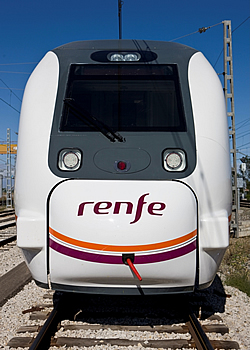
It is advisable to buy tickets in advance. This can be done on the RENFE website or by an online agent whose website is fully operational in English. Andalucia.com have affiliate partnered with Trainline for online RENFE tickets . You can also order tickets by phone, at the station itself, or at a RENFE appointed travel agent (small commission).
You can buy your ticket up to 60 days before your travel date. In the first two cases, you are either given a booking reference, which you then use to print out the tickets themselves from a machine at the main station, or you can print them out at home.
If you're travelling at the weekend or on a holiday or puente (long weekend), it is even more important to buy your ticket beforehand as the station may well be extremely busy, and seats may sell out.
If you're buying your ticket from the station on the same day you're travelling, arrive with plenty of time to spare, as queues can be long. Make sure you choose the right queue: if you're travelling within six hours, choose 'venta inmediata'; for further in advance, it's 'venta anticipada'. Also, you need to know which type of ticket you're buying. If you're sure you know what you're doing (type of ticket, service etc), you can even buy your ticket at an automatic machine.
Timetables and Tickets
Below are a selection of the most popular AVE train routes in Andalucia, click on the buttons to take you through to one of our partner's sites, input your dates and check the timetables for your trains.
- Malaga-Madrid
- Seville-Madrid
- Cordoba-Madrid
- Malaga-Seville
- Seville-Malaga
- Cordoba-Malaga
- Malaga-Cordoba
- Seville-Cordoba
- Cordoba-Seville
- Granada-Madrid
- Granada-Barcelona
FARES AND REFUNDS
Book in advance for the most economical fares; the best offers are online . Some services, including the AVE and fast long-distance services, offer a discount on the return leg of your journey.
Children under four travel free (under six on Cercanias), providing they don't occupy a seat; from aged four to eleven they get a 40% discount. If you have three or more children and live in Spain, you can apply for a "Familia Numerosa" card and obtain a 20 percent discount for all family members.
You can also find fares reduced by between 25 and 40%, for those aged under 26 years (Carnet Joven), or over 60 (Tarjeta Dorada, for Spanish residents only).
Ticket costs may be partially or fully refunded if a train does not arrive on time, depending on the cause of the delay and how late the train arrives at its final destination. Be sure to save your proof of purchase, and if your train arrives late, ask a RENFE representative for more information regarding whether you're eligible for a refund and, if so, how to obtain one.
The faster trains (AVE, for example - see below) offer different classes (club, preferente, turista) compartments. First class offers reclining seat, refreshments served at your seat; while both classes have audio/video on AVE and fast long-distance services. All trains are non-smoking.
Eurail Spain-Portugal pass offers five days of unlimited travel within one-month period.
PETS AND BIKES
You can take a small pet with you on the train (cats, dogs, birds, weighing up to 6kg, in a cage measuring maximum 65x35x35 cm). Only one animal allowed per passenger. The fare is 50% of the normal tariff. You can take your bike on trains, but subject to space available.
REFRESHMENTS
Most local and medium-distance trains will have snack and soft drink dispensing machine; the faster ones also have a cafeteria service, offering hot and cold soft drinks, alcohol, snacks and sandwiches.
Lost Property
Lost property found on trains or stations is kept by RENFE for two months, Here is the lost property page on the RENFE website (in Spainsh) with contact details. It states that lost property is written into a register with their reference, description, time and date and place of discovery. The owners of these objects may request the delivery, providing that payment of the transport and any other expenses is made by the owner. If not claimed objects are placed in a public auction.
If lost on platforms or trains of AVE, Larga Distancia, Avant y Media Distancia Convencional send an email to [email protected] If lost on the local ‘Cercanias' trains call the following numbers: Cádiz : 856 170 290. Málaga : 952 128 079. Sevilla : 954 485 672.
Disabled Facilities
Renfe Atendo service provides free assistance for railway passengers with reduced mobility or other disabilities. As a specialised service, it offers passengers guidance, information and help with access to and transit at stations, as well as assistance for getting on and off trains. Here is the Atendo service section on RENFE website.
Different rail services offered
- International trains More>
- High-speed long-distance trains (AVE) More>
- Fast long-distance and medium-distance trains More>
- Ordinary medium-distance (regional) trains More>
- Local commuter trains (Cercanias) More>
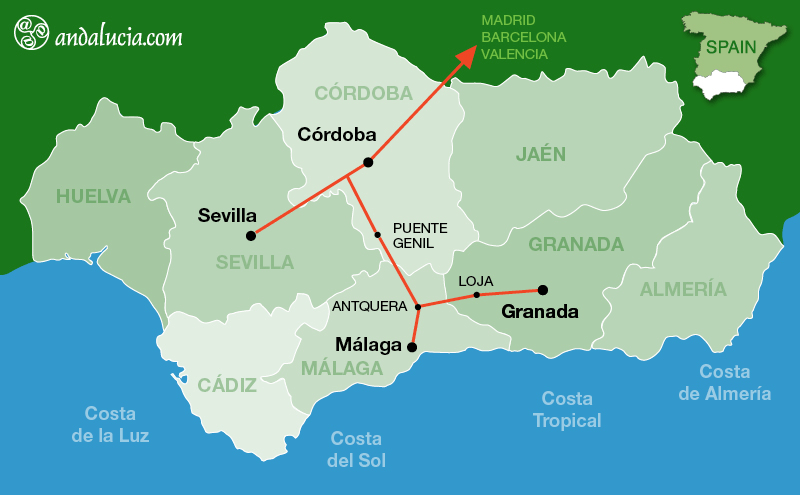
Destinations
- Almería province
- Skip to primary navigation
- Skip to main content
- Skip to primary sidebar
Tall Girl Big World
Germany & Europe Travel
- Switzerland
- Massachusetts
- North Carolina
- Puerto Rico
- Washington DC
Southern Spain 2-Week Itinerary: A Road Trip Through Andalucía
Created On: August 7, 2022 | Updated: January 27, 2023 | 5 Comments
Planning a trip to Andalucía? This southern Spain 2-week itinerary will take you through the best cities and towns in Andalucía. Even better, you can get to all the places via train if you don’t want to rent a car!
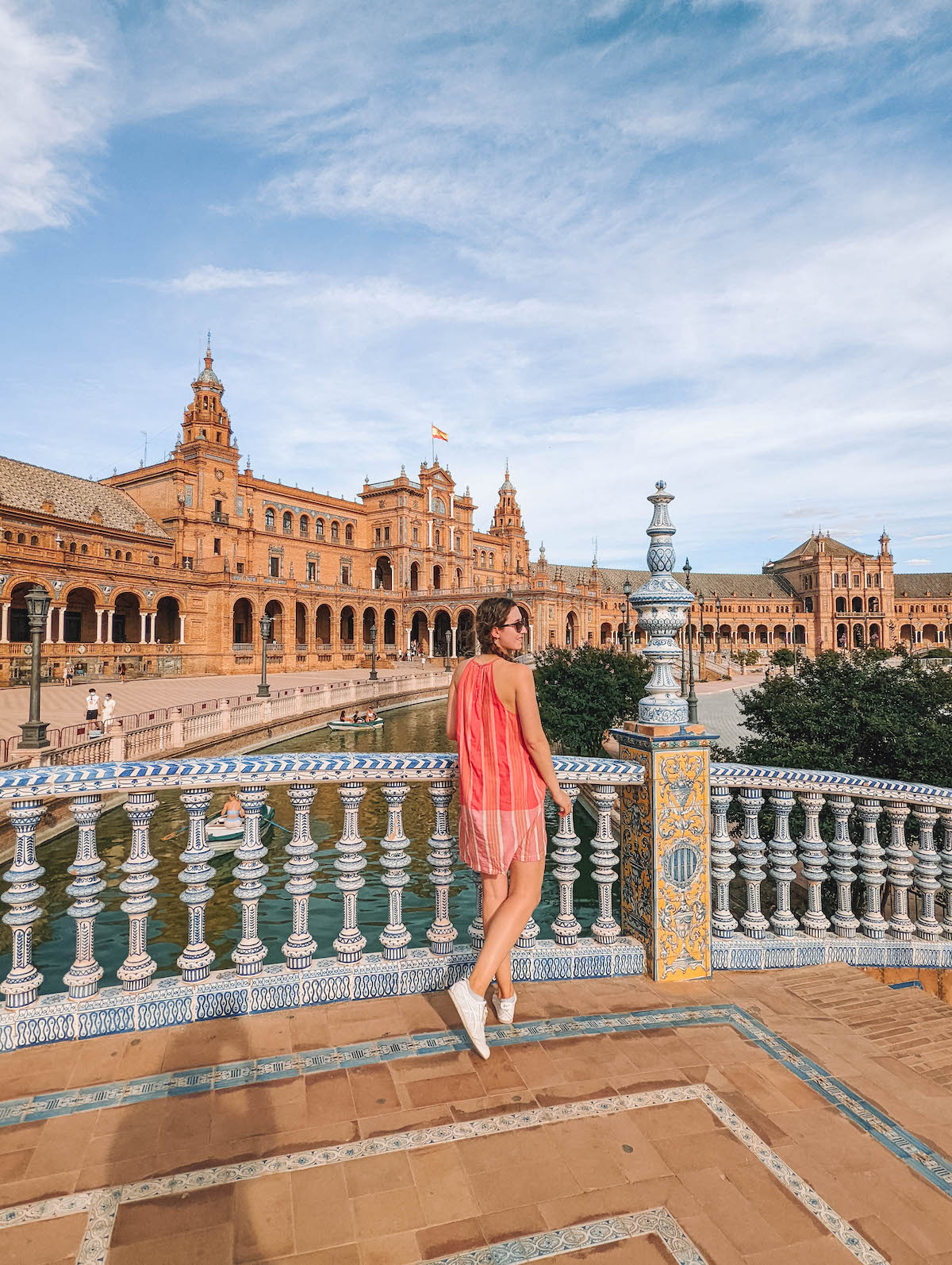
Madrid and Barcelona may be the best known cities in Spain, but my heart belongs in Andalucía!
After the Muslims invaded Spain in 711 AD, they called the southernmost part of the country “Al-Andalus.” Near the end of Reconquista — a war between the Christians and the Muslims to gain total control of Spain that spanned seven centuries — Al-Andalus was the last remaining portion of the country that still belonged to the Muslims.
The centuries spent under Muslim rule has imbued the entirety of present day Andalucía with a unique culture you won’t find elsewhere. In each city of Andalucía, you’ll find mosques-turned-churches, stunning Mudejar architecture, and a cuisine that combines ingredients and flavors from both cultures.
While you could plan a 2-week trip to Spain anywhere you’d like, I highly recommend spending your time exploring Andalucía. 2 weeks in southern Spain will give you a taste of Spanish culture as a whole while offering a more nuanced experience wholly unique to Andalucía.
Below is a Spain itinerary for 14 days. I’ve gone into as much detail as possible about what to do in Andalucía, but you’ll notice that I’ve included links to my detailed city guides as well — otherwise this blog post will turn into an e-book!
How Many Days Do You Need in Spain?
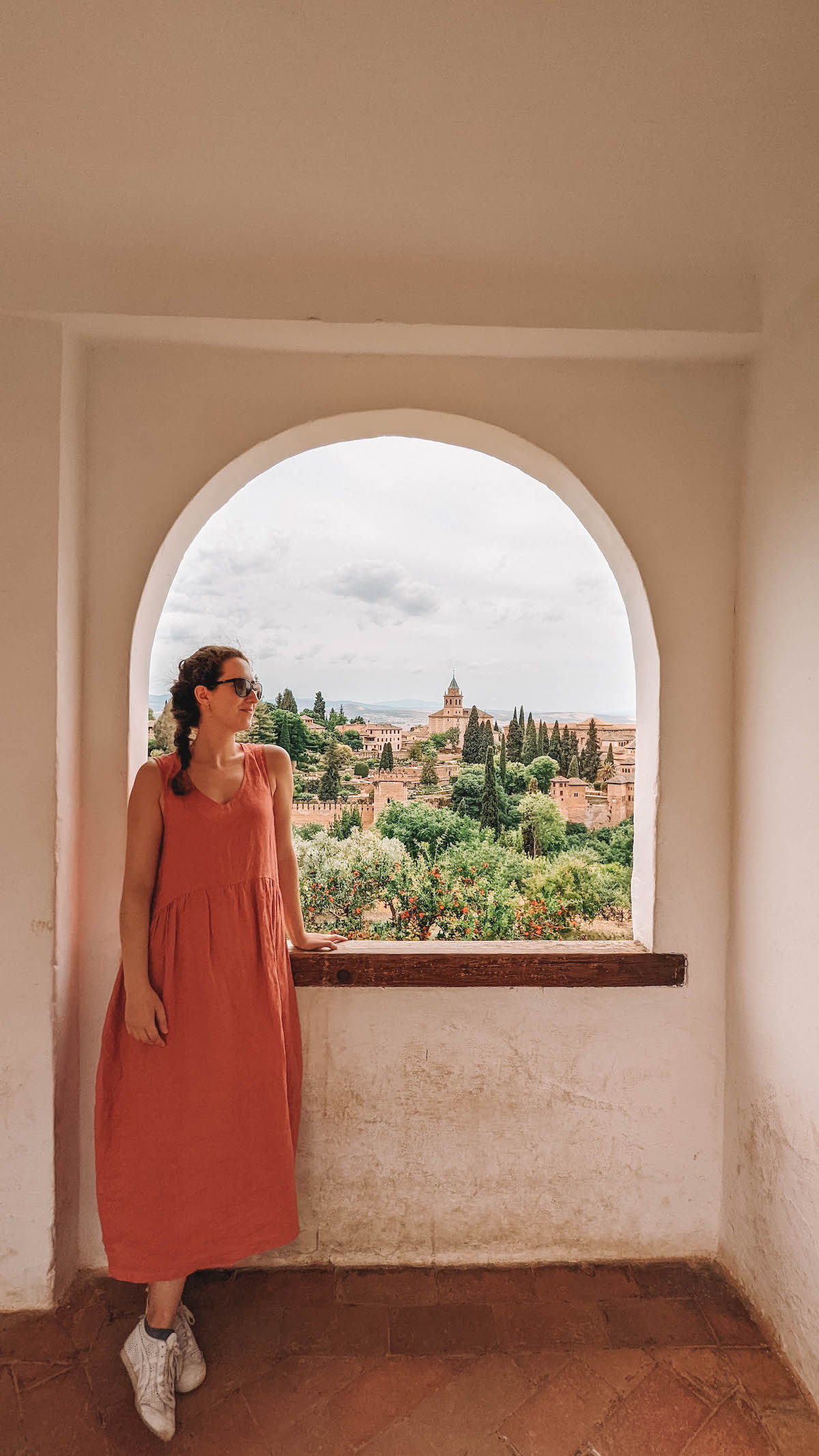
In a perfect world, we’d all be able to spend 3+ months in Spain to fully immerse ourselves in the culture and see the main sights. However, that’s not how life works and I know your vacation time is limited.
2 weeks in Spain is just enough time to see three to six cities and towns — the exact number depends on how many activities you pack into your days and the size of cities you visit. (This itinerary comfortably fits five major cities in Southern Spain!)
I’ll focus solely on the main cities in Andalucía in this itinerary. I’m of the opinion that it’s better to focus on one specific area rather than waste time traveling from one end of the country to another just to see the big cities.
You could of course adjust this itinerary to spend just one week in Spain if that’s all the time you have. If that’s the case, I think your best call would be to visit Seville and Granada if you’ve never been to either!
What’s the Best Time to Visit Spain?
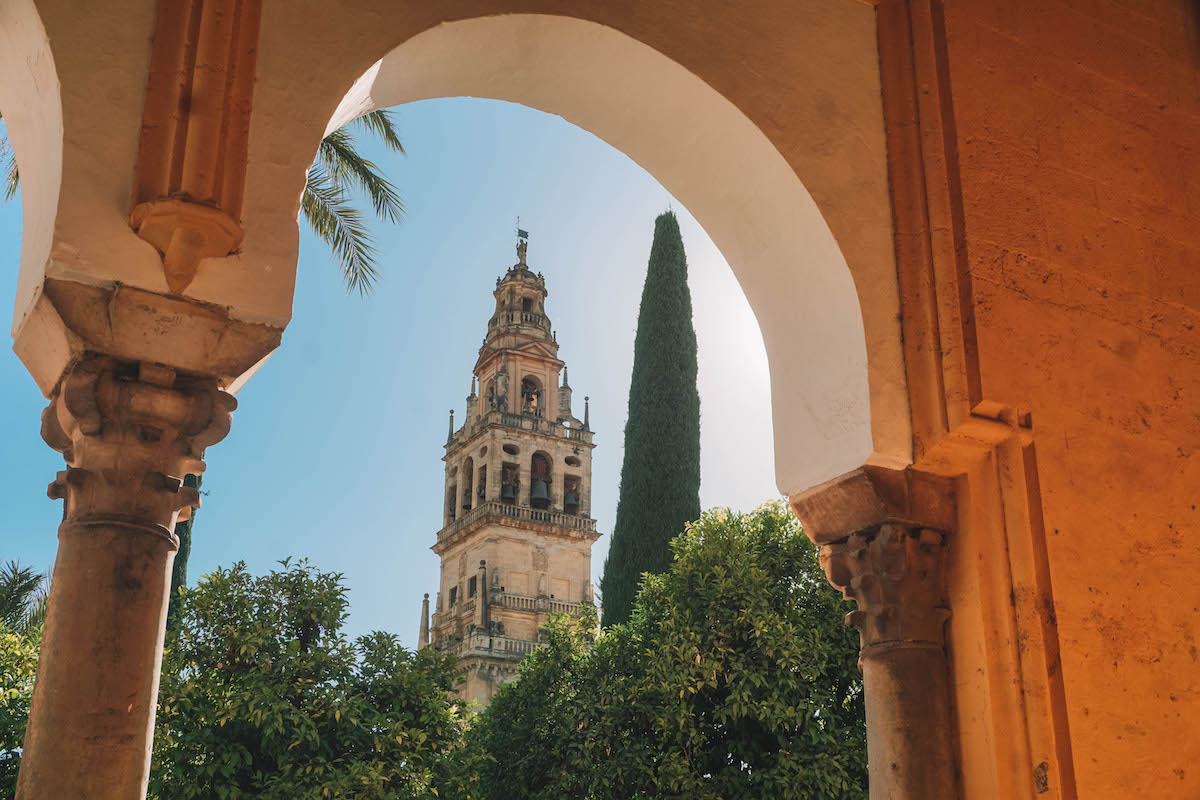
I recommend planning a trip to Andalucía during shoulder season (March / April or September through November) . I visited southern Spain at the end of May, thinking I’d beat the worst of the crowds and would experience cooler temperatures. Wrong! It was 90ºF+ most days and major attractions, like the Alhambra in Granada, were packed with people.
The next time I visit Spain, I plan on going in the early spring!
Overview of This Spain 2-Week Itinerary
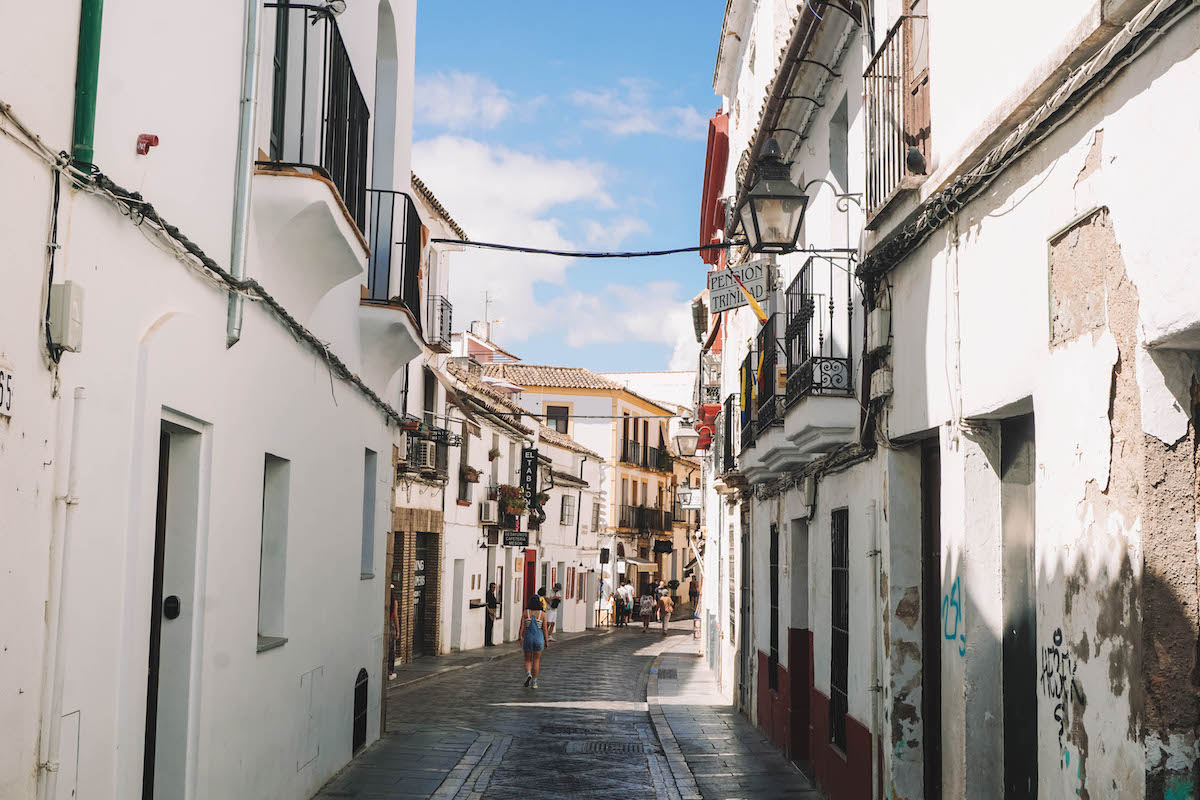
You’ll note that I didn’t include Barcelona or Madrid in this southern Spain 2-week itinerary. You can OF COURSE visit one or both of these cities, but I prefer to travel a little slower these days. If I’m going to go to Barcelona or Madrid, I’d rather have at least 5 full days in each place — which would have eaten into most of my 2-week trip to Spain!
So know that there are no itinerary police holding you accountable. Travel wherever you want, but I think this is the best 2-week Spain itinerary for those of you (like me!) who want to visit lots of different cities and see a variety of sights without having to run yourself into the ground each day.
All that being said, here’s an overview of this 2-week Andalucía itinerary:
- Days 1 – 3: Málaga
- Days 4 – 6: Granada
- Days 7 – 8: Córdoba
- Days: 9 – 10: Ronda
- Days 11 – 13: Seville
Day 14 has been left blank to account for travel between cities. It’s better to have a little wiggle room in case your arriving flight is delayed, you miss your train, etc.
Where Should You Start and End a 2-Week Trip to Spain?
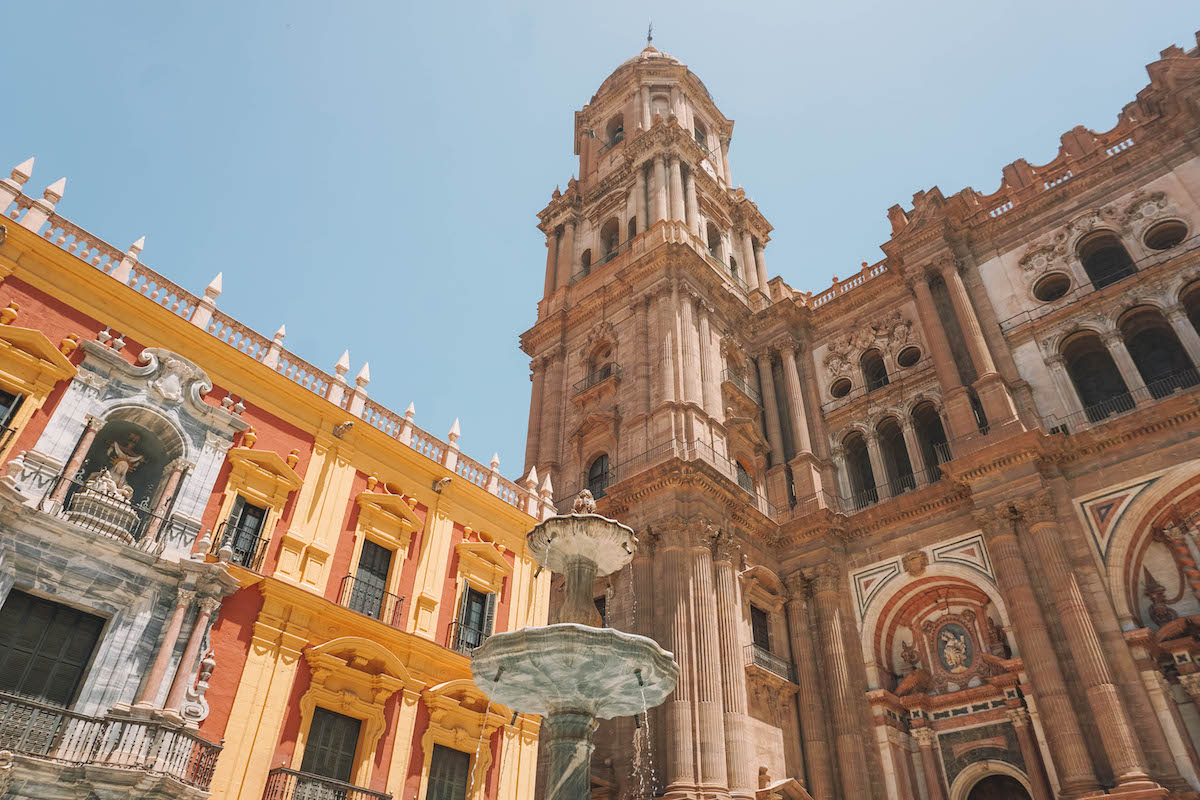
This southern Spain 2-week itinerary begins in Málaga and ends in Seville. You could also flip flop the itinerary if you find better flight prices flying into one city versus the other.
Or, you may find it easier and cheaper to fly into Madrid and then drive or take the train to Málaga to start your 14 days in Spain. That will obviously add on time and eat into your trip, but sometimes needs must!
Car, Bus, or Train? How to Get Around Southern Spain
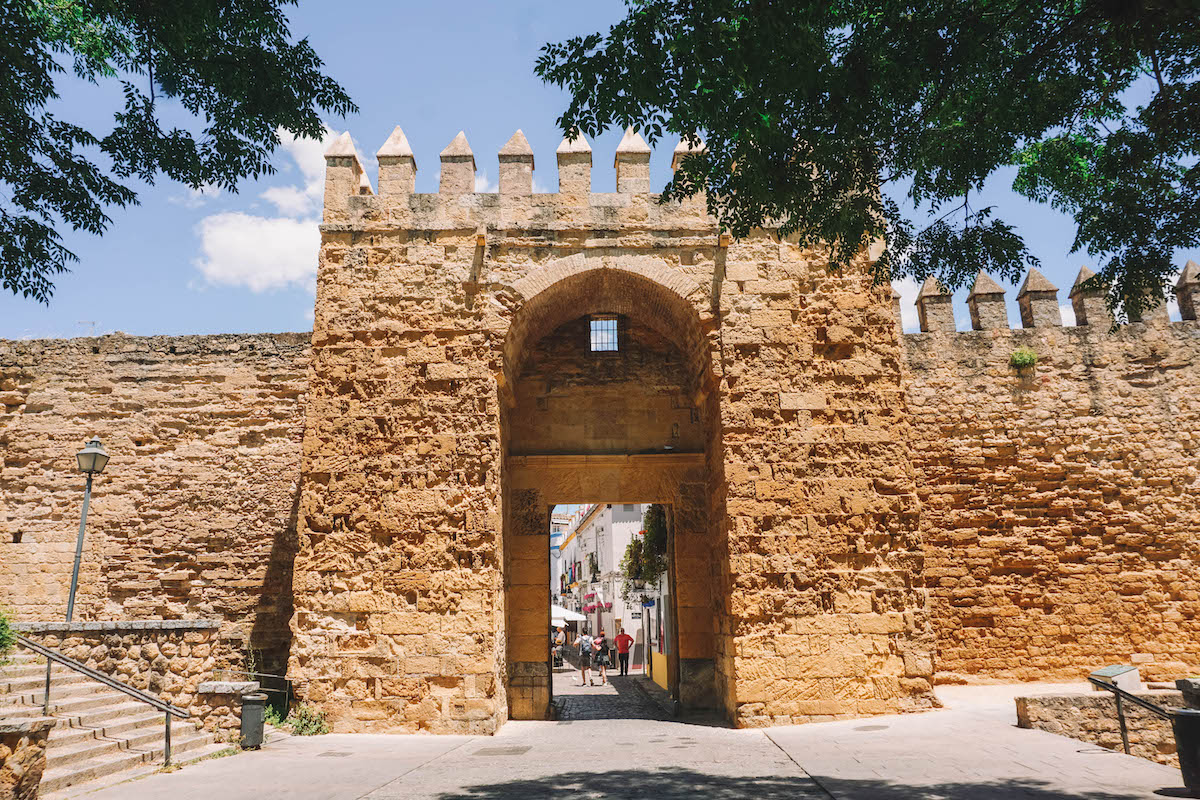
Most itineraries I referenced for planning 2 weeks in Spain suggested renting a car to traverse Andalucía. They said it was easier and quicker to do so, but I had zero desire to spend extra money on a rental car, nor did I want to deal with parking in foreign cities on my own.
I was worried that taking a train around southern Spain would prove confusing or time-consuming, but it was actually so incredibly easy and affordable!
From my personal experience, I can assure you that this 2-week Spain itinerary can absolutely be done by train! The longest train journey is just under 3 hours, and it will be at the end of your trip.
Note that many of the trains leave either first thing in the morning or in the late afternoon. I recommend boarding the morning trains (none require you to get up ridiculously early, don’t worry!).
Also, you should plan to arrive at the train stations 20 to 30 minutes before departure. In Spain, you’re required to go through a quick security check before boarding your train. They’ll X-Ray your suitcase and check your ticket, and then you’re off!
Lastly, please note that I walked from the central train stations to each of my hotels and AirBNBs. So know that the train stations of each city listed in this 2-week Andalucía itinerary are very close to the city centers!
Best Way to Book Train Tickets in Spain
The Renfe website (i.e. the Spanish railway’s official website) is an absolute nightmare to use. Every time I tried to book a ticket, the site crashed.
Save yourself a major headache and book your train tickets through a third-party provider like Omio . I did manage to book a couple tickets through Renfe after much hair-pulling, as I noticed that Renfe sometimes had additional train times listed that weren’t shown on the Omio site. So check both sites, but book through Omio if possible.
Of course, you can also wait to book your tickets in person at the train stations. There are ticket machines everywhere and they’re easy to use. The prices may be more expensive day-of, but it would give you the flexibility to alter your itinerary if that’s important to you.
Southern Spain 2-Week Itinerary
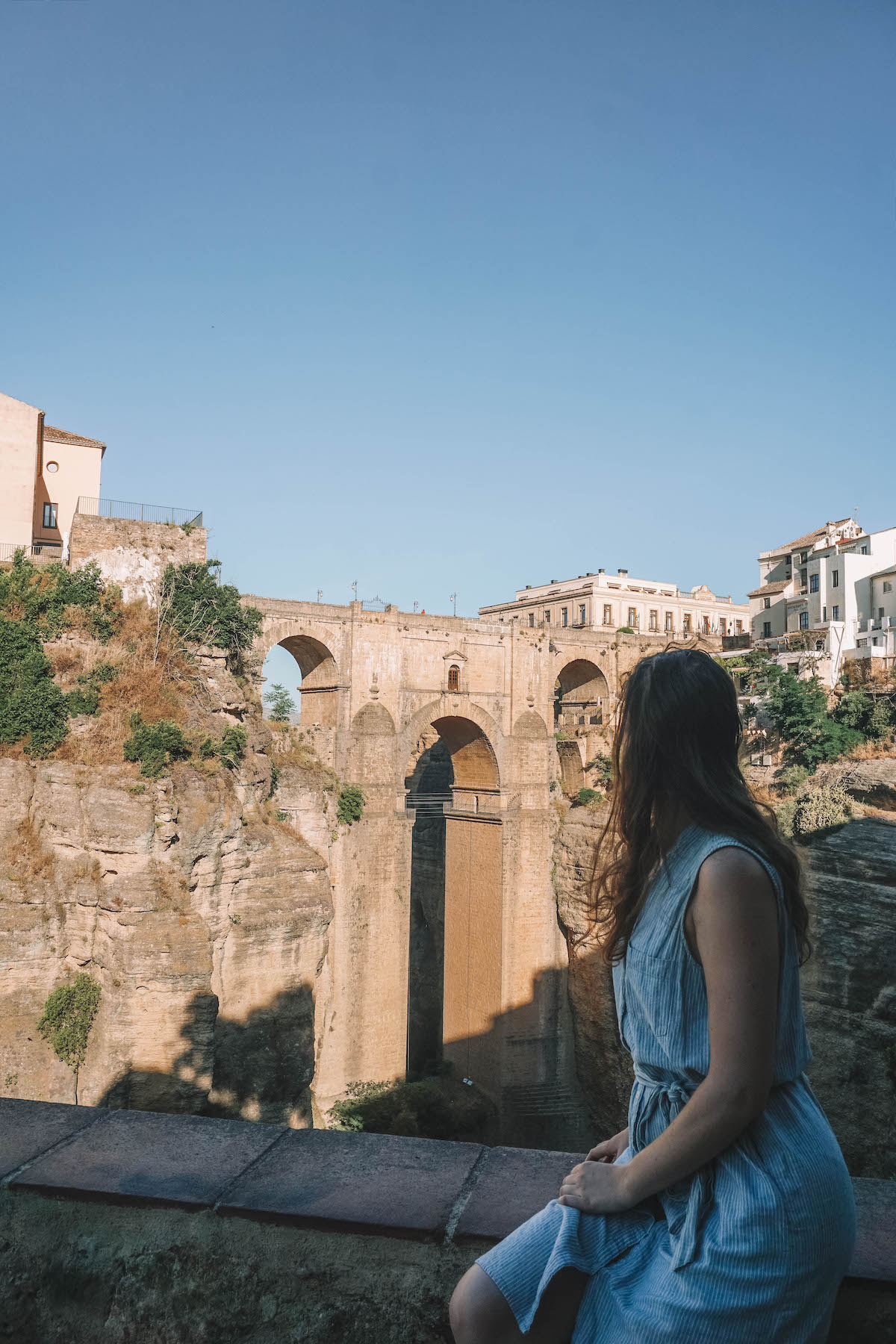
I’ve already given quite a few tips for making the most of your 2 weeks in Southern Spain, but here are a few quick reminders before I FINALLY dive into the full itinerary.
First and foremost, you can get to all of the cities mentioned on this itinerary via train. No need to rent a car!
Second, you can mix and match this itinerary as you see fit.
Thirdly, I’ve given broad overviews of each day’s activities but have linked to my ultra detailed city guides in each portion of the itinerary. Read those posts for more information on the individual attractions. I wanted this itinerary to be, well, an itinerary (i.e. a broad overview of how to plan a 2-week trip to Spain).
Spain Itinerary Days 1 – 3: Málaga
One of the gems of southern Spain, Málaga is a gorgeous port city that boasts one of the biggest and best preserved Old Towns I’ve had the pleasure of visiting. Málaga is also the birthplace of Pablo Picasso and Antonio Banderas, and the locals are very proud of their famous sons!
Of all the places in Andalucía, Málaga is one of the better ones for understanding how the Romans, Muslims, and Catholics shaped the region’s culture. The absolute top attractions in Málaga are undoubtedly the beautiful cathedral, the Alcazaba, and Gibralfaro Castle.
Below is a bulleted itinerary for 3 days in Málaga, but you can read LOTS more about the specific attractions in my full Málaga city guide .
Day 1 in Malaga
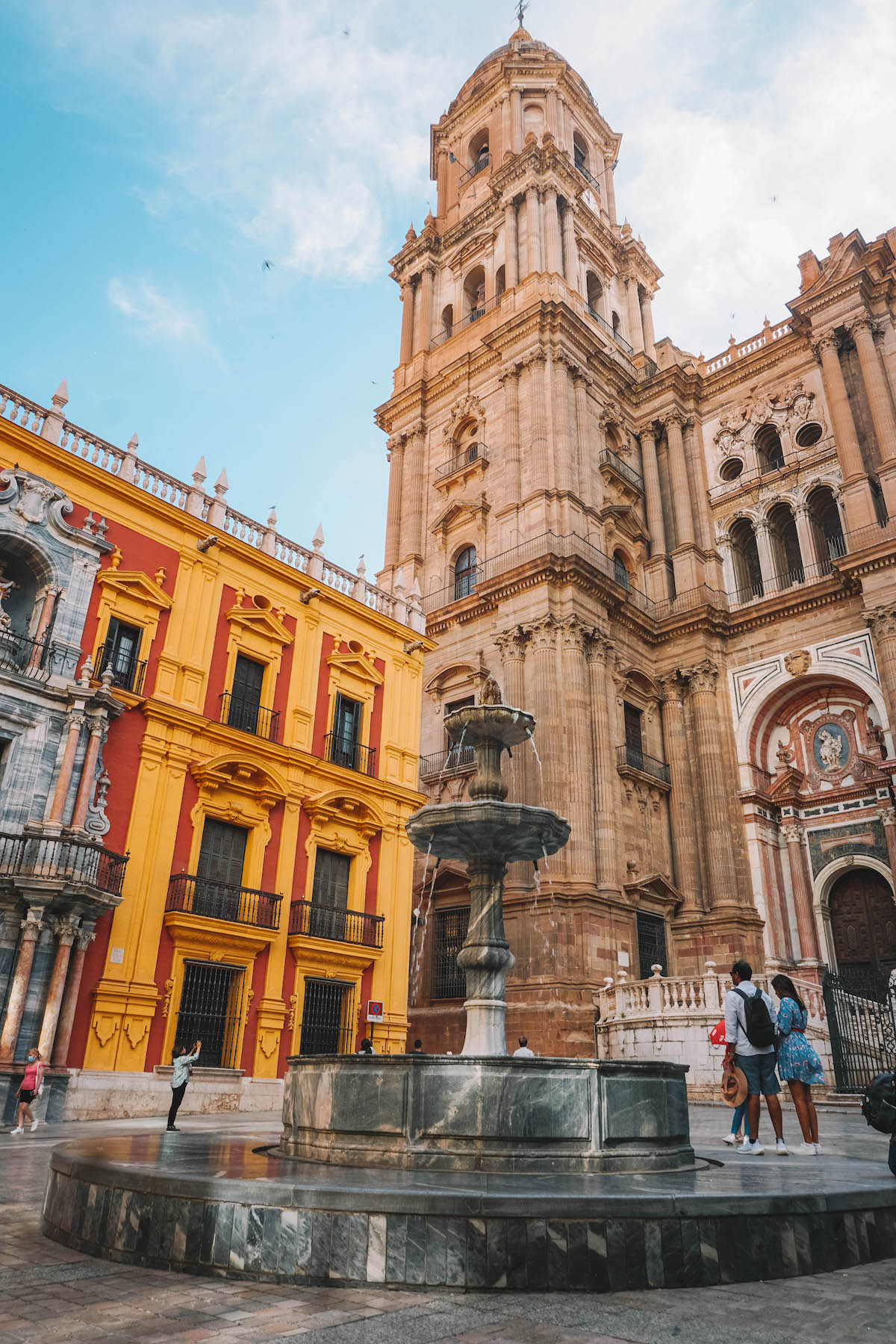
Free walking tour — Malaga Adventures has a detailed 3-hour, free walking tour of the city center. This is the best way to learn about the history of the city, plus it gives you a chance to ask a local for restaurant and activity recommendations!
Cathedral and rooftop (shown above) — Nicknamed La Manquita (little lady with one arm), Málaga’s cathedral took more than 200 years to get to its current state … and it was never finished! It’s one of the most stunning cathedrals I’ve visited, and I highly recommend paying extra to climb to the rooftop for an unparalleled view of both the unfinished cathedral and the city center.
Malaga Museum — Housed in what was originally the city’s customs house, the Malaga Museum is a small but impressive museum that boasts a variety of art and artifacts meant to give visitors a closer look into the city’s past.
Explore the Old Town — After packing your brain with key historic facts, enjoy window shopping getting lost in the Old Town! Calle Marqués de Larios is one of the most expensive shopping streets in all of Spain, and there are many more side streets to discover.
Day 2 in Malaga
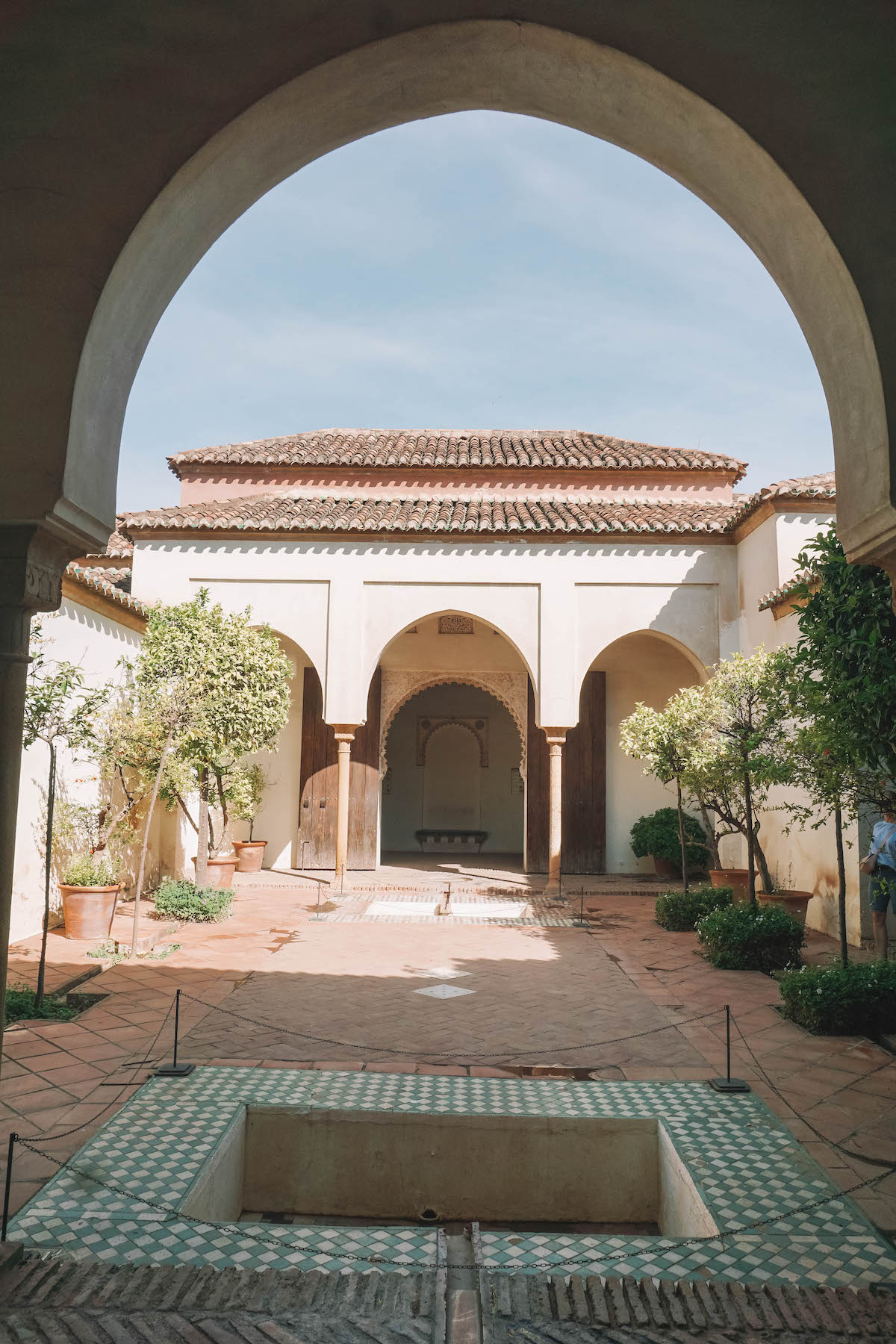
Alcazaba (shown above) — A former Muslim fortress that was built in the 11th century as a means of defending the port. The interior of the fortress has lots of hidden gardens and babbling fountains, and is a surprisingly peaceful place to visit.
Roman Theater — Built by the Romans in the 1st Century BCE, the Roman Theater is now in ruins. The city has built platforms over the ruins so you can walk directly over them and get a sense of how the theater must have operated in its heyday.
Gibralfaro Castle — Gibralfaro Castle was built in the 1300s to improve the city’s defenses. Like the Alcazaba, the castle was built by the Muslims. The views from the castle’s parapets are absolutely stunning!
Picasso Museum — The perfect place to escape the afternoon heat! Picasso was born in Málaga, and this museum owns more than 230 of his works of art. If Picasso doesn’t pique your interest, I can also highly recommend the Carmen Thyssen Museum as an alternative.
Day 3 in Malaga
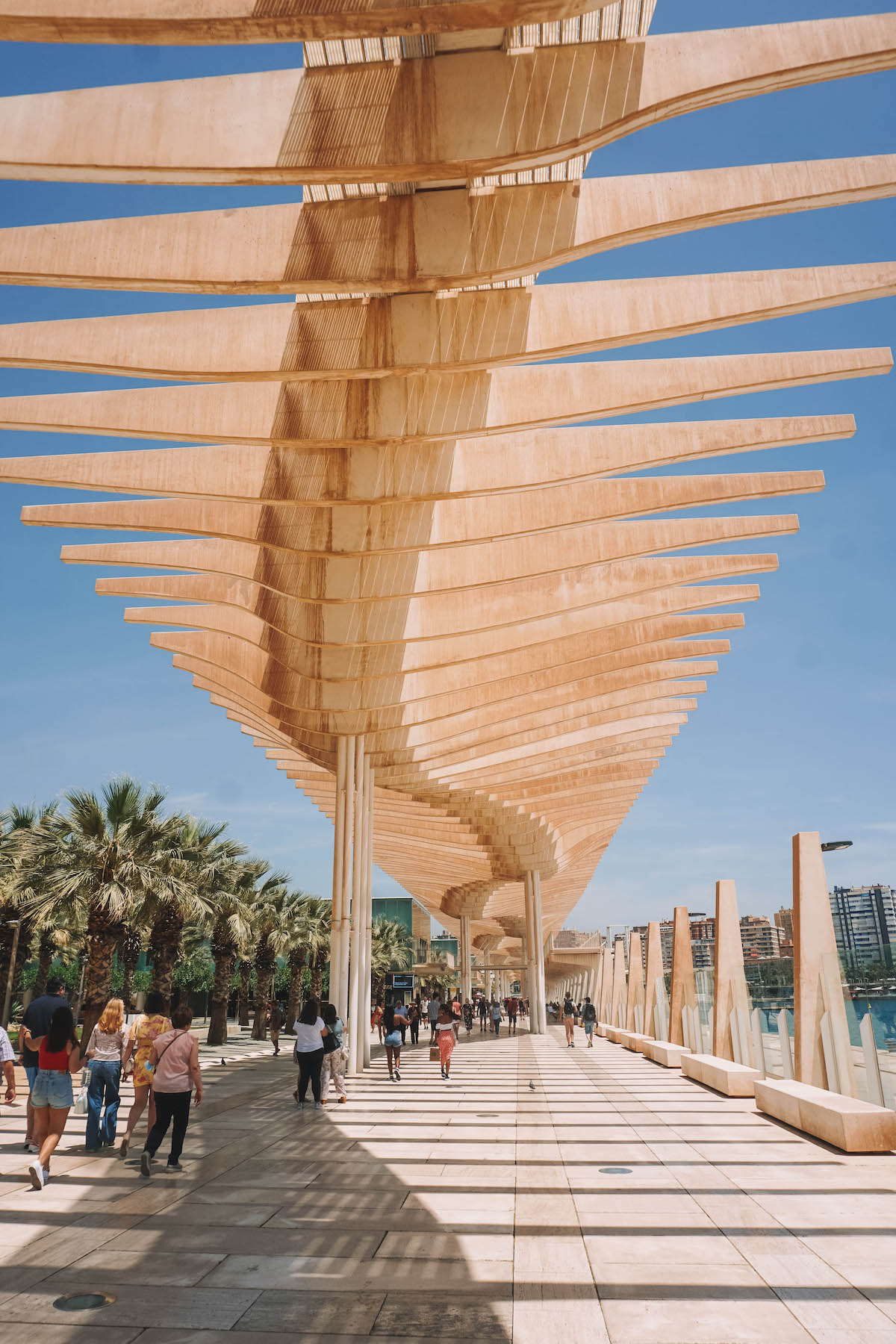
Muelle Uno (shown above)— A section of the port of Málaga that’s been transformed into an open-air shopping and dining center.
Playa de la Malagueta – The local beach! It can become crowded in the summer, so arrive early to claim a spot. You can spend the morning here, or the entire day. OR enjoy a walk along the sand before continuing with the attractions below.
Mercado Central de Atarazanas — A covered market in the city center with vendors selling fresh produce, seafood and meats, dried fruits, and almonds. Grab some fresh fruit, almonds, and other nibbles here to take with you to the gardens!
La Concepcion Botanical Gardens — An underrated Málaga attraction! The gardens are located on the historic La Concepcion. After touring the various gardens, I recommend finding a spot in the shade to enjoy your snacks from the market and maybe read a book or call home, if desired.
Spain Itinerary Days 4 – 6: Granada
Granada was ruled by the Muslims for centuries and was the last city in Spain to fall back into the hands of the Catholic monarchy in 1492. Granada is home to one of the top tourist attractions in all of Spain: the Alhambra.
Many people visit Granada as a day trip from Seville or Málaga, but I don’t recommend doing that as there’s SO much more to do and see than simply tour the Alhambra.
Below you’ll find an itinerary for 3 days in Granada. For more details on the individual attractions listed below, check out my full Granda city guide .
Day 1 in Granada
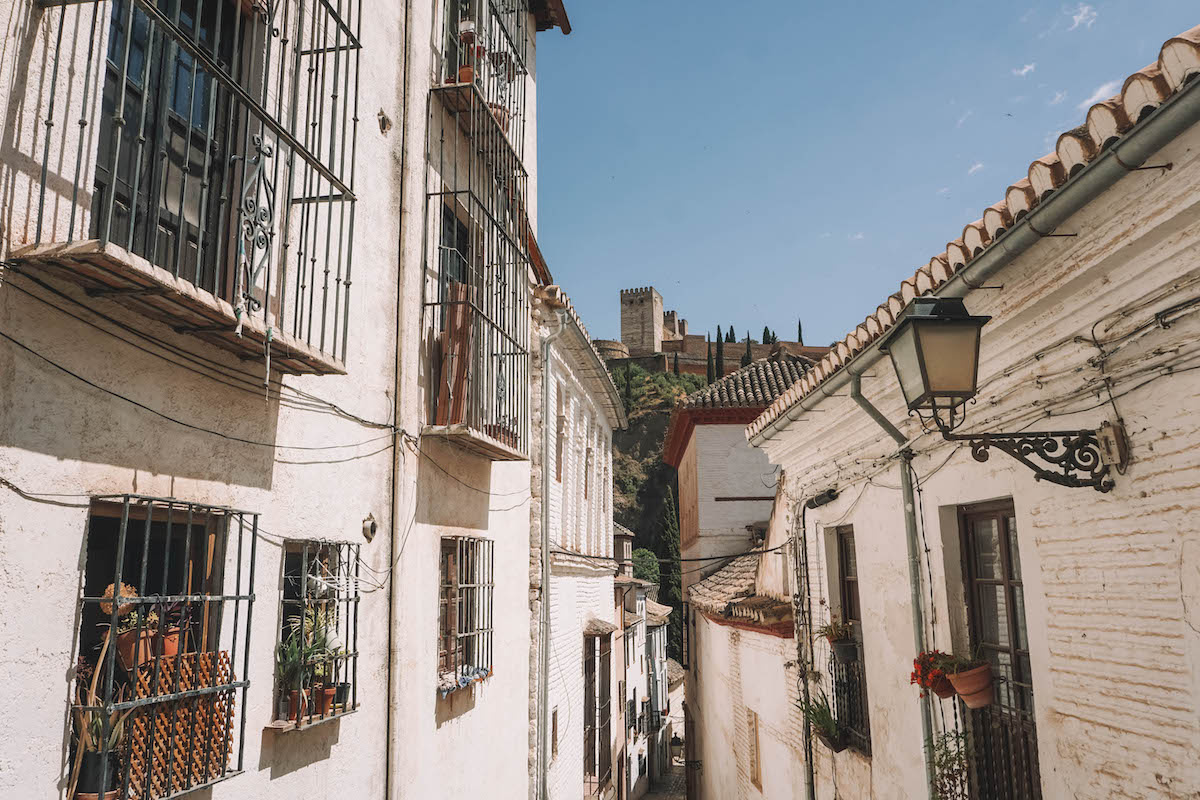
Cathedral — Built on the site of the Great Mosque following the Catholic reconquest of Spain. The cathedral contains a unique blend of architectural styles, but it was built mostly in the style of the Spanish Renaissance.
Guided walking tour — Granada has a long history, which you won’t learn about simply by visiting the main tourist attractions. Walk in Granada offers a more traditional pay-what-you-want walking tour, as well as a walking tour of Albaicin and Sacromonte. Choose whichever interests you more!
Sacromonte / Albaicín (shown above) — The “Old Town” areas of Granada directly facing the Alhambra. They’re mostly residential, but there are many white-washed alleyways to meander through as well as scenic overlooks ( Miradors ) offering up spectacular views of the city.
Bañuelo — An 11th century Arabic hammam (bath house) that’s been beautifully preserved.
Sunset — Most itineraries say to watch the sunset from Mirador San Nicolas, but it fills up quickly and is noisy and crowded. Instead, watch the sunset from Mirador de la Vereda de Enmedio, Mirador Placeta de Carvajales, or Mirador Sacromonte.
Day 2 in Granada
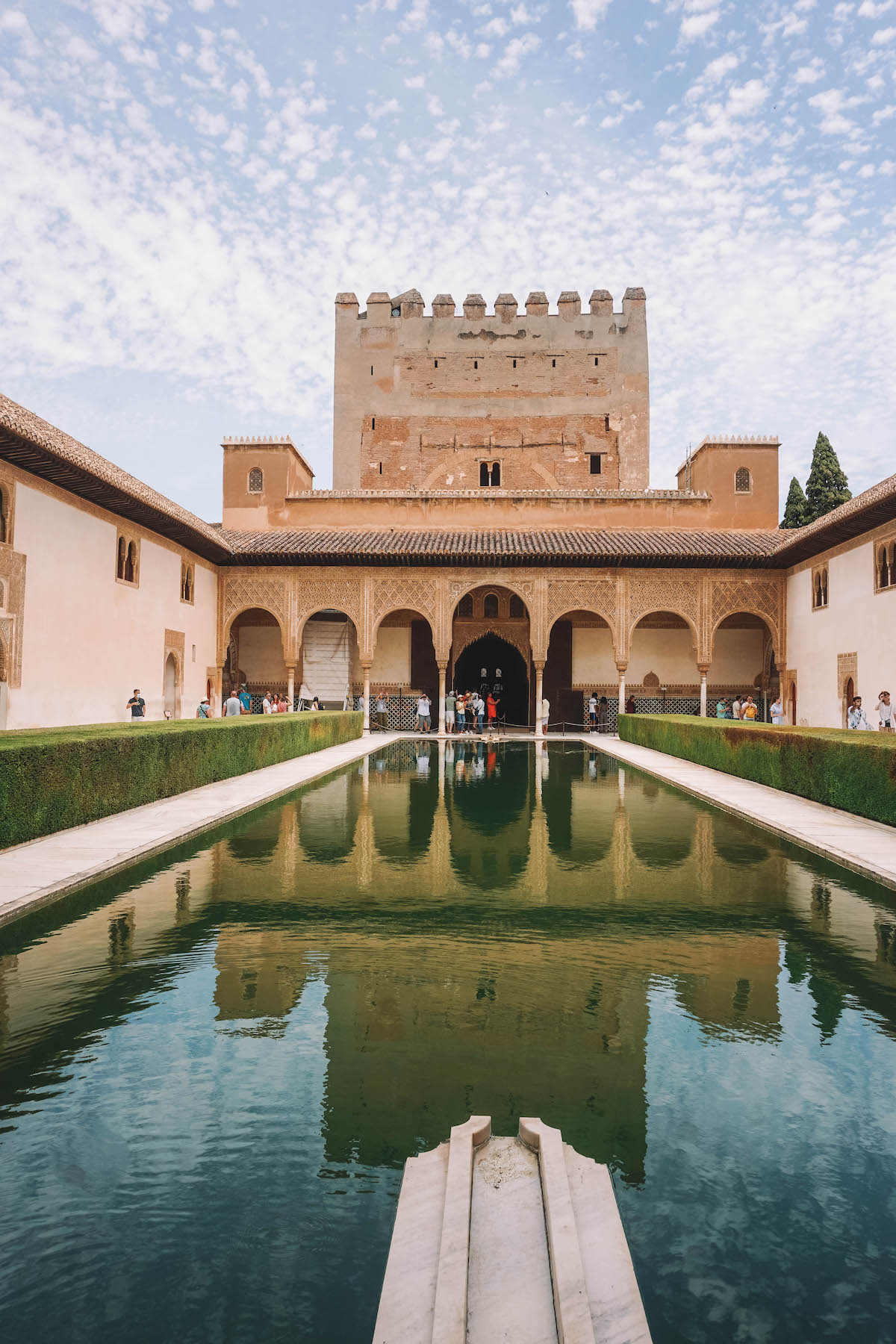
Alhambra (shown above)— The top attraction in Granada! It’s a massive complex that was originally built in the 9th century as a military fortress, but it was expanded upon over the centuries to also serve as the royal residence.
Rest! — Even if you visit first thing in the morning, you’ll be wiped after walking for hours around the Alhambra complex in the sunshine. Schedule a rest period into your day to ensure you don’t become overheated. (Seriously, please do this! Even if it’s just relaxing at a cafe for an hour with a cold drink.)
Window shop and explore some more — Popular shopping streets include the Reyes Catolicos, Carrera del Darro, and Calle Calderería Nueva. If you’re up for a little adventure, try to find a local convent or monastery selling sweets! (Check out my full Granada guide linked above for info on where I bought my convent cookies.)
Flamenco show — You can’t leave Granada without attending an authentic flamenco show in the caves of Sacromonte! The local style of flamenco is called Zambra, and the entire performance is absolutely electrifying.
Day 3 in Granada
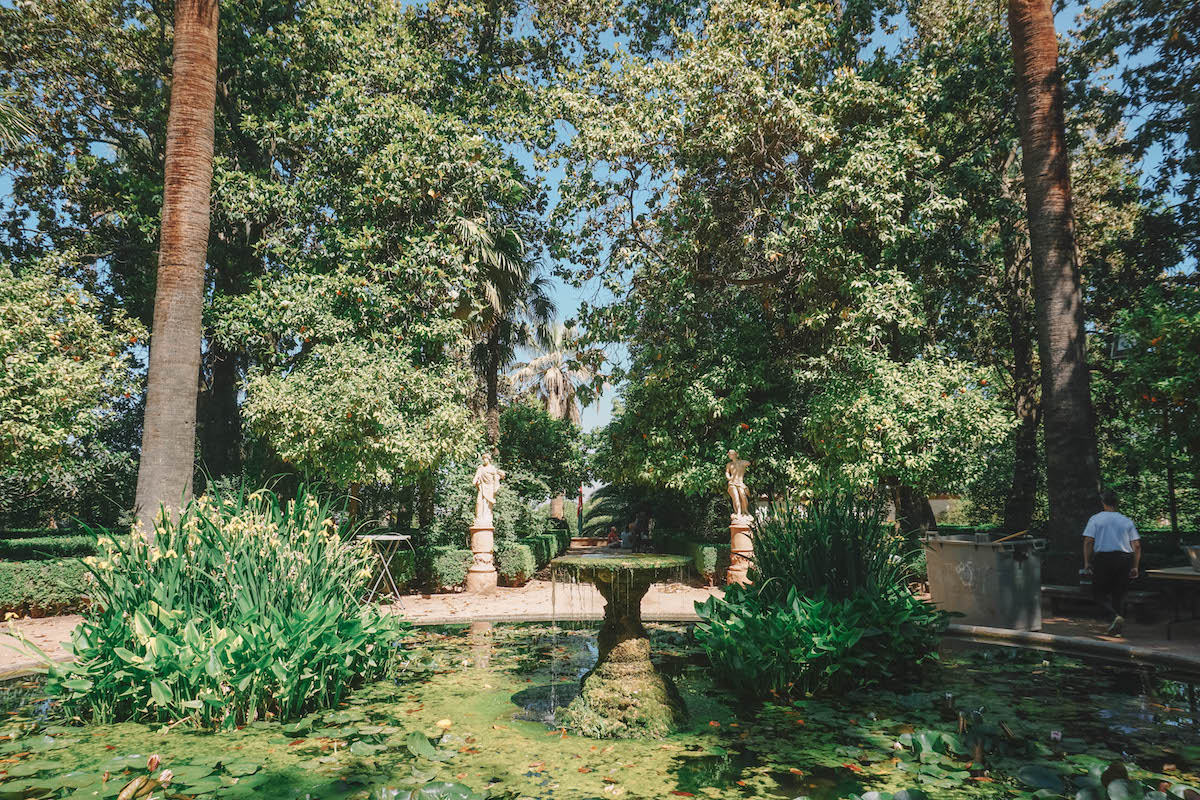
Carmen de los Mártires (shown above) — A stunning 19th century mansion with a sprawling park and garden complex.
San Jeronimo Monastery —The first monastery to be built in Granada after the reconquest of Spain by the Catholic monarchy.
Monasterio de Nuestra Señora de la Asunción (“La Cartuja”) — A lavishly decorated Spanish Baroque church atop a hill just outside the city center. Emphasis on “lavishly decorated.” This place is insanely beautiful! If you don’t have the time or desire to visit both monasteries on today’s itinerary, pick this one over San Jeronimo.
Spain Itinerary Days 7 – 8: Córdoba
Córdoba was formerly the capital of Islamic Spain and was also once the largest and most advanced city in all of Europe. Today Córdoba is best known for its Mosque-Cathedral, “La Mezquita,” which integrated the original mosque architecture with the Christian cathedral built on the site.
There are enough attractions in Córdoba to fill two leisurely days of adventuring, but one full day will also give you enough time to see the main sights. If you want to alter this itinerary for 2 weeks in Southern Spain, this is one place you could do it.
For more information on the Córdoba attractions listed below, check out my full Córdoba city guide.
Day 1 in Córdoba
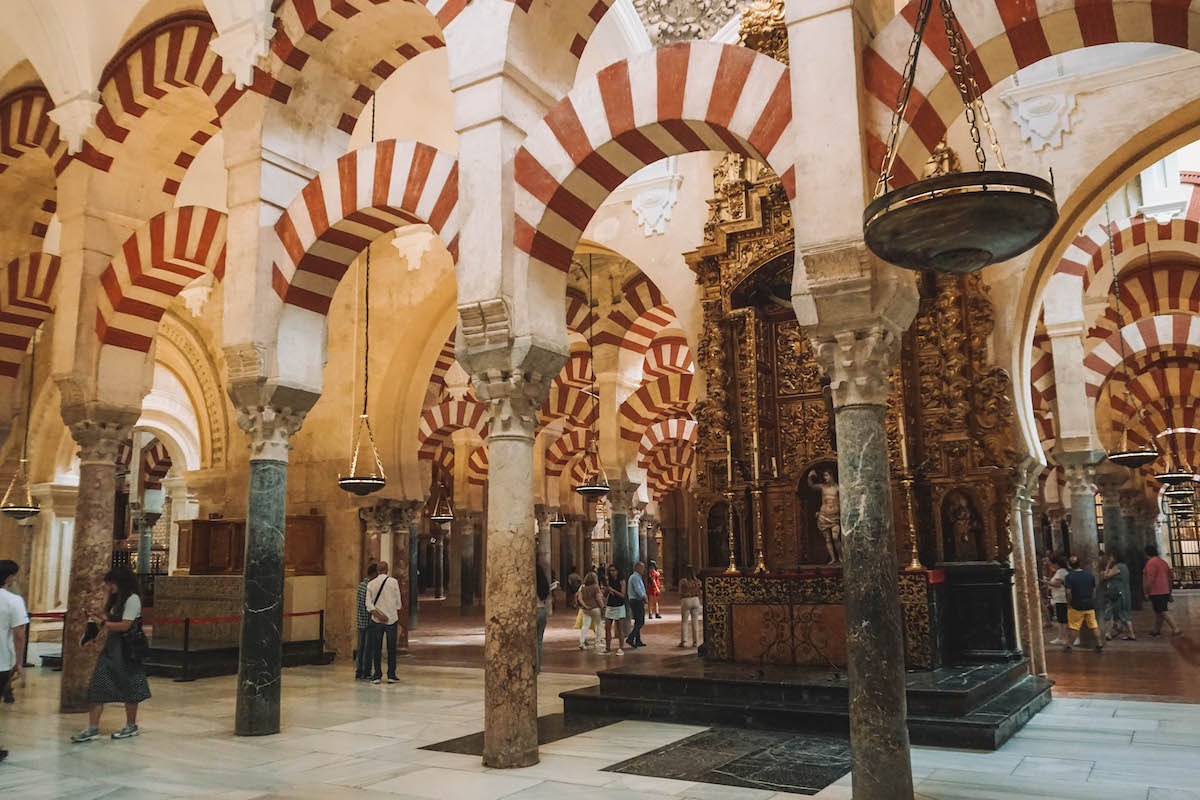
Mosque-Cathedral ( Mezquita ) — A former Islamic mosque that was converted into a Catholic cathedral in the 13th century. The original mosque architecture has been integrated into the cathedral, rather than destroyed and built over.
Flower Street — A quaint white-washed alleyway near the Mezquita lined with bright blue flower pots. A great photo opp!
Roman Bridge (+ Calahorra Tower, if desired) — The Puente Romano was first built in the 1st century by the Romans. The view from the opposite bank makes for a great photo! Calahorra Toweris a fortified gate along the bridge that now houses the Museo Vivo de Al-Andalus.
Alcazar of the Catholic Monarchs — A fortress that also served as a palace. It’s where the Catholic monarchs Ferdinand and Isabella lived for eight years during the Reconquista. The interior of the fortress isn’t anything to write home about, but the gardens are beautiful!
Almodóvar Gate — One of only three remaining medieval city gates. Walk through the gate to reach the former Jewish Quarter, where there are lots of shops and restaurants.
Day 2 in Córdoba
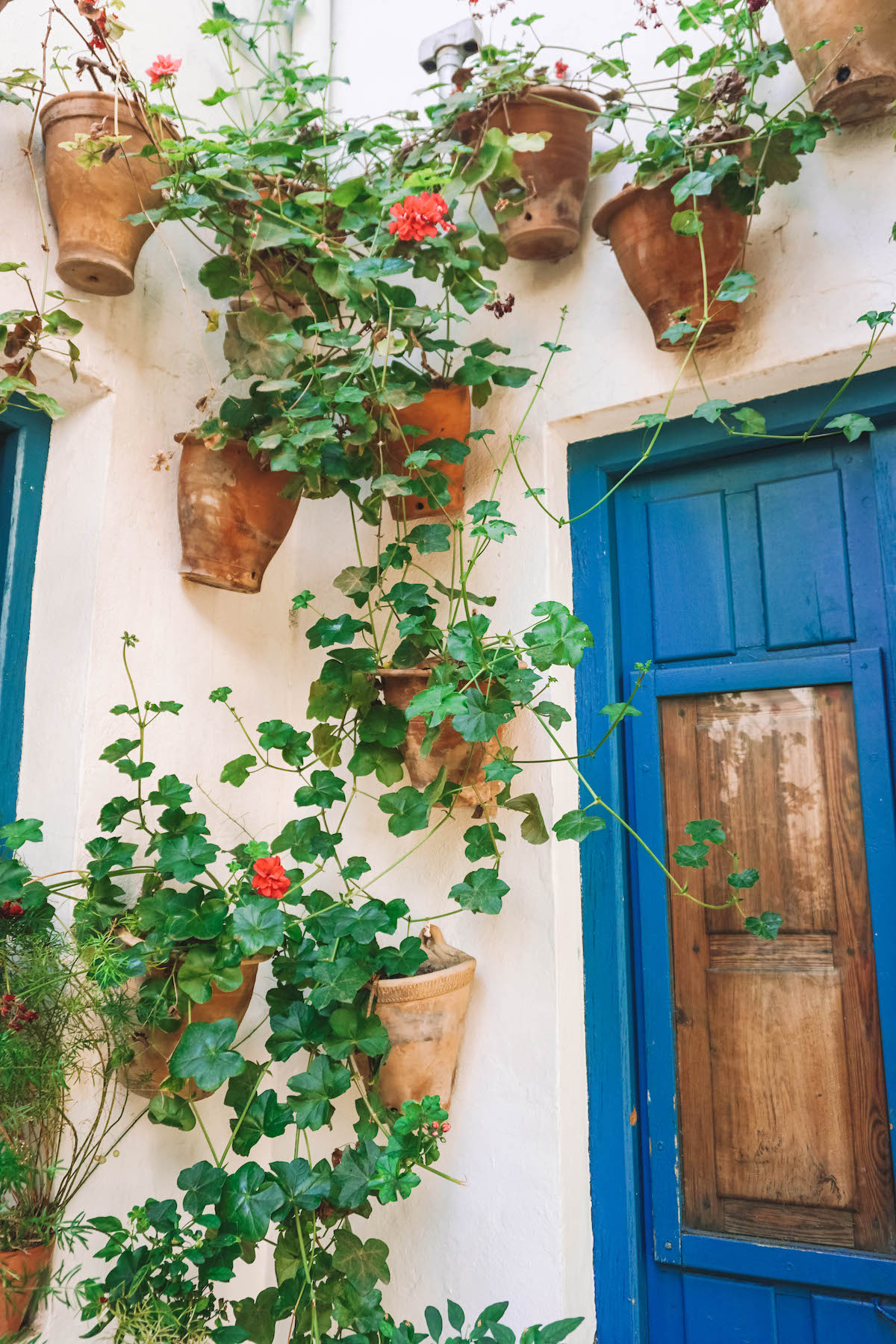
Palacio de Viana (shown above)— A 15th century palace with 12 stunning patios (the lush inner courtyards that Córdoba is known for!).
Templo Romano — Ruins of what was once the largest Roman temple in the city.
Plaza de las Tendillas — Nearby square with a fountain and pretty cafes.
Window shopping in the Old Town b— Return to the Old Town to shop, grab a drink, or enjoy an afternoon siesta back at your hotel.
Plaza de Corredera — A residential square with bars and cafes at street level. It’s fairly quiet during the daytime, but at night it’s packed with locals all chatting over their drinks. This is a relaxed, family-friendly spot, not a party destination!
Spain Itinerary Days 9 – 10: Ronda
Ronda is one of the prettiest towns in all of Spain! The Old Town is set high above the El Tajo Gorge and connects to the modern part of the town via the 322-high Puente Nuevo bridge. This was one of Ernest Hemingway’s favorite haunts, and the town’s iconic bridge is said to have inspired scenes in his novel, For Whom the Bell Tolls.
Like Córdoba, you could get away with one full day in Ronda if there are other cities you’re dying to pack into your 2 week-trip to Andalucía. However, my two days in Ronda were some of the most magical of my entire 2 weeks in Spain! The town’s small size makes it perfect to explore at your leisure.
For lots more detail on the Ronda attractions I’ve shared below, read my full guide to Ronda .
Day 1 in Ronda
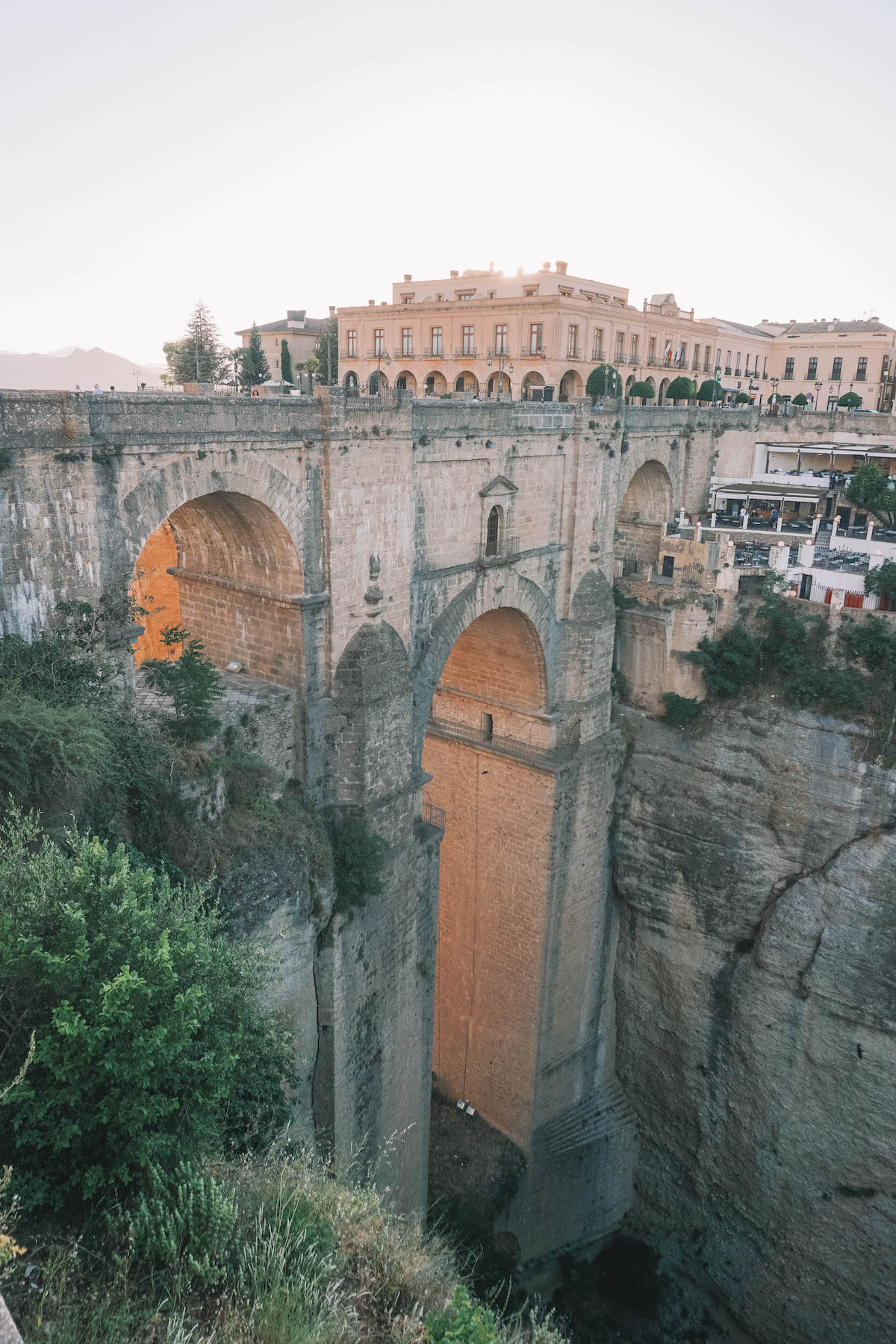
Bullring — The oldest and largest in all of Spain.
Mirador de Ronda overlook (shown above, right) — Near the bullring. It’s a gorgeous vista with views of the surrounding countryside.
Puente Nuevo (shown above, left) — The main attraction of Ronda. Words can’t describe how beautiful this bridge is! (In my full guide linked above, I’ve also shared my favorite spots to photograph the bridge.)
Murallas de la Cijara (old city walls) — The best preserved section of the old city walls is near the Puerta de la Cijara.
Arab baths — 13th century Arab baths that have been lovingly preserved and restored.
Walking tour — End your first day in Ronda with a guided walking tour of the Old Town. The tourism board offers a 90-minute tour that I highly recommend!
Day 2 in Ronda
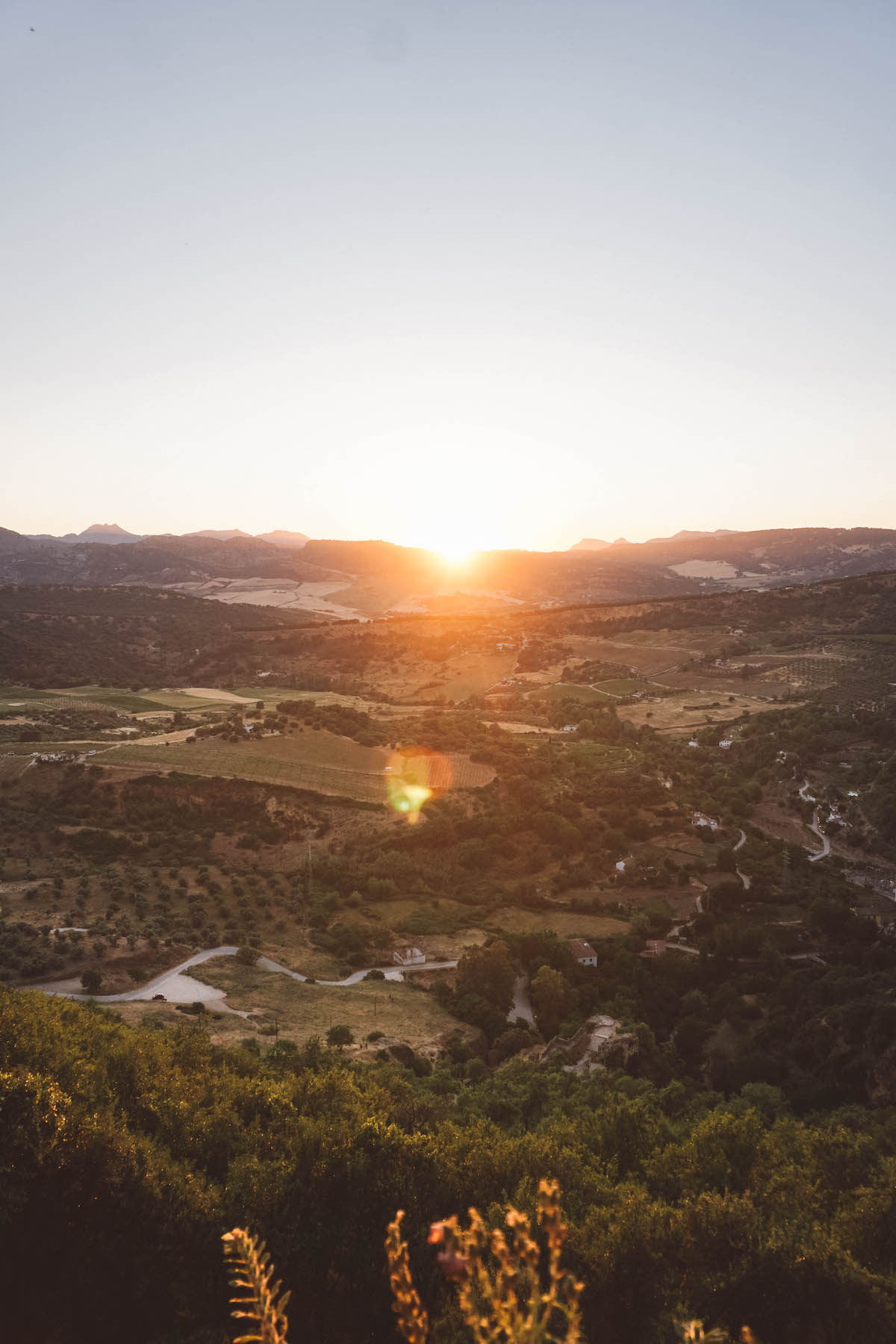
Jardines De Cuenca — Lovely hanging gardens on terraces set over the El Tajo gorge, facing the bridge. This is a good spot to come in the morning to photograph the sun rising over the bridge!
Puente Viejo — Another pretty (albeit less impressive) bridge in Ronda.
Collegiate Church of Santa Maria la Mayor — The inside of the church isn’t that impressive, but the viewing decks from the rooftop offer an amazing view of the Old Town and surrounding countryside.
Casa Museo Don Bosco — An old home-turned-sanatorium that operated until 2008. The home is very small, but the gardens with their cliffside views are the main attraction.
Sunset — You could watch the sunset by the Puente Nuevo bridge, but I recommend finding a quiet spot to sit at the Plaza de María Auxiliadora.
Spain Itinerary Days 11 – 13: Seville
Seville flourished under Muslim rule and rose to further prominence under the Catholic monarchy following the discovery of the Americas. Much of Spain’s trade with the Americas was facilitated in Seville, making it the country’s richest city for nearly 100 years.
Seville is the most diverse city on this southern Spain 2-week itinerary, both in terms of attractions and the local culture. It’s also the biggest city on this itinerary, so if you have the time and desire you can certainly spend more days here either to explore the city more in depth or to take day trips.
Read my full Seville itinerary for more details on the attractions listed below!
Day 1 in Seville
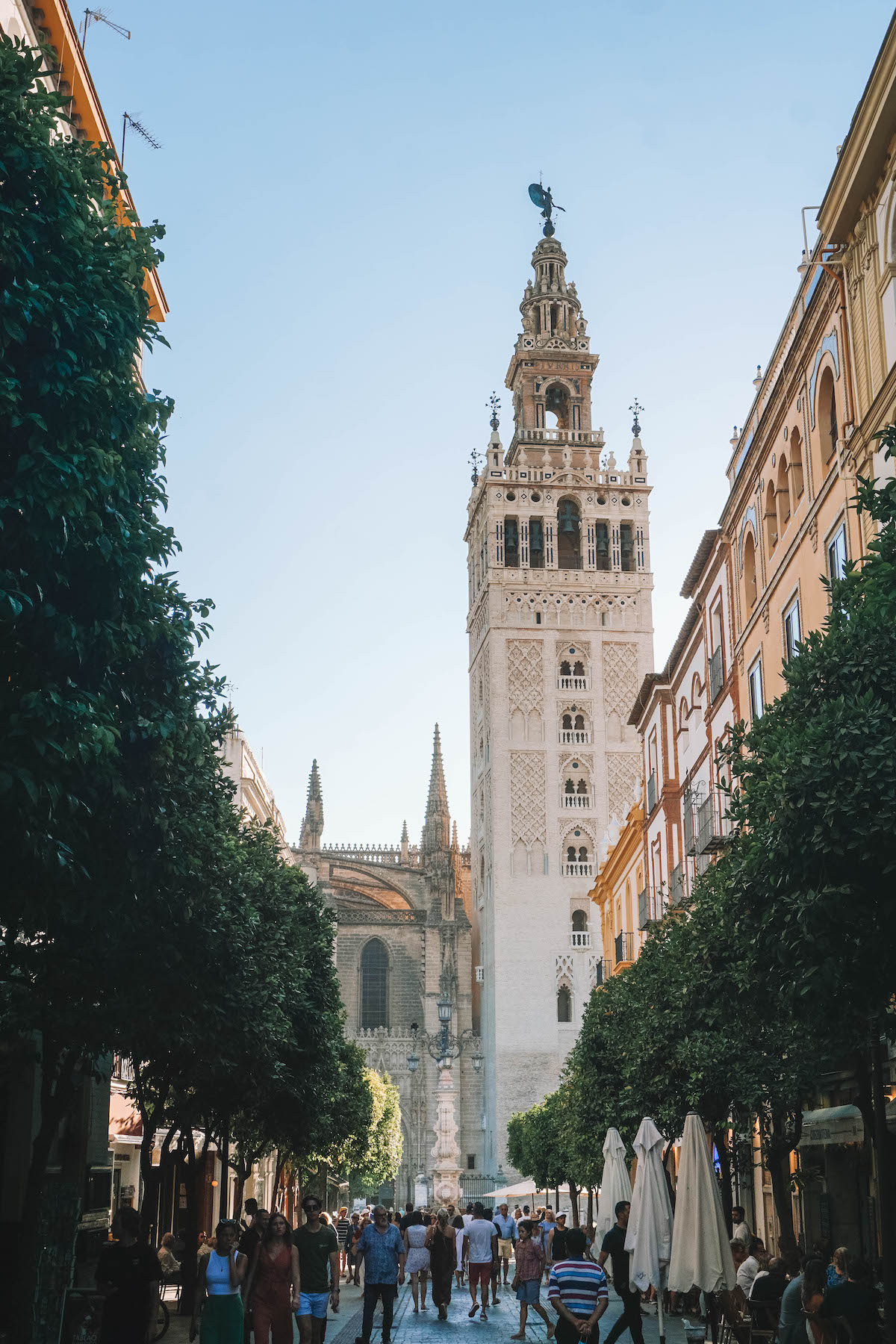
Royal Alcazar — A palace complex originally built by the Muslims to offer them a more strategic position next to the port (i.e. where the city’s wealth flowed in). Arrive first thing in the morning to avoid waiting in a long line.
Cathedral (shown above, left)— The largest Gothic cathedral in the world, and the third largest in general!
Giralda Tower — The symbol of Seville! La Giralda was originally the minaret of the mosque that stood on this site. In the 17th century, the cathedral’s bell tower was built atop the minaret.
Maria Luisa Park — Palace gardens that were donated to the city and transformed into a sprawling public park. The park is divided into smaller gardens and gathering areas, making it a fun spot to explore.
Plaza de España (shown above, right)— End your day here to watch the sunset! The Plaza de España was built for the Ibero-American Exhibition of 1929 and was designed to showcase Spain’s accomplishments in industry and architecture.
Day 2 in Seville
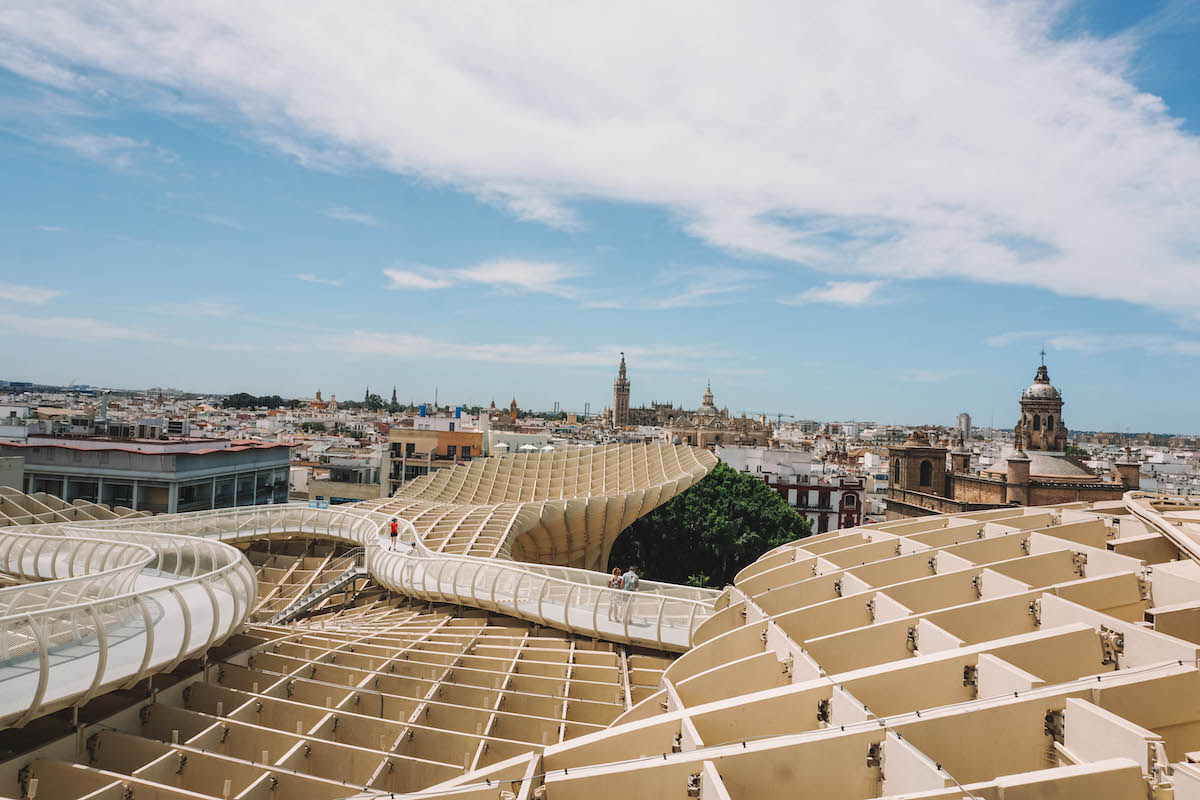
Setas de Sevilla (shown above)— A wooden structure in Encarnacion Square that has a walkway and viewing platform on top. If it’s not in your budget to ascend to the viewing platform, the structure is still really cool when seen from below.
Lebrija Palace — A 16th century palace that was heavily renovated in the 20th century to accommodate a private collection of ancient Roman mosaics. If you love house museums, you MUST come here!
Collegiate Church of El Salvador — A pretty Baroque church that was built on the site of what was the Great Mosque in Muslim Seville.
Museum of Fine Arts — An art museum housed in the former La Merced convent. This is a great spot to end the afternoon as a means of escaping the heat!
Day 3 in Seville
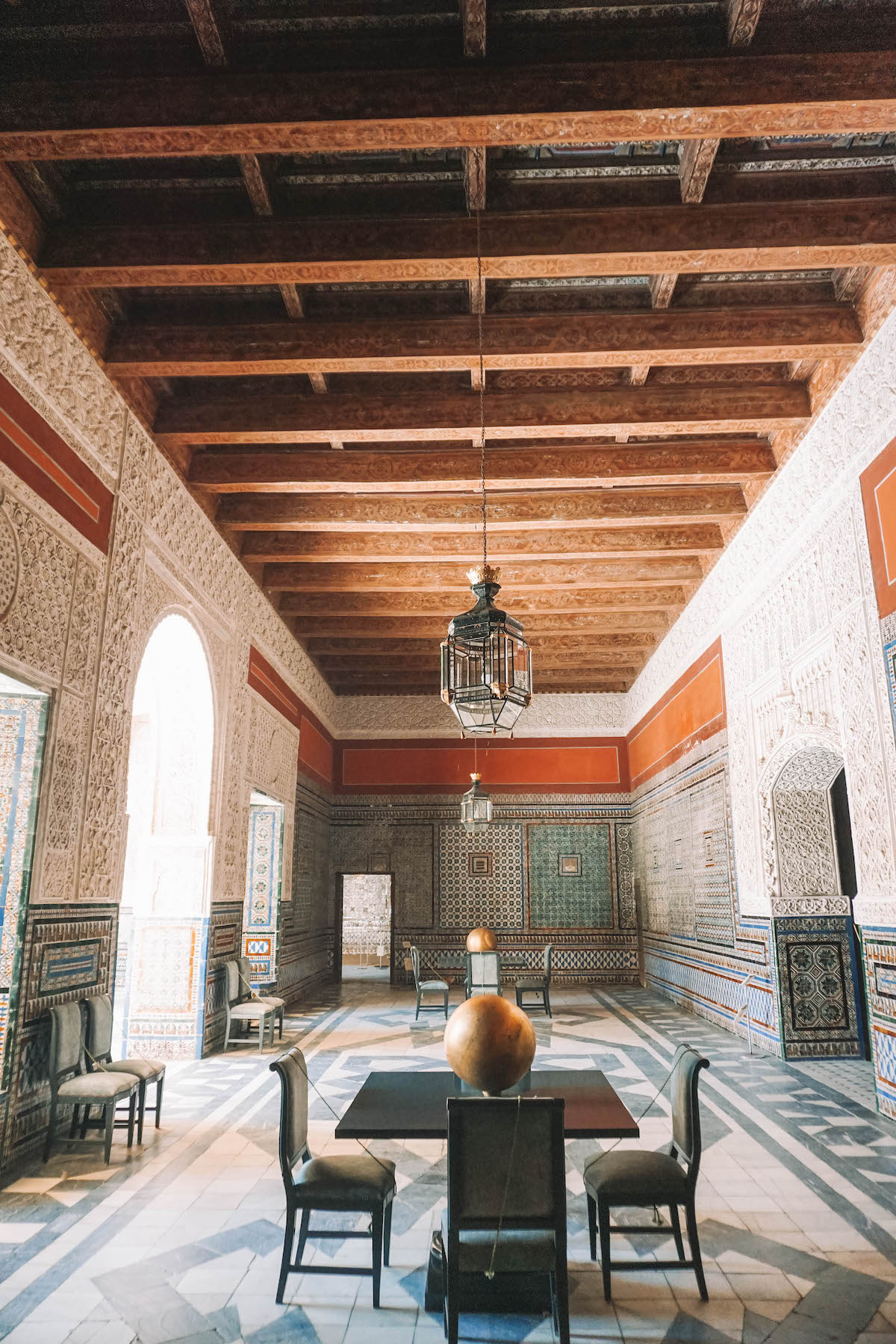
Walking Tour of Triana — The free Sandemans walking tour of Triana offers a unique perspective on Seville’s 2,000-year history.
Mercado de Triana — A covered market selling fresh produce and seafood. There are also restaurants inside, which is where I recommend grabbing lunch today.
Archivo de Indias — Free to enter! The Archives of the Indies houses 80 million pages and maps (all original!) relating to Spain’s massive empire from the 18th to 19th centuries.
Casa de Pilatos (shown above)— A 15th century palace decorated with azulejo (Spanish glazed tiles).
Free time to explore! — Seville is walkable, and there’s a lot packed into the city center. Give yourself some free time to wander the streets and enjoy your final afternoon in Spain.
Adios, Andalucía!
Hopefully this southern Spain 2-week itinerary have given you plenty of information — and then some! — to make planning your vacation easier. If you have any questions about planning a trip to Andalucía, don’t hesitate to leave me a comment below!
Don’t forget to follow me on Instagram to keep up with my daily adventures in Berlin and beyond!

More Places to Visit in Southern Europe:
- 3-Day Florence Itinerary: The Best Things to Do!
- Best Things to Do in Corfu, Greece
- What to Do & See in Athens, Greece
- All of my Europe travel recommendations!
Reader Interactions
Leave a reply cancel reply.
Save my name, email, and website in this browser for the next time I comment.
This site uses Akismet to reduce spam. Learn how your comment data is processed .
Comments & Reviews
October 18, 2022
Do you commercially run such tours? We are on the wrong side of 65 (esposa/mi) and never been to Europe. I enjoyed reading your summary. I’ve been put off some “tours” by people complaints. Cost is also a factor, many seem for royalty we’d feel uncomfortable in such company. I say this if we decide to do less with quality but the upper middle class would be far to… Regards Tony
November 9, 2022
Hi Tony, no, I do not provide any kind of travel planning or tour services. Right now I just provide awesome, free guides online right here on my blog 🙂 Hopefully you’re able to visit Spain soon though!
May 20, 2023
Very impressive, thanks for sharing!
December 16, 2023
Awesome , information . What hotels do you recommend? We are planning to do this in March.
December 29, 2023
Hi Sonia! How exciting that you’ll be visiting southern Spain in March, I think you’ll have an amazing time! Unfortunately I can’t recommend any specific hotels because I stayed in AirBNBs throughout my stay. However, let me know if you’d like general recommendations for areas of the cities to stay in and I can provide info on the neighborhoods I was in.
- About Claire
- Get in Touch
- Read the Blog
- Privacy Policy
Keep Up With Latest Travels!
Subscribe to the newsletter and join me on all the latest adventures, travel tips and more!

The Man in Seat 61
A beginner's guide to
Train travel in spain.
- Buy train tickets
- Buy ferry tickets
- Book a hotel
- Privacy & cookies
- Home
Train travel UK & Ireland...
Train travel in europe..., train travel in asia..., train travel in africa..., train travel in america..., train travel in australasia, see spain by train....
Once upon a time, Spain had one of the most backward train networks in western Europe. Now, they have one of the best, indeed, one of my favourite rail systems. High-speed AVE trains (Alta Velocidad Española) link major cities at up to 300 km/h (186mph), and if you book in advance online you can find some great cheap fares. This page will give you a heads-up on how to travel cheaply around Spain by train.
A guide to taking the train in Spain
International trains to & from Spain
Other train travel information, useful country information, spain by train, the key things to know.
Avlo is a lo-cost subsidiary of Renfe which runs Barcelona-Madrid, other routes planned. Their trains are one class only, with no-catering.
Ouigo Spain is a lo-cost subsidiary of SNCF (French Railways) which runs Barcelona-Madrid, Madrid-Valencia & Madrid-Alicante, other routes planned. Two class, with basic catering.
Elige (Choice) = A semi-flexible fare, you can choose between Elige (2nd class seat) or for a higher price, Elige Confort (1st class seat).
Now for the catch, and it's some catch that Catch 22: You can only buy a Tarjeta Dorada in person at a Renfe station when you get to Spain. You cannot buy it online. But you can't buy tickets online in advance with the Tarjeta Dorada discount until after you've bought the card because you need to enter the card number to get the discount. So if you're planning a trip to Spain, it's better to forget about being senior and just buy a normal adult advance-purchase ticket now for perhaps €30 without any Tarjeta Dorada discount, than to wait until you get to Spain to buy a Tarjeta Dorada to get 25% off a fare which by that time (on or close to departure date) might have risen to €90. Just let that sink in...
How to buy tickets & check train times
You can buy tickets at any Renfe station or online at www.renfe.com , but see the advice on using Renfe.com below . There's no booking fee, but Renfe.com is a pain to use with some confusing translations and quirks, it's also known for sometimes rejecting overseas payment cards. It's far easier (and quicker!) to buy tickets in plain English using www.thetrainline.com (in €, £ or $, small booking fee, works for anyone from any country) or www.raileurope.com ( various currencies, small booking fee), Omio.com (various currencies, small booking fee) or www.petrabax.com (in US$, with a small mark-up). These websites all connect to Renfe's ticketing system and sell the same trains at the same prices with no payment problems and the same official Renfe print-at-home tickets.
Real time information
You can see whether a train is on time and which platform it will leave from, if you download thetrainline.com 's app and run an enquiry for today. Trainline's app show real time information for all operators, Renfe, Avlo, Iryo & Ouigo.
Combinado Cercanias : Free suburban travel with a long-distance ticket
When you buy a ticket for one of Renfe's long-distance trains (AVE, EuroMed, Alvia, Intercity) of any fare type in any class for a journey within Spain, you get free travel from any Renfe suburban station at the start of your journey and free travel to any Renfe suburban station at the end of your journey, in the following cities:
Asturias, Barcelona, Bilbao, Cadiz, Madrid, Malaga, Murcia/Alicante, San Sebastian, Santander, Seville, Valencia and Zaragoza. You also get free travel from/to any FEVE local station in Asturias, Santander, Bilbao & Cartagena.
If your ticket includes this, it will say Combinado Cercanias in the corner with a reference number.
At your starting city, you must use the suburban ticket within 3 hours of your long-distance train departure, and at your destination you must use the suburban ticket within 4 hours of your long-distance train's arrival.
You can travel to or from any suburban station within that city's numbered zones, but not outside the zones (so longer routes such as Barcelona to Portbou or Latour de Carol are not included).
Different cities have slightly different processes: To access the suburban ( cercanias ) platforms in Madrid or Malaga, place the QR code of your long-distance ticket against the scanner on the automatic ticket gates and they should open. In Barcelona, you must show your long-distance ticket at the information desk and ask for a ticket to open the cercanias ticket gates.
Add a snack box to your booking in Elige Confort on AVE & EuroMed . You can add a snack box to your booking if you buy an Elige fare for Confort class on an AVE or EuroMed train at Renfe.com. You can add it when you book or afterwards, at least 12h before the train leaves its origin station.
Back to top
Railpasses for Spain
Option 1, eurail & interrail passes.
Unfortunately, Interrail & Eurail passes do not offer hop on, hop off convenience in Spain because all Spanish long-distance train and even some regional trains require a reservation, for Interrail & Eurail passholders this costs around €10 for AVEs and similar front-rank trains or €7 for lesser trains. This must be factored into your budget.
The next issue is that Interrail & Eurail reservations for Spanish trains often can't be made online. Passholder reservations for most front-rank high-speed AVE trains can now be made online using the Interrail/Eurail reservations service and some Alvia and Intercity trains can also be booked this way. However, others can't be booked online at all and most Media Distancia trains can't be booked online either, you have to go to a station when you reach Spain. More about how to make Interrail/Eurail passholder reservations in Spain .
Option 2, Renfe's Spain Pass
Renfe offer its own Spain Pass to anyone resident outside Spain. This can be better value as it includes all reservations, no hidden costs. However, unlike Interrail & Eurail passes it does not give unlimited travel. One journey = 1 train ride, if you change trains, that's 2 journeys.
You can buy a Renfe Spain Pass giving either 4, 6, 8 or 10 individual one-way train journeys of any length in a one-month period on all of Renfe's long-distance & medium-distance trains, including AVE, EuroMed, Alvia, Intercity, Media Distancia & Avant.
With the Renfe Spain Pass, reservations can be made for free and there are no extra fees or quotas - if there is an empty seat on the train, you're entitled to it with your Spain Pass, although be warned that Spanish high-speed trains can indeed get fully-booked close to departure date.
How to buy a Renfe Spain pass
You can buy a Spain pass online at www.renfe.com/es/en.../renfe-spain-pass (has a few quirky translations and sometimes struggles with some credit cards). The passes are completely electronic. After setting up an account and buying your own pass, you can buy passes for your travelling companions as separate transactions. They will also appear as passes in your account.
You have up to 6 months to make your first trip after you buy the pass, then one month to use the remaining trips after that first trip.
You can make reservations to go with a Spain pass either at stations as you go or at www.renfe.com , but the online method isn't obvious. Here's how to make Renfe Pass seat reservations using www.renfe.com ( feedback appreciated ):
1. After buying your Renfe pass, go to www.renfe.com and switch it to English by clicking the globe logo at top right and select Ingles .
2. Log into your account and select the tab called My passes. You should see each Renfe pass you have bought for you and your companions.
3. At the top of that page is a from and to field, like the journey planner used to book tickets on their home page. Use this to make reservations, the price will be shown as €0.
You can only make reservations for one person/pass at a time. But if you click Choose seats you can select your seat from a seat map and can use this feature to select seats next to each other.
Important: When you make your first reservation, Renfe assumes that this is the first train you want to take with your pass and automatically starts the one-month pass validity from that date. This now prevents you from making reservations on an earlier date. So make sure that the first reservation you make is for the day you intend to start using the pass!
Spanish train fares & classes explained
In July 2021, Renfe introduced a completely new fares structure for all its long-distance trains including the high-speed AVE, and also changed the terms it uses for 1st & 2nd class. It's easy to get confused between what's a class of accommodation and what's a fare type, so here's a run-down of Renfe's new classes & fares.
Standard & Comfort class
Básico, elige & premium fares.
Elige (Choice). A semi-flexible fare. If you select this you get a choice of Elige to travel in Standard (2nd) class or Elige Confort at a higher price to travel in Comfort (1st) class but without any included food or access to lounges. Elige & Elige Confort tickets are refundable & changeable for a fee.
What are Spanish trains like?
AVE or Alta Velocidad Española is Spain's front-rank high-speed train. Reservation is compulsory, and all trains have a cafe-bar. AVEs are now being fitted with free WiFi. If you pay the Premium fare, an airline-style hot tray meal with wine is included although on some departures you get a snack box instead, see the food & drink section above . AVE trains come in various types.
S100 : The original French-designed AVE used between Madrid & Seville and also now used into France, see the photos below.
S102 & S112 : The Spanish Talgo-designed AVE used between Madrid & Malaga, Barcelona & Malaga/Seville, a classy train indeed, see S102/S112 photos here .
S103 : The German-designed AVE used between Barcelona & Madrid plus some Madrid-Malaga trains, see S103 photos here .
Alvia & EuroMed trains
These S130 trains operate the EuroMed services linking Barcelona with Valencia & Alicante, as well as Alvia trains from Madrid to Cadiz & Huelva. They consist of little articulated coaches built by the Talgo company sandwiched between two duck-billed power cars. There are other Alvia services operates by similar trains with a diesel power-car added, and a few Alvia trains (including Barcelona to Bilbao, Pamplona & San Sebastian) operated by the wedge-nosed S120 type, of similar high quality. All Alvia trains have a cafe-bar. On EuroMed services a hot meal with wine is usually available in Comfort class on weekdays & Sundays if you buy a Premium ticket or add the meal to an Elige ticket, see the information above .
Intercity trains
These run on many long distance routes, including Madrid-Ronda-Algeciras, Madrid-Granada, Madrid-San Sebastian. Most (including Madrid-Algeciras) are former Altaria trains, little articulated trains built by the Talgo company and hauled by a separate locomotive, they have adjustable axles so they can run at up to 200 km/h on the high-speed AVE lines (which are standard European gauge) then go though a gauge-changing shed to emerge on traditional Spanish broad gauge to complete their journey on the classic Iberian gauge network. A few Intercity trains have been created by rebranding former Alvia trains built by CAF, for example on the Madrid-San Sebastian route, which also have gauge-changing wheels. All Intercity trains have a cafe-bar.
Avlo, Iryo, Ouigo...
Spain's high-speed lines have been opened up to competition. Renfe now has a lo-cost brand called Avlo , and competitor operators Iryo & Ouigo now operate on key routes including Barcelona-Madrid , Madrid-Valencia, Madrid-Cordoba/Seville/Malaga. See the Barcelona-Madrid page for a run down of these 3 operators .
How to buy train tickets for Spain
When does booking open? Anything between 15 days and 11 months, Renfe is a law unto itself when it comes to booking horizons, see the introduction .
What can these sites sell? They can sell Renfe's mainline trains and sometimes competing high-speed trains run by Avlo, Iryo or Ouigo. They can't sell tickets for Renfe's suburban (cercanias) routes including Latour de Carol-Barcelona or Cerbère-Portbou-Barcelona, nor can they sell tickets for Euskotren (Hendaye-San Sebastian-Bilbao) or the former FEVE routes (Bilbao-Santander-Gijon-Ferrol).
Option 1, buy at Raileurope.com
The quickest & easiest way to buy Spanish train tickets is at Raileurope.com with cheap advance-purchase fares & print-at-home or collect-at-station tickets. You can choose to pay in €, £ or $. There's a small booking fee.
Raileurope.com links directly to Renfe's (Spanish Railways) ticketing system and charges the same price as Renfe themselves with the same print-your-own ticket delivery. Unlike Renfe's own site it's in plain English without any of Renfe.com's quirky translations and no credit card rejection problems.
Raileurope.com can book the lo-cost Barcelona-Madrid Ouigo Spain trains as well as the normal Renfe trains, but cannot book lo-cost Avlo trains
Anyone from any country can use Raileurope.com as international credit cards are welcomed. It can also sell international trains between Spain and Portugal or France, as it links to the French, German, Italian & British ticketing systems. Who are Raileurope.com?
Important: If you have a baby or infant, remember to add them as a child and enter their age, they'll still go free but will get the free infant ticket which is now necessary in Spain.
Option 2, buy at Thetrainline.com or Omio.com
www.omio.com & www.thetrainline.com also connect to Renfe's ticketing system to sell Renfe tickets at exactly the same prices as Renfe with the same print-your-own or collect-at-station tickets, very easily, all overseas credit cards accepted. Both charge a small booking fee. They can also book Ouigo Spain trains & Avlo trains . Who are Thetrainline.com?
Option 3, buy at Petrabax.com , easy to use, in US$
If you'd rather pay in USD, use www.petrabax.com . This is a US-based agency which also links directly to the Renfe ticketing system to sell the same trains as Renfe.com with the same print-at-home tickets. They add a small mark-up, but it's easy to use in plain English and it avoids the English translation and credit card acceptance problems people can experience with Renfe.com. Anyone from any country can use Petrabax, including the United States, Canada, Australia, India & Singapore.
Option 4, buy at Renfe.com
How to use www.renfe.com.
Renfe are usually particularly late opening reservations for dates after the main annual timetable change in mid-December.
G uidebooks

Click the images to buy online at Amazon.co.uk
Alternatively, download just the chapters or areas you need in .PDF format from the Lonely Planet Website , from around £2.99 or US$4.95 a chapter.
European Rail Timetable & maps

Rail Map Europe is the map I recommend, covering all of Europe from Portugal in the west to Moscow & Istanbul in the east, Finland in the north to Sicily & Athens in the south. Scenic routes & high-speed lines are highlighted. See an extract from the map . Buy online at www.europeanrailtimetable.eu (shipping worldwide) or at www.amazon.co.uk (UK addresses).
Hotels in Spain
Backpacker hostels.
www.hostelworld.com : If you're on a tight budget, don't forget about backpacker hostels. Hostelworld offers online booking of cheap private rooms or dorm beds in backpacker hostels in Paris and most other European cities at rock-bottom prices.
Environmentally aware, actively ethical adventures in Spain: www.wildsideholidays.com
For environmentally-aware guesthouses offering walking, hiking, riding or nature-watching in the Spanish countryside and national parks, try www.wildsideholidays.com , a new site listing independent, environmentally-aware properties across Spain. It was started by British ex-pats Clive Muir and Sue Eatock, when they found nowhere to advertise their own wonderful property deep in the heart of the Sierra de Grazelema near Ronda in Southern Spain.
Custom-made tours of Spain
Railbookers, railbookers.co.uk.
If you want to tour Spain by train, with all your train reservations and hotels sorted for you to your own specification, contact train tour specialists Railbookers and they'll create the best rail holiday for you, hassle-free. They take good care of their clients and get a lot of repeat business. In particular, check out their Ultimate Barcelona, Madrid & Seville tour on their US & Canada site, or a top seller on their UK site, Madrid & Andalusia. They have offices in the UK, USA & Australia.
Tailor Made Rail, tailormaderail.com
Tailor Made Rail can arrange tours of Spain by train based on your own requirements, they welcome complex itineraries. As it's a package, they'll take care of you if anything happens on one part of the trip, for example, a national strike. They're TTA-protected - like ATOL, but not only for agencies that sell air travel.
Call their dedicated seat61 phone line 020 3778 1461 and quote seat 61 when booking. From outside the UK call +44 20 3778 1461. Lines open 09:00-17:30 Monday-Friday. Their website is www.tailormaderail.com/destinations/spain .
Car hire comparison: www.carrentals.co.uk
The award-winning website www.carrentals.co.uk compares many different car hire companies including Holiday Autos, meaning not only a cheapest price comparison but a wider choice of hire and drop off location.
Travel insurance & other tips
Always take out travel insurance.
You should take out travel insurance with at least £1m or preferably £5m medical cover from a reliable insurer. It should cover trip cancellation and loss of cash & belongings up to a reasonable limit. These days, check you're covered for covid-19-related issues, and use an insurer whose cover isn't invalidated by well-meant but excessive Foreign Office travel advice against non-essential travel. An annual policy is usually cheapest even for just 2 or 3 trips a year, I have an annual policy with Staysure.co.uk myself. Don't expect travel insurance to bail you out of every missed connection, see the advice on missed connections here . Here are some suggested insurers, I get a little commission if you buy through these links, feedback always welcome.
Get an eSIM with mobile data package
Don't rely on WiFi, download an eSIM with a European mobile data package and stay connected. Most newer mobile phones can download a virtual SIM including iPhone 11 & later, see device compatibility list . There's no need to buy a physical SIM card! Maya.net is a reliable eSIM data retailer with a 4.5 out of 5 Trustpilot rating and a range of packages including unlimited data .
Get a Curve card for foreign travel
Most banks give you a poor exchange rate then add a foreign transaction fee on top. A Curve MasterCard means no foreign transaction fees and gives you the mid-market exchange rate, at least up to a certain limit, £500 per month as I write this. The money you spend on your Curve card goes straight onto one of your existing debit or credit cards. And you can get a Curve card for free.
How it works: 1. Download the Curve app for iPhone or Android . 2. Enter your details & they'll send you a Curve MasterCard - they send to the UK and most European addresses. 3. Link your existing credit & debit cards to the app, you can link up to two cards with the free version of Curve, I link my normal debit card and my normal credit card. 4. Now use the Curve MasterCard to buy things online or in person or take cash from ATMs, exactly like a normal MasterCard. Curve does the currency conversion and puts the balance in your own currency onto whichever debit or credit card is currently selected in the Curve app. You can even change your mind about which card it goes onto, within 14 days of the transaction.
I have a Curve Blue card myself, it means I can buy a coffee on a foreign station on a card without being stung by fees and lousy exchange rates, just by tapping the Curve card on their card reader. The money goes through Curve to my normal debit card and is taken directly from my account (in fact I have the Curve card set up as payment card on Apple Pay on my iPhone, so can double-click my phone, let it do Face ID then tap the reader with the phone - even easier than getting a card out). I get a little commission if you sign up to Curve, but I recommend it here because I think it's great. See details, download the app and get a Curve card , they'll give you £5 cashback through that link.
Get a VPN for safe browsing. Why you need a VPN
When travelling you may use free public WiFi which is often insecure. A VPN encrypts your connection so it's always secure, even on unsecured WiFi. It also means you can select the geographic location of the IP address you browse with, to get around geoblocking which a surprising number of websites apply. See VPNs & why you need one explained . ExpressVPN is a best buy with a 4.7 out of 5 Trustpilot ranking which I use myself - I've signed up as an ExpressVPN affiliate, and if you go with expressvpn.com using this link you should see a special deal, 3 months free with an annual subscription. I also get some commission to help support this site.
Carry an Anker powerbank
Tickets, reservations, hotel bookings and Interrail or Eurail passes are often now held on your mobile phone. You daren't let it run out of power, and you can't always rely on the phone's internal battery or on being near a power outlet. I always carry an Anker powerbank which can recharge my phone several times over. Buy from Amazon.co.uk or Buy from Amazon.com .
Touring cities? Use hill walking shoes!
One of the best things I've done is swap my normal shoes for hill-walking shoes, in my case from Scarpa. They're intended for hiking across the Pennines not wandering around Florence, but the support and cushioning for hiking works equally well when you're on your feet all day exploring foreign cities. My feet used to give out first and limit my day, now the rest of me gives up before they do!
Back to 'Rail travel to Europe' general page
Back to home page

2 Day – 2 Week Southern Spain Itinerary! A Complete Guide to Planning Your Trip!
Categories Europe , Itinerary , Spain
After my recent visits to South Spain, I want to help you plan your Southern Spain itinerary with a range of itineraries you can follow and also tell you the best places to visit in Southern Spain so you can plan your own trip!
This post gives public transport options as the buses and trains in South Spain are great! But it is very focused on a Southern Spain road trip which will make it possible for you to visit some smaller towns and villages in Southern Spain too!
Andalucia is the region that covers most of Southern Spain and planning an itinerary for Andalucia will give you mountains, historic buildings, beautiful beaches, the taste of Tapas and the sound of Flamenco!
So Vamos, let’s get into this complete South Spain itinerary guide to help you plan your Southern Spain trip!
Find What You're Looking For Easily Here!
South Spain Itinerary
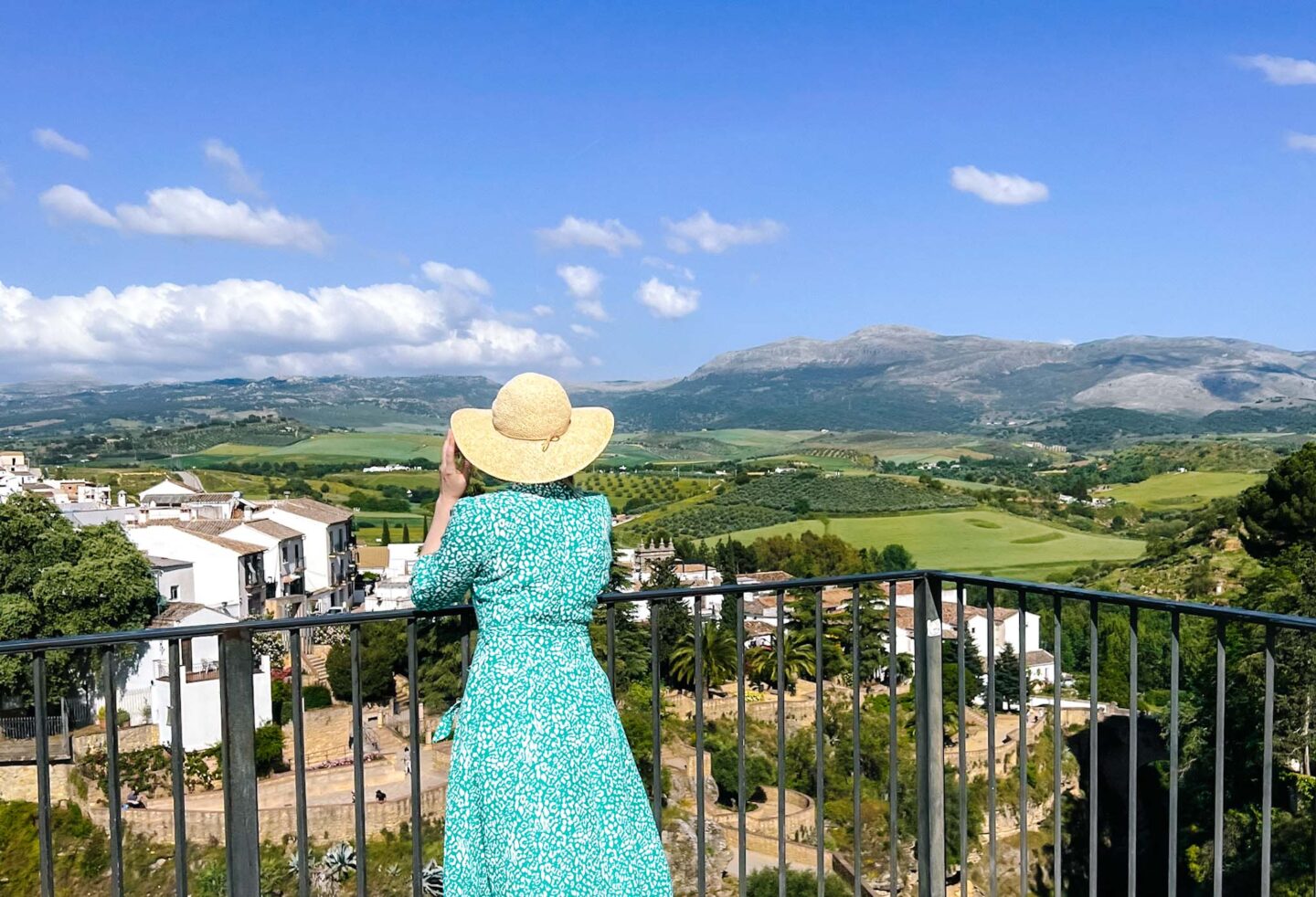
Best places to visit in Southern Spain
Let’s jump in with the best places to visit in the South of Spain so you can start planning your Southern Spain itinerary based on how long you have .
Here is a map with all of these places to go in Southern Spain on it to help you plan your trip too.
I have noted roughly how much time you need in each place , but below in the Souther Spain itineraries section , I’ll go into more detail about where to visit in Southern Spain based on the time you have like 4 days, 7 days, 10 days or 14 days in South Spain .
Got 10 days to explore Europe? Here are some great 10 day Europe itinerary options to help you see a lot!

– Malaga
Malaga is the best place to start your South Spain itinerary because it has the biggest airport with the most amount of flights and because it’s so big you can often get some really good deals and cheap flights into Malaga Airport from elsewhere in Europe!
Malaga used to be seen as the gateway to the beaches of the Costa del Sol , but Malaga City has been revamped and these days it’s a great place to visit in its own rights too! There are many things to do in Malaga worthy of a day, or a few days!
Malaga Airport also offers a huge range of car rentals because it is the biggest airport. We rented a car from Malaga Airport recently using RentalCars and then visited many of the places on this Spain itinerary!
Search car rental from Malaga Airport for your Southern Spain trip here on RentalCars!
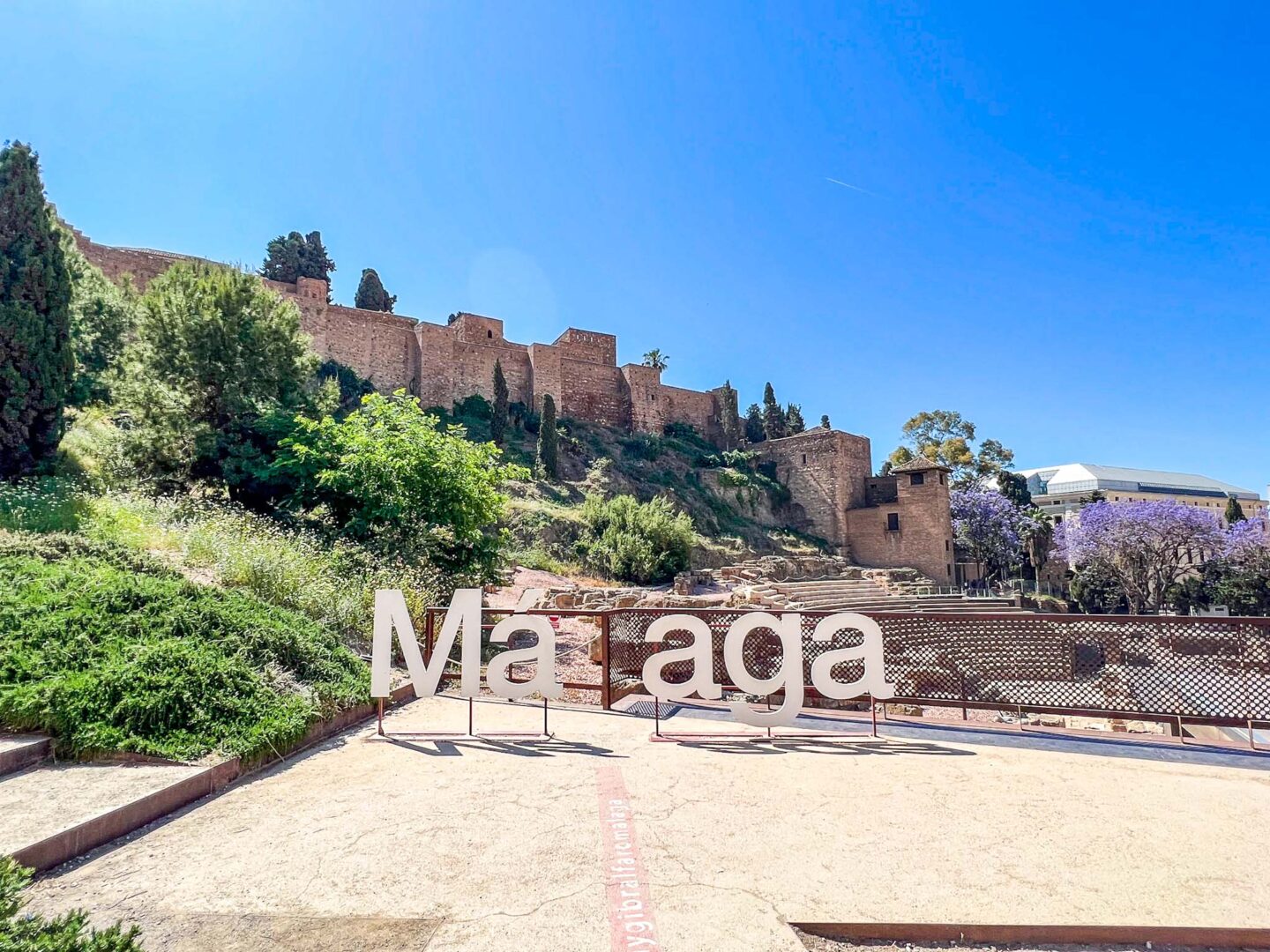
Things to do in Malaga
- Alcazaba – this has to be top of your list on things to do in Malaga as it’s the top Malaga tourist attraction . It’s a Moor-ish style medieval fortress which offers a lot of history and great views! Buy great value tickets here!
- Castillo de Gibralfaro – next to Alcazaba but further up the hill, this is the Castle on the hill! You can walk around the old walls of the fortress castle and it offers even better views! It’s a great sunset spot in Malaga too!
- Ancient Roman Theatre – as the base of Alcazaba is a museum and an anicent roman theatre. You can go inside but you can equally see a good view of the theatre from the street.
- Malaga Cathedra l – this is one big Cathedral with an impressive a 16th Century Baroque facade. There is also a museum inside which requires a ticket.
- Picasso Museum – this is a treat for art lovers. It’s located in a restored 16th Century palace with over 200 pieces by Pablo Picasso. Buy tickets here!
- Mercado Central de Atarazana – visiting markets in Spain is always such a great thing to do, whether you want to pick up some fresh food or drink or take a wander around the local produce and this old-school market with an impressive stained glass front offers this.
- Playa de la Malaga – there are many beaches in Malaga along the coast but Playa de la Malaga is the city centre beach and for a city beach, it’s pretty good!
Tours and activities in Malaga!
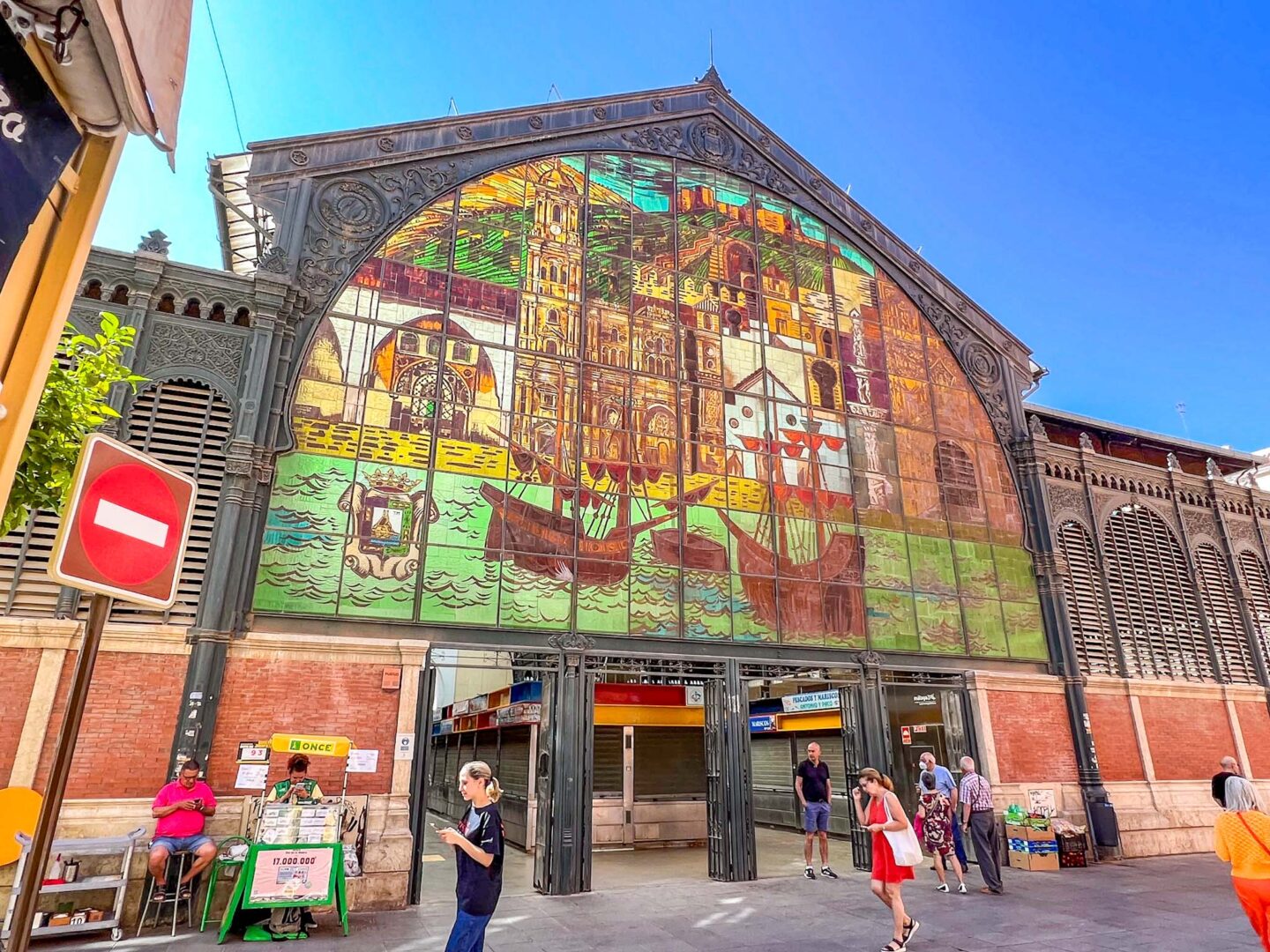
How much time to spend in Malaga?
Visiting the top tourist sights in Malaga City requires half a day at a minimum and 2 days at a maximum .
You may decide to spend more time in the area of Malaga though so you can enjoy more of the beaches as well as the things to do in Malaga city.
Also, Malaga acts as a great base for a Southern Spain trip because you can visit a lot of places from here, especially if you hire a car.
For example, in May, I stayed at 5* Higueron Hotel Malaga, Curio Collection by Hilton for 3 nights, we spent 1 day relaxing at the hotel and the other 2 days doing a Southern Spain road trip but with this Malaga base which was perfect for a long weekend in Southern Spain.
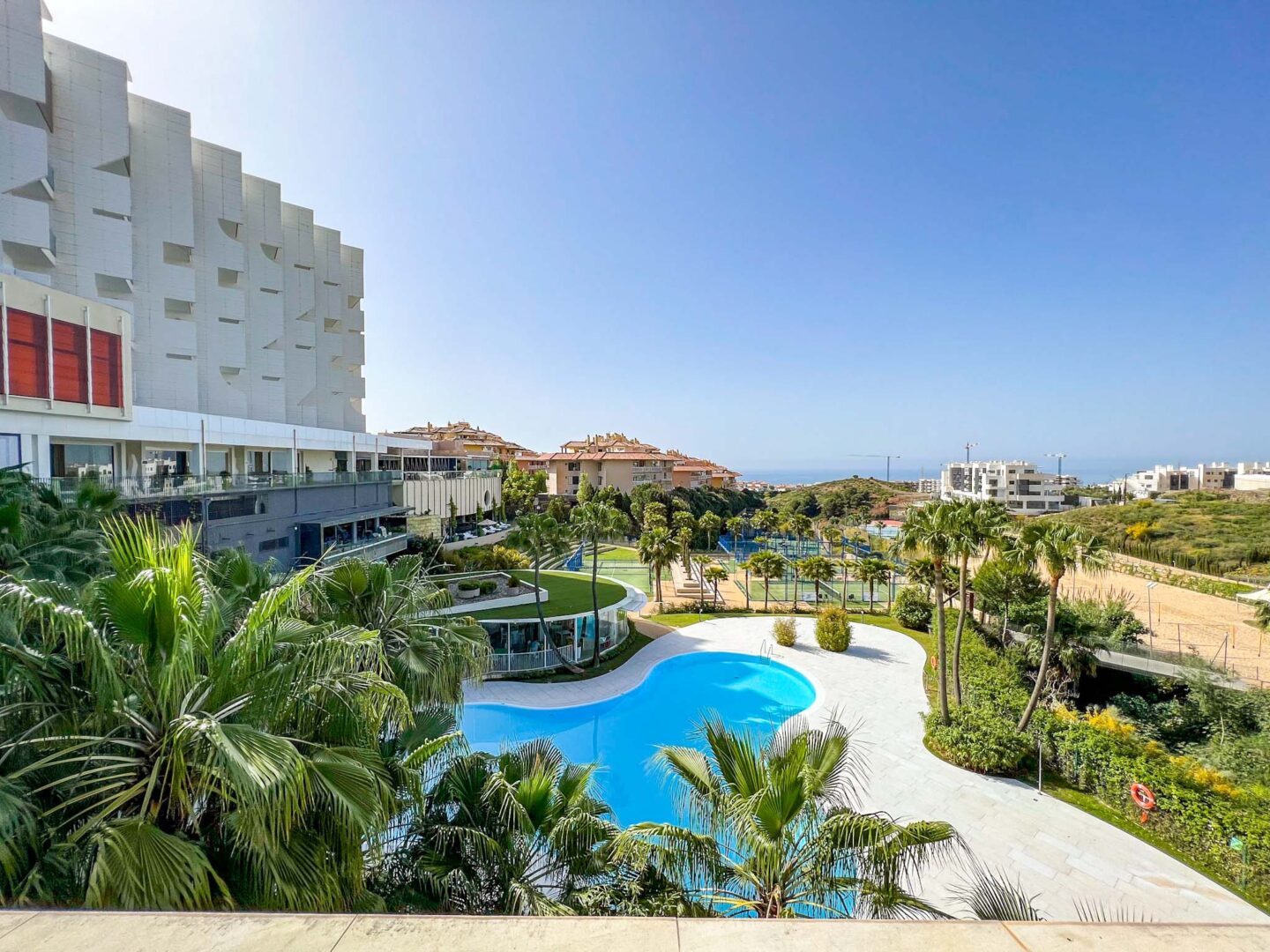
– Granada
When people think of Andalucia, they most likely think of Granada, or of the sights that you do see in Granada!
Granada is such a charming city. I love it because it has so much character and energy but it isn’t a huge city to navigate. Without a doubt, Granada has to be on your Southern Spain itinerary , without it, and a visit to Alhambra , your trip is not complete!
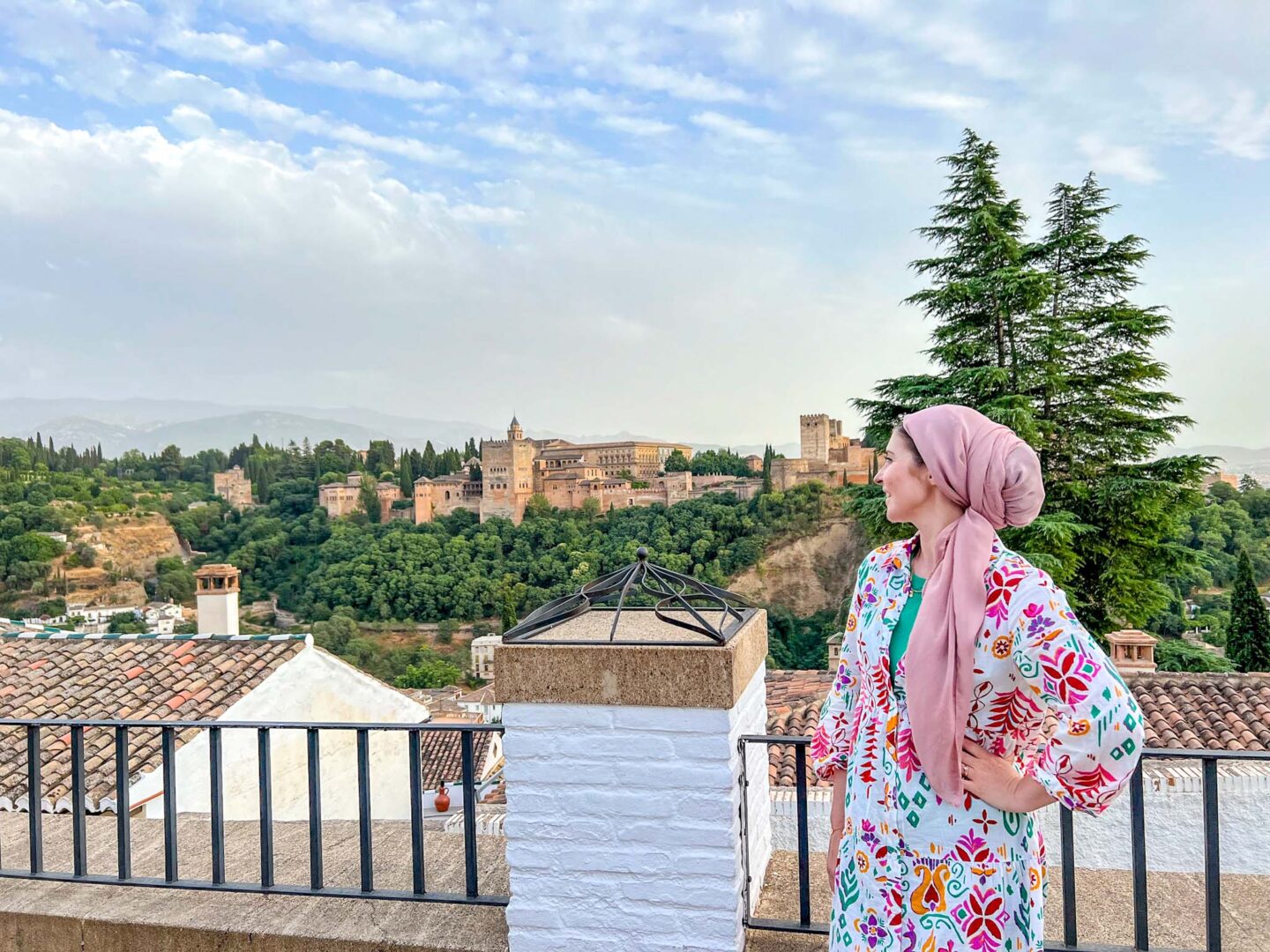
Things to do in Granada
- Alhambra – this is one of the top tourist attractions in Spain and rightly so! You need to PURCHASE TICKETS IN ADVANCE which you can do here and should do as soon as you know your trip dates, and remmeber to take your passport. Alhambra takes 2-4 hours to go around. It’s a huge medieval complex with palaces, throne rooms and gardens from when the Muslims ruled Granada.
- Albacin – this is an area of Granada which is made up of small winding streets. Many of the lower streets are filled with shops and cafes but as you get further up the hill you can wander quiet residental streets. This is the old Muslim quarter of the city so you may feel like you’re in Morocco here!
- Granada Mosque – at the top of the Albacin is Granada Mosque. You should visit here even if you aren’t Muslim because the gardens are beautiful and it has the best view of Alhambra. Next to it is San Nicholas viewpoint outside the church but this viewpoint is better and much quieter.
- Granada Cathedral – a huge catholic cathedral, this is free to enter so definietly worth going inside.
- Flamenco Show – Andalucia is the home of Flamenco and although you’ll see more Flamenco in the streets of Seville, one of the best things to do in Granda is see a Flamenco show as they have so many high quality shows on offer.
- Shopping – there are so many shops in Granada, some are typical tourist souvenir shops, but others like Granart offer many beautful pieces using traditional Granada styles and artwork. There’s also a perfume shop I recommend called Patio de los Perfumes .
Tours and Activities in Granada
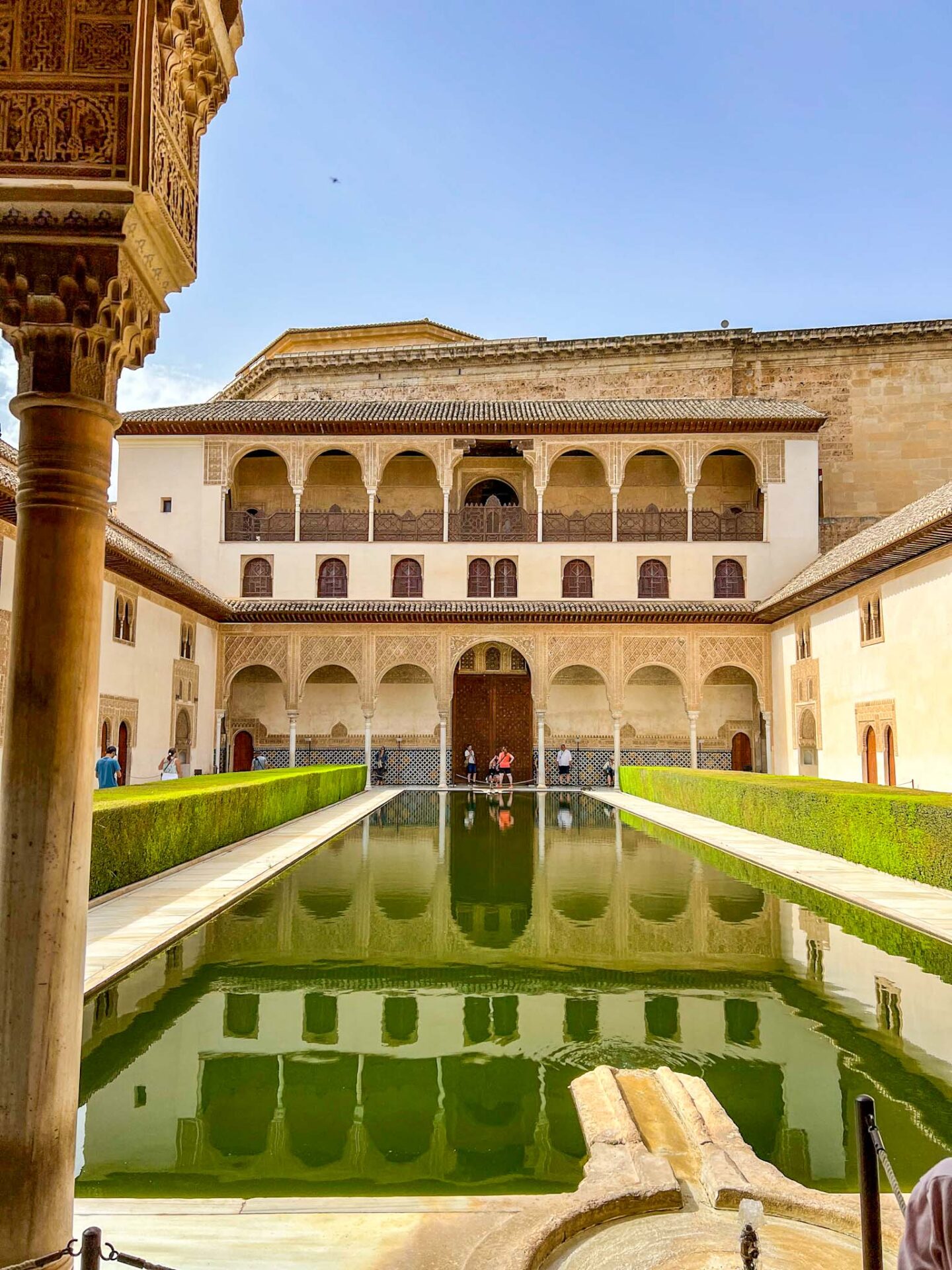
How much time to spend in Granada?
You need to factor in at least a few hours in Granada to visit Alhambra, plus a few more hours to see the rest of the city by foot at a minimum.
If you have limited time on your Southern Spain trip , you could spend 1 full day in Granada / 6-8 hours and this is enough time to see Alhambra and get a feel for the city.
However, I recommend at least 1 night and 2 days to get a better feel for the city, go for brunch and relax there like a local as well as sightseeing. And on that note, if you have longer, like 2 weeks in Southern Spain and somewhere on your South Spain itinerary to have a break in, this is a great place to do it. You could happily spend 3-5 days here relaxing and living that slow-paced Andalucian lifestyle, with lots of good food too!

– Seville
Seville is the capital city of Andalucia and the largest of the cities in Andalucia. It’s great, charming and you’ll get all the Spanish feels when you see and hear Flamenco being performed on the streets .
Seville has some of the best places to visit in Andalucia, and it’s also great to use as a base to see more of Southern Spain from because of its great road, bus and train links.
Seville is made up of different neighbourhoods which are great to explore and stay in, check out where to stay in Seville and the best neighbourhoods!
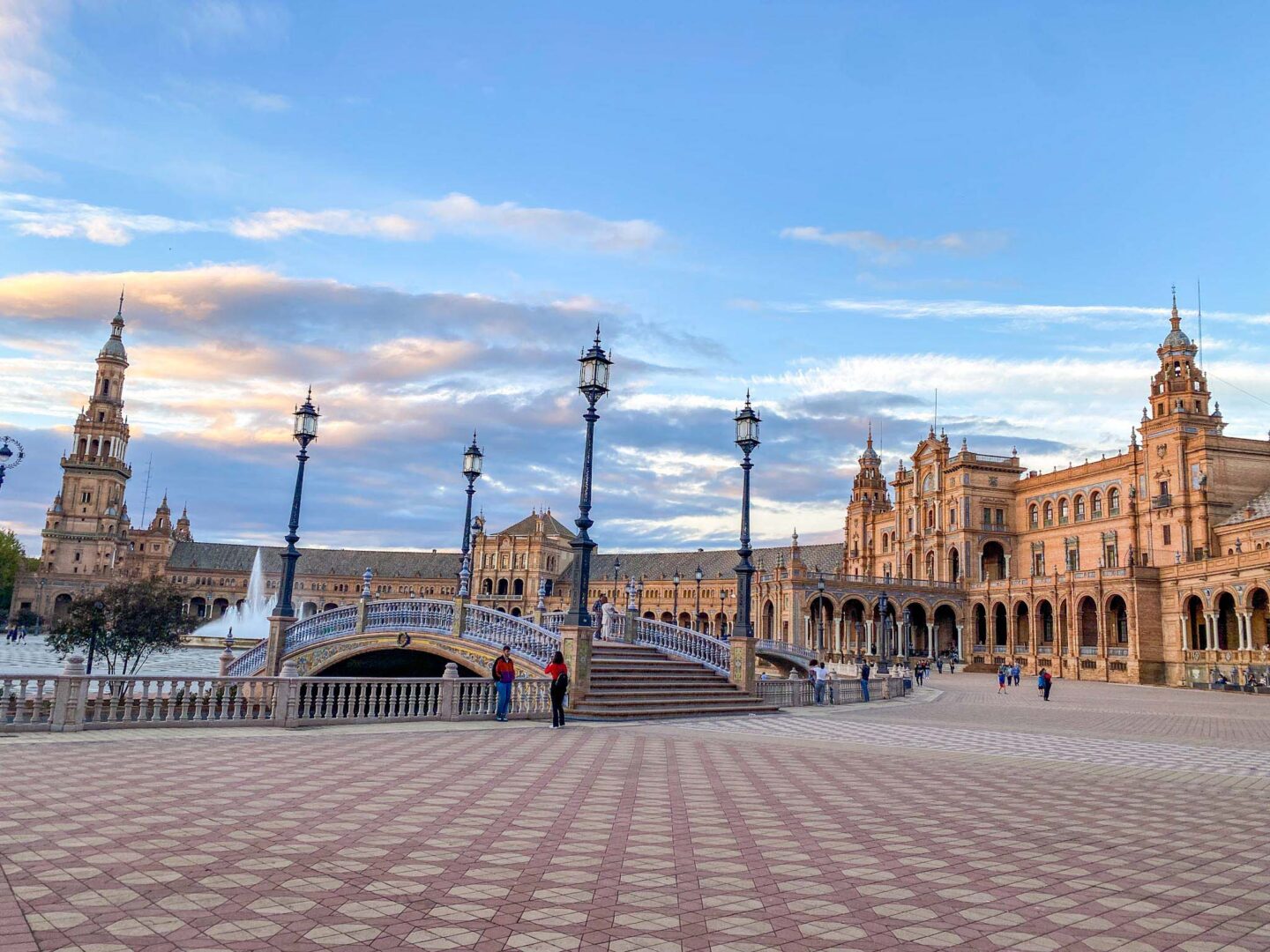
Things to do in Seville
- Plaza de Espana Square – this is one of the most famous places in Seville and translated as the ‘Spanish steps in Seville’. It’s a truly grand and large place with so much tiling work, fountains, benches and you can hire a boat to sail along the small area of water within the Plaza.
- Setas de Sevilla / Las Setas – also known as ‘the mushroom’ one of the fairly new Seville tourist attractions opened in 2011 and you can certianly tell as it’s very modern and unique. It’s cool to see from the ground but one of the top things to do in Seville is to go to the walkway and viewpoint along the top!
- Royal Alcazar of Seville – the Royal Palace of Seville with Islamic, Moor-ish and Christian architecture deisgns, if you’re coming to Southern Spain for Islamic history, this has to be on your list of places to go in Southern Spain! You have to BUY TICKETS IN ADVANCE as there are limited daily tickets. You can buy tickets here.
- Seville Cathedral – this is the largest gothic cathedral in the world!
- Flamenco – shows like this are hugely popular with tourists and locals and are a must-do in Seville and Southern Spain!
Tours and Activities in Seville
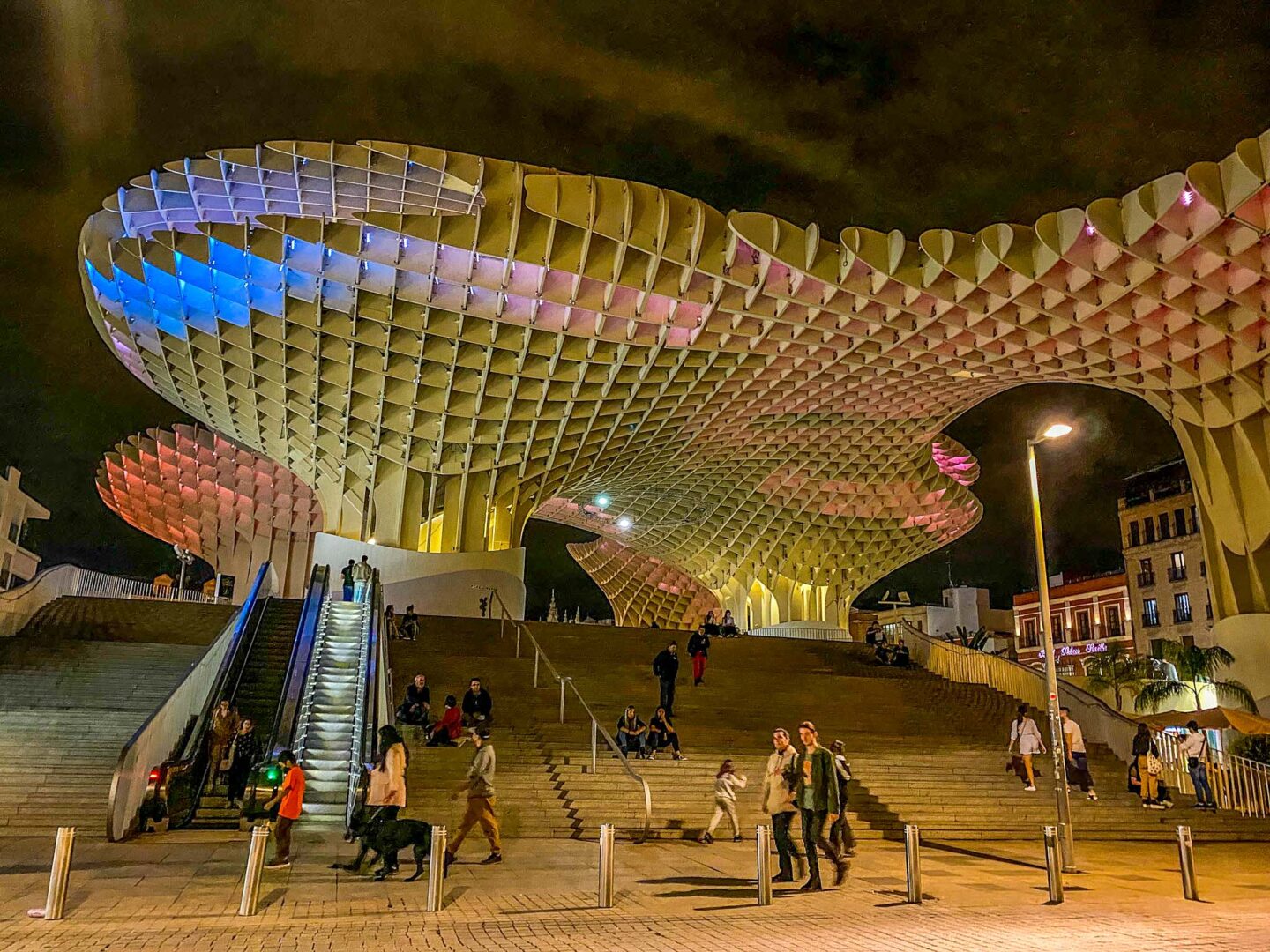
How much time to spend in Seville?
The best Seville attractions are dotted around the city and therefore, take more time to walk to and from than in Malaga and Granada. One day in Seville is enough and will enable you to visit a few of the top places to go in Seville but ideally, 2 days in Seville is good .
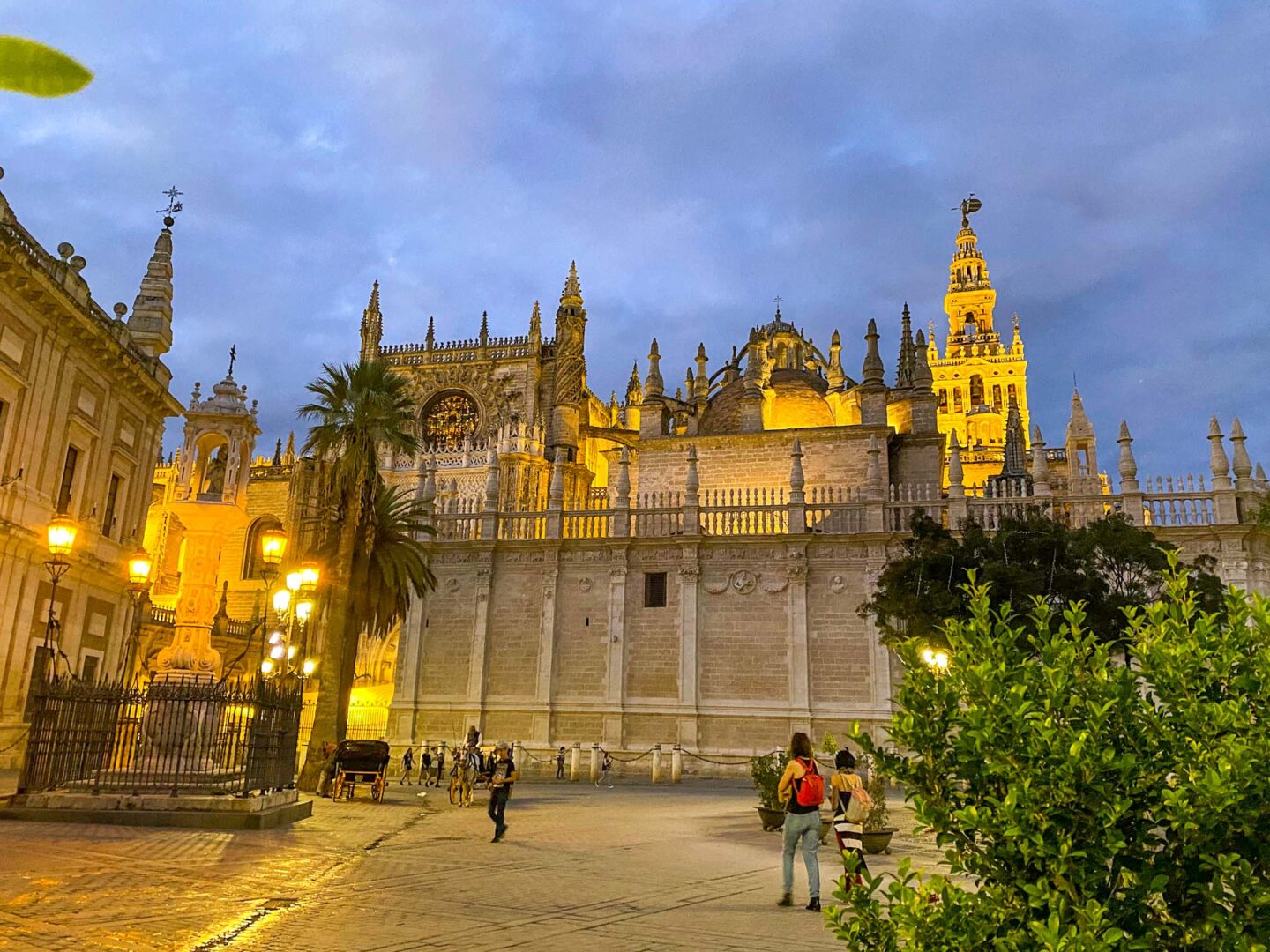
– Cordoba
Cordoba is one of the cities in Southern Spain you might not have heard much about, especially in comparison to Seville, Granada and Malaga, which was the case for me until last year,
However, Cordoba is definitely worth a visit on your South of Spain itinerary. It has the largest old town in Spain and is the only city to have 4 UNESCO world heritage sites which are part of the best things to do in Cordoba.

Things to do in Cordoba
- Mosque-Cathedral of Cordoba – if you only go to one place in Cordoba, this has to be it! This is a really unique building which was once a mosque when the Muslims ruled and then became a Church in 1236 when the Muslim rule fell. Today, as you enter inside you can see architecture from both a mosque and cathedral mixed into one which is really unique! BUY FAST-TRACK TICKETS HERE!
- Alcazar de los Rayes Christianos – this was once a fortress with gardens, baths, courtyards and the largest library in Western Europe, it’s changed hands a few times since then and is now of the one top Cordoba tourist attractions with plenty to see!
- Cordoba Old Town – as mentioned, this is the largest old town in Spain which is one of the UNESCO protected sites in Cordoba. It’s made up of lots of small winding streets full of shops, hotels, cafes and restaurants and you’ll also come across many plaza’s and courtyards as you wander.
- Medina Azahara – If you’re looking to get off the beaten path in Southern Spain, visiting a place like this will do this! Medina Azahara is on the outskirts of Cordoba city. It was once a magnificent fortified palace-city , with sources mentioning 10,000 people working here to create a new city and Western Caliphate. It’s remains are a major archelogical site in Spain today which can be visited and explored.
Tours and Activites in Cordoba

How much time to spend in Cordoba?
I spent just a few hours in Cordoba , I didn’t see that much, just the Mosque-Cathedral, the Old Town and Old Bridge but it gave me a lovely insight and feel of the city. Without going to Medina Azahara you could spend just one day in Cordoba just fine and it’s possible to visit on a day trip from Seville, and Malaga by train or car .
If you want to visit Medina Azahara and all the top places to see in Cordoba, I’d recommend 1.5 – 2 days in Cordoba .
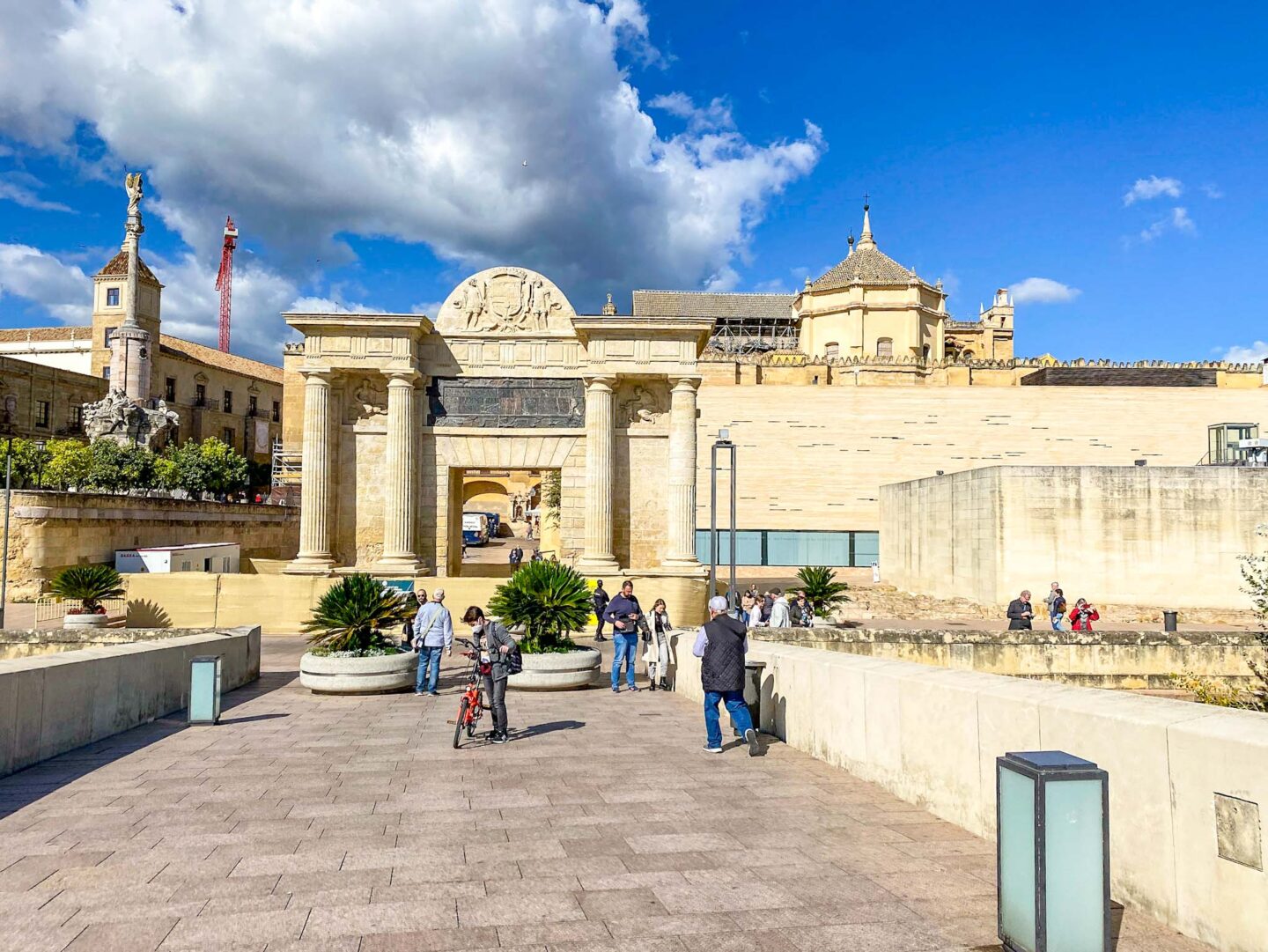
– Ronda
Ronda Bridge has to be one of the most photographed places in Spain. I know I’d seen so many photos of this impressive, high, arch bridge and gorge.
I had always thought that it was hard to get to Ronda and Ronda was further inland in Spain than it is, but Ronda is in Andalucia in Southern Spain and travelling around Andalucia, especially on a Southern Spain road trip will enable you to see this spectacular pueblo blanco (white town) that has escaped mass build-up of chains and modern buildings.
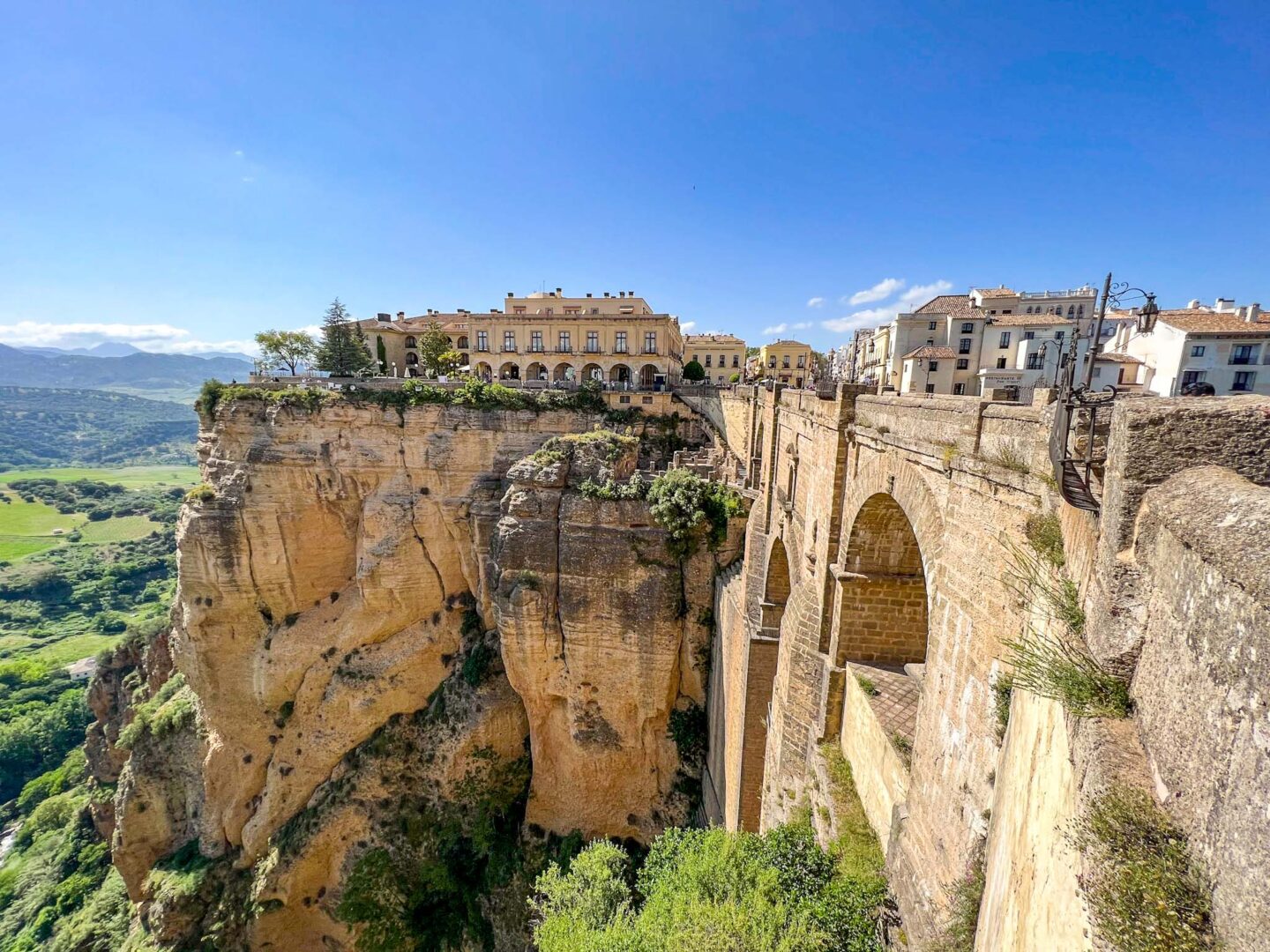
Things to do in Ronda
- Puente Nuevo (New Bridge) – this bridge isn’t exactly new and it’s over 230 years old , but it is the famous bridge in Ronda which connects the two sides of the town and has a 100m drop and gorge below it. There are viewpoints on either side and all 4 are great to visit to see a different view and perspective.
- El Tajo Gorge – I was surprised to see so many people walking into the Gorge below Ronda’s bridge but it can be done via a path down one side, at the bottom you can walk through the gorge and see the waterfalls down here.
- Old Town – Ronda is nothing but charming and idilic and walking through the small streets of the old town will show you this. During the day it can get busy with day trip tourists but if you visit in the morning, afternoon or evening, you’ll see even more how special Ronda is!
Day Tours to Ronda
Ronda & Setenil from the Costa del Sol
Ronda and Setenil de las Bodegas tour from Malaga
Ronda and White Villages Day Trip from Seville
Private Day Trip to Ronda from Marbella
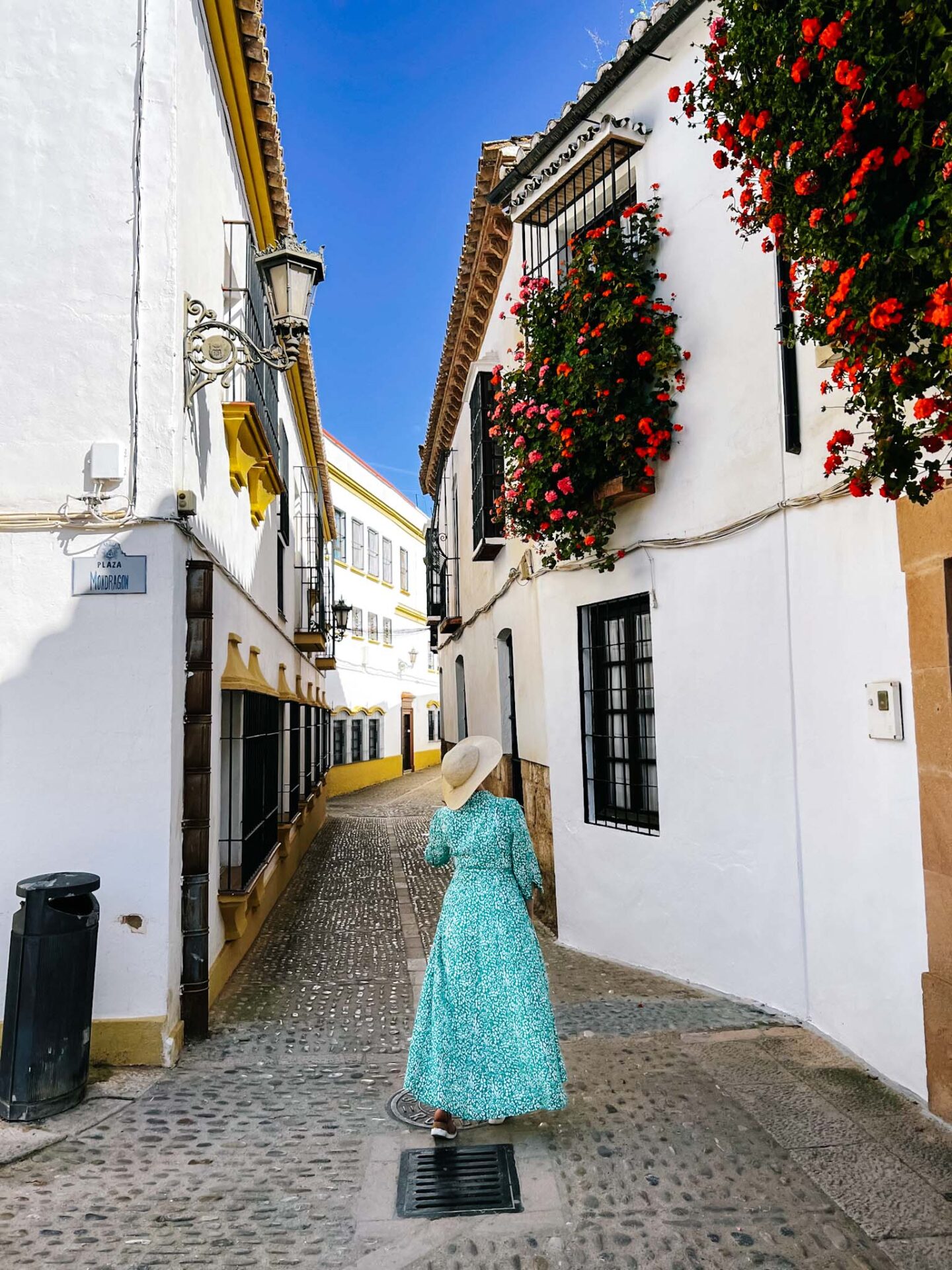
How much time to spend in Ronda?
I spent just 2-3 hours in Ronda as we were on a little road trip around Southern Spain and decided to come here pretty last minute. Even though it was quick and we didn’t get to fully see inside the Gorge, I loved what I saw of Ronda and don’t feel like I have to return in future to see more, even though I wouldn’t say no!
Some people love to spend their whole Southern Spain holiday in and around Ronda because of the beautiful surrounding countryside.
On your itinerary for Southern Spain, I’d spend from 0.5 days to 2 days here depending on how long you have and it’s possible to do a day trip from Seville or Malaga to Ronda.
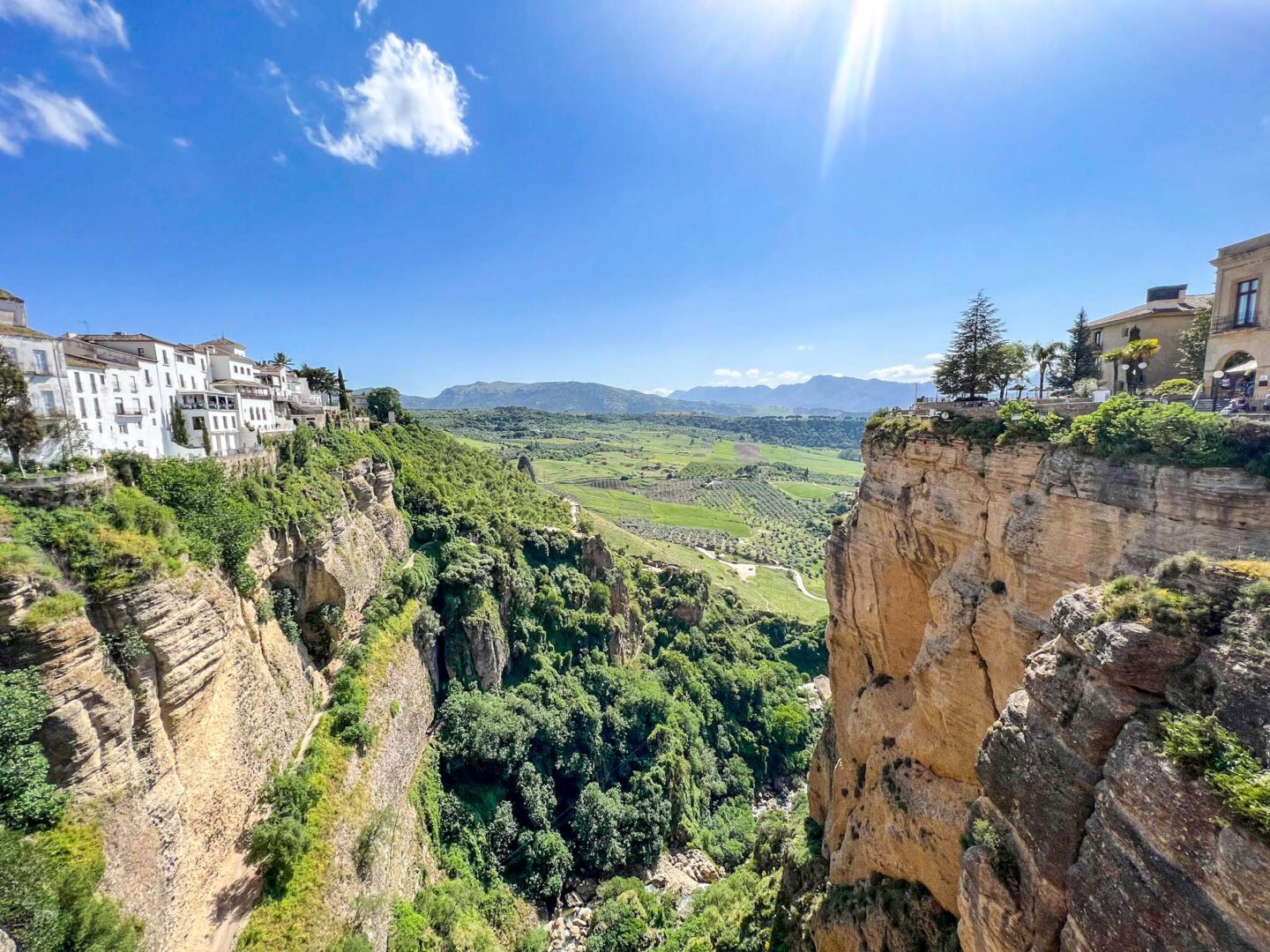
– Setenil de las Bodegas
My husband literally found the small town of Setenil de las Bodegas via Instagram during our road trip around Southern Spain. We added it to our Spain itinerary straight away and headed here after Ronda as it’s extremely close by.
Setenil de las Bodegas is another one of the pueblos blancos which are the white villages of Andalucia but it has a unique aspect to it because it has buildings built into the rocks of a canyon, which is usual to see for us travellers but even more unusual because usually towns in this area are built on hilltops, not inside a canyon!
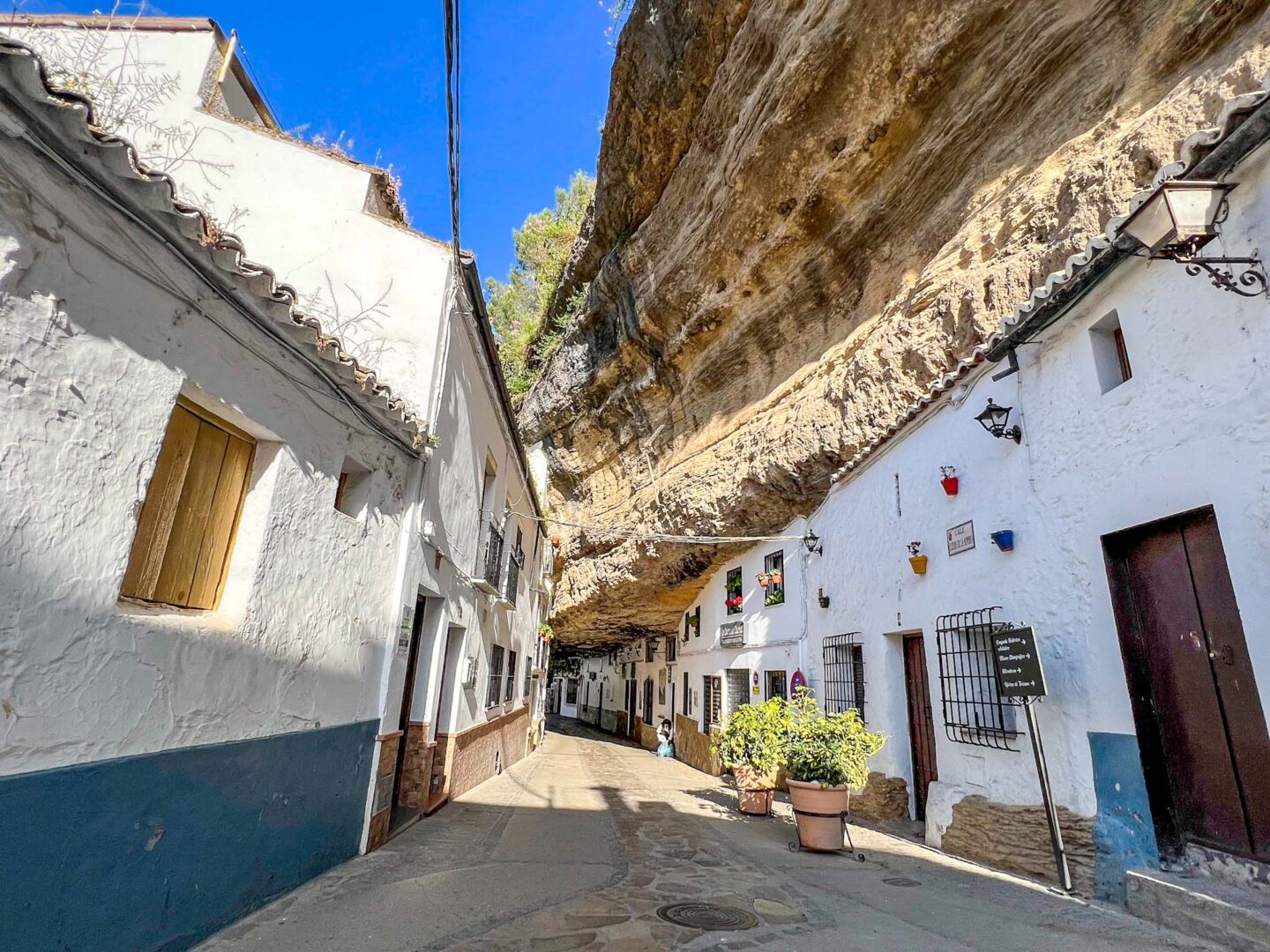
Things to do in Setenil de las Bodegas
- Rock Covered Streets – most people do not visit Setenil de las Bodegas for a large list of things to do in Setenil de las Bodegas, instead it is to wander it’s unique streets and see the buildings that are built into the rock.
- Oberservation Deck – seeing the town from a viewpoint is quite an experience, in Spainish a viewpoint is a ‘Mirador’ and there are a few viewpoints in Setenil de las Bodegas.
- Arab Castle – if you have time you should head up here and it’s another way to see a great view as well as take in some history. I read it’s just 1 euro to enter so super cheap but now that only 1 of the 12 towers remain it won’t take you too long to look around.
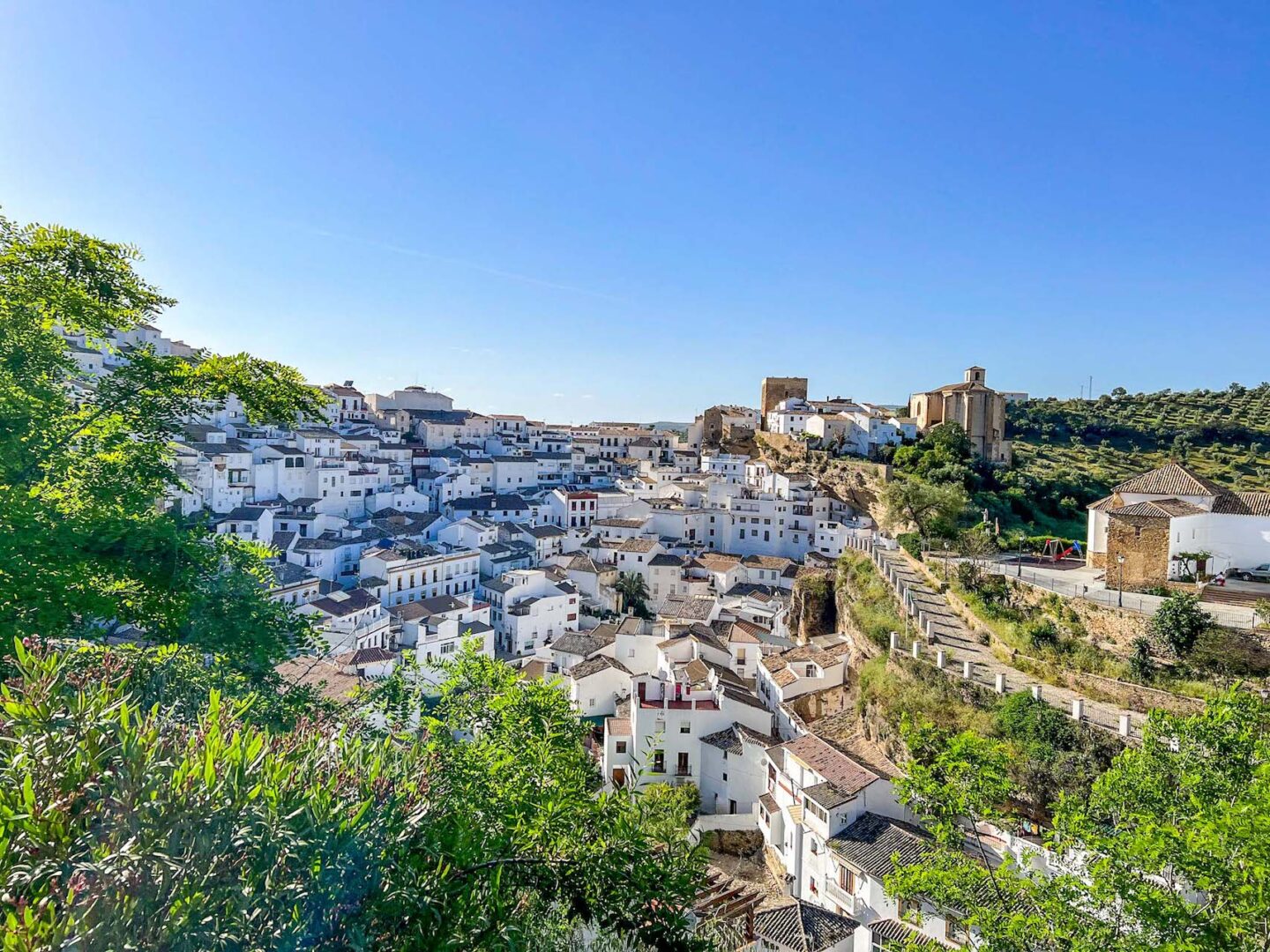
How much time to spend in Setenil de las Bodegas?
There is accommodation in Setenil de las Bodegas however it seems it’s very much one of the places to visit on a day trip in Southern Spain, it’s very close to Ronda which is where we visited from and then we drove back down to the coast to Malaga afterwards with no problem.
There are many restaurants and cafes in Setenil de las Bodegas and it’s a nice relaxed place to have lunch in on your South Spain road trip.
So, you could spend 1 night in Setenil de las Bodegas but equally 1-3 hours seems to be enough too.
For more information on this pretty town, here’s a great guide to Setenil .
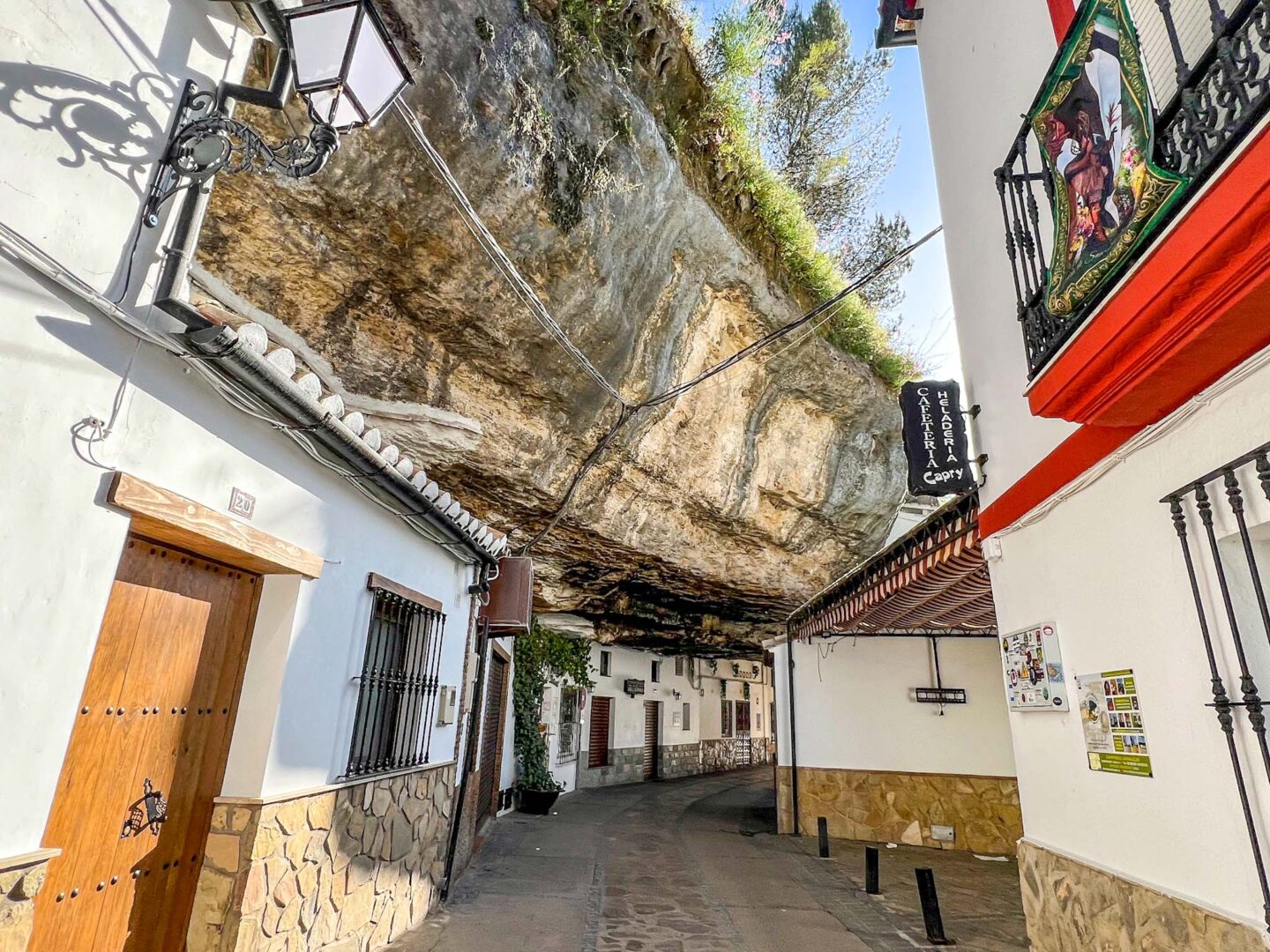
– Puerto Banus
You have probably heard of Marbella which is known for being a high-end beach destination in Spain to visit, but actually, Marbella is a city and actually, where everyone visits is a place near to Marbella called Puerto Banus.
Puerto Banus is known as a playground for the rich and famous because of its yachts, supercars and designer shops so it’s not to everyone’s taste, and people probably don’t associate it with Andalucia but it’s worth passing by to see, especially if you’re doing a Southern Spain road trip.
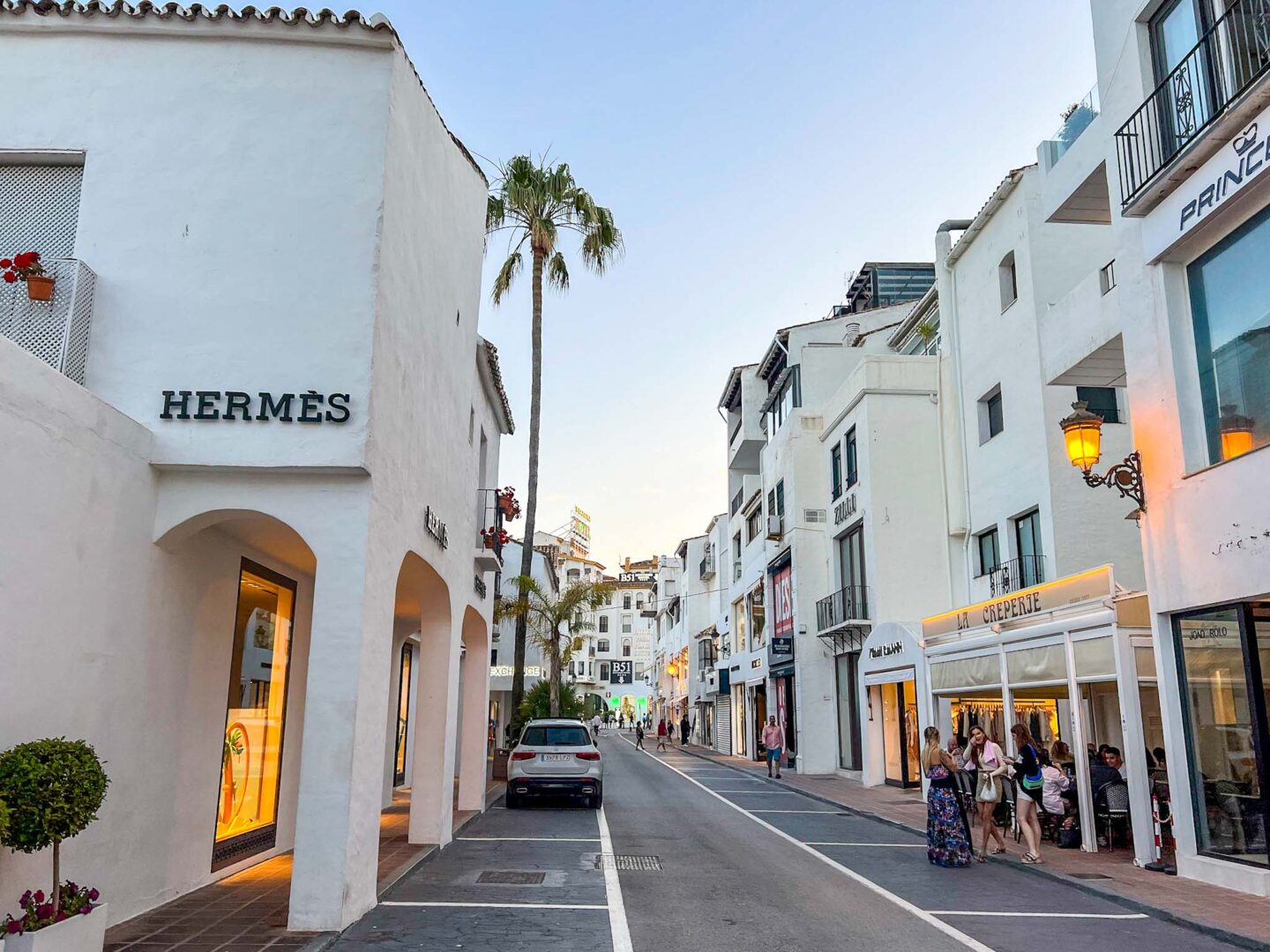
Things to do in Puerto Banus
- Puerto Banus Harbour – this is the main place I’d suggest going to and plan in visiting for lunch or dinner because there are lots of nice restaurants. There are high-end expensive restaurants but also a fair few mid-range places so it can be enjoyed by all. Walking around the harbour looking at all the yachts and cars is what a lot of people enjoy too.
- Nikki Beach Marbella – this is a really famous beach club which now has other locations in Dubai and Marrakesh. If going to a fancy beach club is on your list of things to do in Spain, this is where you can do it!
- Boat Trip – this location is all about fun in the sun and sea ! From Marbella / Puerto Banus you can do a sunset evening cruise , dolphin watching trip and a party boat trip !
Tours and Activities in Marbella
How much time to spend in puerto banus.
It’s really up to you and what you like. People visit Marbella and Puerto Banus for their 1 or 2 week holiday so you can spend a few days in Marbella, but equally, you can enjoy it by passing by as you drive along the South coast of Spain as I did recently just stopping in for dinner in the evening to take in the pure luxury and craziness of this place.
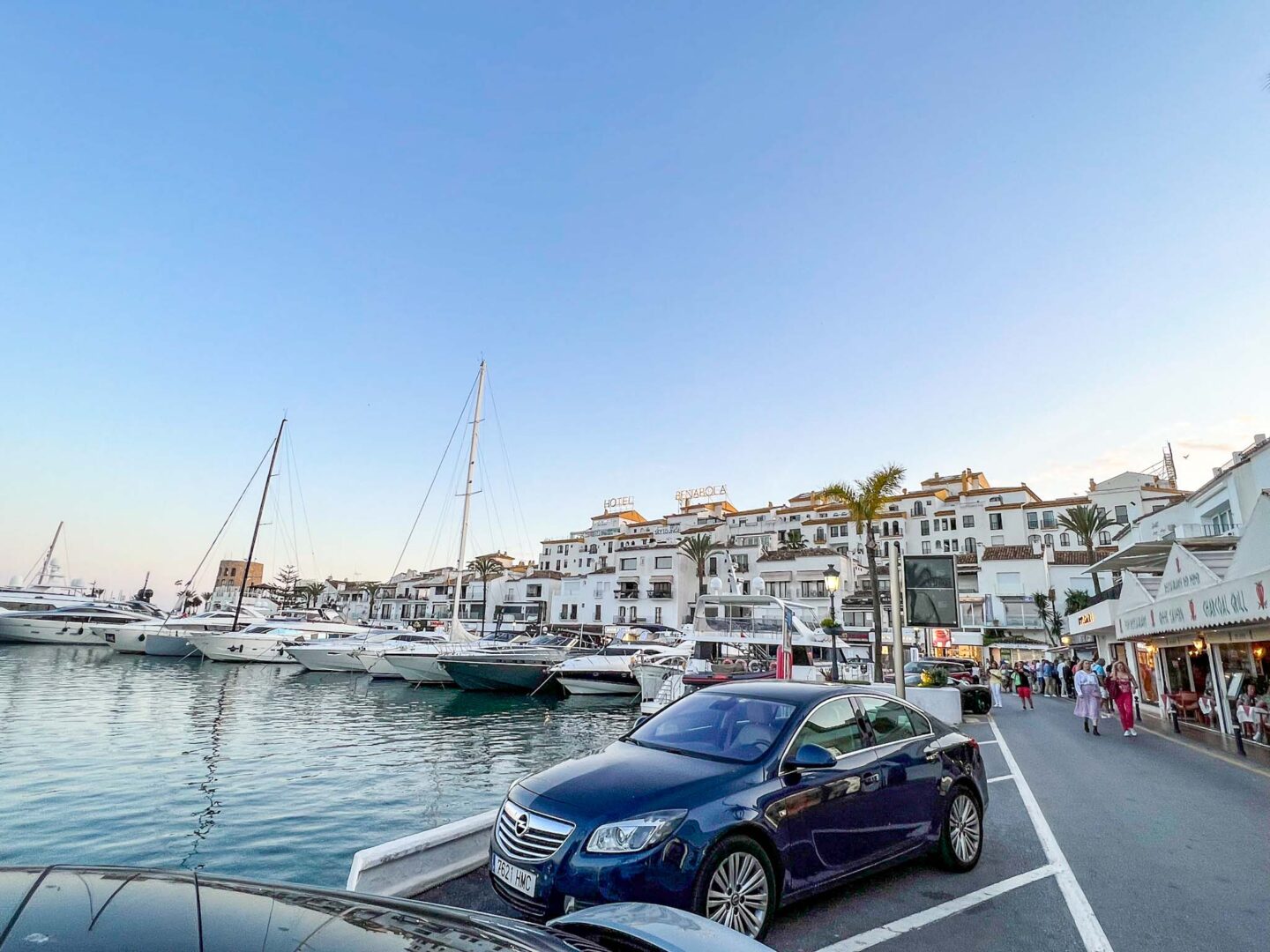
– Cadiz
Not many people will get over to Cadiz on their Southern Spain itinerary because it is quite far West in the South of Spain, especially if you start your trip in Malaga, but it is a gem not to be missed if you have time, and, it is one of the oldest cities in Western Europe !
Why should Cadiz be on your list of places to visit in Southern Spain? You’ll get the white-washed buildings, cobbled streets, and historic buildings, but also get beautiful clear water surrounding you and plenty of places to visit in Cadiz to keep you busy, and full!
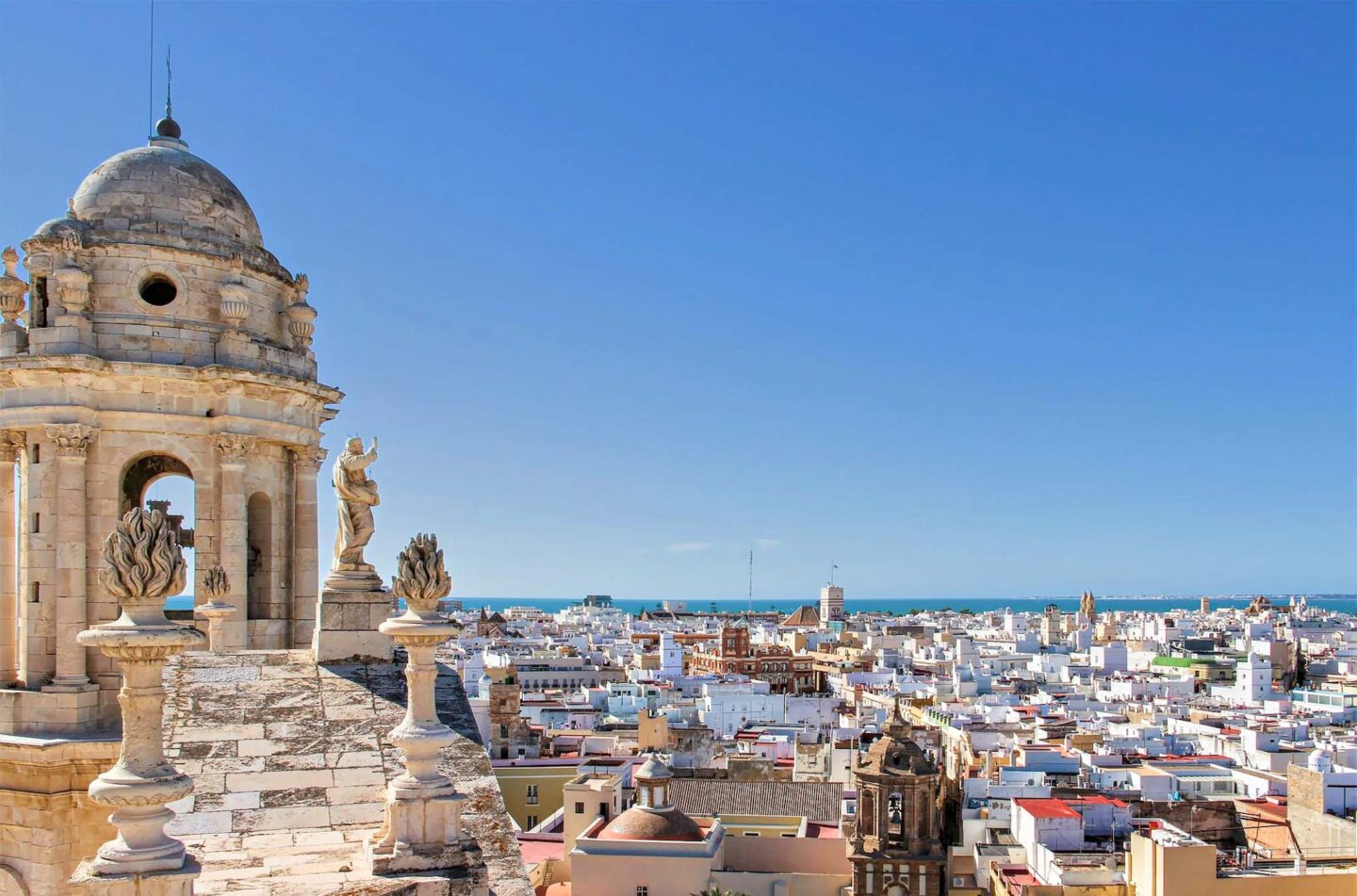
Things to do in Cadiz
- Cadiz Cathedral – this Cathedral took 116 years to complete between 1722 and 1838 and sits in the heart of Cadiz welcoming all visitors as one of the top places to visit in Cadiz.
- Cadiz Cathedral Bell Tower – I love that you can see views of Cadiz city and over to the water from the bell tower of such an impressive cathedral!
- Mercado Central De Abastos – when in a Spainish city you must visit a market and this is a really old one built in 1839! You’ll find all types of food so why not get some food for lunch and even if you’re not hungry, going in is a must to see daily local life !
- Bike Tour – biking through a city is the best way to see it and in Cadiz you can do an organised 3 hour bike tour like this around one of Europe’s oldest cities taking in the historic sites and learning about them from a guide.
- Tapas Tasting – the best way to see a city can be through the food and in Spain, you want to try real Tapas , but the best way is often to do with a guide on a 3 hour tour like this , so they can take you to the best places for tapas in Cadiz!
- Watch Flamenco – just like in Seville and Granada, you can watch Flamenco in Cadiz and get skip the queue tickete here ! Flamenco will have you mesmerised and even those who think they might not like it, will enjoy it!
Tours and Activites in Cadiz
How much time to spend in cadiz.
Like many of the other cities in Andalucia, you could spend 2-3 days in Cadiz enjoying a laid-back lifestyle and this is definitely what people like Cadiz for, but you could also pass through for one day and see a lot of the top things to do in Cadiz.
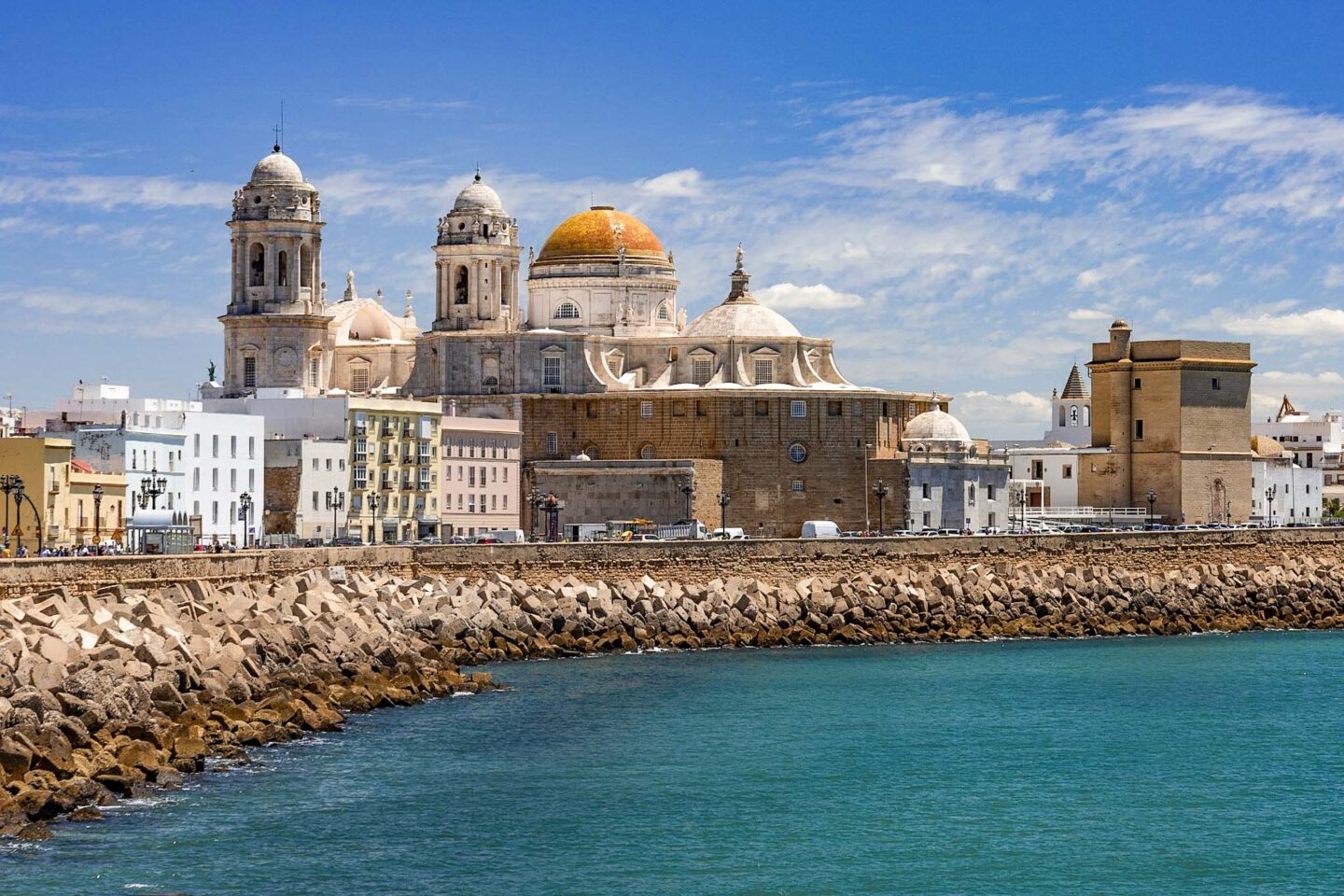
Southern Spain Map
All 8 of the places to visit in Southern Spain are on this map to help you work out your itinerary!
Southern Spain Itineraries
To help you work out where to visit in Southern Spain I’ve given you some ideas of itineraries below. These are not definites but you can use them to understand where you can visit in the time you have.
– Southern Spain 3-4 Days
Arrive in Malaga – 1 Day
Day Trip from Malaga to Cordoba – 1 Day
Granada – 1-2 Days
– Southern Spain 7 Days
Granada – 2 Days
Cordoba – 1 Day
Seville – 2 Days
Malaga – 1 Day
– Southern Spain 10 Days
Cadiz – 2 Days
Ronda – 1 Day
– Southern Spain 14 Days
Seville – 3 Days
Ronda – 2 Day
Marbella – 1 Day
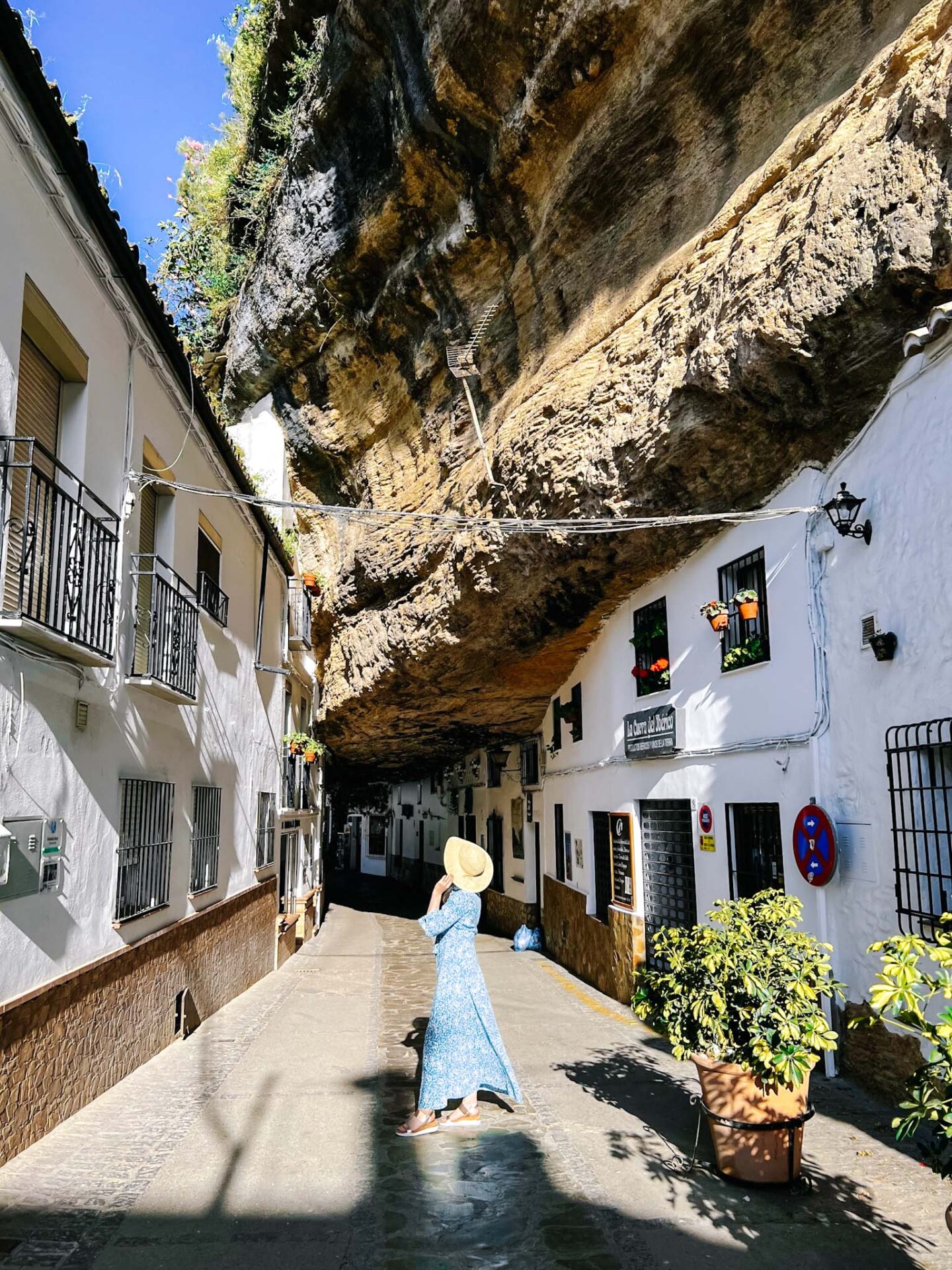
How to get around Southern Spain
– southern spain road trip.
Hiring a car in Spain is the best option if you are able to do this because then you can explore as much as you want and be on your own schedule!
Malaga Airport is a huge airport with lots of car rental companies and the best place to hire a car from in South Spain. I always use RentalCars which searches the top rental car companies.
Search car hire availability and prices for Southern Spain here!
But you can also hire a car in Seville as I recently did if you happen to fly in and out of there to start and end this trip, or Cadiz or Granada.
Have a look for a car for your Southern Spain Road Trip here on RentalCars!
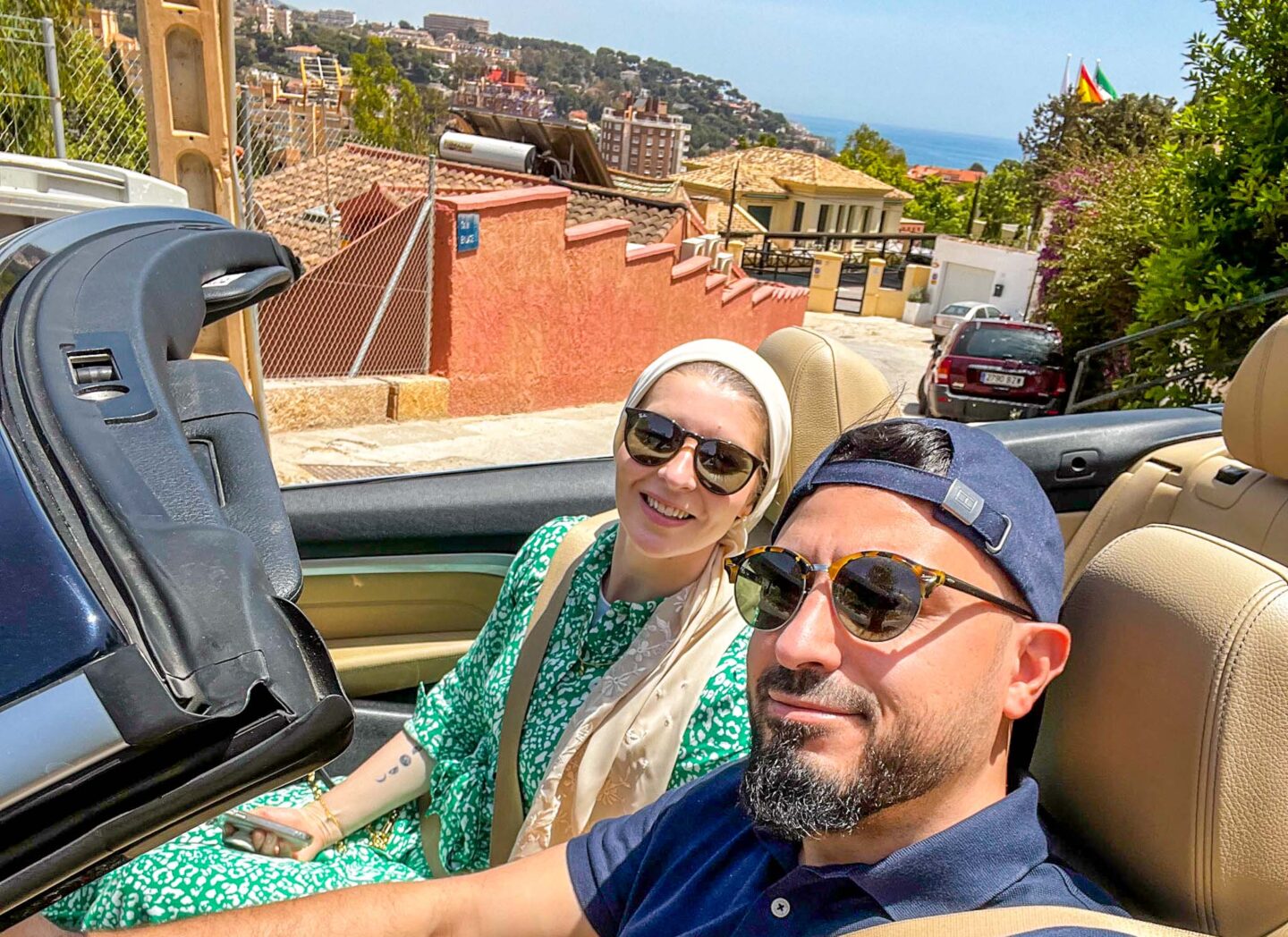
The roads in Southern Spain are very good . The main roads are all highways with 2 lanes , sometimes 3 around cities such as Malaga and they are all in good condition.
In the countryside, the roads become smaller and can become quite steep, windy and narrow in places but they are still very well maintained so as long as you drive carefully you’ll be fine!
– Buses and Trains in Southern Spain
South Spain is well connected by train and bus and OMIO is the best platform to search all transport options within Spain so you can check the best, cheapest and fastest route.
Going by train is a great idea to connect between the big cities like Malaga, Seville, Cordoba and Cadiz as they all have good train stations with lots of routes.
Search train and bus routes through Spain using Omio here ! Omio searches all the train and bus providers in Spain to give you the most availability!
If you plan to do some day trips in Southern Spain to see more of the country, then I recommend using the train as it’s faster than the bus and probably driving. For example, you can easily do a day trip to Cordoba from Malaga, Granada or Seville by train.
Going by bus is sometimes the only option but it’s still a good option, I recently booked by bus through OMIO with the ALSA bus company to get from Granada to Malaga. They are a well-organised company with regular departures for a good price with comfy coaches. You even get assigned a seat on the coach making it very safe too.
– Shared Taxi Transport
Another way to get between the cities is using a carpool / shared taxi company . I haven’t used this myself but my friend who lives in Seville has used BlablaCar several times between Seville and Granada .
It gives an added level of comfort being in a car rather than on a bus and can be much cheaper than the train. You will share with strangers but you never know, they may be new friends by the end of the trip !
Accommodation in Southern Spain
There is a huge amount of accommodation on offer in the cities and big towns in Southern Spains to suit all trip types and budgets.
I have used booking.com and Airbnb to book all of my Spain accommodation recently.
In Malaga , I recommend a hotel in the Soho District which is really cool! Have a search for one here!
Or, in Malaga, if you’d prefer to be by the beach and in a resort hotel , I really recommend the 5* Higueron Hotel Malaga, Curio Collection by Hilton where I stayed in May.
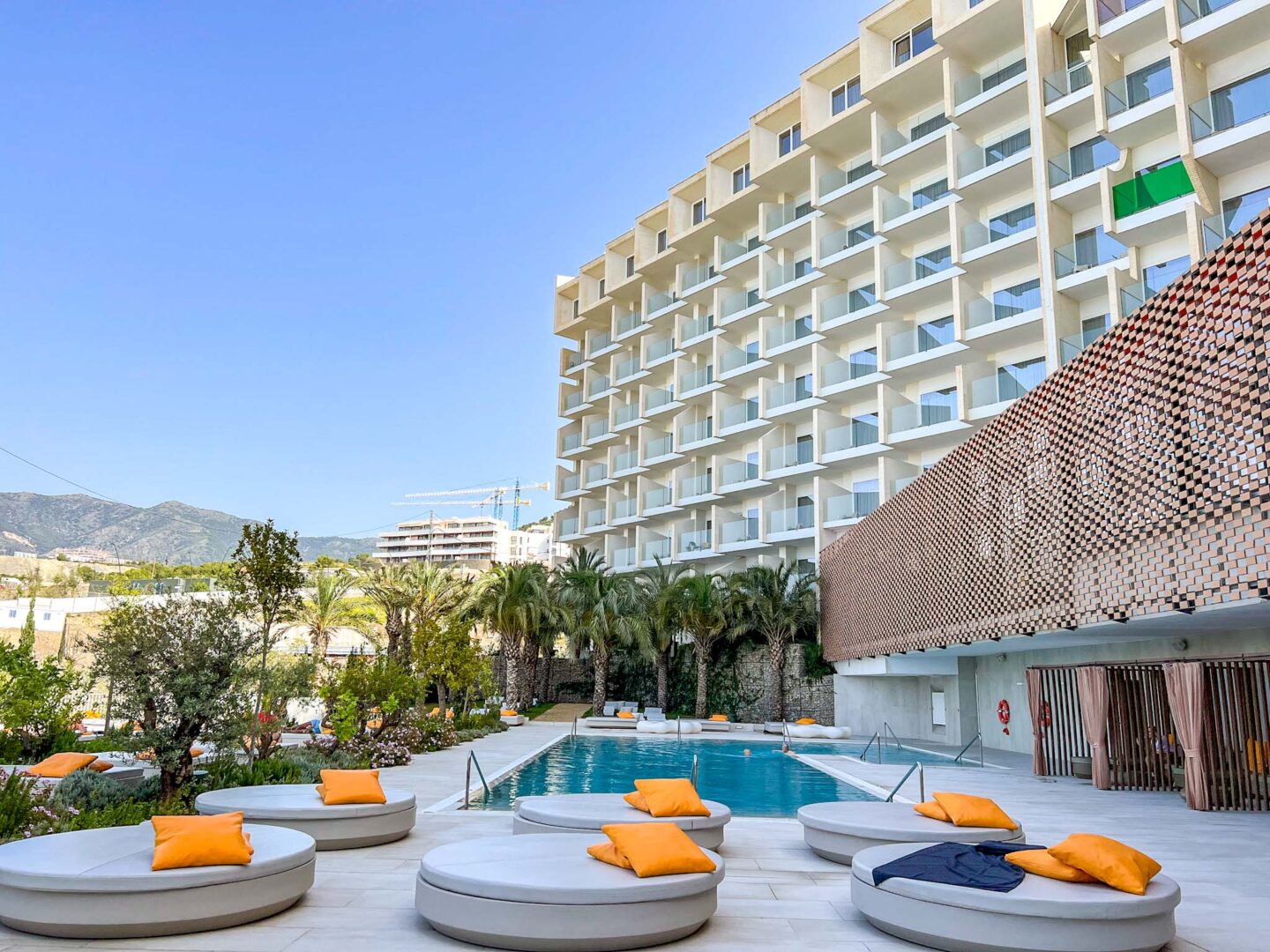
In Granada , I recommend staying in the Albaicin , only if you don’t have much luggage because the Albicin is full of small pedestrian streets and gives you a really good feel for the old city of Granada!
Best time to visit Southern Spain
One of the reasons I love Spain is because of the all-year-round great weather ! Yes, it does get cold in Spain in the winter but the South is much warmer than the North in winter!
– Weather in South Spain
Recently, I visited Southern Spain in November, May, June & July and honestly, it was great all of those months weather-wise .
June and July were very hot and in terms of visiting Southern Spain in Summer, I would avoid July & August if you can as temperatures can go over 40c, especially in cities such as Seville. Being by the coast or in the mountains is a bit more manageable in the summer months.
I loved Spain in May because it was hot but not too hot at all and so many flowers were in bloom because it was spring, it was just a very warm and sunny spring compared to the U.K!

Visiting Southern Spain in Winter is also a great idea. The start of November when I went was very pleasant, I had a jacket on but it wasn’t cold and wasn’t wet either. There was also a huge difference in temperature between Granada which is in the mountains and is colder than Seville and Cordoba which were much warmer in November!
December, January and February definitely get cold in South Spain but not so cold that it snows and with the right warm clothes on you will be comfortable and it will be much milder than in the UK and many other parts of Europe!
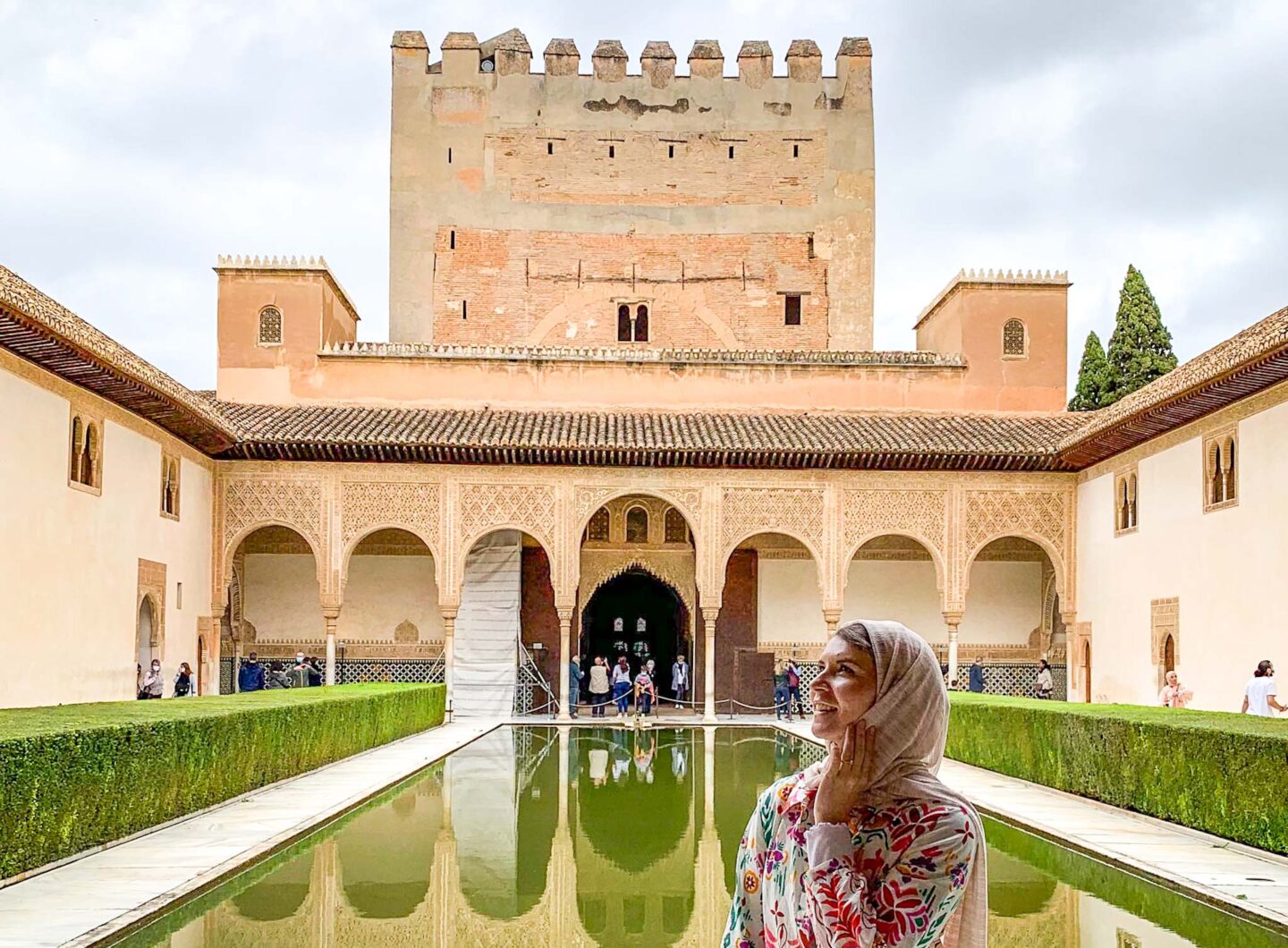
For more reasons why I love Spain, especially Southern Spain, check out my YouTube video:
Thank you for reading my guide on a Southern Spain itinerary, I hope you have worked out where to visit in Southern Spain, especially if you plan to do a Southern Spain road trip!
- For more of my posts from Spain see:
- REVIEW: Higuerón Hotel Malaga. Incredible 5* Hotel Near Malaga!
- The Ultimate Zaragoza Travel Guide! Everything You Need To Know!
- 50 Things To Do in Zaragoza & Things To See in Zaragoza!
If you liked this please share it! 🙂
- Click to share on Facebook (Opens in new window)
- Click to share on Twitter (Opens in new window)
- Click to share on Pinterest (Opens in new window)
- Click to email a link to a friend (Opens in new window)
By using this form you agree with the storage and handling of your data by this website. *

Veganderlust contains affiliate links and is a member of the Amazon Services LLC Associates Program. If you make a purchase using one of these Amazon links, I may receive compensation at no extra cost to you. For more info, see the Disclosure Policy .
Epic Southern Spain Itinerary: 10 Days in Andalusia by Train
The South of Spain, or Andalusia, is one of the most beautiful and diverse parts of Spain. With this Southern Spain itinerary of 10 days, you’ll be able to experience the best of this stunning region.
On my first visit to Andalusia, I fell in love with the region’s relaxed atmosphere, vibrant culture, and stunning scenery. From the bustling cities to the tranquil countryside, there’s something for everyone in Southern Spain.
In this post I’ll share the highlights, everyone should visit the famous Alhambra Palace for example. I’ll also provide various options based on your travel style and interests, such as choosing between adrenaline hikes and relaxing beach time.
Table of Contents
Southern Spain Itinerary 10 Days Overview
In our journey through Andalusia, we’ll be basing ourselves in three main cities where you’ll spend your nights, but don’t be worried, our adventures aren’t limited to just these cities.
We’ll be exploring more destinations on exhilarating day trips to soak in even more of the region’s charm. Trust me, it’s so much more relaxed if you don’t have to pack up and move every day! And that’s even though I travel as a minimalist with just one small backpack.
This itinerary is set up to be done by public transportation but you can easily customize it into a Southern Spain road trip itinerary.
If you take the high-speed trains, I recommend buying your train tickets in advance as they can sell out.
1. Stop: Málaga
The easiest accessible city in Andalusia is Málaga, especially when you come from the United States. It’s the gateway to the South and has an international airport, making it a convenient starting point for your Southern Spain itinerary.
Spend at least one day exploring this vibrant city. On the second day, you can decide between a hike in a canyon, a relaxing day at the beach, or a visit to some of the best art museums in Málaga.
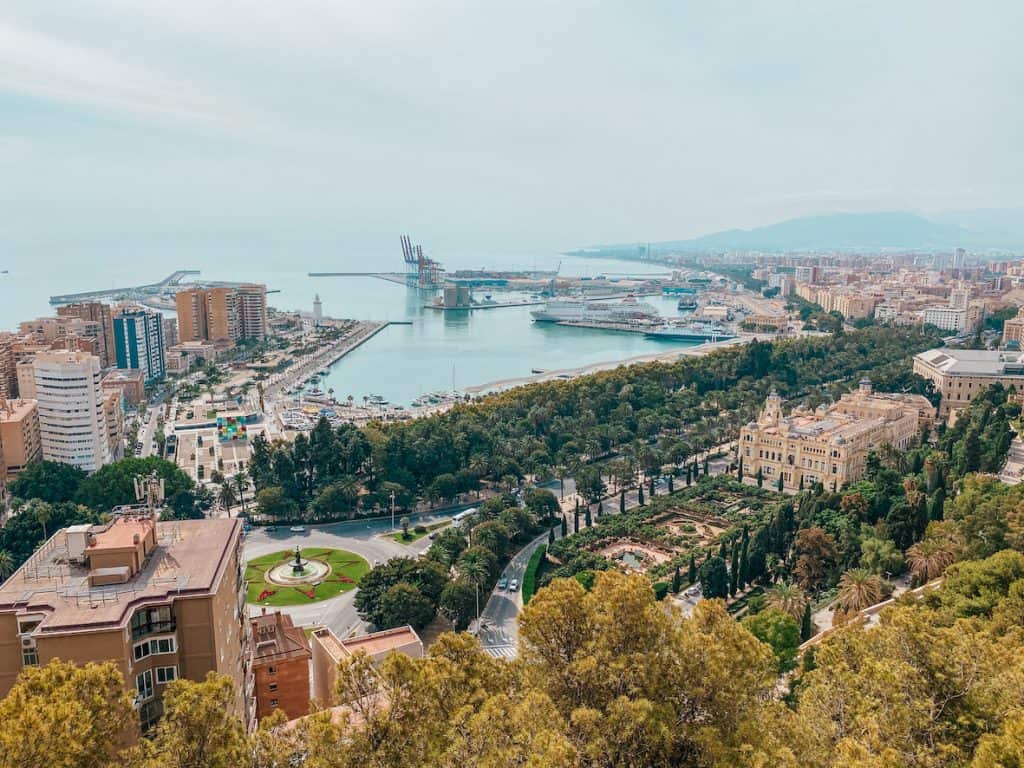
Day 1: Malaga City
Start your first day with a visit to Málaga’s most famous attraction, the Alcazaba, a Moorish fortress in the middle of Málaga’s old town . Then take a stroll to Gibralfaro Castle for more panoramic views.
Afterward, explore the charming marina and go for a walk in the Parque de Málaga.
End your day with a traditional tapas dinner in one of the many local restaurants. My favorite vegan restaurant in Málaga is Meet Vegano , they serve some unique creations and it’s a very relaxed atmosphere.
🤩 I love this small group Málaga walking tour for the local guide!
Day 2: Choose Your Adventure
Option a: caminito del rey hike.
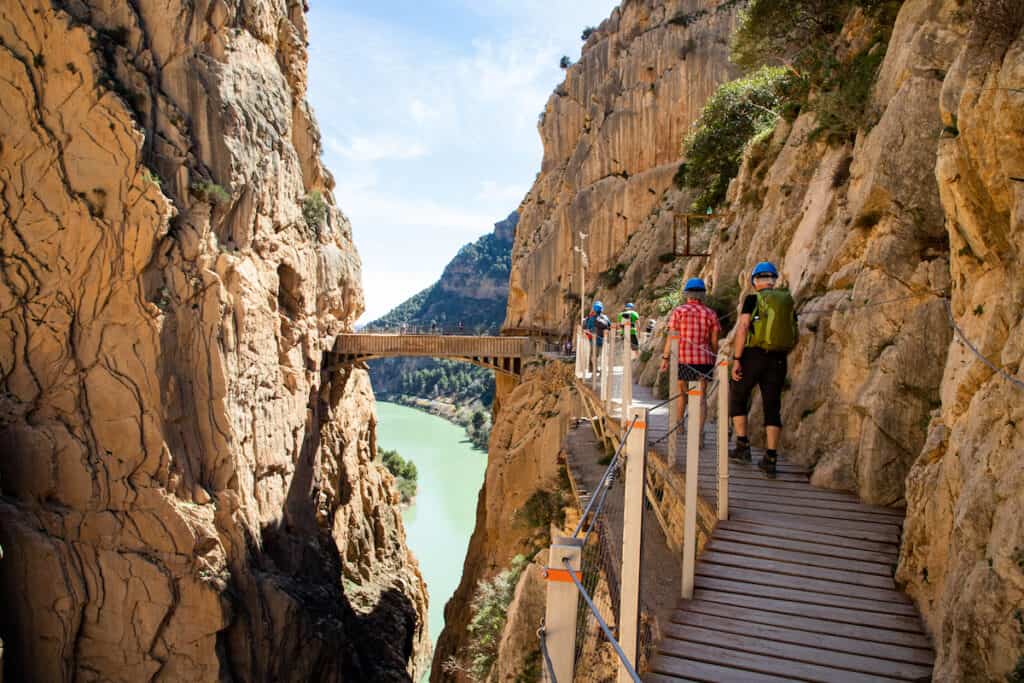
For an adrenaline-filled experience, head to the nearby town of Ardales and hike the infamous Caminito del Rey , which used to be known as one of the world’s most dangerous hikes. Don’t worry, it’s been renovated and is safe now!
The best way to do the hike is with a guided tour then you don’t need to worry about transportation (the starting and end points of the hike are not the same).
Don’t forget to get your tickets early enough, they sell out fast in peak time as the number of visitors is restricted for safety reasons.
🤩 I love this Caminito del Rey Tour from Malaga. It’s great value for money!
Option B: Beach Day in Nerja
If you prefer a more relaxing day, head to the coastal town of Nerja and spend the day at one of its beautiful beaches in the Costa del Sol.
You can take a dip in the crystal-clear water if you visit during the warmer months.
Don’t forget to bring a book for some relaxing beach time. My ebook reader is one of my trusted minimalist travel essentials .
Option C: Art Museums in Malaga

If art and culture are more your thing, then spend the day visiting some of Málaga’s best museums.
The Picasso Museum is a must-visit for any art lover, as it showcases works from the famous painter who was born in Málaga.
Other notable museums include the Centre Pompidou, a modern art museum at the waterfront, and the Carmen Thyssen Museum, which houses a collection of 19th-century Spanish art.
2. Stop: Granada
From Málaga, take a bus or train to the next stop on our Southern Spain itinerary – the city of Granada. Many people only do a day trip from Málaga to Granada, but in my opinion, Granada is one of the best cities in Spain and deserves more time. I recommend 3 days in Granada.
Day 3: Explore the Alhambra Palace
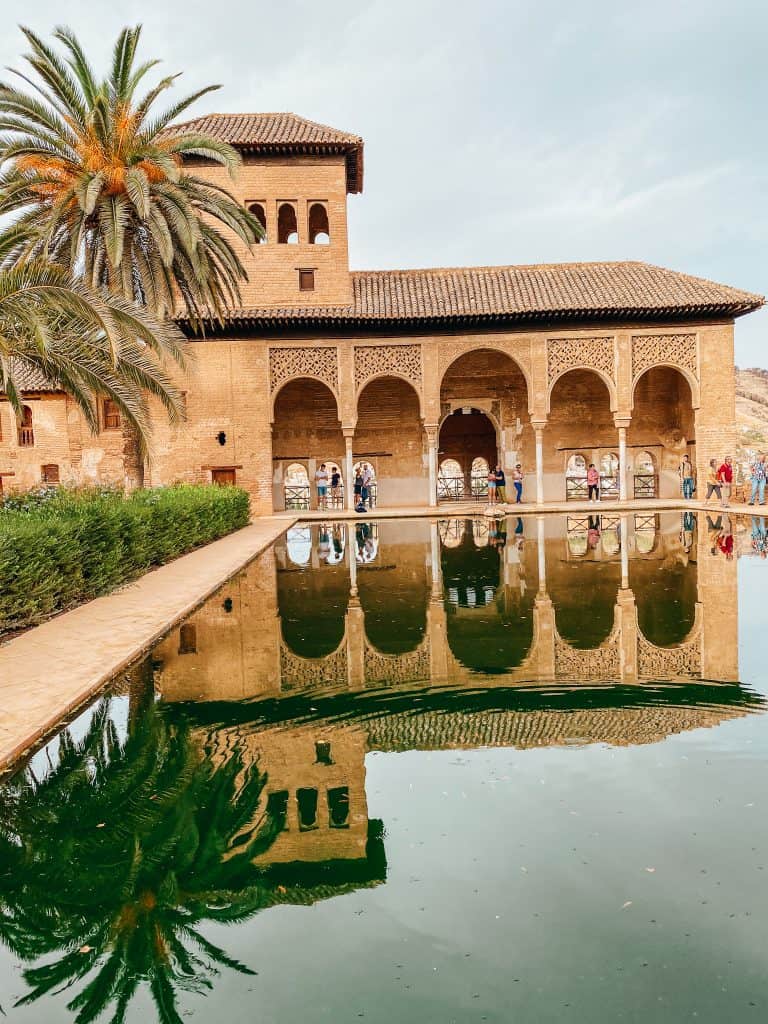
The highlight of any trip to Andalusia and a must-see in Southern Spain is undoubtedly the Alhambra Palace . This Moorish palace is a UNESCO World Heritage Site and one of the most visited attractions in Spain.
Make sure to book your tickets well in advance, as they tend to sell out quickly. You have to get a time-slot ticket for the Nasrid Palace, but you can explore the rest of the complex all day with your ticket.
🤩 Get your Skip the Line Tickets for Alhambra now!
In the evening treat yourself to a massage and some spa time at one of the many Arab baths in Granada . It’s a great way to relax after a day of exploring. I tried out three different baths and my favorite one is Hammam Al Ándalus.
Day 4: Discover Albaicín and Sacromonte
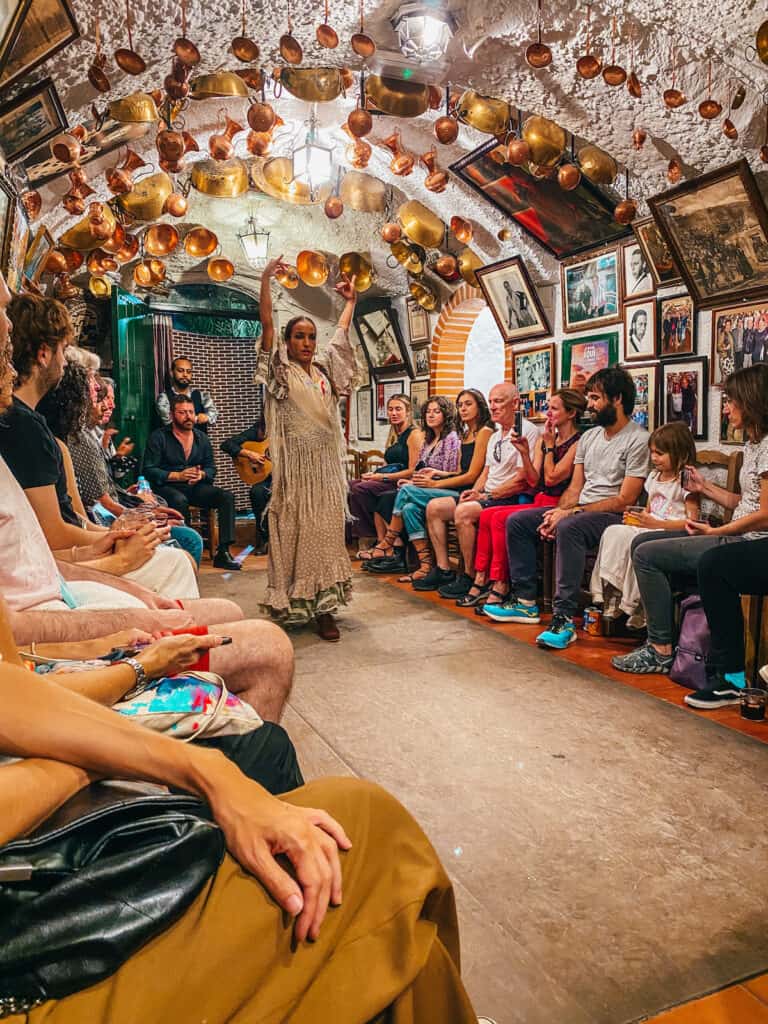
The next day, stroll past the cathedral on your way to the charming old neighborhood of Albaicín. This area is full of narrow streets, beautiful architecture, and stunning views of the Alhambra. You’ll find a bazaar-style market street and multiple little tea houses.
🤩 I love this Granada walking tour for visiting hidden treasures in Albaycín !
Afterward, head to Sacromonte, known for its cave houses and flamenco shows. I recommend visiting the Cave House Museum to learn about the history of these unique cave houses in Granada .
In the evening, watch a flamenco show in one of the cave houses. I watched one at Zambra María La Canastera . It was a truly unforgettable experience.
🤩 Learn more about the fascinating cave houses on a guided walking tour!
Day 5: Granada or Day Trip to Sierra Nevada
On your last day in Granada, you can choose to either explore more of the city or take a day trip to Sierra Nevada. This breathtaking mountain range is just an hour’s drive away from Granada and offers stunning views and hiking opportunities.
Option A: Granada City
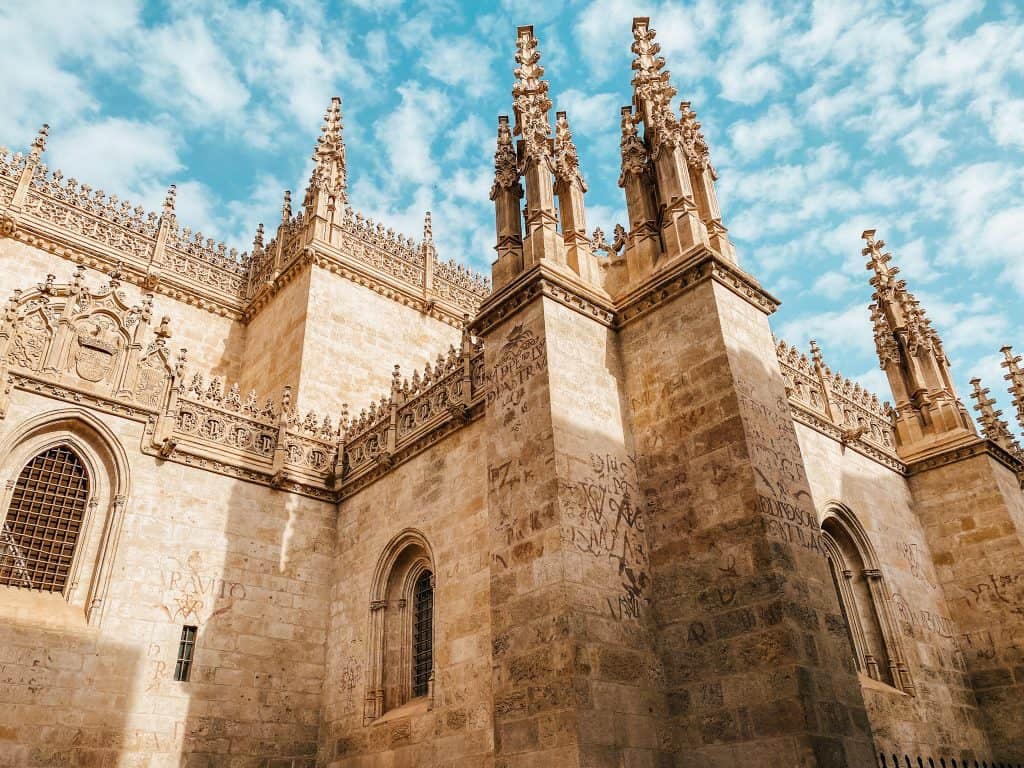
If you decide to stay in the city, you explore the city center further by visiting the Cathedral of Granada and the Royal Chapel of Granada from the inside.
You can visit the beautiful Carmen de los Catalanes garden in case you didn’t get enough park time at the Generalife Garden at Alhambra.
Or you can simply have a shopping day, look for Spanish souvenirs, drink tea in a tea house, get some henna, or whatever your heart desires. Don’t miss out on the Alcaicería market near the cathedral.
🤩 I love this guided tour to the cathedral and the Royal Chapel for the included entrance tickets!
Option B: Sierra Nevada
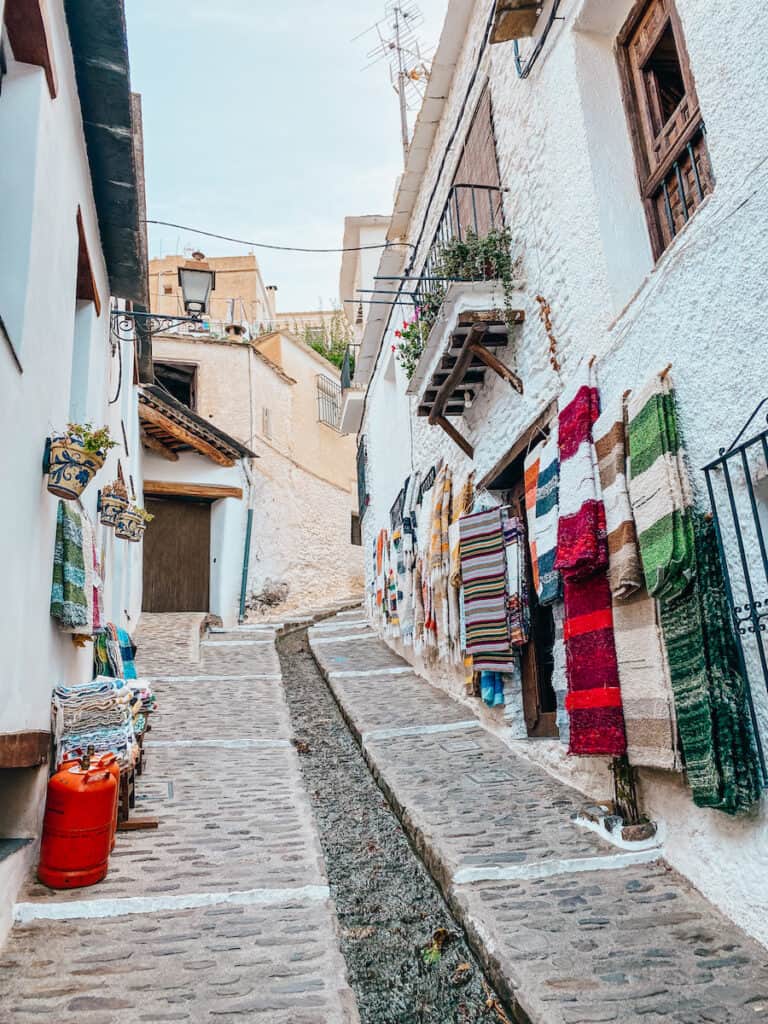
For a day surrounded by nature, take a trip to Sierra Nevada and enjoy a scenic drive through the mountains. The best way to see the Sierra Nevada is by a small guided tour.
The tour guide will bring you to some of the most picturesque white villages in Spain. You might also have the opportunity to hike around depending on the tour you choose.
If you’d rather hike in the Sierra Nevada mountains at your own pace, just rent a car for the day in Granada. Stop at the village of Capileira and hike in the nearby Poqueira Gorge for some amazing views.
🤩 I love this Sierra Nevada Tour for its small group sizes!
3. Stop: Sevilla
From Granada, take a bus or train to our final stop on the South of Spain itinerary – the largest city in Andalusia, Sevilla. Known for its stunning architecture, rich culture, and delicious food, you’ll want to spend at least 3 days in Seville .
That way you can explore the city of Seville in 2 days and you get to do at least one day trip as well.
🤩 Get a great first overview of the city on this Tuk Tuk tour!
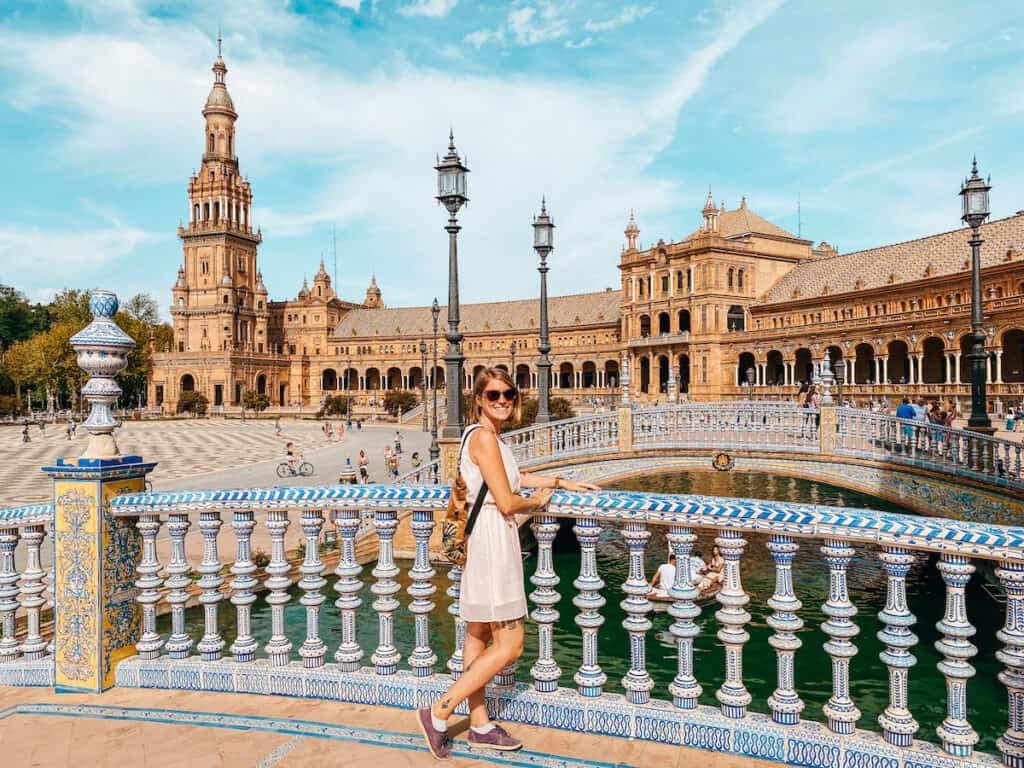
Day 6: Stroll Through the Old Town
Start your day by strolling through the charming old town of Sevilla. Make sure to visit the iconic Plaza de España, stroll through the big María Luisa Park, and take a walk along the beautiful Guadalquivir River.
You can also take a kayak tour on the river for a unique view of the city. A tour guide will tell you interesting anecdotes about the sights of Seville while you go past them, like the Torre del Oro.
In the evening head up to Metropol Parasol, or Las Setas, a modern structure that offers panoramic views of the city. Every day after sunset, they have a light show projected onto the structure, which is a must-see.
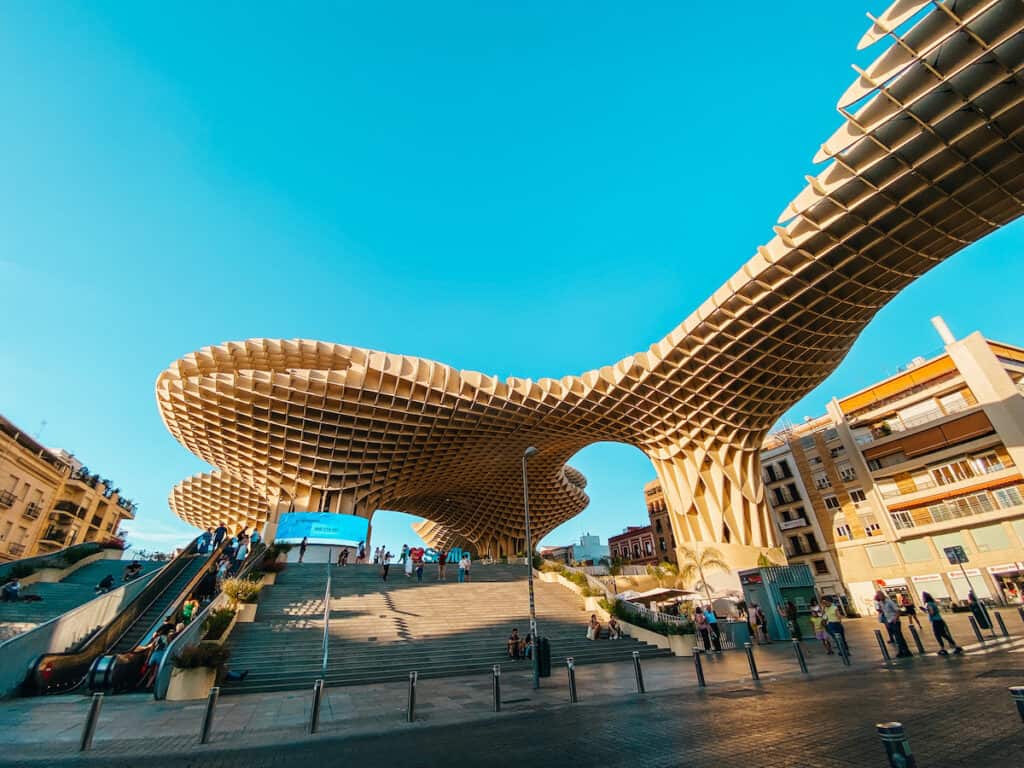
Day 7: Visit the Cathedral and Alcázar de Sevilla
Spend the day in Seville visiting the two most famous landmarks of the city – the Seville Cathedral and Alcázar de Sevilla. Those two attractions make Seville a must-visit stop on any Spain itinerary .
🤩 Get skip-the-line tickets for the best attractions in Seville!
Seville Cathedral is the largest Gothic cathedral in the world and the fourth-largest church in the world.
La Giralda, the bell tower of the cathedral, used to be a Minaret of the mosque which used to be on the site of the cathedral. You can climb up the tower for stunning views of the city.
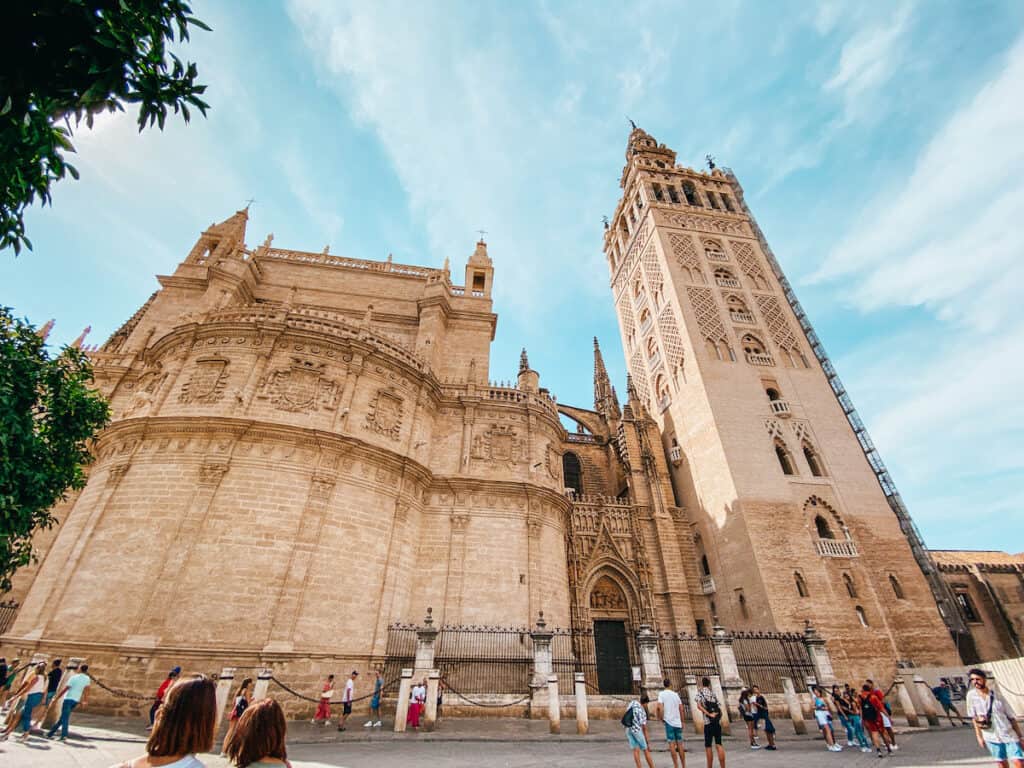
Next, visit the Alcázar de Sevilla , a royal palace that showcases stunning Moorish and Christian architecture. You’ll also recognize it as one of the settings for the popular TV show Game of Thrones.
In the evening, treat yourself to some delicious tapas in one of Seville’s many tapas bars.
🤩 Don’t forget to get your entrance tickets before they sell out!
Day 8: Day Trip to Córdoba
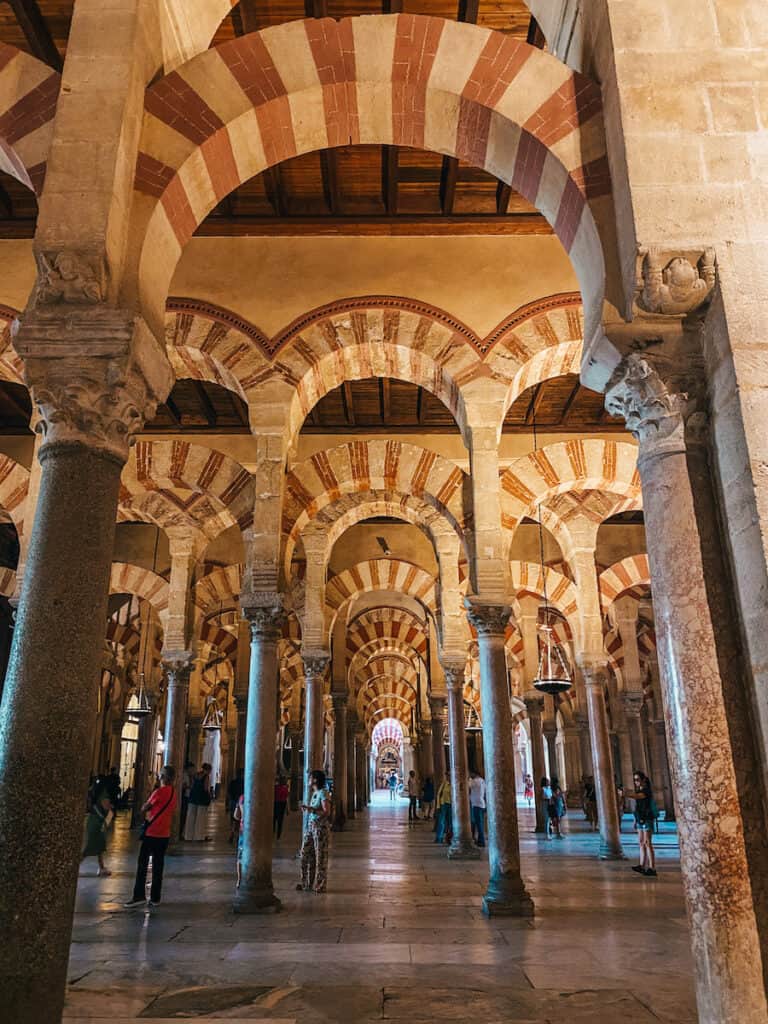
On your last day in Southern Spain, take a day trip to the beautiful city of Córdoba . It’s just an hour away by train.
The main attraction in Córdoba is the Mezquita, a grand mosque-cathedral that perfectly blends Islamic and Christian architecture.
Stroll through the charming streets of old town Córdoba, and take your time exploring the Mezquita, the fifth largest church in the world.
Other attractions in Córdoba include the Alcázar de los Reyes Cristianos, a fortress-turned-palace with beautiful gardens, and the Roman Bridge, which offers stunning views of the city.
🤩 I love this walking tour in Cordoba for the included entrance tickets!
Day 9: Day Trip to Ronda or Cádiz
On the ninth day, you get to decide which of these day trips from Seville you want to take. The many great day trips are one of the reasons to answer the question “ How many days do you need in Seville ?” with more than you might think.
Option A: Ronda
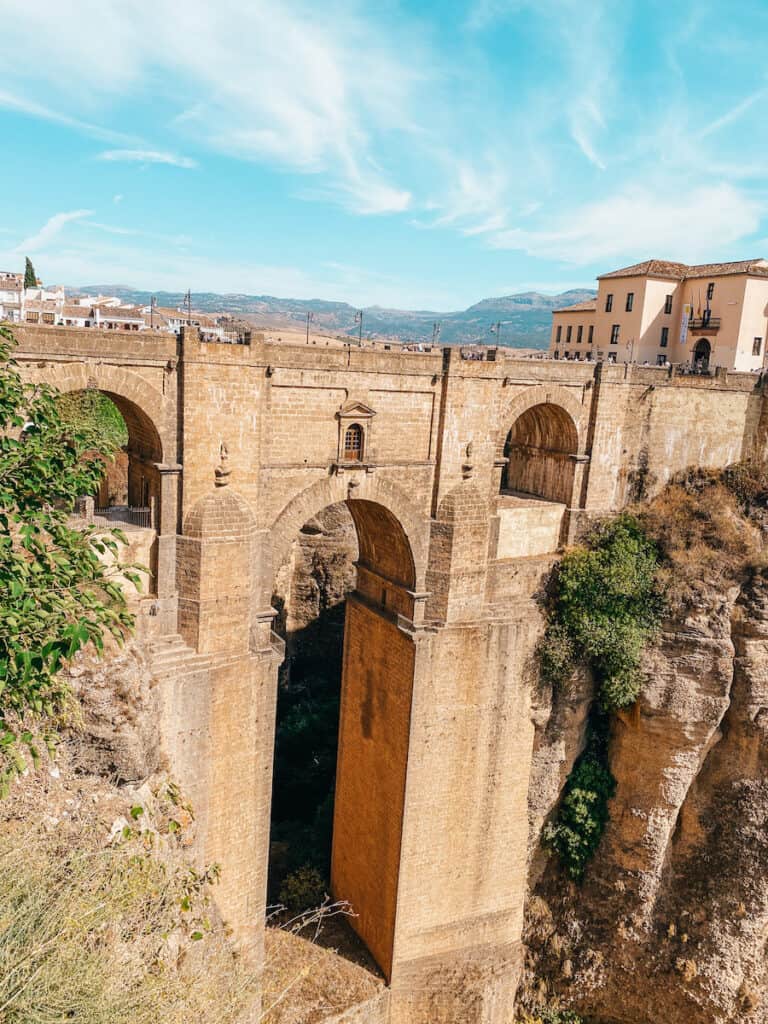
A day trip to Ronda from Seville is a great option for the second to last day of a 10 day Andalusia itinerary. This small town is known for its dramatic cliffside location and beautiful views.
You can walk across the famous Puente Nuevo bridge spanning over the El Tajo gorge, walk on the city walls, and explore the charming old town.
The best way to see Ronda from Seville is by guided tour. That way you don’t just get to see Ronda you also get to stop at some picturesque white villages like Zahara de la Sierra.
🤩 I love this Ronda and the White Villages Private Tour for the Customazability!
Option B: Cádiz
If you’d rather spend your last day on the beach, take a day trip to Cádiz. Located on the Atlantic coast, this port city is known for its beautiful beaches and historical landmarks.
Take a stroll along the promenade, visit the Cathedral of Cádiz, explore the charming old town, and most importantly relax on the beach.
Day 10: Back to Málaga
It’s time to say goodbye to Southern Spain and head back to Málaga for your flight home. Take the train or bus back to Málaga and spend your last day strolling through the city, enjoying delicious tapas, and reflecting on all the amazing experiences you had during your trip.

When Should You Visit Southern Spain?
Southern Spain is a great destination to visit year-round, but the best time to visit depends on your preferences.
In general, I would recommend the shoulder seasons, April to May and September to November.
I visited twice in October and I think it was the perfect time. The weather was still very warm and sunny, but there were fewer crowds compared to the summer months.
The summer months can get very hot, with temperatures reaching over 100°F (38°C), so make sure you stay hydrated and take breaks in the shade if you visit during peak season.
In winter, the temperatures can drop and it may even snow in some areas, but it’s still a beautiful time to visit, especially during the Christmas season when cities are decorated with lights and festive markets.

Final Thoughts: Itinerary for Southern Spain
From the famous Alhambra Palace in Granada to the stunning Mezquita in Córdoba, and from the charming streets of Sevilla to the beautiful beaches of Cádiz, Southern Spain has something for every type of traveler.
With this 10-day Southern Spain itinerary, you have enough time to see the best places of Andalusia, and you get to choose between different options to make the trip your own.
So pack your bags and get ready for an unforgettable journey through Southern Spain. I’m sure you’ll fall in love with this beautiful region just like I did.
Read more about Andalusia:
- Epic Southern Spain Itinerary: 10 Days in Andalusia
- Is Granada Worth Visiting? 10 Reasons Why It Is
- 10 Visiting Alhambra Tips
Guide to Vegan Granada
- Visiting Arab Baths In Granada
- Sacromonte Cave Houses in Granada: All You Need to Know
- Best Tours from Seville to Granada
- Epic Day Trip From Seville To Ronda With White Villages
- Ultimate Day Trip From Seville To Córdoba
- Amazing 3 Days in Seville Itinerary: What to See & Do
How Many Days in Seville Is Enough?
- 7 Absolute Best Day Trips from Seville, Spain
- Granada vs Malaga: Why I Prefer Granada Over Málaga
- Ultimate Guide to Málaga Old Town (with Map)
Is Malaga Worth Visiting?
- Destinations in Spain
Pin this Southern Spain vacation itinerary for later:

Tina Riegelnegg is the founder of Veganderlust. She started this blog in 2022 to share her experiences in order to help other travellers have the best experience and find the best vegan food while travelling. So far Tina has been to 31 countries on 5 continents.
Similar Posts

Seville is a stunning city in the south of Spain, known for its vibrant culture, delicious food, and rich history. It’s a…

Are you looking for vegan food in Granada? This Guide to vegan Granada lists the best vegan restaurants in Granada Granada is…

Amazing 3 Days in Seville Itinerary: What to See & Do
Have you been looking for the best 3 days in Seville itinerary? I’ve got you covered! For a year I thought that…

Honest Seventy Hotel Barcelona Review: Pros & Cons
The Seventy Hotel is a modern hotel with a rooftop pool and spa area in the Eixample neighborhood. It’s within short walking…

Malaga is the second biggest city in Andalusia and the sixth biggest city in Spain. It’s located on the beautiful Costa del…
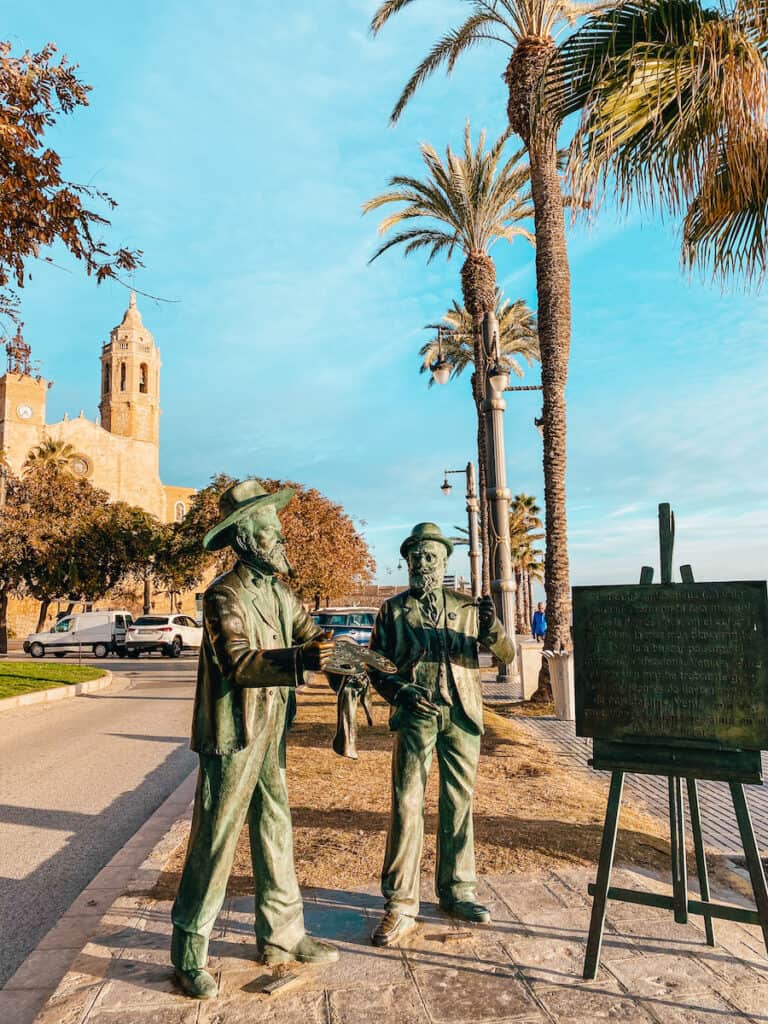
Epic Day Trip from Barcelona to Sitges by Train
Sitges is a charming seaside town just a short train ride away from Barcelona and offers stunning beaches, colorful architecture, and a…
Travel Europe on a Budget
The Savvy Backpacker
City Guides .\33 a132798-3f3b-4585-954d-7e70cf863447{fill:#231f20}
Spain train guide – how to travel spain by train.
How to travel Spain by train — Tips for buying Spanish train tickets and advice for navigating Spain by rail.
Transportation
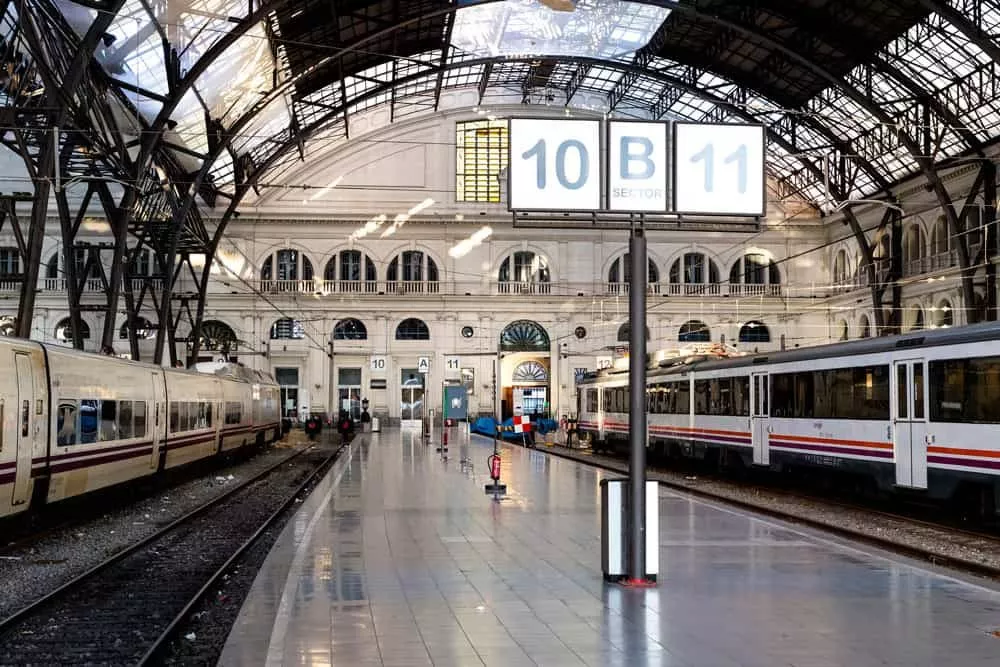
Spain is well-connected by rail so you can easily get just about anywhere quickly and fairly inexpensively. Luckily for travelers, Spain’s rail network has improved immensely over the past few years and its high-speed AVE trains now connect Spain’s major cities at speeds over 180mph. But, of course, it still has a few quirks. In this Spain Train Guide, we’ll tell you everything you need to know about taking the train in Spain—from navigating the system to buying train tickets in Spain for the cheapest price.
Electronic Train Tickets and High-Speed Data in Spain
Most train tickets in Spain (and much of Europe) are now electronic so you’ll want reliable high-speed data for your phone—personally, I wouldn’t rely on free wifi or your domestic provider’s international service as it’s often slow/unreliable.
Luckily, getting high-speed data in Spain is fairly simple and affordable. Here are a few articles I’ve written to help you get set up:
- Guide To Mobile Data Plans and Smartphone Phones in Europe
- How To Buy A SIM Card and Mobile Data Plans in Europe
- Guide To Buying SIM Cards and Mobile Data Plans in Spain
How To Buy Train Tickets in Spain

There are a number of ways to buy Spanish train tickets but it’s not always super straightforward. Keep reading and we’ll walk you through the process.
Let’s first take look at where and when to buy tickets for the best price…
Where To Buy Spain Train Tickets
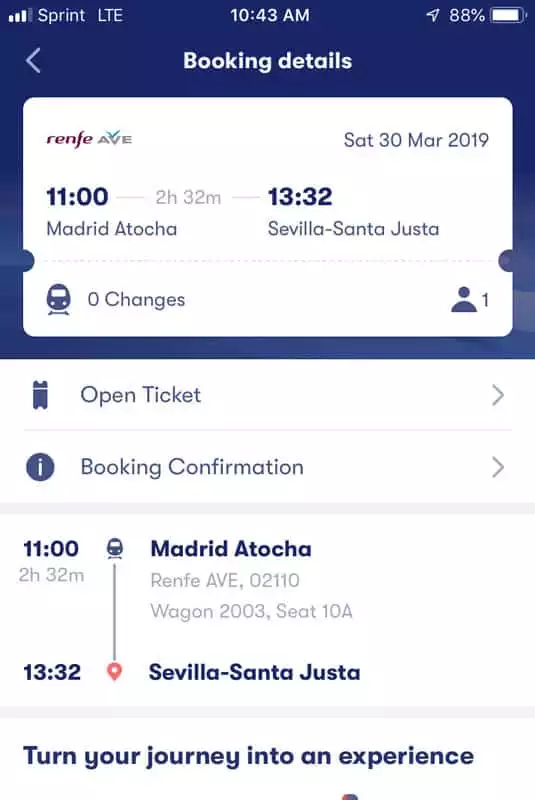
Below are the various ways to buy train tickets for Spain and we’ve tried to call out the common quirks of each method.
Omio: Omio is a search engine that lets you compare and book trains (plus buses & flights) anywhere in Europe. It lets you easily book tickets with your credit card at essentially the same prices as Spain’s Railways website. Additionally, Omio searches routes for multiple rail services across Europe so it’s great for international trips (since it can easily combine rail journeys of multiple countries). Omio also gives you the option to print your own tickets or have eTickets sent to the Omio App.
TrainLine: TrainLine is a third-party booking site that connects directly to Spain’s National Rail Network (renfe.com) and other European networks. Trainline also accepts international credit card payments and lets you print your own tickets or have eTickets sent to the Tranline App.
RENFE (Spanish Railways) : The National Spanish Railway system is called RENFE and anyone is allowed to buy tickets from renfe.com. Like most national rail sites, renfe.com suffers from weird translation issues and sometimes it won’t accept foreign credit cards. When I tried booking I found that the website was only partially translated into English and it would randomly switch to Spanish. Additionally, it’s confusing when you enter your billing address because it’s in the Spanish format. So, I suggest sticking to the other methods outlined above.
Types Of Train Tickets
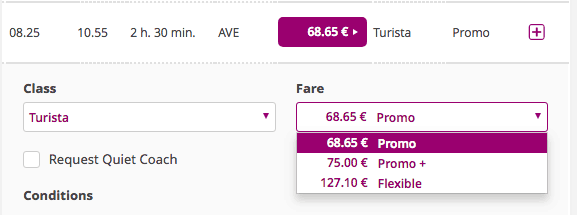
There are three main types of ticket fares available — each ticket class is available for both first-class ( Turista Plus) and second-class ( Turista ) tickets. There is also a Preferente class that’s first-class + a meal.
- Promo: Promo is the cheapest ticket available but it’s also non-refundable — so you’re out of luck if you miss your train or need to cancel your ticket.
- Promo+: Promo + is semi-flexible so it’s a bit more expensive but you’ll get a 70% refund if you need to cancel tickets.
- Flexible: Flexible is the most expensive ticket but you get a 95% refund should you need to cancel.
Group (Mesa) Ticket Discount
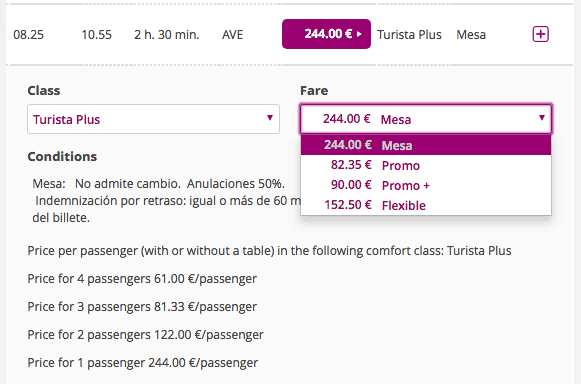
AVE and long-distance trains often offer up to a 60% discount for groups who buy four seats together — this is called a Mesa fare ( Mesa means table in Spanish). You have to buy the entire set of four seats but this is usually even a good deal for groups of three since the group still saves money by purchasing the block of four seats.
HOW TO COLLECT YOUR TICKETS
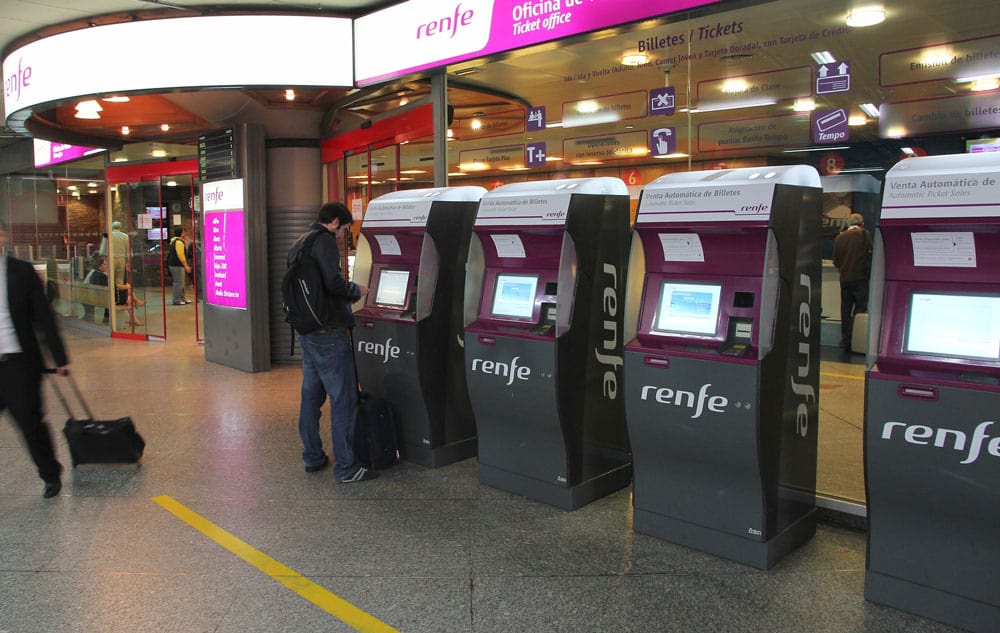
Tickets purchased online can be collected in a few different ways. Most of the time you’re given multiple methods of collecting your tickets but double-check as things seem to randomly change.
- Print-At-Home Tickets: You’ll often be sent a PDF that you print at home and show to the conductor on the train when he checks tickets.
- Smartphone: You can save the PDF ticket to your phone and they can scan it from there. We recommend saving it to your iPhone’s Passbook app.
- Pick Up At the Station: Use your booking confirmation number to collect your tickets at the train station. This isn’t always an option.
DO I NEED TO BUY SPANISH TRAIN TICKETS IN ADVANCE?
Short answer — Yes. It’s best to book early if you want to save money on your train tickets. This mainly applies to Spain’s AVE (Alta Velocidad Española) high-speed trains and most medium/long-distance trains. You’re able to book tickets about two to three months before the departure date — it randomly fluctuates so check back in a few days if you’re not finding many/any results. The longer you wait the more you’ll pay—a ticket purchased on the day of travel will cost around 3x a ticket purchased two months early.
However, local/short-distance trains don’t need to be booked early as the prices are fixed.
Late Train Arrival Refunds
One interesting thing that Renfe offers is compensation for delayed/late arrivals on all high-speed and long-distance trains—and it doesn’t matter what caused the delay. Each train service has different refund policies but the high-speed AVE trains will refund 50% if the train is over 15 minutes late and 100% if the train is over 30 minutes late.
You can collect your refund at the train station or you can trade in your credit + receive a 20% bonus if you purchase a future ticket.
Using Your Spain Train Tickets
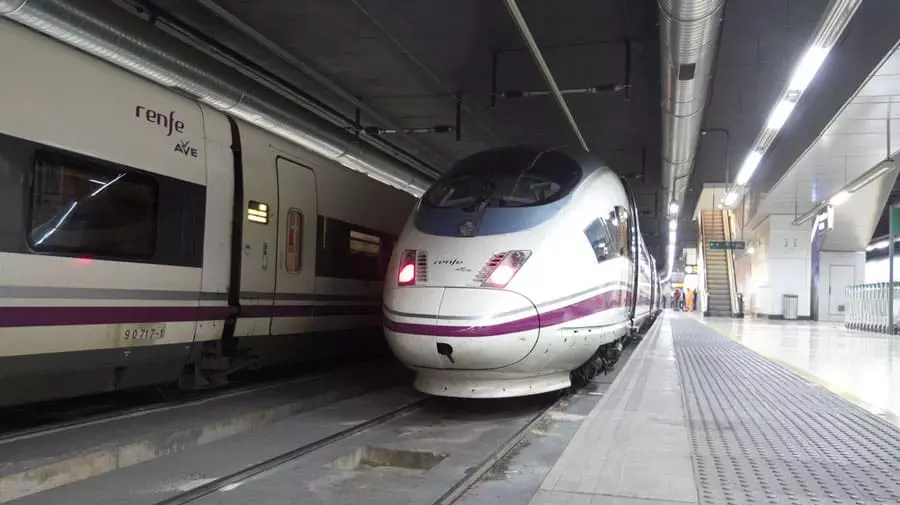
Unlike most of Europe, there is never a need to validate your Spanish train tickets — regardless of what kind of ticket it is. On high-speed trains , your ticket is only good for the specific time printed on your ticket. You’ll also be given an assigned seat. On slower trains, you’ll just show the conductor your ticket when they check tickets on the train.
We recommend getting to the train station about 20 minutes before the train departs so you can find your platform. On high-speed trains, you’ll need to go through security but it should only add an extra few minutes to your journey.
Rail Passes for Spain
The cheapest way to travel via train in Spain is by purchasing advanced tickets. In virtually every situation this will be more cost-effective than using a Eurail pass .
However, tickets are expensive if you buy them only a few days in advance so it usually makes more sense, both financially and practically, to use a rail pass if you’re a spontaneous traveler—especially when using high-speed trains.
Check out Eurail.com to see their rail passes.
HOW TO MAKE RAIL PASS RESERVATIONS
High-speed and long-distance trains in Spain require a reservation when using a Eurail pass — the reservation will cost €10-€15/seat. Tip: Always look to see the price of a normal ticket costs because on some routes a normal ticket will cost less than the Eurail reservation fee.
Also, You must make the reservation before you get on the train and some routes limit the number of rail pass holders so it’s wise to book your reservation early. Most of the time you need to make the reservation a minimum of one hour before departure but we suggest doing it as early as you can.
There are a few ways to make reservations:
- RailEurope.com lets you book your reservation online through their platform. Simply look for a button that says “I Have A Railpass” and follow the prompts.
- At The Train Station: You can simply go to the train station and book your reservation from the customer service desk or self-service kiosks. You can book it weeks in advance or you can do it the day you depart. We suggest using the kiosks because the ticket window can take forever.
More Spain Train Travel Tips
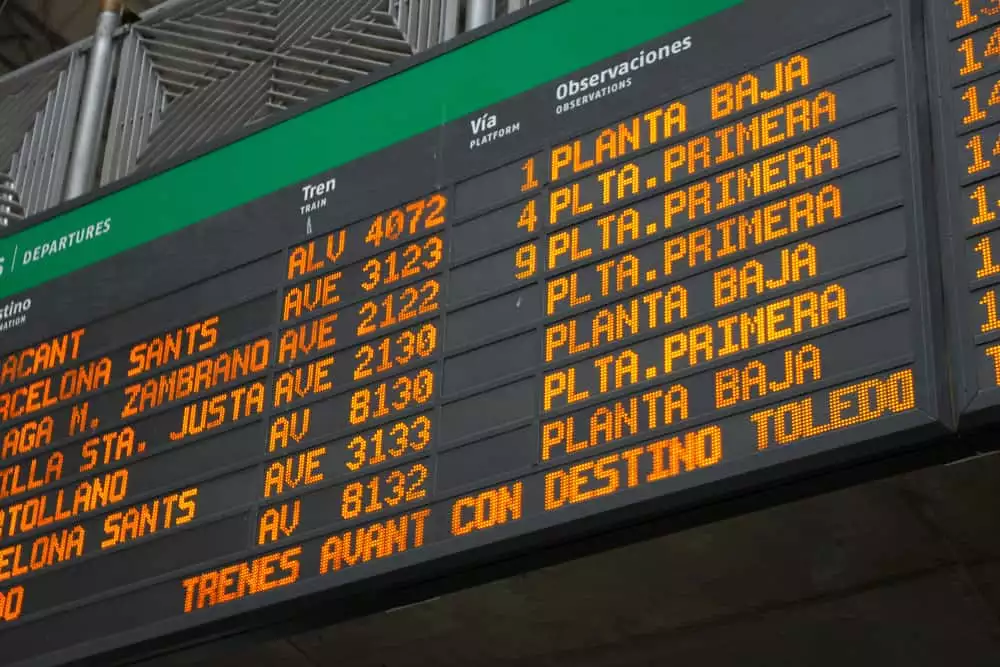
- The Departures Board: You’ll find your train platform via the departure board at the train station. Don’t worry if you don’t see your train because they often only display trains departing within the next 10-20 minutes.
- Security Screening: In Spain, all high-speed trains require you to screen your bags via X-ray. It normally only takes a few minutes.
- Self-Service Machines Are In English: Don’t worry if you don’t speak Spanish because the ticket machines (and train station signs) are all in English.
- Cheap Tickets Are Non-Refundable: One downside to cheap tickets is that they’re non-refundable and they can’t be changed.
- Pack A Picnic: You’re allowed to bring your own food and alcohol on trains. It’s great for those long train rides.
- Luggage: There aren’t any weight limits on luggage and you can bring as much as you want (well, as much as you can carry). Simply bring it on and store it above your head, behind your seat, or in the luggage racks in each car.
- Making Connections: Your trip might require you to change trains along the journey. Don’t worry if there isn’t much time between trains as switching trains are usually fairly quick and easy (it’s not like flying).
- Get To The Train Station Early: Train stations are usually fairly easy to navigate but they can be a little confusing.
- Know Train Station Names: Most large cities have multiple train stations (Madrid and Barcelona both have two) so this often creates confusion. Double-check to make sure you have the right station — especially when booking your ticket.
More Spain Travel Tips from The Savvy Backpacker

- Barcelona Travel Guide : Tips for visiting Barcelona
- Best Hostels in Barcelona : Our favorite budget accommodation in Barcelona.
- Madrid Travel Guide : Tips for visiting Madrid.
- Best Hostels in Madrid : Our favorite budget accommodation in Madrid.
- How To Choose The Best Travel Insurance : Travel insurance will help cover those non-refundable train tickets if something goes wrong during your trip.
- Packing List For Europe Travel : Tips on packing light (which makes train travel much easier).
- Recent Posts
- Best eSIM For Europe Travel | Everything You Need To Know About European Prepaid eSIM Data Plans - March 24, 2024
- Holafly eSIM Review | Testing The New eSIM Data Plan from Holafly - March 3, 2024
- Fashion Advice: How to Avoid Looking Like An American Tourist In Europe - February 20, 2024

No Funny Business
The Savvy Backpacker is reader-supported. That means when you buy products/services through links on the site, I may earn an affiliate commission—it doesn’t cost you anything extra and it helps support the site.
Thanks For Reading! — James
Questions? Learn more about our Strict Advertising Policy and How To Support Us .
Related Reads
How to purchase train tickets for europe | strategies for buying european train tickets.
Tips on the easiest and cheapest ways to buy train tickets in Europe.
Complete Guide To Train Travel In Europe | How To Travel Europe By Train
Our step-by-step guide to traveling Europe by train.
Italy Train Guide — How To Travel Italy By Train
How to travel Italy by train — tips for buying Italian train tickets and advice for navigating Italy by rail.
France Train Guide — How To Travel France By Train
How to travel France by train—tips for buying French train tickets and advice for navigating France by rail.

City Guides
Choosing travel insurance, travel packing lists, budget travel newsletter.
The best budget travel tips sent straight to your inbox.
Join My Journey
Europe travel tips, advertising & privacy policies.
TheSavvyBackpacker.com is a participant in the Amazon Services LLC Associates Program, an affiliate advertising program designed to provide a means for sites to earn advertising fees by advertising and linking to amazon.com.
© 2010 - 2024 The Savvy Backpacker
Website Design by FHOKE
Train Travel in Spain
Train travel in Spain is a great way to get around the country. Here's what to expect when taking the rails!
A great way to get around southern Spain is by utilizing their train service. The Red Nacianal de los Ferrocarilles Españoles or RENFE is the Spanish national railway and it is fabulous.
Spanish trains are fast, comfortable, and reasonably inexpensive. My favorite is the AVE train- it travels up to 220 miles per hour or 300 kilometers per hour. In many cases it can be quicker to take the AVE than it would be to fly. It definitely would be more comfortable. The Spanish railroad network connects almost every major city in Spain.
I often fly into Madrid and take the AVE to Seville. This is great because you can stop in Cordoba and spend a night, or just a few hours before moving on to Seville. You can also take the train from Cordoba to Malaga or Granada. Once in Seville you can take a train to Jerez de la Frontera for some wine tasting or take it to the end of the line in Cadiz and spend a day on the beach.
Benefits of Train Travel in Spain
Besides for making it a convenient way to get around it is incredibly comfortable to travel by train. The seats give you more leg room than first class. Sometimes you can get seats that face each other with a table in between great for families to play cards or let the kids color.
Train travel in Spain, most times, have food cars where you can get a beer, a glass of Spanish wine, a bottle of water, maybe some Spanish olives sit back, relax, and watch the country side. Taking the Ave to Seville is one of my most enjoyable parts of my journey. While enjoying a glass of wine you look out over acres and acres of olive groves.
Ticket sales – you can buy your tickets online and their multiple websites to do so. However, I never have and always buy them at the train station. The only advantage I could see to buying them on line is they are slightly cheaper and if you do not speak any Spanish you can avoid having to converse in Spanish. With that said most ticket agents speak English and if they don’t it is not hard to get your point across.
Most trains if not all trains have luggage racks as soon as you get into the rail car or above your seat. The luggage is not secure so recommend keeping valuables on you. Again, I have never had a problem on the trains but a little common sense goes a long way.
Smoking- Spain has ratcheted up there smoking laws and banned smoking on the trains. My first visit to Spain, they had smoking cars.
Annoucements – Don’t worry if you don’t know what the next stop is most times they announce it over the intercom in Spanish and English. Also, the station are clearly marked when you arrive.
Cleanliness- Spanish trains are super clean. They take pride in keeping it that way which makes for a more comfortable ride.
All of these are reasons to consider train travel. But beware, they say that there are two things that are always on time, never late, in Spain. The bullfights….and the trains. Don’t be late!
Return from Train Travel in Spain to Southern Spain Travel
New! Comments
Copyright© southern-spain-travel.com All Rights Reserved. Content Protected By DMCA.
About Spain
- Spanish Culture
- Traditional Food
- Spain's Climate
- Spanish Currency
- Facts about Spain
- Map of Spain
- Spanish Beaches
- Spanish Islands
- Spain Photos
South Spain Cities
- Jerez de la Frontera
- Donana National Park
- Train Travel
- Buses in Spain
Villas for Rent
Things To Do
- Spain Tours
- Bullfighting
Prepare your Trip
- Getting a Visa
- Learn Spanish
The Best Spain Hotels
Spain's Food
Climate & Temperature
Authentic Spain Food
It's true! Get tapas, jamon, olive oil, manchego and chorizo shipped directly from Spain
Get Football Tickets
Click here to buy tickets to Spains Sports events
Book a Hotel
Click here to find the best selection of hotels
- Privacy Policy
- What's New!
- Your Travel Stories
- Travel Questions
🌍 Help me LP! What is the one train trip that can include the best of Spain?

Feb 20, 2023 • 4 min read

From beautiful beaches to exciting cities to charming country villages, the delights of Spain are just a train ride away © Getty Images
In this series, Lonely Planet’s team of writers and editors answers your travel problems and provides tips and hacks to help you plan a hassle-free trip. The train in Spain? That’s one for Barcelona-based, Andalucía-raised travel expert Isabella Noble.
Question: I want to visit a city, an off-the-beaten-track destination and a beach in Spain by train, all in one trip. How can I do it?
Isabella Noble: With a raft of new routes launching, it’s a bumper year for train travel in Spain – and there’s never been a better time to explore the country by rail. Here are two itineraries, in two regions, that will let you see the best of this magical country by train.
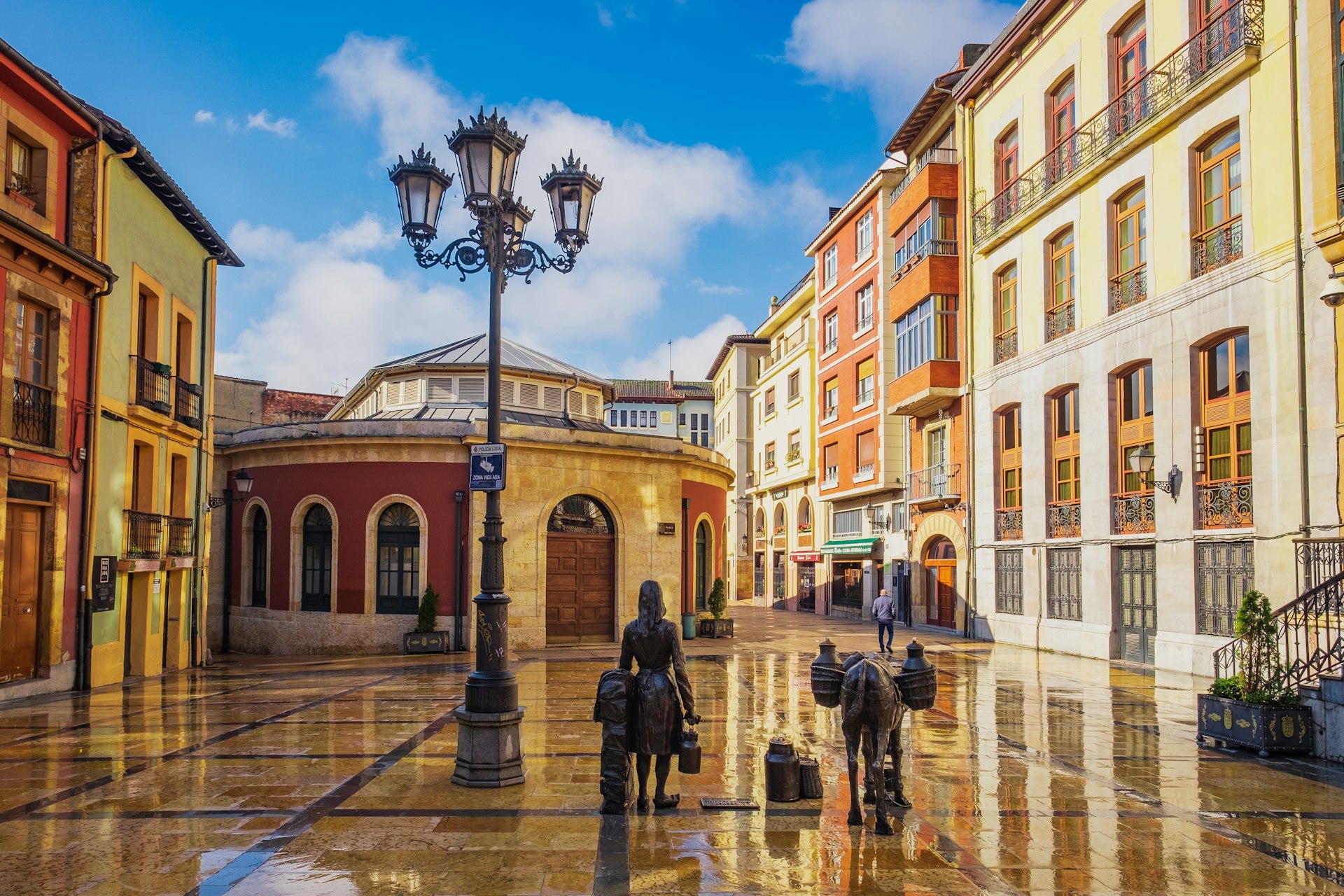
A slow-paced northern journey
A lesser-known pocket of Spain with divine beaches? Head to the wonderfully green north coast . There’s a go-slow beauty to trundling through this region on the narrow-gauge FEVE railway , hopping off and on as you make your way east from Oviedo. Buy tickets at stations or on board; at the smallest stops you might have to flag trains down, bus-style.
Start with a couple of days in elegant Oviedo , capital of Asturias , whose charms include spectacular pre-Romanesque churches, lively markets, graceful plazas and the memorable Museo de Bellas Artes , along with a thriving food scene (think blue cheeses and crisp ciders). Tierra Astur on the famous Bulevar de la Sidra and Nacho Manzano’s Gloria are favorite local restaurants; consider a stay at the smart Barceló Oviedo Cervantes . Adding to the appeal is a brand-new high-speed AVE train line, expected to (finally) link Oviedo with Madrid later this year.
Next, hop on the FEVE to Arriondas (90 minutes), a peaceful little town in the foothills of the Asturian Picos de Europa mountains. It’s a great base for hiking, with serene rural bases such as Posada del Valle , a restored 19th-century home with its own organic farm.
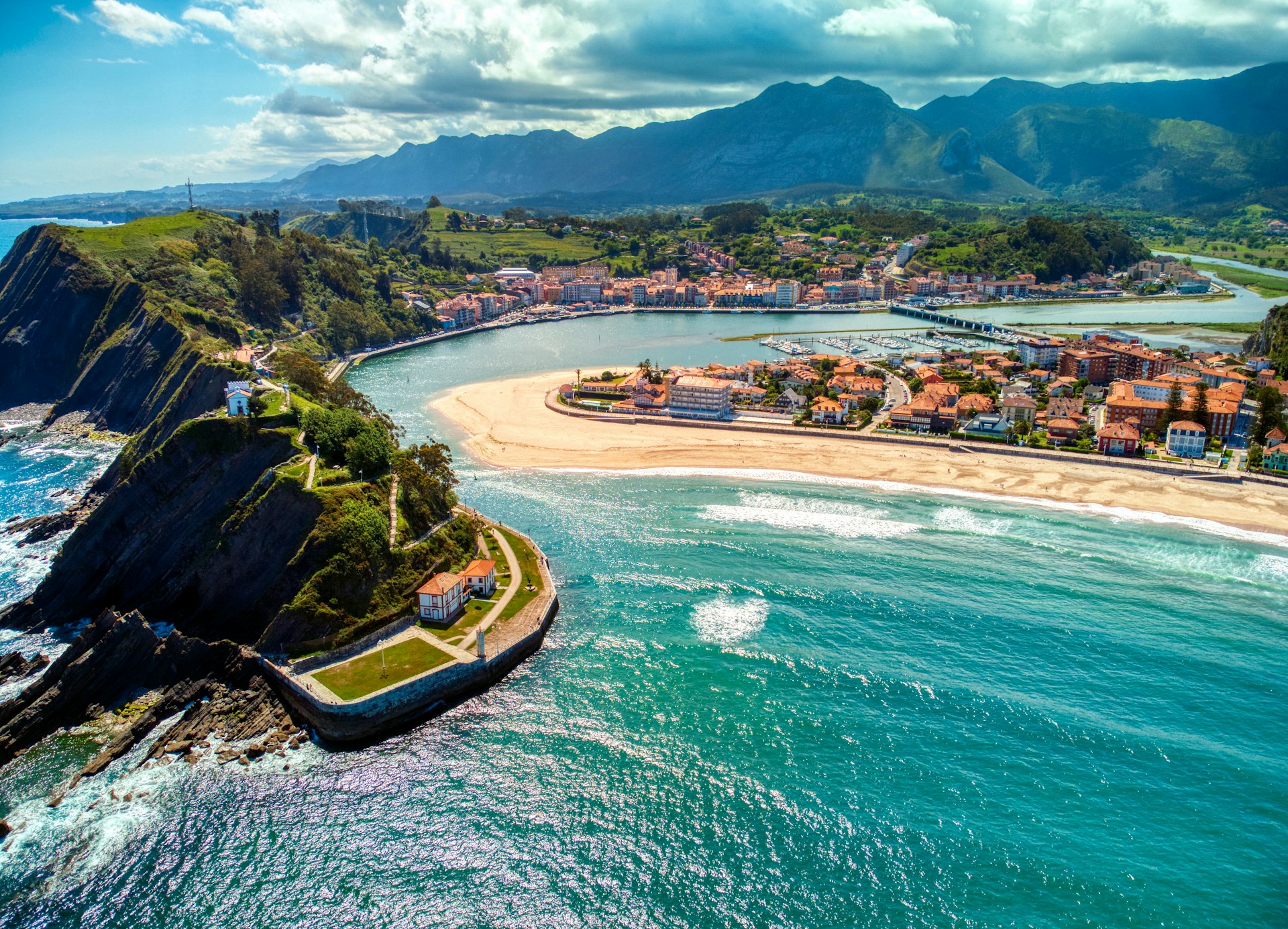
Next, it’s beach time, via a 50-minute train to Ribadesella on Asturias’ cliff-edged coast. Set on an estuary, Ribadesella is known for its golden beach and wonderful seafood restaurants (try La Huertona ). Come evening, sleep in a thoughtfully converted 20th-century palacete (mansion) at Villa Rosario . There’s a similar feel in nearby Llanes, a buzzing beach town 40 minutes further east. Plenty of gorgeous, remote beaches lie along this stretch of coast (I love Torimbia, Toranda and Gulpiyuri), and the Camino del Norte route of the Camino de Santiago passes through here, too.
From Ribadesella (90 minutes) or Llanes (40 minutes), take the FEVE east to San Vicente de la Barquera , Cantabria ’s prettiest fishing town. The route stays close to the coast between Ribadesella and San Vicente, before turning inland to reach Cantabria’s capital Santander , home to sweeping beaches, the Renzo Piano–designed Centro Botín gallery and lovely boutique B&B Jardín Secreto .
South from Seville
For a taste of magical Andalucía , combine the soulful regional capital Seville with Cádiz Province ’s wildly beautiful Costa de la Luz , with most of your travel on Renfe ’s media distancia trains or cercanías (local commuter trains). You can prebook media distancia tickets; cercanías tickets are easily bought at the station on the day of your travel.

Three days is enough time to soak up Seville’s urban delights – the Moorish-origin Real Alcázar , flamenco-filled Triana, the magnificent cathedral – and the thrilling Andalucian tapas scene ( La Brunilda , Eslava , Las Teresas ). Hotel Casa 1800 Sevilla provides an evocative, central base in a reimagined 19th-century mansion. Time permitting, little-visited Carmona makes a wonderful side trip from Seville , with Roman, Moorish and Mudéjar relics; it’s easily reached by bus (75 minutes).
Heading south to Cádiz from Seville, don’t miss a night or two in lively Jerez de la Frontera , center of sherry and flamenco. It’s a one-hour train from Seville’s Santa Justa station to Jerez, where you can stay at stylish Hotel Bodega Tio Pepe , tour ancient bodegas like Lustau or Tradición and dive into the buzzy tabancos (sherry bars).
From Jerez, cercanías (45 minutes) and media distancia and Alvia trains (both 35 minutes) zip onwards to Cádiz , one of Europe’s oldest cities, with its buzzy historic center perched on a wind-lashed headland. Cádiz has a clutch of fabulous golden-white beaches, including Playa de la Caleta (bordering the old town’s Carnival-loving Barrio de La Viña) and surfy Playa de la Victoria , south of the centre. Savor the city’s famous tapas scene at Taberna La Sorpresa , Casa Manteca and the Mercado Central , and stay at Casa de las Cuatro Torres , an 18th-century mansion turned boutique hotel.

But the Cádiz region’s dreamiest beaches lie southeast of the city, along the blissfully undeveloped Costa de la Luz, which stretches all the way to Tarifa on the southern tip of mainland Europe. No trains run here, but it’s a scenic one-to-two-hour bus trip from Cádiz to the pretty Costa de la Luz hubs of Vejer , Conil and Tarifa – and the powdery white sands, wonderful gastronomy and kitesurfing vibe are the irresistible reward.
Explore related stories
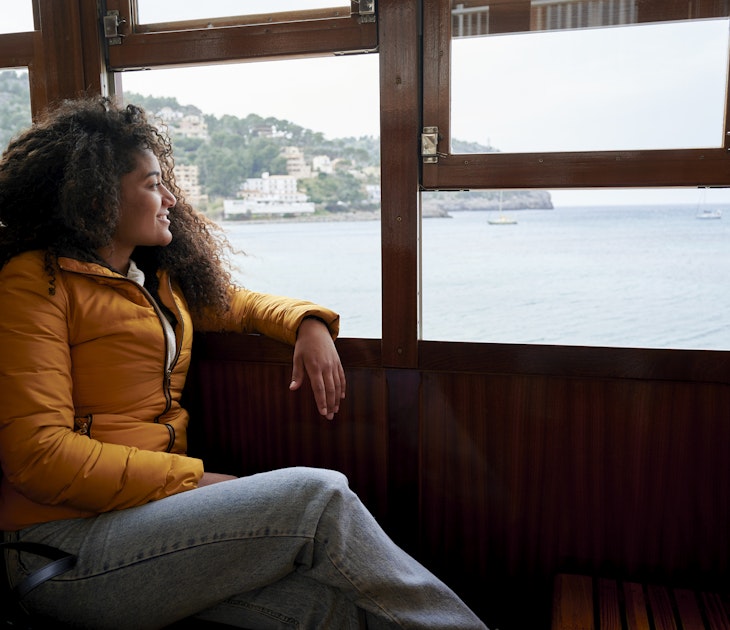
Budget Travel
Jun 26, 2023 • 5 min read
Traveling around Spain is convenient, efficient and manageable — thanks to its advanced and accessible public transport infrastructure.
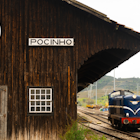
Feb 8, 2023 • 5 min read
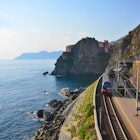
Dec 27, 2022 • 8 min read

Dec 1, 2022 • 7 min read

Apr 3, 2024 • 15 min read

Mar 31, 2024 • 6 min read

Mar 25, 2024 • 6 min read
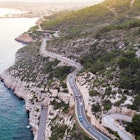
Mar 13, 2024 • 7 min read

Mar 8, 2024 • 17 min read

Mar 2, 2024 • 7 min read

Southern Spain Itinerary: 10 Days in Andalucía
Last Updated on November 27, 2023
by Maggie Turansky
Disclaimer: This article contains affiliate links. That means if you click a link and make a purchase, we may make a small commission. As an Amazon Associate we earn from qualifying purchases. For more information, see our privacy policy.

Planning a southern Spain itinerary can seem a bit overwhelming when you consider all of the incredible places to visit in this vast and diverse region. Boasting vibrant cities, sleepy beach towns and everything in between, heading to Andalucía is never a bad idea.
Known for its diverse landscape, fantastic cuisine, historic cities, and laid-back culture, Andalucía is one of the most popular and sought-after regions in the country. As one of the largest autonomous regions in Spain, Andalucía is filled with a complex history and culture unique to the rest of the country.
If you’re wondering what to see when spending 10 days in Southern Spain, then look no further. We have had the pleasure of spending months exploring this incredible region over several years and have gained a wealth of knowledge about travelling there.
Table of Contents
Best Time to Visit Southern Spain
Before we get into the logistics of our itinerary, we need to discuss the best time of year to visit this sunny region.
A good portion of Andalucía is blessed with over 300 days of sunshine per year and, outside of the high Sierra Nevada mountains, the weather will rarely ever get cold enough for it to freeze or snow.
Because of this, Andalucía (and the Costa del Sol in particular) is a popular winter destination for northern Europeans looking to escape the cold, dark weather of their home countries.
However, while the months between November and March are certainly warmer than virtually anywhere else on the continent, nights can still get chilly and you are more likely to have some rainy days.
However, if you plan to visit Andalucía in the summer months, you can expect some of the hottest temperatures in Europe, with some towns repeatedly being subjected to temperatures over 40°C (104°F).
While many hotels, apartments, and tourist sites are air-conditioned and many of the towns are equipped to handle such high temperatures, it can be uncomfortable to visit during the peak summer months.
Arguably the best time to undertake an Andalucía itinerary is in the shoulder seasons of March-May and September-November. It is during these months where the weather is at its best — mild yet warm and sunny — and tourist numbers haven’t reached their peak.

How Many Days in Southern Spain?
Now that we’ve determined which time of year is best to go to Spain, we need to figure out how many days you need for your itinerary for southern Spain.
While it might seem that one region of a country wouldn’t require all that much time to explore, you would be quite wrong to assume this of Andalucía.
The region is vast, encompassing multiple major metropolitan areas and various sub-regions and provinces. Each city, town or village that you will visit in Andalucía will have its own unique character that will beg you to explore more.
However, if you don’t have a lifetime just to devote to exploring one region of one country (like everyone else), plan to set aside at least ten days for your trip.
In ten days, you can see a lot of the region without being too rushed and really get a feel for the culture and history. While you likely won’t have time to visit every city and town of interest in Andalucía, 10 days is enough to give you a very good feel for the region.
If you have a bit longer to spend, then the absolute ideal amount of time to spend in Andalucía would be about 2 weeks. This will allow you to visit all of the major metropolitan areas of the city and get a little bit off the beaten path.

Getting To & Around Andalucía
Spain is home to a number of different international airports and there are lots of options when it comes to your itinerary.
The largest airport in Andalucía is located in Málaga and there are countless connections across Europe and further afield here. Flying into Málaga is a good option for those following the Costa del Sol route below.
There are also airports in Seville and Granada, though they are less trafficked. You can find connections across Europe – particularly into Seville – however, you may find it easier to fly into Madrid and then take the fast train to Seville, depending on where you’re coming from.
Once in Spain, it is also necessary to figure out how to get from one destination to another as you explore the region.
While many people like to hire a car and head out on a Southern Spain road trip itinerary, having your own rental car isn’t entirely necessary. The stops on this route are all easily accessible by bus or train (though booking trains and buses in advance is a good idea!) and each city itself is quite walkable.
If planning on taking a number of trains, a train pass can be incredibly good value. If you’re from outside of Europe, you can view Eurail Spain Passes here . Alternatively, if you’re from the EU, you can view Interrail Spain Passes here.
Where you might find a car more helpful during this Andalusian route is if you want to go on some more off-beat day trips that don’t have frequent or easy connections via public transport.
If you’re thinking of renting a car in Spain, we recommend using Rentalcars.com to find the best rates. It can also be worth taking out a third-party insurance policy with iCarHireInsurance to avoid paying higher fees through the rental car agency.

10-Day Southern Spain Itinerary
Day 1 – seville.
The capital of Andalucía, no itinerary would be complete without a stop in the dynamic and historic city of Seville. One of the most beautiful cities in Spain, Seville has a ton to offer tourists and it is one of the best cities to get to know the unique culture and history of Andalucía.
Seville is the fourth-largest city in Spain and therefore is an easy starting point for a route through southern Spain as it is well connected both because if its international airport and frequent buses and trains from all major Spanish cities.
Due to its size and historical significance, there are also a lot of things to do in Seville that you can easily spend 3 or more full days exploring the city. Plan to spend a couple of days in the city itself, checking out all of the incredible sites.
On your first day, plan to get your bearings – a great way to do this is by going on a free walking tour! Of course, you cannot miss the incredible Seville Cathedral , which takes some time to explore.
Make sure to wander through the gorgeous streets or take a walking tour of Barrio Santa Crus, which was the former Jewish Quarter of Seville. And, finally, end your day by taking in the sunset from the Metropol Parasol – known locally as “Las Setas.”
No visit to Seville is complete without hopping around a few tapas bars and this is an excellent thing to do your first evening in Andalucía!

Where to Stay in Seville
Hotel Bécquer – This centrally located hotel is a great choice if you’re travelling on a mid-range budget but want to be close to all of the action. They have numerous clean, comfortable rooms available and they also have a wonderful rooftop pool and terrace to take the edge off of those warm Seville days.
Monte Triana – Located in the vibrant Triana neighbourhood, this swanky boutique hotel is on of the highest-rated in Seville. Located within a 15-minute walk of all of the top sights of the city and close to some of the best tapas bars in Seville, they have a number of luxurious rooms available.
Onefam Catedral – If you’re travelling solo or have a tight Spain travel budget , this hostel is an excellent choice. It is one of Seville’s highest-rated hostels and it is located within easy walking distance of sites like the Cathedral and the Alcázar. They have a range of dorms and private rooms available and the staff organises social events and activities.
Not quite what you’re looking for? Click here to browse for more hotels in Seville!
Day 2 – Seville
On your second day in the capital of Andalucía, take the time to dig a bit deeper and enjoy some more of the incredible sites that Seville has to offer.
Start your day by exploring the Mercado de Triana on the other side of the Guadalquivir River – this is a great area to wander through on its own, but the market is something special.
And you absolutely cannot miss the Real Alcázar – this takes a few hours to explore and it is so wonderful and worthwhile. The architecture is absolutely stunning, as are the tranquil gardens to be found here.
You also should ensure to visit the iconic Plaza de España, one of Andalucía’s most beautiful town squares.
And end your day with a visit to a flamenco show – Seville is one of the birthplaces of this artform and there are plenty of tablaos where you can experience it!

Day 3 – Ronda
After spending two full days in Seville itself, now it’s time to head out on a day trip. One of the most popular options is to visit Ronda , a beautiful whitewashed village in the hills of Andalucía.
You can reach Ronda via bus (which is the easiest route if going by public transport), via car in about 2 hours or join an organised day trip.
Ronda is known for the incredible Puente Nuevo, a gorgeous and impressive bridge that cascades over the river gorges it sits above. But there is more to this town than the bridge. You can also tour the bullfighting ring, see beautiful churches like the Iglesia de Santa María la Mayor or even visit the old Arab Baths.
Ronda also has plenty of great bars to have a bite to eat in that serve up traditional cuisine from this area. In general, it’s a great day trip option.

Day 4 – Cádiz or Jerez de la Frontera
On your fourth day in Seville, it’s another great opportunity to head out and explore a nearby town. One of my favourites would be the gorgeous coastal city of Cádiz , which is located only about 1.5 hours by train from Seville.
Here, you can visit the beautiful Cádiz Cathedral and experience the find Camera Obscura at the Torre Tavira. There are also some cool, historic castles to take in, like the Castillo de San Sebastian. Cádiz also has its own unique cuisine with some incredible eateries, so this can be a great opportunity to head out on a food tour.
Alternatively, you could also visit the city of Jerez. This is located just a bit north of Cádiz and about 1 hour on the train from Seville.
Jerez is known as the cradle of sherry and is a fantastic place to visit for fans of this fortified wine. When you visit Jerez, make sure to pop into a bodega or two to learn about (and taste) all varieties of Spanish sherry – from fino to amontillado to oloroso. Of course, there are also incredible places to eat in Jerez, so it’s a great place for foodies!

Day 5 – Córdoba
After spending your first four days of this itinerary in Seville, it’s time to head to another historic city in Andalucía: Córdoba.
While many visitors to the south of Spain tend to only treat Córdoba as a day trip from Seville , the city is much better experienced in the two days I have allotted in this route through Andalucía.
Córdoba is located only about 45 minutes by train from Seville, so you can enjoy a relaxed morning without feeling the need to be rushed and get moving.
Once you arrive in Córdoba, spend your first day getting your bearings in the city and wandering through the incredible and beautifully preserved old Jewish Quarter. Of course, if it interests you, you could opt to go on a walking tour (free or paid) to get more historical context here.
At one point, Córdoba was considered to be the most important city in Western Europe and it was the head of one of the most advanced civilizations of its time during the Moorish rule of Spain.
Therefore, there are centuries, if not millennia, worth of history to explore in Córdoba and though it’s historical centre might be small, it is much better enjoyed at a slower pace.
It’s also a great idea to visit the Alcázar de los Reyes Cristianos in Córdoba. Though not as impressive as the one in Seville, it’s still worth taking in and seeing more of the Moorish architecture and learning about the history here.

Where to Stay in Córdoba
Hesperia Córdoba – This comfortable boutique hotel, located on the banks of the Guadalquivir River, is a great place to stay if you are travelling on a mid-range budget. They have a range of modern, clean and comfortable rooms and also include a rooftop pool to take the edge off of a hot Córdoba day.
Puerta de la Luna – This small hostel is a fantastic option for solo and budget travellers alike. They have great common areas, a range of both dorm and private rooms, and even have a rooftop terrace to chill out on.
Not quite what you’re looking for? Click here to browse other hotels in Cordoba!
Day 6 – Córdoba
Córdoba is perhaps most famous for its marvellous Mezquita-Catedral, a massive Moorish mosque-turned-cathedral in the centre of town. The monument is one of the most-visited in Andalucía and is a shining example of the Mudéjar architecture so common throughout this region and country as a whole
The Mezquita is certainly a can’t-miss sight in Córdoba, but it does get very busy which is why I recommend trying to get there as early as possible. That is why it’s ideal to visit the Mezquita on your first full day in Córdoba, rather than the day before when you first arrive.
After taking in the Mezquita, take the time to get lost in the gorgeous streets of Córdoba, visit the Mercado de la Corredera which is located below the plaza of the same name, and enjoy the city’s laid-back tapas culture.
This is also an excellent opportunity to take advantage of some regional cuisine that hails from Córdoba – particularly salmorejo , a cold tomato soup that is similar to gazpacho.

Day 7 – Granada
The penultimate stop on this itinerary is the incredible city of Granada , one of the best places to visit in all of Spain.
Tucked high in the Sierra Nevada, in 1492, Granada was the last city to fall to the Catholic monarchs during the Reconquista. Because of this, Granada’s Islamic roots and history seem somehow more pronounced than in other Spanish cities or cities in Andalucía altogether.
Much like Córdoba, Granada is perhaps most famous for its iconic monument: the Alhambra. The fantastic Moorish palace, summer house, and fortress is a sight to be seen and is one of the best examples of Islamic architecture in the world.
From Córdoba, it will take about 1.5 to 2 hours to reach Granada depending on the route you choose. So you don’t feel too rushed, spend your first day in the city getting the feel for everything and exploring the Albaicín and the historical centre of the city.
Start off in the central area of Granada, first visiting the gorgeous Granada Cathedral and the nearby Monasterio de San Jerónimo. Then, make your way up the hill to the UNESCO-listed Albaicín.
Getting lost in the incredible Albaicín neighbourhood, which was once the city’s Arab quarter, is one of the highlights of visiting Granada. There is something beautiful to explore around every corner. And, if you want an excellent place to see the sunset, head to the Mirador de San Nicolas – it’s popular for a reason!
Spend your evening bouncing between some of Granada’s bars – here you can get a free tapa with a drink order and it’s one of the best experiences to have while in the city!

Where to Stay in Granada
Hotel Rosa D’oro – This hotel, located in the heart of Granada along the tranquil River Darro is an excellent place to base yourself in the city. They are located within easy walking distance of all of Granada’s main attractions, have a range of comfortable rooms available, and breakfast is included in the room rate.
Hotel Los Tilos – Centrally located close to everything Granada has to offer, this hotel is a great place to rest your head in the city. They have numerous rooms available, a rooftop terrace with excellent views of the city and the surrounding mountains, and breakfast is included each morning.
El Granado Hostel – If you’re travelling solo or on a budget, then this hostel is a fantastic accommodation in Granada. Located in the heart of the Albaicín, they have a range of dorm and private rooms available, numerous common areas, and they organise social events each evening.
Not quite what you’re looking for? Click here to browse more Granada hotels!
Day 8 – Granada
On your second day in Granada, it’s time to visit the main attraction – the Alhambra. The Alhambra complex is massive and it will take the better part of half a day to do the area justice, so make sure that you’re aware of that.
It’s also essential to book your visit to the Alhambra well in advance, as it can be booked out early and you may not be able to see some of the areas you wanted without having to join a guided tour.
After visiting the Alhambra, head to one of Granada’s more unique areas – Sacromonte. This traditional Roma neighbourhood is made up of cave dwellings, and it’s a place where some people living alternative lifestyles still live today.
If you want a truly spectacular view, then hike up to the San Miguel Alto Viewpoint, which is a bit of a trek but well worth it.
End your time in Granada by bouncing around various tapas bars again – it really never gets old!

Day 9 – Málaga
The final stop on this Southern Spain itinerary is in the lively coastal city of Málaga . Málaga is a wonderful city to visit and it is a great place to relax by the coast while still taking in some history.
It’s also located only about an hour from Granada and, as home to a high-traffic international airport, a logical place to end this itinerary.
Spend your first day wandering around and getting to know the city. It has a lively, metropolitan vibe that is definitely different from the cities you’ve visited previously.
Make sure to visit the gorgeous Alcazaba which towers over the city and, also, wander around the Roman Theatre that is located directly below.
Of course, you must visit the Picasso Museum while here. This was the birthplace of the famous artist and it’s worth taking in some of the incredible works while visiting the city.

Where to Stay in Málaga
Hotel Sur Málaga – This centrally-located hotel is a wonderful place to stay in Málaga, situated within easy walking distance to all of the best museums and attractions. They have a range of air-conditioned, clean, and comfortable, rooms available and it is the ideal place for couples. There is also breakfast available for an additional charge.
Madeinterranea Suites – This is a great hotel if you’re after a little bit of luxury on your trip to Málaga. There are numerous spacious and comfortable rooms available, a restaurant on site (complete with room service!), and a fantastic breakfast included in the room rate. They also can organise an airport shuttle.
The Lights Hostel – This hostel is one of the highest-rated and a great option for solo travellers or if you’re on a budget in Malaga . They have a range of dorm and private rooms available and a hearty breakfast available at an additional cost. They also organise social events in the evenings.
Not quite what you’re looking for? Click here to browse other hotels in Málaga!
Day 10 – Málaga
Spend your final day exploring more of beautiful Málaga. Begin your day at the massive Mercado de Atarazanas where you can take in a lot of delicious local produce. Then, make your way to the Museo del Vino which, if you don’t understand Spanish, means the Museum of Wine!
You can also take some time to lounge at Playa de Malagueta, the main beach in the city. Or, if you want to explore a cool, hip area with lots of street art, then make sure to wander around the lovely Soho neighbourhood.

Have More Time?
If you have more time in the area, then you can continue exploring past Málaga and visit more of the Costa del Sol. There is a lot more to this area than just Malaga or Marbella and it’s worth taking the time to visit some of the smaller coastal towns.
The town of Estepona is just lovely, as is the nearby beachy city of Marbella . Both are worth visiting if you’re on the Costa del Sol.
Of course, it’s also very popular to go on a day trip to Gibraltar , the British Overseas Territory is easily reached from Málaga and it’s a unique experience to visit!

No matter where you choose to visit on your southern Spain itinerary, you are sure to leave with fond memories of an enriching and historical experience.
Are you planning a trip to Andalucía? Have any questions about this itinerary? Let us know in the comments!

Related Posts:

The Ultimate 2 to 3 Days in Granada Itinerary

9 Best Areas to Stay in Madrid For Tourists

9 Things To Do In Cartagena, Spain: A One Day Itinerary

About Maggie Turansky
Maggie is a co-founder and writer for The World Was Here First. Originally from the US, she has lived in five different countries and has travelled to dozens more, both solo and with her partner, Michael. She particularly loves exploring Spain and spending time in the Caucasus and the Baltics. Read more about Maggie
is easy to put together a side trip to Morocco while in the south of Spain ?
Yes, it’s very common for travellers to add on a visit to Morocco when in the far south of Spain 🙂
Hi Maggie This is a great post. I’m planning a trip to this region and would like to visit Seville, Cordoba and Cadiz. I would be flying into and out of Malaga but don’t want to stay as I’ve seen it and Granada on a previous trip. I’m wondering would it be best to get a train or bus from Malaga to Seville and use it as a base to take trips to Cordoba and Cadiz or go from Malaga to Cordoba – Seville- Cadiz- Malaga? Thanks
Seville makes for a good base for exploring both Córdoba and Cádiz but all three cities have enough to do to keep you occupied for more than a day each. So it really depends on how much time you have and if you want to move accommodations a few times during your trip or not. 🙂
This is a wonderful resource and I’m so glad I found it!
I’m in the very early stages of planning a 10 day trip (Sevilla, Cordoba, Granada) with my parents in 2023. I’m thinking a September trip might be a great idea before the end-of-year holiday travel begins.
How early do you think we should start booking travel/lodging? And it’s probably too hard to guess with the ever-changing COVID precautions.
Hi Camille, thanks so much for your comment! I would personally wait until your trip is only a few months out before booking – but hopefully, things are a bit more clear when it comes to planning travel in the future.
We are planning 4.5 weeks in Spain & Portugal next May 2020-flying into Barcelona (but not staying there this timeas we were there last year) and then out of Madrid. We will be hiring a car and our rough plan is to head up the Costa Brava from BCN, then across to San Sebastian (not much time to expolre the Pyrenees unless we cut out other areas?) and along the northern coast (inland or mountains – or a mix?) to Santiago de Compostela, then down through Portugal via Porto, Coimbra to Lisbon and then Algarve region to Andalucia then back up towards Madrid, seeing Toledo, Salamanca and some rural spots inbetween. I know we’ll be moving fairly quickly but we just spent weeks in the balkans with a car and found if we had some 3 night breaks in more popular stops, we were happy with some overnights in between. Would you say this is do-able in the time and any unmissable places to stay a few days on the way, or pass through to check out main sights? I like your destination info and presentation and used it for our Balkans trip too so any feedback would be much appreciated.l I then have a week extra so am thinking I’ll get a Spanish rail pass and base myself in Madrid to do trips out from there or maybe return to an area for 4-5 days R&R after all the driving! Cheers & Merry Xmas ?
Thanks for your comment, Lyndie! Sounds like you’ve got quite a busy trip planned but if you’re hiring a car, I don’t see why it shouldn’t be doable. Unfortunately, we haven’t travelled as much in Catalonia or Northern Spain (yet!) so I can’t be of much help in that regard. Hope you have a great time, though!
Thanks for all your interesting information! It has been useful in the beginning stages of my planning to see how long to stay in each town.
Glad it’s helped, Claudia! Hope you have a great trip 🙂
Leave a Comment Cancel reply

The Complete Guide to Transport in Southern Spain
If you’ve ever wondered how easy it is to get around Southern Spain – this article has all the answers you need.
Below are detailed and in-depth guides with the most accurate local insights for a variety of destinations covering the most popular hotspots within Southern Spain. More guides are added on a monthly basis.
Destinations from Malaga
Malaga is the central hub of Costa del Sol and the home to one of the busiest airports – Malaga Costa del Sol airport. Well connected with an extensive train network, long-distance trains to the rest of Spain and frequent bus service, the options for exploring Malaga are countless.
Malaga to Mijas (Pueblo, Costa & La Cala Mijas)
Malaga to Ronda
Malaga to Cordoba
Malaga to Torremolinos
Malaga to Nerja
Malaga to Seville
Malaga to Gibraltar
Malaga to Marbella
Malaga to Benalmadena
Travel from Malaga Airport
Malaga airport to Granada
Malaga airport to Nerja
Malaga airport to Malaga City Center
Malaga Airport to Benalmadena
Malaga airport to Puerto Banus
Malaga airport to Marbella
Malaga airport to Torremolinos
Malaga airport to Fuengirola
Malaga airport to Estepona
Malaga airport to Seville
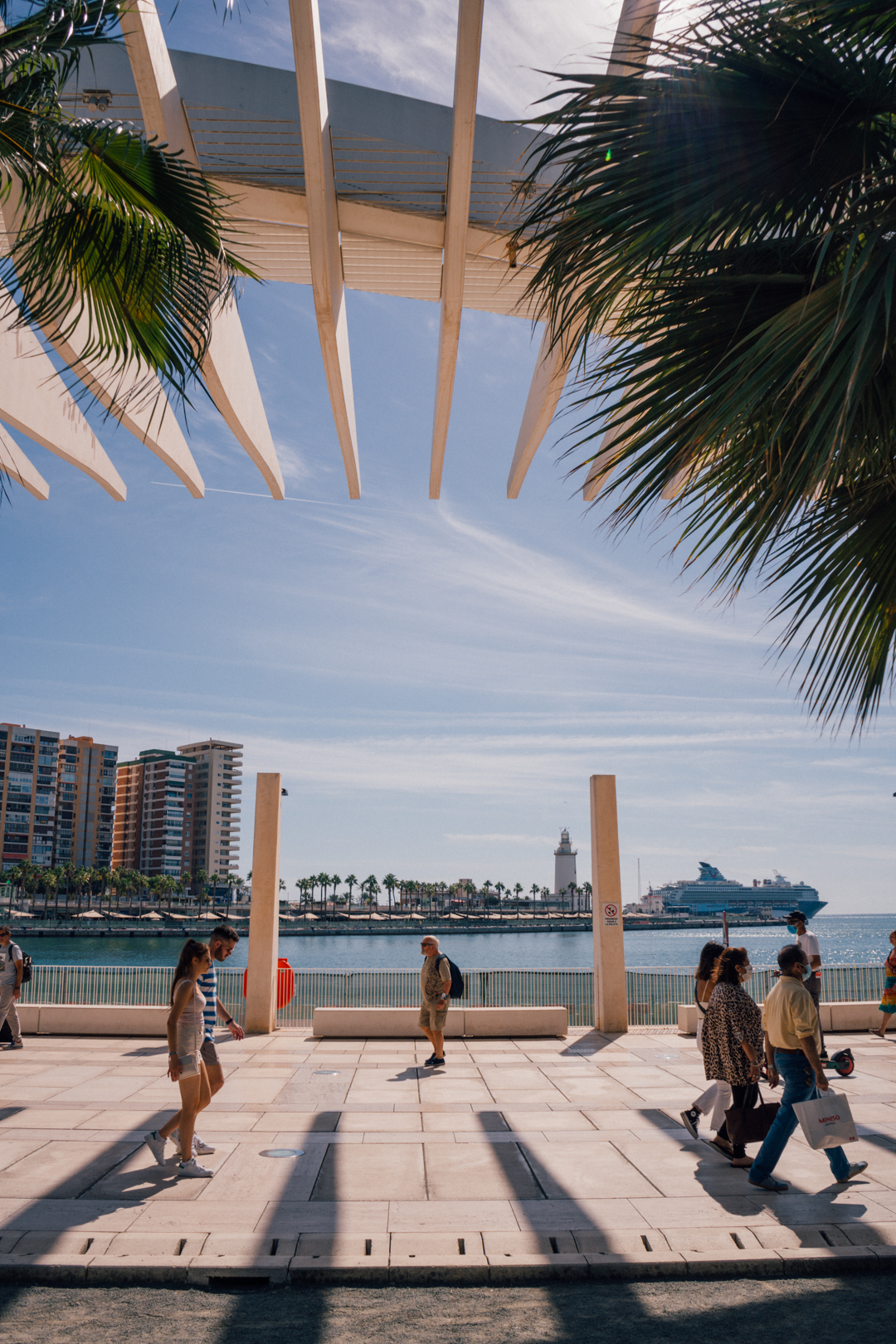
Destinations from Benalmadena
Benalmadena is a popular coastal destination not just for expats from Northern Europe and the UK, but also holidaymakers who enjoy almost year-long sunshine. Benalmadena is on the C-1 local suburban train line with a connection to Malaga, and has a selection of local buses to popular destinations on Costa del Sol.
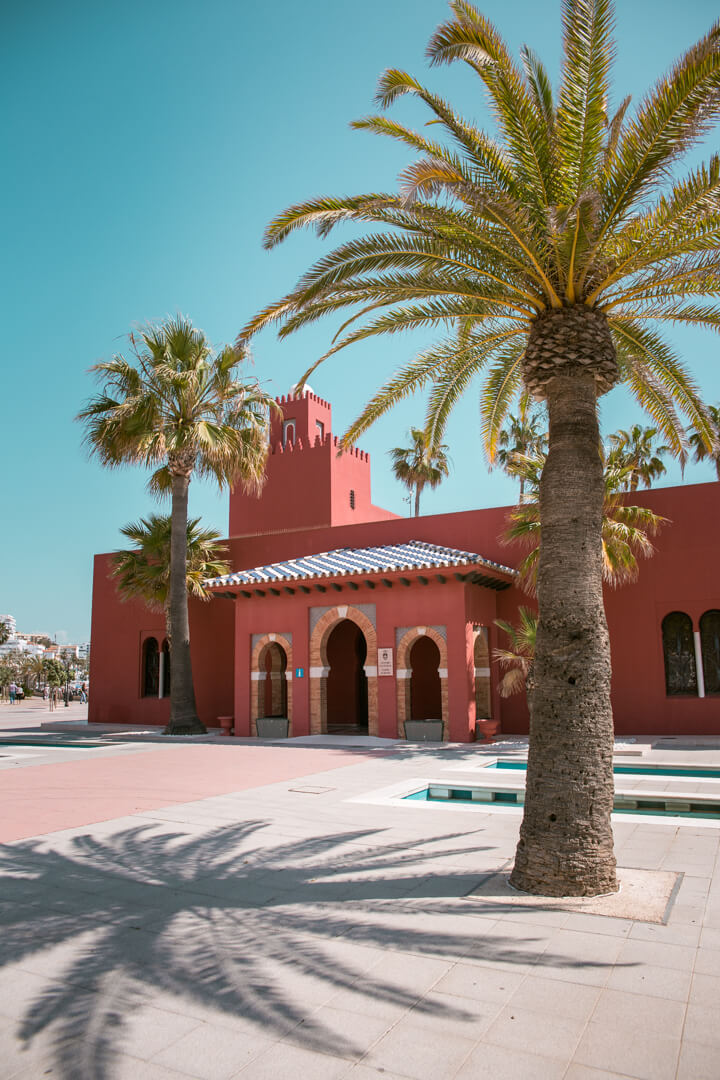
Benalmadena to Seville
Benalmadena to Fuengirola
Benalmadena to Marbella
Benalmadena to Ronda (coming soon)
Benalmadena to Torremolinos (coming soon)
Benalmadena to Gibraltar (coming soon)
Benalmadena to Puerto Banus (coming soon)
Benalmadena to Mijas (coming soon)
Benalmadena to Granada (coming soon)
Benalmadena to Cordoba (coming soon)
Destinations from Fuengirola
Fuengirola is home to the second biggest Finnish ex-pat community in Europe, and the main train station marks the end of the train line heading down south. Well-connected with Malaga and with regular bus service to towns in Southern Spain, it’s the perfect base for your holiday if you want to explore beyond the town itself.
Fuengirola to Gibraltar
Fuengirola to Seville
Fuengirola to Ronda (coming soon)
Fuengirola to Estepona (coming soon)
Fuengirola to Marbella
Fuengirola to Mijas (coming soon)
Fuengirola to Granada (coming soon)
Fuengirola to Cordoba (coming soon)
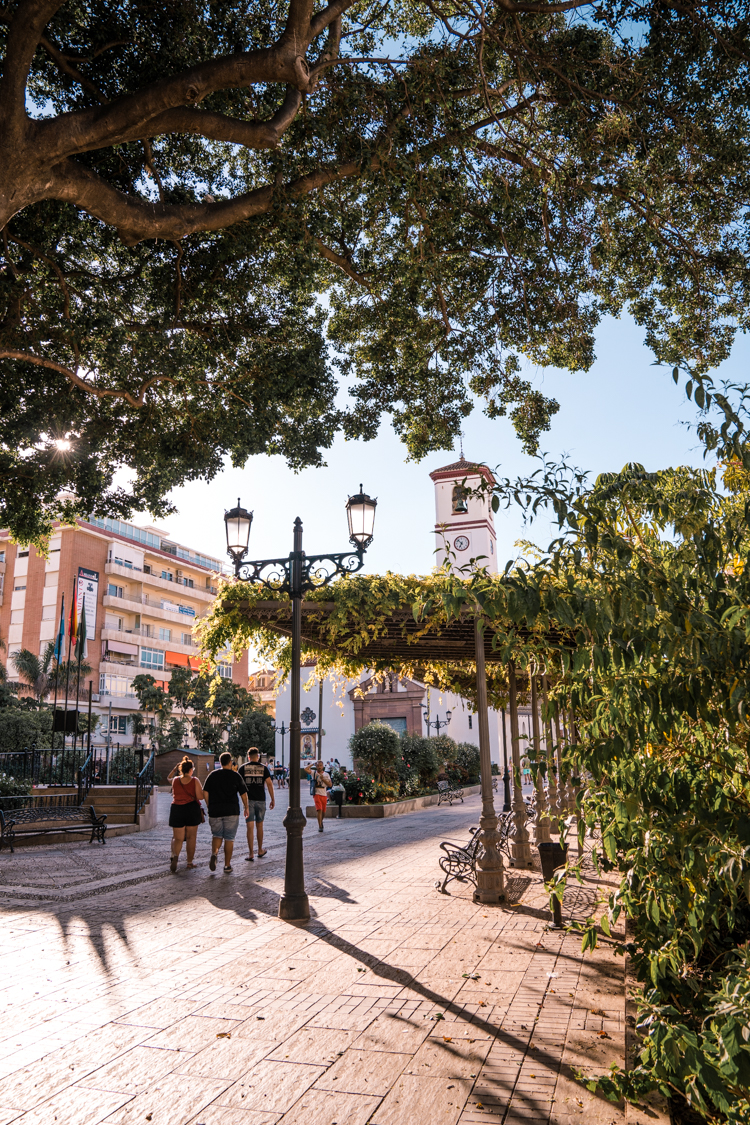
Destinations from Torremolinos
Known also as the ‘gay capital of Costa del Sol’, Torremolinos is connected with Malaga thanks to the C-1 suburban line and has a selection of local bus services that will allow you to explore beyond the town. It has a newly renovated train station with barrier-free access.
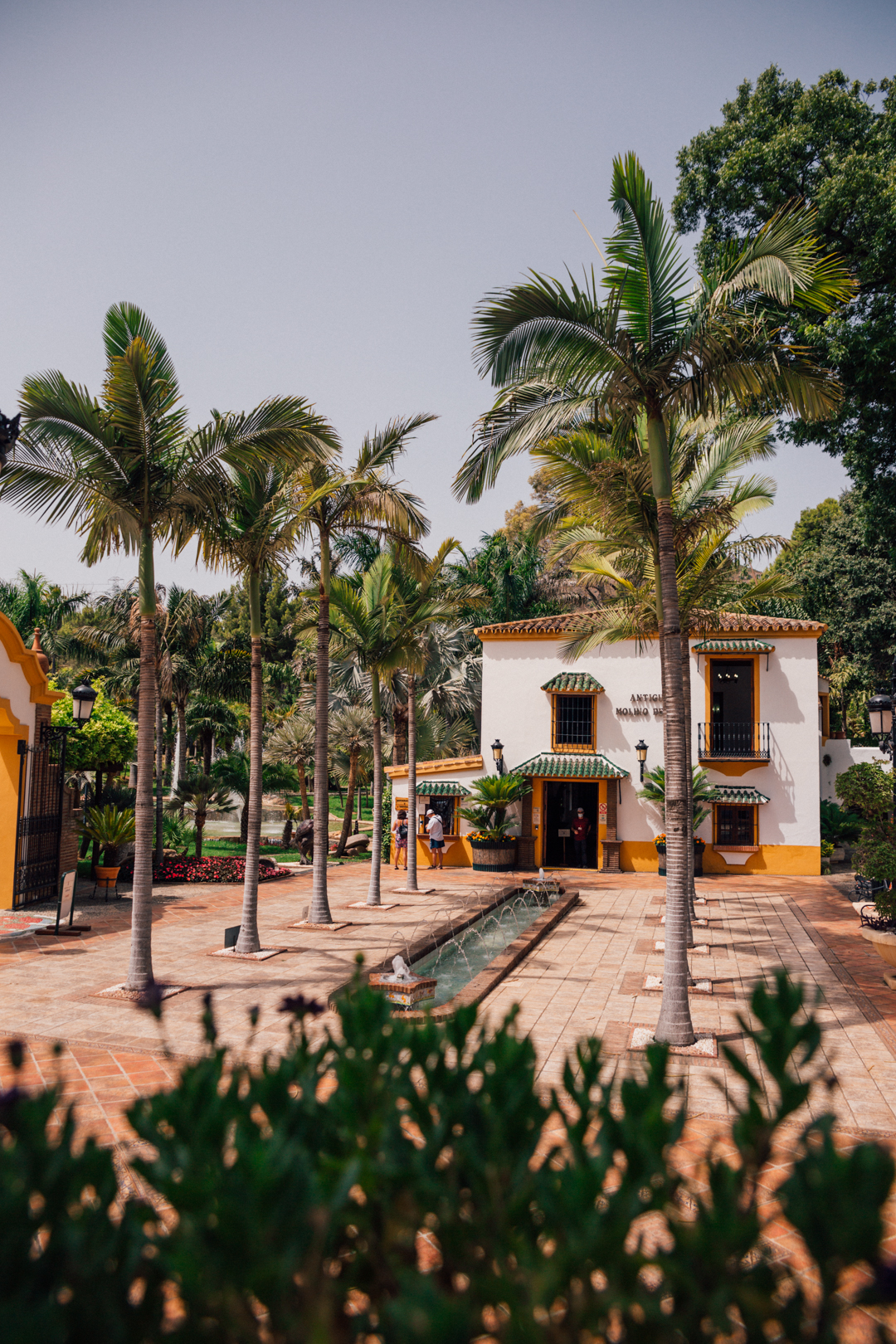
Torremolinos to Fuengirola
Torremolinos to Seville
Torremolinos to Marbella
Torremolinos to Granada (coming soon)
Torremolinos to Ronda (coming soon)
Toremolinos to Malaga (coming soon)
Torremolinos to Cordoba (comign soon)
Destinations from Marbella
Marbella counts itself among one of the flashiest and wealthiest resort towns on Costa del Sol. Unlike the previous destinations, it doesn’t have any train line connecting it to Malaga. Instead, there are regular bus services you can use to reach other destinations nearby, but also long-distance buses that go as far as Cadiz and Tarifa.
Marbella to Seville
Marbella to Gibraltar (coming soon)
Marbella to Estepona (coming soon)
Marbella to Malaga (coming soon)
Marbella to Cadiz (coming soon)
Marbella to Tarifa (coming soon)
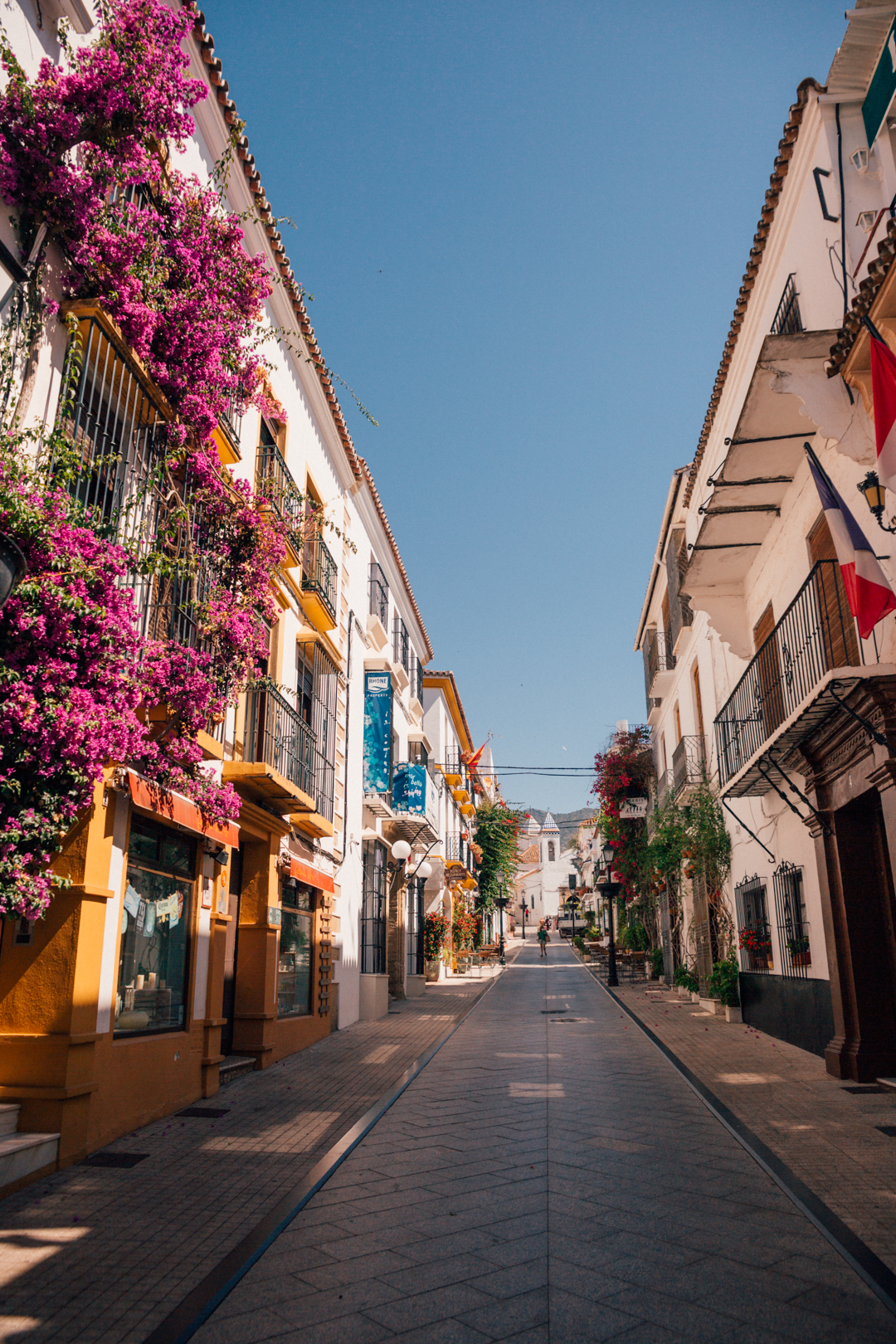
Destinations from Estepona
Estepona is another popular holiday destination thanks to the beautiful beaches and stunning holiday homes available. Same as Marbella, it has no train connections but a regular bus service that will allow you to explore further south of the town, and even reach the ‘UK borders’ in Gibraltar.
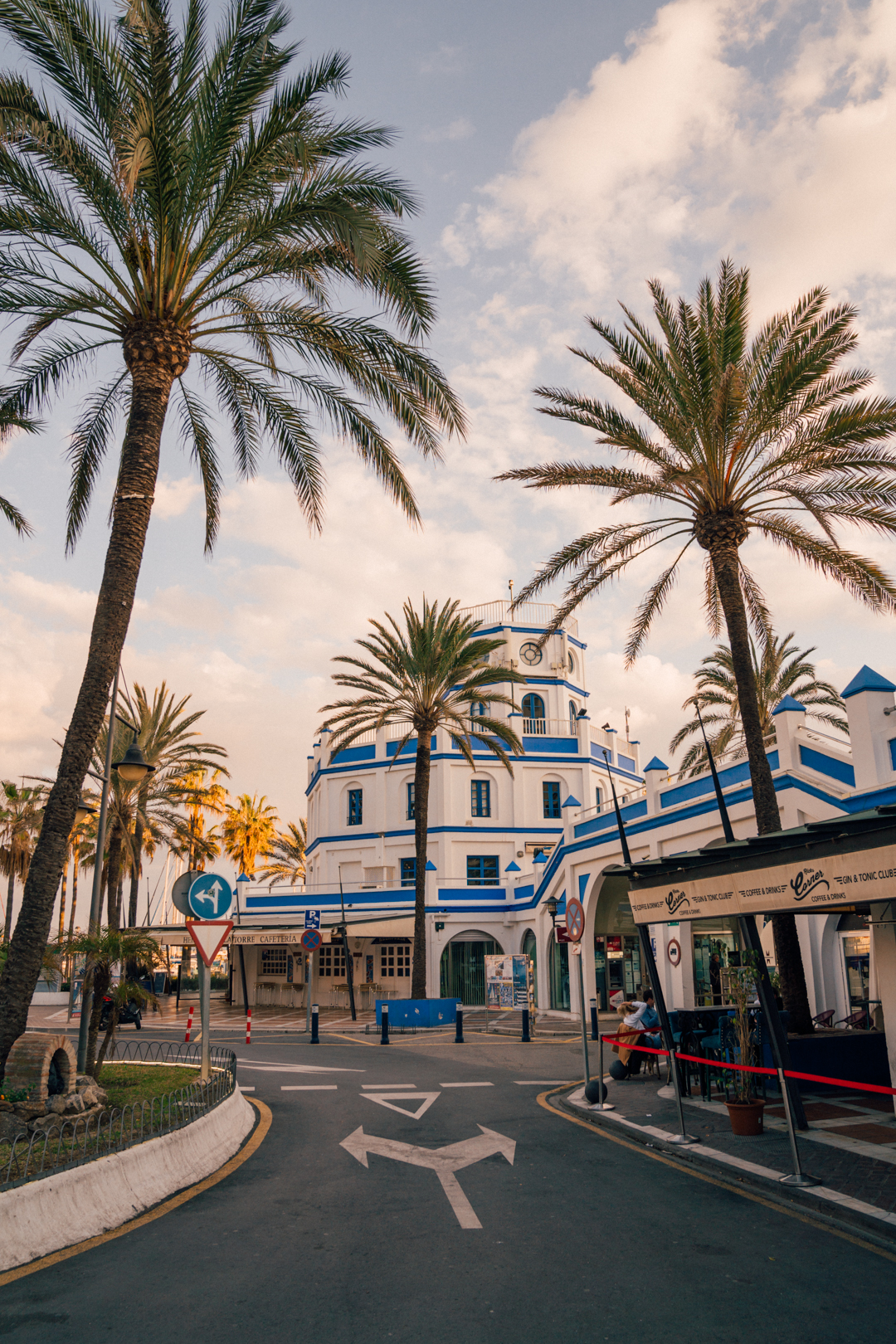
Estepona to Marbella
Gibraltar to Estepona

Useful Links
Spain trains: everything you need to know

Spain trains are a great way to get from one destination to another. In fact, Spanish trains are an increasingly cost-effective alternative to planes, particularly if you’re going a relatively short distance or if you’re traveling in the one of the high-speed long distance trains.
Nowadays several companies compete to offer the best train service of the country.
But which one suits better your travel plans?
Have a look at a complete guide on how to purchase your train tickets online .
Below you can find a list of all the railway companies operating in Spain and the routes that they cover.
Table of Contents
Railway companies operating in Spain
Who operates trains in Spain?
The deregulation of the railway sector has led to the different operators gaining access to the Spanish railway network. After decades of monopoly, the state-owned company Renfe Operadora competes with several private operators.
Here is a list of the current railway operators in Spain:
- Renfe . It’s the Spanish state rail operator, which until recently operated a monopoly in Spain. It also operates through Avlo , its low-cost subsidiary.
- OUIGO . It’s French SNCF’s low-cost service high-speed trains, offering long-distance services on core routes of the Spanish rail network.
- iryo . It’s operated by ILSA, which is part of a consortium made up of Spanish airline Air Nostrum, Globalvia (a Spanish multinational transport infrastructure company) and Italy’s main train operator Trenitalia.
Now… You may be asking yourself, which one is better?
Well, all of them are valid options. It’s just a matter of availability (as you’ll see below, Renfe still offers the widest range of routes) and price (Renfe tickets are still the most expensive ones).
So, do your research and compare fares here and there! And there’s a great site for that.
Purchase your train tickets online with the best booking platform.
Spain trains: high-speed long distance routes
With a 3,100km track network the Spanish high-speed trains operate on the longest high-speed network in Europe. Running at speeds of up to 310 km/h this extensive network allows for fast connections between cities in Spain.
As you can see, the central hub of the high-speed long distance routes in Madrid is the train station Puerta de Atocha , although other routes depart from Chamartín train station. In Barcelona these trains depart from the Barcelona Sants train station. And in Seville, they depart from Santa Justa train station.
Currently Renfe has the following AVE routes:
- Madrid Atocha – Calatayud- Zaragoza – Lleida – Tarragona – Barcelona – Girona – Figueres
- Madrid Atocha – Guadalajara – Calatayud – Zaragoza – Tardienta – Huesca
- Madrid Atocha – Ciudad Real – Puertollano – Córdoba – Sevilla
- Madrid Atocha – Ciudad Real – Puertollano – Córdoba – Puente Genil – Antequera – Loja – Granada
- Madrid Atocha – Ciudad Real – Puertollano – Córdoba – Puente Genil – Antequera – Málaga
- Madrid Atocha – Cuenca – Requena – Valencia – Castellón
- Madrid Atocha – Cuenca – Albacete – Villena – Alicante – Elche – Orihuela – Murcia
- Madrid Chamartín – Cuenca – Requena – Valencia
- Madrid Chamartín – Cuenca – Albacete – Villena – Alicante
- Madrid Chamartín – Segovia – Valladolid – Palencia – León
- Madrid Chamartín – Zamora – Ourense
- Barcelona – Tarragona – Lleida – Zaragoza – Ciudad Real – Puertollano – Córdoba – Antequera – Granada
- Barcelona – Tarragona – Lleida – Zaragoza – Ciudad Real – Córdoba – Antequera – Puente Genil – Antequera – Málaga
- Barcelona – Tarragona – Lleida – Zaragoza – Ciudad Real – Córdoba – Sevilla
- Valencia – Cuenca – Ciudad Real – Puertollano – Córdoba – Sevilla
- Valencia – Requena – Cuenca – Madrid Chamartín – Valladolid – Burgos
- Alicante – Albacete – Cuenca – Madrid Chamartín – Zamora – Ourense
- Alicante – Albacete – Cuenca – Madrid Chamartín – Valladolid – Palencia – León
Apart from AVE trains, Avlo is Renfe’s low-cost high-speed long-distance train service operating 5 long distance routes:
- Madrid Atocha – Guadalajara – Calatayud – Zaragoza – Lleida – Tarragona – Barcelona – Girona – Figueres
- Madrid Atocha – Ciudad Real – Puertollano – Villanueva de Córdoba – Córdoba – Sevilla
- Madrid Atocha – Ciudad Real – Puertollano – Villanueva de Córdoba – Córdoba – Puente Genil – Antequera Santa Ana – Málaga
In addition to this, Renfe has 2 other types of high speed trains:
- Avant trains travel at the same speed as AVE one, but they are designed for short trips to interconnect nearby destinations (e.g. from Madrid to Segovia, Valladolid, Cordoba, Sevilla, Toledo and from Barcelona to Zaragoza, Tarragona, Santiago, Girona).
- Alvia train services share the high speed lines with AVE trains, but then branch off in to conventional tracks, or continue beyond the end of the high speed lines, in order to reach their final destinations.
French SNCF’s low-cost high-speed OUIGO trains now operate on 3 routes:
- Madrid Atocha – Tarragona – Zaragoza – Barcelona
- Madrid Chamartín – Valencia
- Madrid Chamartín – Albacete – Alicante
OUIGO Spain services will gradually be extended to other high-speed lines in Spain.
iryo is the brand from railway operator ILSA. The company is jointly owned by Italy’s main train operator Trenitalia, Spanish airline Air Nostrum, and the infrastructure investment fund Globalvia.
It operates on the following routes:
- Madrid Atocha – Córdoba – Sevilla
- Madrid Atocha – Córdoba – Málaga
- Madrid Chamartín – Cuenca – Valencia
- Madrid Chamartín – Cuenca – Albacete – Alicante
They are also expected to run between other destinations in the near future.
Spain trains: Media Distancia routes
The Media Distancia (regional trains) and Avant trains cover the whole country and are solely operated by Renfe . These trains are also very modern and quite punctual but they are not as fast as the long distance ones.
This map shows you in detail all the routes network in Spain .
The following routes are currently available using the Avant trains:
- Avant Madrid – Segovia – Valladolid
- Avant Málaga – Córdoba – Seville
- Avant Madrid – Ciudad Real – Puertollano
- Avant Madrid – Toledo
- Avant Barcelona – Tarragona – Lleida
- Avant Calatayud – Zaragoza
- Avant Ourense – Santiago – A Coruña
- Avant Barcelona – Girona
- Avant Barcelona – Figueres Vilafant
- Avant Valencia – Requena Utiel
Spain trains: Cercanías routes
The Spain for commuter rail services or suburban trains are called Cercanías (or Rodalies in Barcelona).
Operating from many major cities, these local routes travel from main city center stations to suburbs and exurbs, and serve primarily to bring workers and students into city centers from more provincial areas. They either cover large cities (including Madrid , Barcelona , Bilbao, Seville and Valencia) or small regions (Asturias, Murcia).
These local trains are only operated by Renfe .
The following maps show you in detail all the routes corresponding to a certain geographical area of Spain:
- Murcia/Alicante
- San Sebastián
This article is part of a complete tutorial about train travel in Spain where you can read all the information you need to organize your train journeys around the country.
Here is a complete summary of all the guide:
1. Spain trains: everything you need to know 2. How to purchase Renfe train tickets online 3. 7 tricks to get cheap train tickets in Spain 4. Renfe: Spain’s state-owned railway company 5. AVE trains: Renfe high-speed trains in Spain 6. The Combinado Cercanías ticket 7. The Renfe Spain Pass 8. Avlo: Renfe’s high speed low cost trains 9. OUIGO trains: SNCF’s high speed low cost company 10. iryo: Spain’s low cost high-speed rail operator 11. 7 packing tips to comply with your train baggage allowance

Southern Spain Itinerary: 7 Days Without A Car (2024)
If you’re planning your Southern Spain itinerary, 7 days is the perfect time to get a taste of the region.
Having backpacked through Spain multiple times, Andalucia stands out as one of my favorite regions in this vibrant country.
I love the unique blend of cultures, vibrant cities, and the laid-back southern way of living.
Most people explore Andalucia on a road trip, but I traveled around Andalucia without a car. Public transport in Spain is great, and you can visit all the must-see places by train or bus!
If you’re ready to plan an itinerary for Southern Spain without a car, let’s jump right in!
Disclaimer: This post may contain affiliate links, which means I may receive a commission, at no extra cost to you, if you make a purchase through a link. I hope you find the information here helpful!
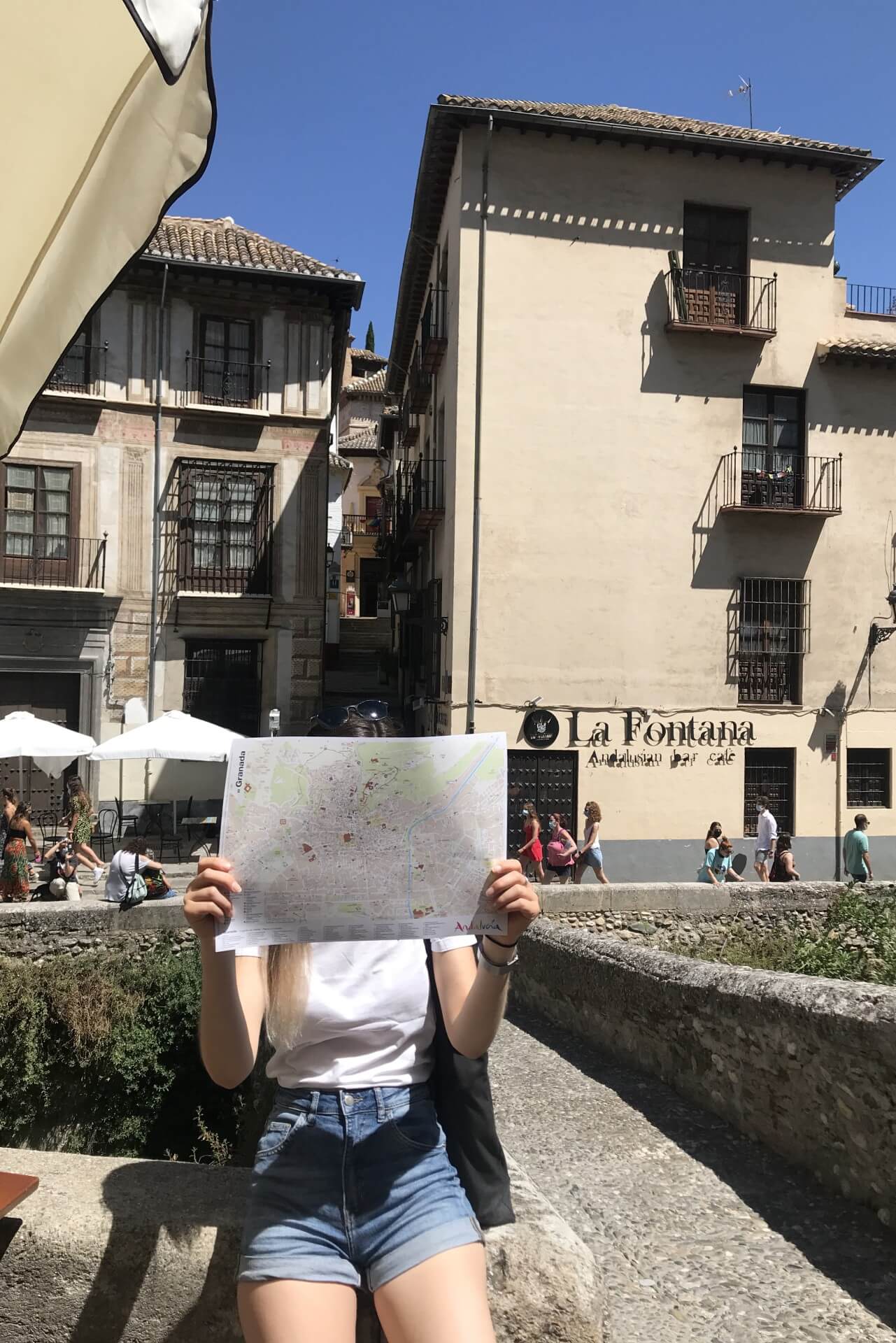
7 Days Southern Spain Itinerary At A Glance
Length : 7 days, 8 nights Start And End Point : Start in Sevilla, end in Malaga CIties To Visit : Sevilla, Cordoba, Granada, Malaga
- Day 1: Sevilla
- Day 2: Sevilla
Day 3: Cordoba
- Day 4: Granada
- Day 5: Granada
- Day 6: Malaga
- Day 7: Malaga
You could also do this itinerary the other way around, starting in Malaga and ending in Sevilla, or simply returning where you started from.
I took a train from Madrid to Sevilla on my backpacking Spain route, so that’s why I started from there.
Both Sevilla and Malaga have large international airports, so it is easy to organize your flights if you’re coming from Europe.
It takes less than 3 hours to travel between Malaga and Sevilla by bus or train, so it won’t impact your itinerary that much!
Day 1 And 2: Sevilla
You’ll start your Southern Spain trip from the vibrant city of Sevilla.
A must-visit in Andalucia, Sevilla perfectly encapsulates the essence of southern Spain and is an ideal starting point for your journey.
Sevilla is one of my favorite places in Spain and a place I would visit again and again on a short city break.
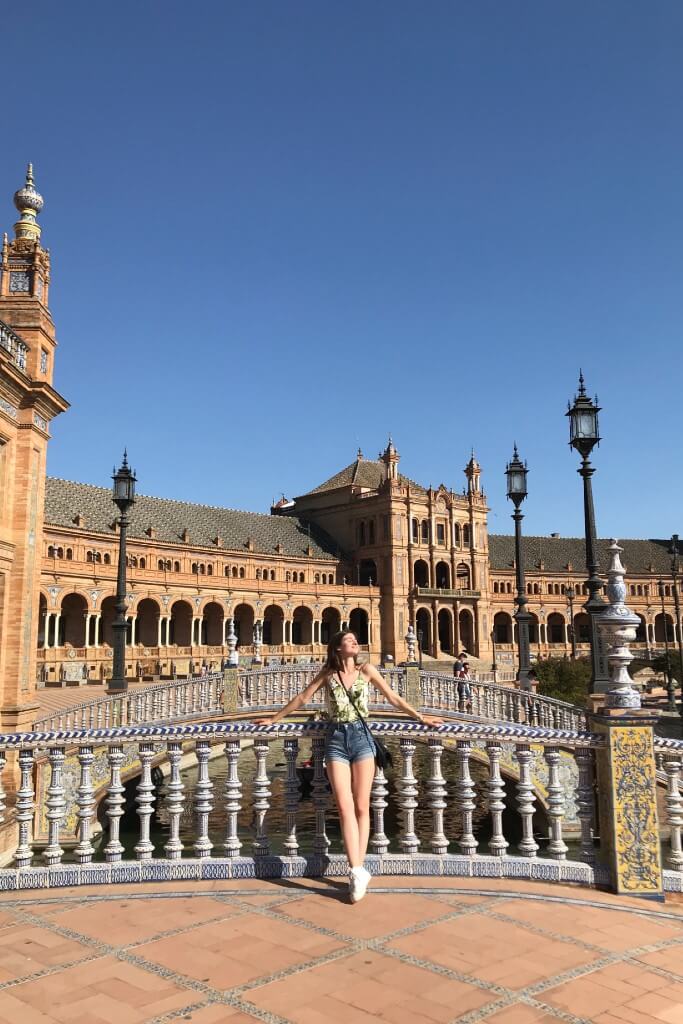
Best Things To Do In Sevilla, Andalucia
- Plaza de Espana
- The Real Alcázar de Sevilla
- Santa Cruz neighborhood
Start your day in Sevilla by exploring the city center.
Sevilla is a city where you can wander the streets, immersing yourself in its enchanting surroundings.
The most picturesque area is the narrow cobblestone streets of the Santa Cruz neighborhood.
Places you should not miss are Plaza de Espana , the largest Gothic Cathedral, and The Real Alcázar de Sevilla – both UNESCO World Heritage Sites !
You will want to book the Alcázar tour and Sevilla Cathedral tickets in advance, as both attractions get very busy in the high season!
The modern installation of Setas de Sevilla is a fun spot to visit, particularly popular for watching the sunset.
See Flamenco in Sevilla
When I think of Andalucia, I think of flamenco.
Sevilla is known as a home to flamenco, and I was expecting to run into people dancing on the street all the time.
The truth is most of the shows are private and you have to book in advance.
You can book your ticket for the best-rated Flamenco show in Sevilla here !
If you are on a budget, don’t despair – you can see flamenco for free in a couple of places !
One of them is at Plaza de Espagna . There, you will find people doing a free show for tips.
The second one is La Carboneria . I highly recommend you check it out, take a drink, and enjoy flamenco.
The place is very relaxed, and the drinks are cheap. It is truly a hidden gem in Sevilla, and it is a great place to discover Sevilla’s nightlife as a solo female traveler.
💃🏽 Book Flamenco Show In Seville!
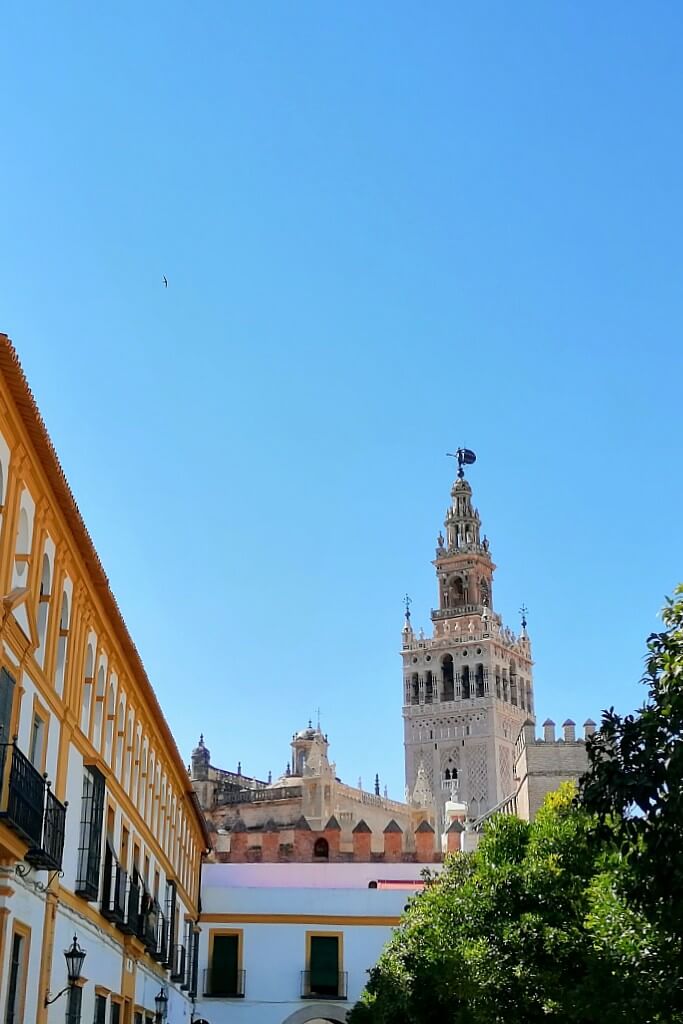
Where To Stay In Sevilla
Budget options.
Onefam Catedral is the best backpacker hostel in Sevilla.
It is located in the heart of Santa Cruz and they organize activities so you can meet other travelers.
I stayed in The Nomad hostel in Sevilla, as the first one was fully booked when I visited.
The hostel is centrally located, and it is affordable and comfortable. There was a rooftop bar, a communal kitchen, and a living room, making it a great hostel to meet other backpackers !
Splurge Option
It doesn’t get much better than Hotel Casa del Poeta .
This hotel with a rooftop pool in the heart of Sevilla will transport you back in time and make you feel like Andalucian royalty!
Vegan Restaurants In Sevilla
There are quite a few restaurants with vegan options in Sevilla. As always, use the Happy Cow app to find vegan options.
With a whopping 96 restaurants offering vegan options in Sevilla, you practically don’t have to worry about the food.
I visited two restaurants on this trip.
- The first one is Veganitessen . It is a fully vegan restaurant located inside the market with an interesting menu.
- The other place is Milk Away . They had vegan options, but it is not a fully vegan restaurant, and it was more like a “healthy food” spot for days when you feel like you need to be more healthy on the road!

The next stop on our backpacking Andalucia itinerary is Cordoba.
Many people choose to visit Cordoba on a day trip from Sevilla. However, I feel like it deserves a whole day.
You can take a bus from Sevilla to Cordoba. The bus ride was about 45 minutes. You could also take a train, but the bus was cheaper and it takes about the same time anyway.
Compare the prices and book your ticket from Sevilla to Cordoba here !
Best Things To Do In Cordoba, Andalucia
- Mezquita Cathedral de Cordoba
- Flower Patios
- Puente Romano Bridge
The main sight in Cordoba is a UNESCO World Heritage Site : Mezquita Cathedral de Cordoba .
I loved exploring the old town of Cordoba, with its charming cobblestone streets feels like getting lost in time.
Walk along the river across the Puente Romano bridge, and then back to the city. This route is especially charming at night when the city walls light up.
A fun fact about Cordoba is that people take really good care of their patios, so you can enjoy some pretty flowers as well.
Flower pots on the walls are somewhat of a symbol of the city as well.

Where To Stay In Cordoba
I stayed in Pension Internacional.
I shared a private room with a bathroom with a friend, which ended up being cheaper than staying in a hostel. The Pension was centrally located, and it had air conditioning.
Vegan Restaurants In Cordoba
According to the Happy Cow app, there are currently no fully vegan or vegetarian restaurants in Cordoba.
However, there are a couple of restaurants with vegan options.
As it was already my third day in the region, I wanted to try some accidentally vegan Andalucian food.
One of them was Salamorejo . It is an accidentally vegan tomato and bread soup that they usually top with some non-vegan toppings, so you have to ask them not to put it.
I had salamorejo soup in Taberna San Miguel Casa el Pisto and it was delicious!

Day 4 And 5: Granada
From Cordoba, you will take a 3-hour bus to Granada.
You could also take a train, but the bus was cheaper, and there was no significant difference in the duration of the trip.
Compare the prices and book your ticket from Cordoba to Granada here !
Best Things To Do In Granada, Andalucia
- Alhambra of Granada
- Albayzin neighborhood
- Hiking in the Sierra Nevada
The main tourist attraction is Alhambra of Granada. It is incredible and it should not be missed.
Alhambra is a popular site, so you need to book the tickets in advance, and you are only allowed to enter at the time indicated on your ticket.
You do not need to book a guided tour if that’s not your thing, you can simply just get an Alhambra entrance ticket .
If all non-guided tickets are sold out for the day you’re visiting, booking this guided Alhambra tour is an excellent way around it.
However, there’s more to Granada than just Alhambra. The architecture in the city is one of the prime examples of Islamic influence in the region.
Albayzin neighborhood, the medieval Moorish district, is the most picturesque quarter in Granada. It is very characteristic and great for getting lost in the streets.
I stumbled upon a girl playing guitar and singing on one of the streets, and ti was such a great atmosphere as more people gathered to listen.
If you appreciate a good viewpoint as much as I do, the best spot to watch the sunset is Mirador de San Nicolas.
Hiking in Granada, Sierra Nevada
If you like hiking, you should consider staying longer than two days in Granada.
Granada is the best base for hikes in the Sierra Nevada mountain region.
There are a couple of hikes that can be done using public transport. I suggest you check out this guide on Hikes accessible by public transport to see your options!
Join A Hiking Tour In Sierra Nevada!
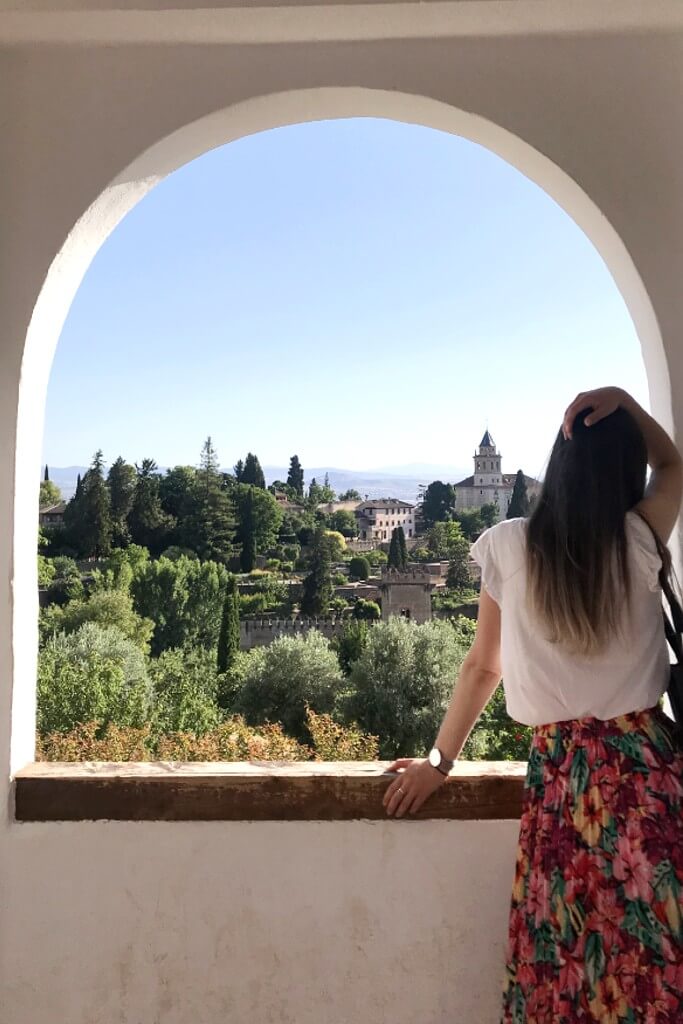
Where To Stay In Granada
El Granado Hostel is the best backpacker hostel in Granada.
Alternatively, you can go for a family-run accommodation like Casa Vestali .
I stayed in one with a friend, as it was cheaper for us to book a private room than two hostel beds.
Vegan Restaurants In Granada
After no vegan restaurants in Cordoba, I was worried about the situation in Granada. However, Granada is a great destination for vegans and there were so many options.
The Happy Cow app showed almost 70 places with at least vegan options, so I checked out a couple of places.
- Papas Elvira is a small place but with many vegan options. I tried empanadas, because I have never had them before, and they were tasty!
- The Good Burger chain had a vegan burger option. However, the burger was overpriced and tiny. I would not recommend it.
- Wild Food r estaurant offers a fine dining experience. I tried several of their cakes, and they were amazing! Highly recommended!
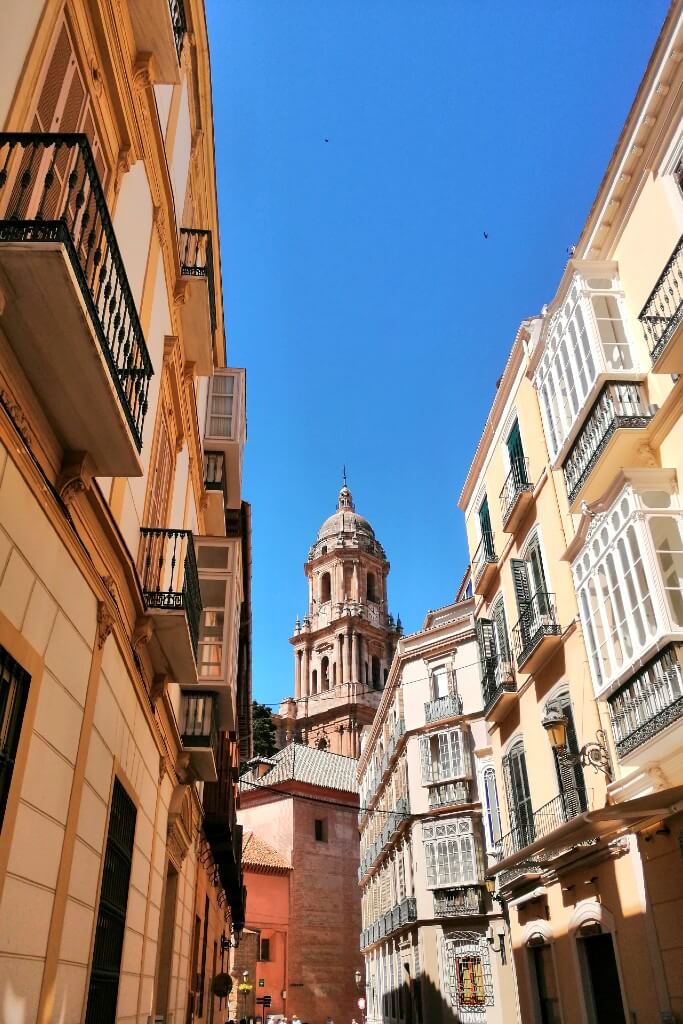
Day 6 And 7: Malaga
You’ll finish your South of Spain itinerary with a visit to Malaga.
You can see all the main tourist attractions in Malaga in 1 day, and the second day you can spend enjoying Costa del Sol beaches or going for a hike!
Best Things To Do In Malaga, Andalucia
- Alcazaba and Gibralfaro Castle
- Picasso Museum
- Caminito del Rey
Malaga is the birthplace of the famous artist Picasso, so if you like art, you have to visit the Picasso Museum.
If you are on a budget Malaga Museum is free, and you can see some of Picasso’s art there!
I suggest hiking up to Mirador de Gibralfaro. It is a great viewpoint to see the whole of Malaga.
Malaga is a great base to explore the rest of Costa del Sol, so that is what I am going to suggest to you.
Beaches In Malaga
I must be honest, I did not like Playa de la Malagueta too much. It was too close to the large port for my liking.
However, I am from a small coastal town in Croatia, so I have quite high standards for beaches.
Still, if you are staying in Malaga you could easily do a day trip to some of the smaller towns with better beaches. They are not the cheapest European beach towns , but they are not super expensive either!
Some of the best beaches near Malaga are in Nerja.
Day Trips From Malaga
Malaga is a great base for day trips. With 2 days in Malaga, you can go on a day trip to Ronda or Caminito del Rey.
If you want to do the Caminito del Rey hike, be sure to book it in advance.
I tried booking a week before I was supposed to be in Malaga, and all the good entrance slots were already booked. I was not willing to hike at 14h in 30 degrees heat.
If you don’t have a car, the simplest way to get to Caminito del Rey is to join the Caminito del Rey bus tour from Malaga .
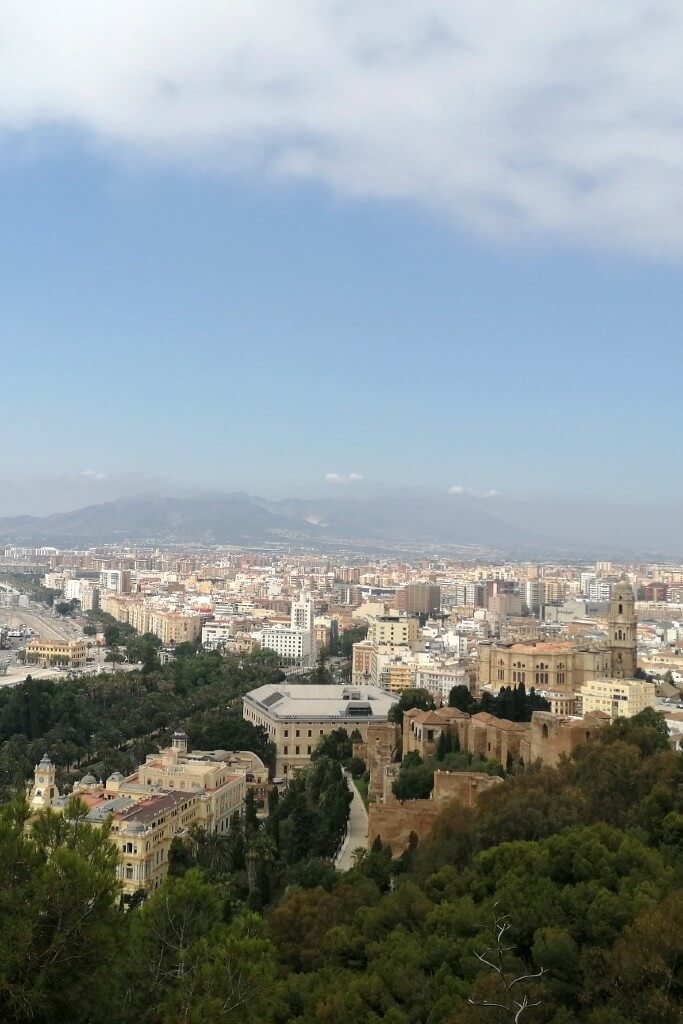
Where To Stay In Malaga
I stayed in two different hostels in Malaga.
The first one I would not recommend. Therefore, I will not link it. I will use this opportunity to remind you to read the reviews.
The second hostel I stayed at was The Urban Jungle Hostel . The hostel had a cool rooftop bar and great location, but there was no kitchen and the bathrooms didn’t have a proper door.
Vegan Restaurants In Malaga, Spain
Malaga is a big city. Therefore, there were many vegan options. Happy Cow said almost 80 places with at least vegan options.
Yet, sometimes when faced with many choices, we tend to make mistakes. Therefore, I only have two places to recommend out of those I tried out.
- Recyclo Bike Cafe had a couple of nice, vegan lunch options that were pretty affordable.
- Restaurante Japones Udon Malaga had a couple of vegan dishes on their menu, including a delicious Udon dish!
More Places To Visit In Andalucia
If you have more time to spend exploring Andalucia, there are a couple of destinations that I would put on the itinerary.
- Cadiz is a beachside town famous for surfing and its history.
- Gibraltar is feasible as a day trip from Malaga and you can add a visit to another “country” to your list.
- Ronda is quite an impressive town, and also one of the day trips I would consider taking from Malaga.
- Pueblos Blancos , the whitewashed villages are a fun day trip if you rent a car in Andalucia .

How To Get Around Andalucia Without A Car
You don’t need to rent a car when visiting the South of Spain.
Spain is one of the best European countries for backpackers , and Andalucia is well connected by an extensive network of buses and trains.
It is possible to reach virtually every notable tourist destination by reliable public transport, which is perfect for backpacking Andalucia on a budget.
You can book your tickets online or at the stations, and I suggest you do it in advance because the prices get higher closer to the travel date.
I use this website to book and compare bus and train tickets between different operators, to make sure that I’m getting the best deal!
Budget For One Week In Andalucia
Andalucia is not one of the most expensive areas in Europe , but it is not as cheap as Eastern Europe.
Your budget will mainly depend on when you decide to visit since the prices tend to fluctuate seasonally.
The currency in Spain is the euro.
I budgeted around 50 – 70€ per day for backpacking Andalucia in the summer.
That covered accommodation in hostels and pensions (it is like a budget version of a hotel, usually run by a family), food, transportation, entry tickets, and free walking tours.
Depending on your travel style, it might be higher or lower.
Is Andalucia Safe For Solo Female Travellers?
I felt as safe in Andalucia as in any other European country. That means as long as you keep an average level of awareness, you should be fine.
Pickpocketing is common in big cities, so keep an eye on your valuables. It is safe to walk around with your camera and a phone out because everybody does that.
I felt safe walking around at night since the streets were busy until late evening.
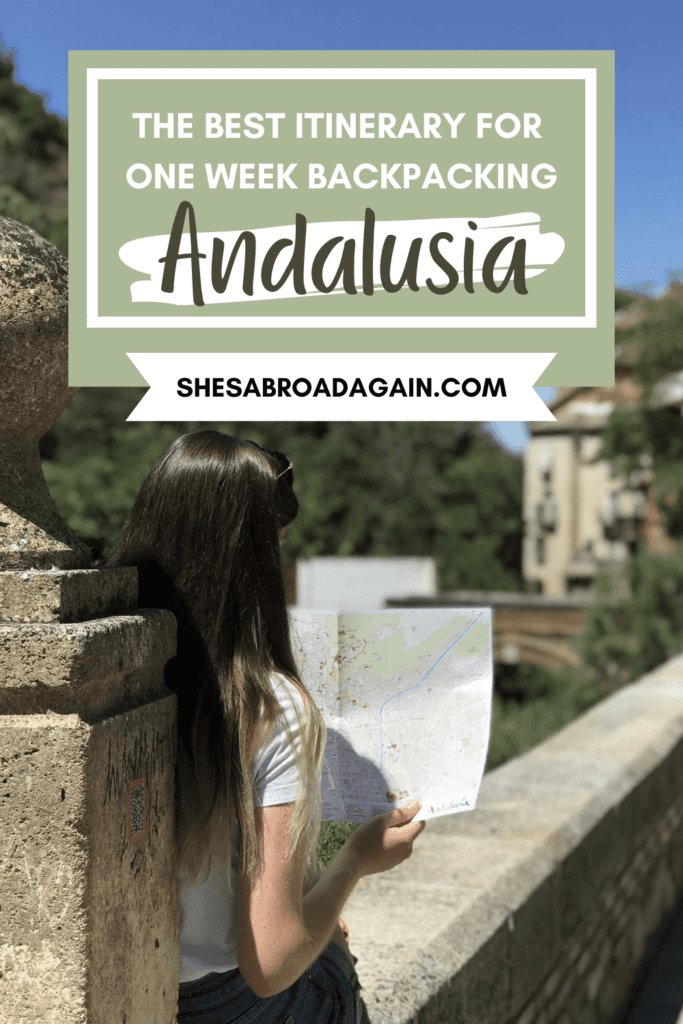
Summary: Andalucia Itinerary 7 Days
This 7 day Southern Spain itinerary covers all the must-see spots in Andalucia – from colorful Sevilla to magical Alhambra and sandy beaches along Costa del Sol.
However, it still gives you the flexibility to spend more or less time at each destination and add other places to the itinerary.
Day trips to Gibraltar, surfing in Tavira, or picturesque Pueblos Blancos are more fun experiences to consider when backpacking Andalucia .
I’m sure I’ll be back in Andalucia, as there are still places on my Andalucia wish list that I want to visit.
Natali is the founder of She's Abroad Again. She is a solo female travel and backpacking expert who traveled to more than 30 country over 3 continents, mostly solo and on a budget! She is a lawyer turned travel blogger as she traded long office hours in Croatia for a digital nomad life and currenly calls France her home.
Similar Posts
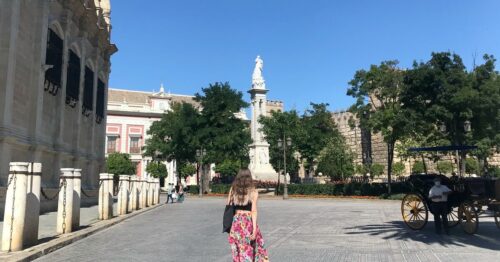
Backpacking Andalucia On A Budget (2024)
Are you wondering about backpacking Andalucia? That’s a fantastic idea! Spain is one of my favorite countries to travel! The region of Andalucia is the most vibrant region of Spain,…
Leave a Reply Cancel reply
Your email address will not be published. Required fields are marked *
Save my name, email, and website in this browser for the next time I comment.

Train Travel in Spain: A Helpful Guide
By: Author Hannah Cooper
Posted on Last updated: January 19, 2024

Train travel in Spain is an environmentally friendly, cost-effective, and scenic means of getting around this huge country.
Operated by Renfe, the train system in Spain is sophisticated and efficient. It links major Spanish cities with smaller towns inland and on the coasts of Spain. You can rely on Spanish trains to get you from city to city as part of a wider travel itinerary as well as for independent day trips from Alicante , Málaga , Valencia , Seville , Barcelona , and more.
This guide is a window into what you need to know about traveling by train and how to buy train tickets in Spain.
All you need to know about train travel in Spain
Renfe (pronounced Ren-fay) is responsible for the national train system in Spain. The company operates mainline, regional, suburban, and local trains across the country.
High-speed AVE (Alta Velocidad Española) are specific trains that service major cities such as Madrid, Barcelona, Valencia, Malaga, and Seville in a fraction of the time it takes by road. AVE trains reach maximum speeds of 300 km/h (186 mph).
Avlo trains are low-cost high-speed services. These have fewer onboard frills that save passengers money but journey times are on par with AVE trains.
Several other providers operate within the Renfe umbrella. Renfe Feve serves northern Spain and FGC operates around Barcelona.
Visit OpenRailwayMap to view all railway routes.
There are so many modes of transportation around Spain, but train travel is one of the most comfortable and convenient.
What’s it like traveling by train in Spain?
Trains in Spain are very comfortable and modern with onboard bathrooms and air-conditioning. High-speed AVE trains usually have Wi-Fi although it’s not always guaranteed that it will work throughout the entire route. It’s wise to use a VPN to protect yourself against cyber threats.
Seats are sold as per Standard Class (2nd class) and Comfort Class (1st class).
Básico (Basic) is the cheapest fare available and applies only to Standard Class.
Elige (Choice) is a semi-flexible ticket and gives you a choice of Elige Standard Class or Elige Confort in Comfort Class.
Premium is totally flexible and is available in Comfort Class. It often involves other perks such as onboard dining and/or lounge access.
Seats are generally configured as airline rows of twos or as four-person table seats. First-class carriages have the added perk of solo seating for those traveling alone.
Standard classes are comfortable for the average traveler although first-class train travel in Spain has additional legroom.
Most regional Spain trains are equipped with a cafe bar where you can buy food and drink. It’s fine to take your own food which was purchased elsewhere onboard. Alcohol is permitted on trains but rowdy behavior is not.
Valencia has two different train stations depending on whether you are traveling locally or further afield on the fast trains.
How to buy train tickets in Spain
The best way to book train travel in Spain is online. Omio and Trainline are the safest and most user-friendly websites for booking rail tickets in Spain. You’re required to register an account and will need to type in your passport number as part of the booking process.
These platforms have apps where you can store mobile tickets and keep an eye on service interruptions. Subject to availability, you’ll be able to state a preference for window/aisle seating. The classes may be listed differently than stated earlier but it’s easy to figure out what you’re getting with each tier.
They list prices in different currencies and accept most foreign credit and debit cards. Both sites apply a minimal service charge to your booking.
Omio is preferred for booking rail tickets in Spain. It displays more information about what to expect onboard, such as Wi-Fi and meal availability.
It’s important to pay attention to the terms and conditions regarding validity. Most tickets are valid on the selected train and refunds/amendments are not possible until you pay extra at the time of booking.
Of course, if the service is canceled then you will either be assigned to the next available train at no additional cost or receive a refund.
It’s also possible to book Spain train travel directly on Renfe . This website lists the fares in euros and as an added perk, does not apply a service fee. However, it’s cumbersome to use.
You must use the Spanish names of each city (and spell them correctly). The Spanish-English translation isn’t always very clear. The site doesn’t always accept non-Spanish payment cards.
It is, however, the best website to check for train times and to compare prices. But often, you can get a better price on Omio or Trainline , even with the small transaction fee applied. Compare each website to see which is offering the best deal.
It’s worth having a quick look at the schedules but heading to Omio and Trainline to make a reservation. Besides, these sites are easier to search using the standard English-language spellings of Spanish locations.
Trains in Spain can take you to some pretty spectacular places.
When to book train travel in Spain
Practically all Spain trains require a seat reservation. These are free and mean there’s no chance of spending the journey dangling over other passengers in the aisle (a far cry from the sardine-style approach of British trains).
Due to this rule, booking rail tickets in Spain ahead of travel time is often mandatory.
Long-distance and high-speed train travel in Spain always requires advanced booking. This is crucial during summer as well as peak times such as Christmas, New Year, and Easter when Spanish nationals are visiting friends and family.
It’s also wise to check out regional and local festivals in Spain as this can result in certain routes being oversubscribed.
Booking train tickets in Spain ahead of time is also much cheaper. You can save over half the full-price fare when you plan ahead by a few weeks or more.
Shorter journeys of an hour or less generally don’t require notice and can be booked on the day. That being said, it’s always wise to pre-book, especially during peak travel seasons and if you’re on a commuter journey (like Barcelona to Girona , for example).
Trains in Spain are usually open for booking 60 days in advance. AVE services may open up to 90 days ahead.
There is a confusing number of train stations in Barcelona, but most long-distance trains will go through Barcelona Sants.
A quick guide to Barcelona-Sants Train Station
Barcelona-Sants (Sants Estación) is the main and largest railway station in Barcelona. It’ll never win any awards for its architecture but it functions well as a travel depot.
Sants is located in the Sants-Montjuïc district.
It’s connected to the Sants Estació metro station which is served by lines 3 (green) and 5 (blue). Line 3 heads to the Gothic Quarter and Plaça de Catalunya.
It’s also possible to hail taxis from the forecourt or use apps. Consult our guide to Uber in Barcelona and alternative services.
Platforms 1-6 receive TGV services to and from Paris and AVE high-speed trains to and from Madrid, Seville, and Málaga, as well as other French cities. This is also where to go for Alvia trains to San Sebastian and Bilbao in northern Spain.
Platforms 7-14 are used for suburban trains and EuroMed services to Valencia and Alicante.
There are several day trips from Barcelona possible by train. Note that not all of these depart from Barcelona-Sants so it’s important to check.
Espanya, Plaça de Catalunya, Francia, and Passeig de Gràcia are other major train stations in Barcelona.
Where to stay near Barcelona-Sants
Hotel Barceló Sants is located within the terminal. There are better areas to stay as part of a longer travel itinerary in Barcelona although it’s handy if you have an early arrival or late departure. Rooms are ultra-modern and practically equipped. The best ones have city views.
The Madrid Atocha Train Station is probably my favorite station in Spain thanks to the tropical garden inside.
A quick guide to Madrid Atocha Train Station
Madrid Atocha Train Station (Madrid Estación de Atocha) is the main railway terminal in the Spanish capital. In complete contrast to Barcelona-Sants, this trainshed is an architectural masterpiece.
The art nouveau facade is simple yet majestic and almost perfectly symmetrical. The concourse houses an indoor “rainforest” of around 400 different species of plants and flora. Considering the green nature of Madrid it’s very fitting, and also a welcome treat during the arid summer months.
Madrid’s train station is located in its namesake Atocha neighborhood, just off the southern end of El Retiro Park and the botanical garden.
It connects to two metro stations: Estación Del Arte and Estación Atocha. Both are served by Line 1 (blue).
Most high-speed trains depart from platforms 1-15. This extended part of the station is known as Madrid Puerta de Atocha (or, Madrid-Puerta de Atocha-Almudena Grandes).
Madrid Atocha-Cercanías is a separate area with platforms labeled 1-10. Cercanías means commuter and indicates that suburban services arrive and depart from here. This route map of Cercanías Madrid is useful for getting around the suburban areas.
Tickets will specify which part of the station your train departs from. Omio makes it very clear ahead of booking although Trainline doesn’t confirm which station you’ll be using until the confirmation email is sent.
Departures marked as Planta Primera means that the train leaves from the upper level. Planta Baja refers to the ground floor.
Madrid Chamartin (Estación de Madrid-Chamartín Clara Campoamor) is the other train station. It’s located eight miles north of Atocha and somewhat far from the city center.
This station serves connections to the north – such as San Sebastian, Bilbao, Santander, and Santiago de Compostela. It’s also the cheapest place to get the fast train to Valencia , so you may very well find yourself here. You can get here easily on the metro.
Every northbound Cercanías train from Atocha stops at Chamartin.
Where to stay near Madrid Atocha
Only YOU Hotel Atocha is so close you can practically smell the succulents! Rooms feature cool decor like exposed brick walls and vintage-inspired desks. Top-tier rooms have balconies and their suites may tempt you to blow your life savings.
Seeing as Atocha is quite central, you can also check out accommodation in some of the best areas to stay in Madrid . Lavapiés and Retiro are worthy contenders.
There are a lot of regional trains in cities like Barcelona, Valencia, and Madrid that can take you on great day trips.
Interrail Spanish train travel
Interrail passes are available for use on Spain trains.
The Interrail Spain One Country Pass is valid for European citizens and residents. It comes as a three, four, five, six, and eight-day flexi pass. Seat reservations are required for high-speed, international, and night train services.
The Global Pass is also available as a flexi or continuous pass for Europeans.
Eurail passes are available for non-Europeans.
For both passes you will need to make sure that you book your
Traveling Spain by train versus rental car?
Traveling by train in Spain or renting a car? The pros and cons of train travel and hiring a car in Spain are listed below.
Before we get there – you could always consider a hybrid approach. It might make sense to cover greater distances by train (such as Madrid to Barcelona) and then hire a car locally.
Pros of train travel in Spain
- Spanish train travel is kinder to the environment than driving or taking short-haul flights
- Booking train tickets in Spain is straightforward with Omio / Trainline
- The train system in Spain is well-connected and efficient
- No need to worry about parking a hire vehicle
- Spanish trains are comfortable and maintained
- Train travel in Spain means you can catch up on work, trip planning, or indulge in relaxation time
- Pets are permitted on most routes although terms and conditions apply
Cons of Spain train travel
- Can be expensive when tickets are not reserved in advance
- Cheaper fares are non-transferable
- Booking rail tickets in Spain last minute isn’t always possible
- Antisocial behavior on public transport is always a risk
- Trains aren’t always comfortable for travelers with babies and younger children
- Pets aren’t permitted on all trains
The fast trains in Spain are sleek and comfortable. Getting from Madrid to Valencia in under two hours is one of my favorite (and most frequented) journies.
Pros of renting a car in Spain
- Allows more flexibility to an itinerary
- Greater opportunities to travel beyond classic vacation destinations in Spain
- Road conditions in Spain are exemplary
- More comfortable for families with young children
- Driving in Spain is awesome for US folks – they drive on the right!
Cons of car hire in Spain
- It can be expensive – especially for solo travelers or if an accident occurs
- Petrol costs need to be included in your budget
- Not eligible for lead drivers under the age of 21
- Younger drivers (under the age of 25) might have to pay a surcharge
- Driving in Spain is less awesome for Brits – remember to drive on the right!
The Madrid Atocha station is well connected so if you arrive in Madrid, you can get almost anywhere in Spain from this station.
Packing checklist for Spain train travel
Once you’ve committed to traveling by train in Spain, it’s just a case of packing your bags and not missing your departure.
The official luggage limit is 25 kg per passenger although it’s not enforced. Baggage is stowed in overhead racks or in designated areas at the ends of the carriage.
Some stations will scan bags ahead of boarding a long-distance train route in Spain.
- Water – long-distance trains will have a cafe bar onboard. However, it’s good to reduce plastic consumption when possible. Tap water in Spain is safe to drink so remember to take a reusable bottle. This stainless steel water bottle is my go-to (I have a few colors now and they last for years). It comes in two sizes and keeps liquids ice-cold for up to 24 hours.
- Snacks – pick up some pastries or a sandwich for your journey in case there are issues with food supply. You might also want to pack healthy nibbles like fresh fruit, nuts, and olives (maybe some cheeses) from the market – these stackable container pots are great for organizing your haul.
- Warm layer – air-conditioning can result in a nippy carriage. Pack a practical blanket scarf as a snuggly cover-up or an oversized hoodie .
- Book/eReader – not that you’ll tire of the scenery, but having something to read is always wise for train travel in Spain (or any other country). The Kindle Paperwhite comes out tops for eye comfort, portability, and battery life. It also works with Audible audiobooks.
- Noise-canceling headphones – don’t be that person watching videos on your device without headphones. Noise-canceling headphones will help block out any irritating noises from other passengers while you tune into a podcast. These over-the-ear Sony headphones are super comfy although you might prefer a pair of noise-canceling earbuds .
- Combination lock – an obvious one, but you’ll need a padlock for your main suitcase or backpack.
Spain Rail Map and Transportation Guide
:max_bytes(150000):strip_icc():format(webp)/james-globe-56a3a1c05f9b58b7d0d2e4e5.jpg)
This map is intended to be used for travel planning and to get an idea of the extent of Spain's rail network. It shows the major Spanish cities and rail lines. The lines in blue show high-speed train routes. The red lines are only suitable for slower trains.
Spain is also well served by bus service. The bus is often cheap and slow, the train sleek and fast(er). Check out the expert's opinion: Everything you need to know about public transport in Spain .
Types of Trains
In Spain the highest speed trains are called AVE - Alta Velocidad Española . The line that runs from Madrid to Sevilla takes 2.5 hours to complete, much of the distance traveled at nearly 186 miles per hour.
The Euromed is a high-speed train that operates between Barcelona, Valencia and Alicante.
A reservation is necessary to travel on any train other than Regional Exprés or Cercanías (suburban train).
You may also wish to check out the special touristic trains .
Spain Rail Passes and Discounts
A variety of different Spain rail passes are available, including the two-country France-Spain Pass and Spain-Portugal Rail Pass.
If you have achieved 60 years of age or more, you can purchase a Tarjeta Dorada Card for €6 at Renfe stations, Ticket Offices and Travel Agencies. It offers a considerable discount on all trains, ranging from 25% to 40%.
You can book many tickets online, including the AVE trains: AVE Booking Center.
Don't understand which of the many rail passes might be for you? See Rail Passes - Which Eurail Pass is Right for You?
Where You Should Go
If you are unfamiliar with European train travel, you might be surprised at the places you can get to by rail. Damian Corrigan, About's expert on Spain, offers his choice for the best rail trips: Best Train Journeys in Spain .
Guide to Bus and Train Travel in Spain
Plan the Perfect Trip to Spain
How to Get from City to City in Spain
Navigating Valencia's Bus and Train Stations
AVE Trains in Spain
Visit the East Coast of Spain
How to Travel From Seville to Cordoba by Train, Bus, and Car
Guide to Visiting Granada in Spain
Spain's Must-See Sights and Attractions: City by City
Getting Around Madrid: Guide to Public Transportation
The 10 Best Day Trips from Valencia, Spain
How to Make a Travel Budget for Spain
How to Travel from Madrid to Barcelona by Train, Bus, Car, and Plane
19 Regions and Islands of Spain: From Worst to Best
Traveling by Train in Europe: Where, Why, and How
Your Trip to Madrid: The Complete Guide

2 Weeks in Spain. The Perfect Train Itinerary for Culture Lovers
This post may contain affiliate links. Disclosure
If you’re planning to spend 2 weeks in Spain , figuring out where to go is probably high on your priority list. Of course, the ideal itinerary will depend greatly on your interests. But if this is your first time visiting Spain or you are ready to revisit after several years, this 2 week Spain itinerary is a great start .
Spain is an amazing and diverse country and you can pack a ton of fun activities in a 2 week trip around Spain. You won’t see EVERYTHING — you’d need to spend months, even years traveling through Spain to accomplish that! But spending two weeks in Spain can be a fantastic introduction to all the delicious food, intriguing culture, and fascinating architecture this country has to offer.
While you can definitely go on a road trip through Spain, I believe the best way to see Spain in 2 weeks is by train . This option almost always ensures stress-free travel and guarantees you’ll arrive rested at your destination.
Additionally, Spain has an extensive high-speed rail network. This makes traveling through Spain fast, comfortable and convenient. And in most cases, train travel in Spain is much faster than flying since you are not wasting any time on airport transfers, security checks, and just waiting around.
If you decide to see Spain by train, you can either buy individual train tickets or use a train pass. That’s an Interrail pass if you’re a European citizen or a Eurail pass if you reside anywhere else.
Spain train passes are valid for 3, 4, 5, 6, or 8 days in a month. So if you want to see Spain in 14 days following this particular itinerary, purchasing a 5 days pass is what makes sense the most.
This 2 weeks in Spain itinerary starts in Barcelona and ends in Seville.
Barcelona is a huge tourist hub and Barcelona-El Prat airport connects Spain with over 200 destinations across the globe.
Seville, on the other hand, has a much smaller airport with flight connections to 40+ destinations around Europe and North Africa, including several daily flights to Barcelona and Madrid.
About this 2 weeks in Spain itinerary
I’ve packed quite a lot into this 14 day Spain itinerary by train . I also tried to plan a balanced trip that includes well-known landmarks, delicious culinary experiences, and bucket-list-worthy things to do in Spain .
I have a decade worth of experience traveling and living in Spain. While Spain has many beautiful places, these six (Barcelona, Valencia, Madrid, Granada, Cordoba, and Seville) are the best of the best cities to visit in Spain .
Spain is a big country with 17 autonomous regions, each with its own traditions, customs, cuisine, climate, and natural wonders. This train itinerary will take you to the four richest and best-known regions from a cultural standpoint, which I believe are also the best places to visit in Spain for first-timers.
Sure, there are many other gems, some hidden, some not so much. But for somebody visiting Spain for the first time (or after several years — things change fast!), the places you’ll see if you follow this 14-day itinerary will surely give you a sense of Spain and leave an everlasting impression.
This two week Spain itinerary assumes you’ll arrive the evening before and leave the day after. This means you’ll basically spend a total of 14 days (and 16 nights) traveling through Spain. So, without further ado, let’s see how to spend two weeks in Spain and have the trip of a lifetime.
Spain in 2 weeks — Day 1 to 3: Barcelona
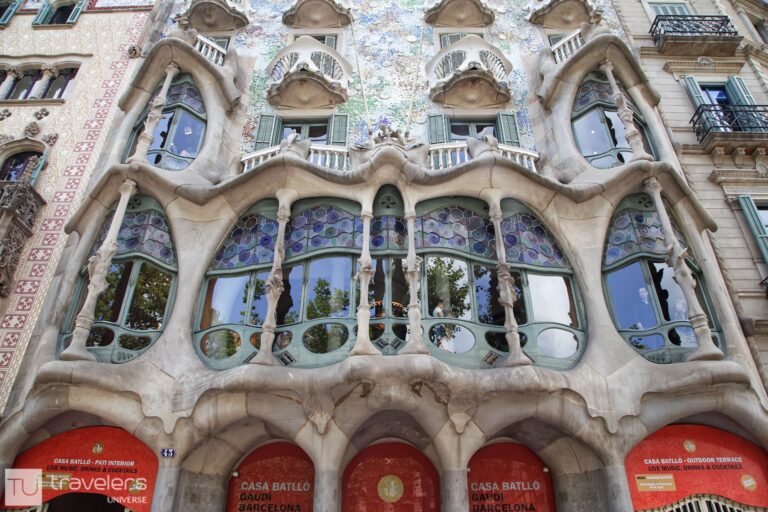
Barcelona is the most visited city in Spain. So it’s only natural to kickstart this Spain itinerary with a few days in the Catalan capital.
While Barcelona has plenty of attractions, I recommend you plan your time around architecture, museums, and food.
First off, Gaudí’s masterpieces are a must-see, starting with Sagrada Familia, the huge and dazzling basilica that has been under construction for well over 100 years. Construction work is planned to be finished by 2026. You can already admire pretty much all of the exterior and interior without much interference.
Sagrada Familia is a UNESCO World Heritage Site (together with 6 other Gaudí buildings) and it hosts the tomb of Antoni Gaudí. Over 8,000 people visit it every day.
Other must-see Gaudí masterpieces are Park Güell, Casa Milà, Casa Batlló, and Casa Vicens. Casa Vicens is the first house completed by Gaudí and it opened its doors as a museum for the first time in 2017.
I absolutely love every single Gaudí building. They are not only spectacular and thought-provoking but also incredibly different from one another. I encourage you to try to see as many of them as possible.
If you want to be really thorough, the Crypt of the Colònia Güell is just 20 minutes outside of Barcelona and can be visited as well. Due to the fact that Gaudí’s buildings are incredibly popular, it’s best to get skip-the-line tickets online whenever possible.
Besides Gaudí’s masterpieces, you should also make a beeline for Palau de la Música Catalana , another stunning modernist building. You can simply book a tour to see the splendid interior. But I highly recommend going to a concert here for the full experience.
Strolling along Las Ramblas , is a must as well, although it’s usually very busy and I find myself enjoying it less and less every time I visit.
One mandatory stop along Las Ramblas, however, is the La Boqueria market . Here you’ll find sinfully delicious smoothies, fruits, and tapas . Often referred to as the best food market in the world, over 40,000 people walk its alleys every day. You can even visit it in the company of a chef that will show you the best tapas stops and how to cook seafood paella .
A bit of a hidden gem, I also think you should take the elevator up the Columbus monument at the end of Las Ramblas for magnificent views of Barcelona and the Rambla itself.
Spain’s Catalonia region is famous for its cava (the Spanish take on sparkling wine). So another fun thing you can fit into your 2 weeks in Spain itinerary is a cava winery tour just outside Barcelona.
In terms of museums, I recommend the Picasso Museum and the Miro Museum . Plus, if you are a Salvador Dali fan, hop on a train to Figueres to visit the intriguing-looking Dali Theater Museum and see over 1,500 of his artworks, including paintings, sculptures, and photographs.
The high-speed train from Barcelona-Sanz to Figueres takes under one hour. It passes through Girona , a charming Catalan town with a well-preserved Jewish quarter and a Game of Thrones filming location. It’s worth spending an afternoon there on your way back. If you’d rather not bother with all the logistics, you can also join a tour.
While you can expect crowds year round (over 20 million people visit Barcelona every year!) summer is inevitably the most popular time of the year.
If you are looking for a more detailed itinerary, you can read my 3 days in Barcelona guide. It covers 18 of the best places to visit in an organized and efficient manner.
Where to stay in Barcelona
- Hotel 1898 is ideally situated on Las Ramblas, in a beautifully restored 19th-century building. It has a rooftop pool with a sun terrace, marble bathrooms, and sleek decor.
Spain in 2 weeks — Day 4 & 5: Valencia

If you leave Barcelona early, you can be in Valencia by mid-morning. You’ll either arrive at the old North Station (Estacion del Norte) or the modern Joaquin Sorolla station.
While the former is smack down in the city center, the latter is a bit further away. However, a bus connecting the two makes arriving at either station very convenient.
The bus runs every 10 minutes and the journey time between stations is under 5 minutes. You can board this bus for free just by showing your train ticket to the driver.
The North Station is an attraction in itself and it’s worth coming back to visit without luggage.
On the day of your arrival, I recommend you explore the old town . This is where most attractions and museums are located (check out my extensive list of things to do in Valencia ).
Visit the cathedral — it is believed to host the real Holy Grail, on display in one of the chapels. For a bird’s eye view of the city, climb the bell tower (known among locals as Miguelete). This Gothic-style tower has a spiral staircase with 207 narrow steps that will surely give you a workout.
If you’re into architecture, make sure you visit the San Nicolas Church . It’s tucked away between buildings and you get to it through a nondescript alley, but it hides some of the most spectacular Baroque frescoes. It has even been dubbed the Valencian Sixtine Chapel.
Stop by La Lonja , the old silk exchange built during the Valencian golden age when most silk trade on the Mediterranean passed through Valencia. This is the only building in Valencia declared a UNESCO World Heritage Site. The main hall with its palm tree columns is absolutely stunning.
Another must-see in the city center is the Palace of Marques de Dos Aguas . The out-of-this-world Rococo facade is one of the most Insta-worthy places in Valencia. While the lavishly decorated rooms on the first floor will give you a glimpse into the life of a noble Valencian family during the 18th century.
On your second day in Valencia, you could head to the beach . The marina and miles-long promenade are beautiful, and the restaurants here serve the best paella in Valencia . Or you could take a paella cooking class and learn to prepare the world’s most famous rice dish yourself.
You cannot leave Valencia without seeing the City of Arts and Sciences, a futuristic architectural complex built by the renowned Valencian architect, Santiago Calatrava.
For a panoramic view of Valencia, join this tour that includes a visit to the famed buildings and a tapas tasting on one of the highest terraces in town. Dining tapas with views at the City of Arts and Sciences is a priceless experience that should not be missed when visiting Spain in two weeks.
Where to stay in Valencia
I recommend booking a centrally located hotel close to North Station. This will make everything super accessible.
- NH Collection Colon is a two-minute walk from the North Station. It’s a recently renovated, elegant hotel on Valencia’s main shopping street. Ideal when getting around Spain by train.
- Palacio de Rojas is situated in the old town, within walking distance of the train station. This is one of my favorite hotels in Valencia. It looks great and the beds are super comfortable.
Spain in 2 weeks — Day 6 to 8: Madrid
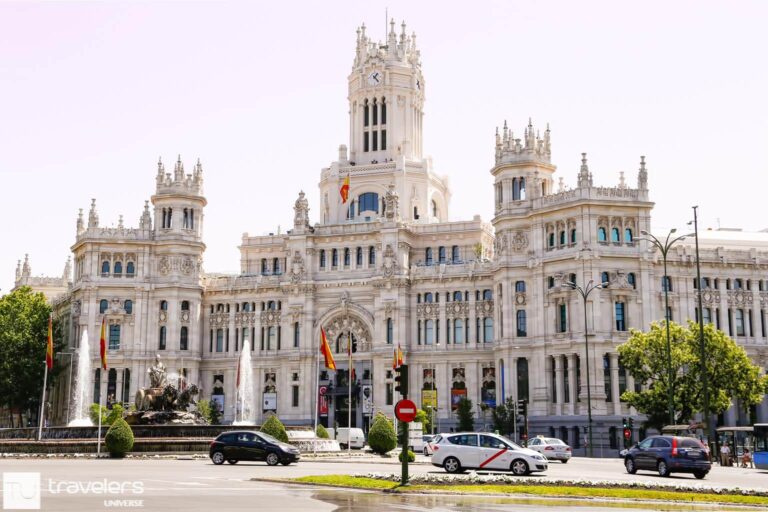
Getting from Valencia to Madrid only takes 1h 35min by AVE (literally meaning ‘bird’ in Spanish) train. You’ll arrive at the Atocha train station, which is centrally located and hosts an awe-inspiring exotic garden under its glass dome.
Madrid is a bustling capital, with several must-see attractions, including the Royal Palace and El Prado museum.
If you want a detailed account of all you could see, check out my 3 days in Madrid itinerary . There I cover everything, from where to go to what to eat while in Madrid.
If your two weeks in Spain itinerary includes the southern region of Andalucia, I recommend you skip the flamenco show for now. Flamenco is a passionate dance, with gypsy and Arabic influences, dating back to the 18th century. It originated in the south of Spain and the best performers still live there.
One mandatory stop in Madrid, however, is Sobrino de Botin . This restaurant is considered to be the oldest in the world according to the Guinness Book of World Records. It’s a very atmospheric place and the food is exquisite. They specialize in Castilian cuisine, which roughly means central Spain.
It’s worth noting that Madrid attracts the best ingredients and chefs from all around Spain. This makes Madrid the ideal place to taste all kinds of Spanish foods specific to other parts of the country.
To get the most out of your 2 weeks in Spain trip, you can also visit the nearby region.
Madrid is a modern capital and of course, everything is more refined here. But once you head out of the city, you’ll discover Spain in its raw state.
This day trip to Segovia, Avila, and Toledo packs a lot in only one day, but it’s very well organized and you’ll gain a much deeper knowledge of Spain as a result.
While you can visit any of these cities by train, you won’t be able to see them ALL in one day. So in this case, an organized guided tour is the best option.
If you’d rather spend more time in Madrid, you can go on a shorter, half-day trip to the royal monastery of El Escorial and the Valley of the Fallen.
Where to stay in Madrid
- Room Mate Alba is located in the center of Madrid, a few minutes from the Atocha train station. It has beautiful rooms full of character, free WiFi, and a sun terrace.
- For more accommodation options, see my list of the best boutique hotels in Madrid .
Spain in 2 weeks — Day 9 & 10: Granada
If you’ve spotted differences between the previous three Spanish regions, wait until you arrive in Andalusia!
The train journey from Madrid to Granada takes 3h 20 minutes on average and passes through Cordoba. But don’t get off just yet. It’s best if you come back in a couple of days. This is actually the smartest choice because this way you’ll get to spend more time in both Cordoba and Seville.
So why is the south so different from the rest of the country? Well, because it was under Moorish rule for way longer.
The occupation of Andalusia lasted almost 800 years. It concluded in 1492 when Granada, the last Moorish stronghold, finally surrendered. This, obviously left a deep mark.
Andalusia’s cultural and artistic heritage remains quite different (and fascinating) to this day. For me, visiting Andalusia feels like I’m with one foot in Africa already.
The Alhambra complex is the must-see attraction here, and no visit to Granada is complete without taking the time to wander through its breathtaking gardens and palaces.
Alhambra is the most visited attraction in Spain, with over 8,500 daily visitors! The place is huge though, so it doesn’t really feel that crowded. Plus it’s breathtaking. You really cannot skip it.
Given its popularity and the fact that it tends to be sold out days in advance, it’s best to book your tickets online before your trip. I also recommend getting the general ticket because it’s the most complete and includes all palaces and gardens inside the complex.
You could also visit the cathedral — the Catholic Kings (aka Ferdinand II of Aragon and Isabella I of Castile) are buried here. This power couple was kind of a big deal back in the day. First off, their marriage led to the unification of Spain. Then they funded Columbus’ expeditions that ended up with the discovery of the Americas.
Take your time to discover Albaycin, a fascinating neighborhood with narrow winding streets dating back to medieval times when Granada was still under Moorish occupation. It’s a UNESCO World Heritage Site together with the Alhambra.
Last but not least, fill your belly with all the delicious tapas you can find. This should become a habit during your two weeks in Spain. But in Granada, you have even more reasons to do so, as they have this amazing tradition of serving a small tapa with every drink you buy, and the more you order, the better the tapas get.
Where to stay in Granada
- Villa Oniria is located halfway between the train station and Alhambra, in a beautifully restored 19th-century manor house. The Andalusian style, comfortable rooms, private garden, and inner patio make this the perfect place to relax in Granada.
Spain in 2 weeks — Day 11: Cordoba
You can either spend a night in Cordoba or simply stop for a few hours on the way to Seville. Cordoba is a gorgeous city but has fewer must-see attractions and you can pretty much see them all in one day. You don’t really need to dedicate it more than that when visiting Spain in 2 weeks.
Start with the Mezquita , one of the most beautiful examples of Moorish architecture in Spain. Built on the site of a Visigoth church and a Roman temple before that, the Great Mosque was converted into a Catholic church during the Reconquista.
The 856 candy cane striped double columns are an architectural marvel and the whole place was declared a UNESCO World Heritage Site.
Next off, take your time to wander the gorgeous streets of the old quarter . Its out-of-this-world patios (courtyards) are full of charming flower pots that come in contrast with the white walls.
Every May, a festival highlighting the most beautiful patios is organized. But don’t get discouraged if you visit any other time of the year. You’ll still find plenty of inviting patios to admire.
Other sights I loved and believe you should see are the Alcazar de Los Reyes Cristianos (a beautiful palace-fortress in Mudejar style) and Palacio de Viana (a 17th-century aristocratic home).
Where to stay in Cordoba
- H10 Palacio Colomera is a breathtakingly beautiful hotel right in the center of Cordoba. Rooms are quiet and comfortable and the private rooftop bar offers a great way to end the day.
Spain in 2 weeks — Day 12 to 14: Seville
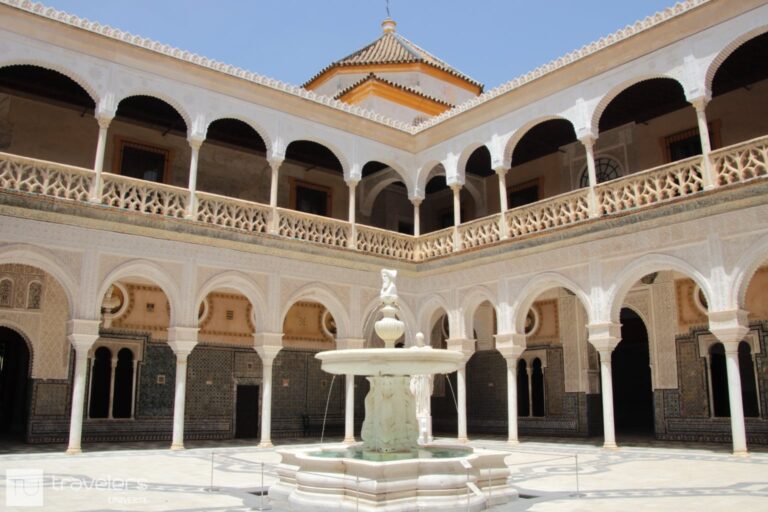
Seville is, without a doubt, the most atmospheric city in Spain. So yes, you could say I saved the best for last.
Going on an evening stroll through Seville is a pure delight. It’s also when many locals like to go for a walk, as during the day temperatures can be quite high, especially in summer.
In fact, Seville was nicknamed the frying pan of Europe . As you can imagine, the best thing you can do at noon is to visit a museum or a palace rather than get a sunburn.
Start with the cathedral — Christopher Columbus is buried here — and the Alcazar. They are both UNESCO World Heritage Sites and their beauty will spoil your senses.
You can save money with a combo ticket or you can book your skip-the-line Alcazar tickets here and your skip-the-line Cathedral tickets here. Both attractions tend to have very long lines, so getting your tickets in advance makes sense.
Remember I said that you should skip the flamenco show in Madrid because Seville organizes the best shows in the country?
Well, now it’s the moment to put a red carnation in your hair (or suit pocket) and head to a show. I saw this performance in the Triana neighborhood and enjoyed every moment.
UNESCO declared flamenco a Masterpiece of the Oral and Intangible Heritage of Humanity. If you’re a UNESCO fan, you cannot miss this.
Other places you should visit in Seville include the dazzling Plaza España and the Palace of the Countess de Lebrija . This palace is one of my favorite places in Seville. It hosts an impressive collection of Roman mosaics rescued from the nearby city of Italica.
Italica was the birthplace of Roman emperors Trajan and Hadrian. Recently, it was used as a Game of Thrones filming location — it doubled as the Dragonpit.
Casa de Pilatos with its delightful gardens dotted with marble statues, is another place you should visit, time permitting. And if you want to spend a romantic evening, board a cruise on the Guadalquivir at sunset. For more inspiration, you can check out my article about the best things to do in Seville in 3 days .
If you’ve been following my 2 weeks in Spain itinerary to the letter, you might also have time to take a day trip outside the city and visit the famous white villages and Ronda. Or take a trip to Gibraltar or even cross the strait to Morocco and visit Tangier.
Where to stay in Seville
- Hotel Las Casas de la Judería is one of my favorite hotels ever. Situated a stroll away from the cathedral, in Barrio de Santa Cruz aka the old Jewish quarter, the hotel is a collection of houses, each with its own Andalusian quirks. The houses are connected by a series of private gardens, the lobby has a piano bar and the whole place can be described as a city within a city.
10 days in Spain itinerary
If you only have 10 days in Spain, you can still see many of the highlights.
You could, for example, stop in Valencia for only a few hours to see the City of Arts and Sciences on your way to Madrid.
Also, dedicate 2 days instead of 3 to both Madrid and Seville and only 1 day to Granada to see the Alhambra.
Or you could skip Valencia and Cordoba altogether, for a trip that is less of a whirlwind and more straightforward.
Want to deepen your knowledge of Spain before you visit? Check out these interesting facts about Spain and learn more about Spain’s food culture and mealtimes .
LIKE THIS 2 WEEKS IN SPAIN ITINERARY? PIN IT!
If you’ve found this 14 days in Spain itinerary helpful, please consider sharing it with your friends. Your support means the world to me and helps me keep the lights on.

Plan Your Next Trip To Spain With Our Guides
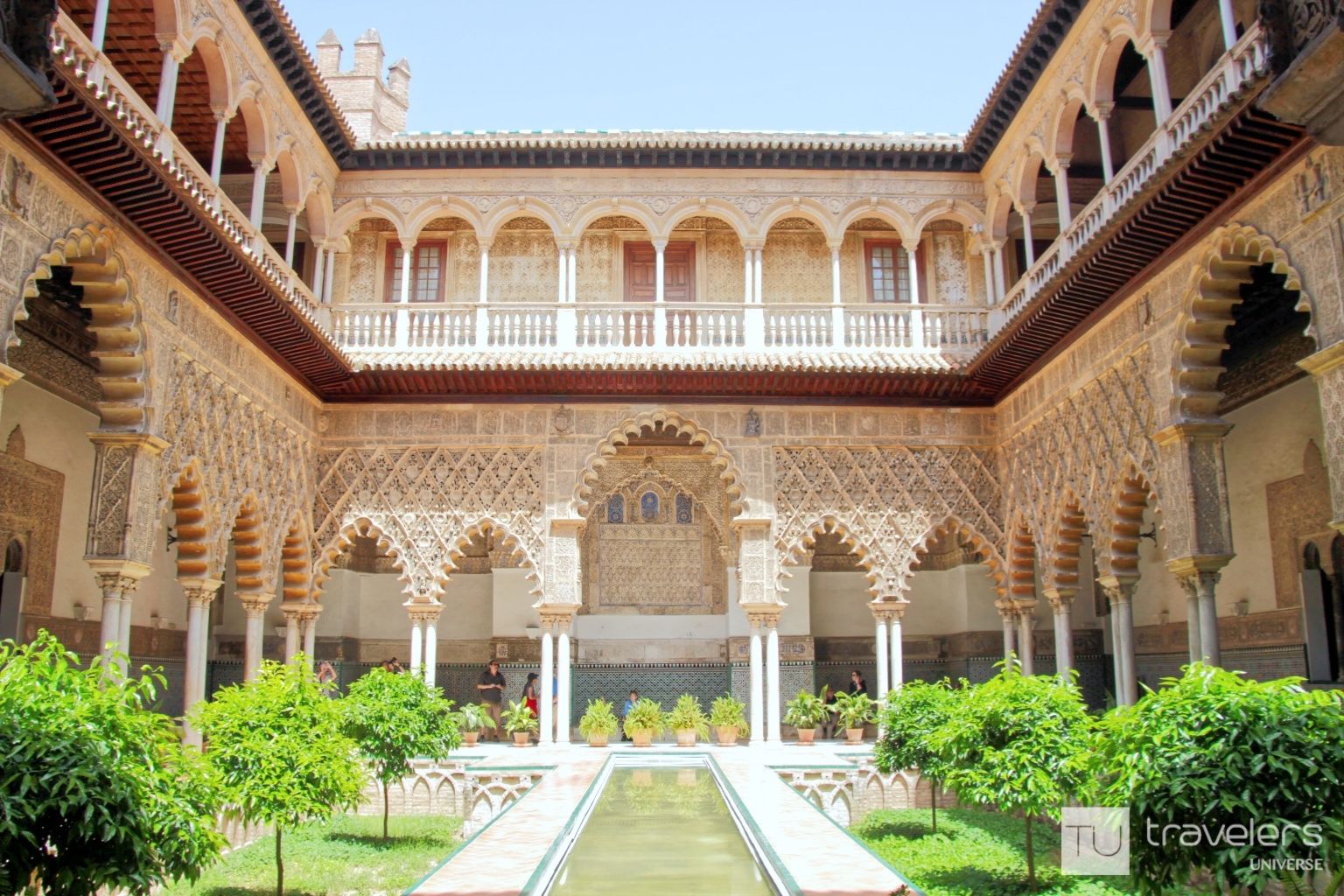
17 Interesting & Fun Facts About Seville
Learn more about Andalusia’s capital with these 15 fun facts about Seville.

20 Hidden Gems in Barcelona, Spain (From A Local)
Discover the best hidden gems in Barcelona, from secret gardens and viewpoints to lesser known modernist buildings.
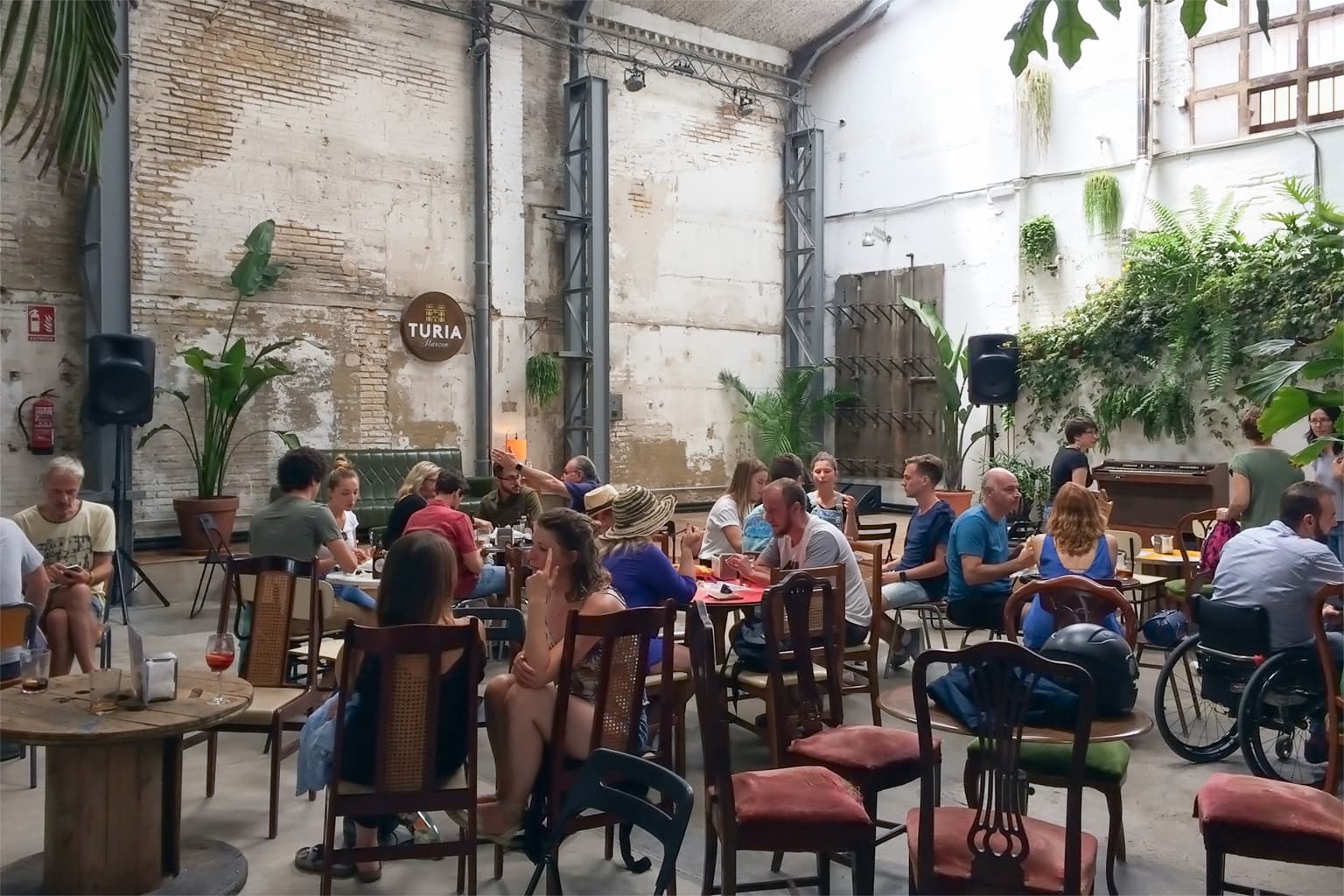
Valencia Nightlife: The Ultimate Guide to the Best Clubs and Bars
Heading to Valencia? Check out the best nightlife hotspots in the city.
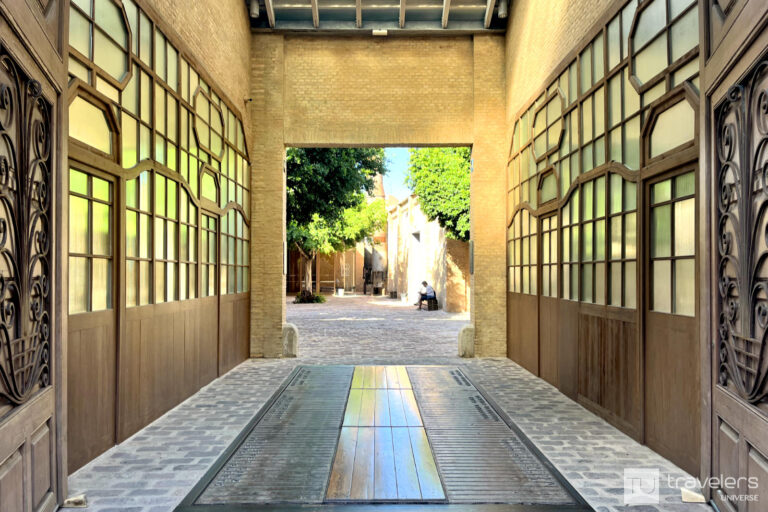
7 Valencia Hidden Gems For Off The Beaten Path Exploring
Discover some of the most interesting secret spots and hidden gems in Valencia.
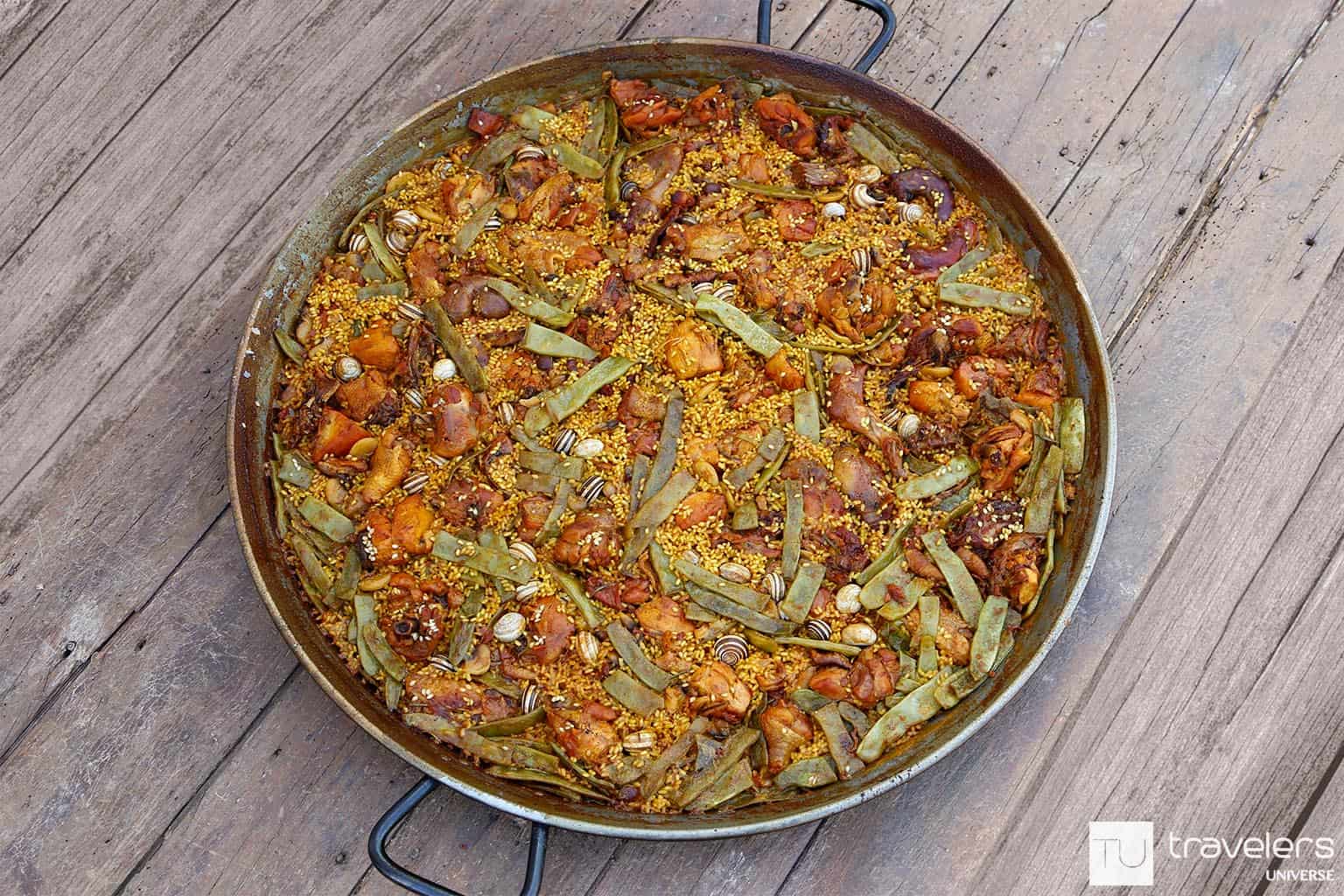
5 Restaurants Where to Eat the Best Paella in Valencia
Find out the best paella restaurants in Valencia plus tips on how to know you’re eating authentic paella.
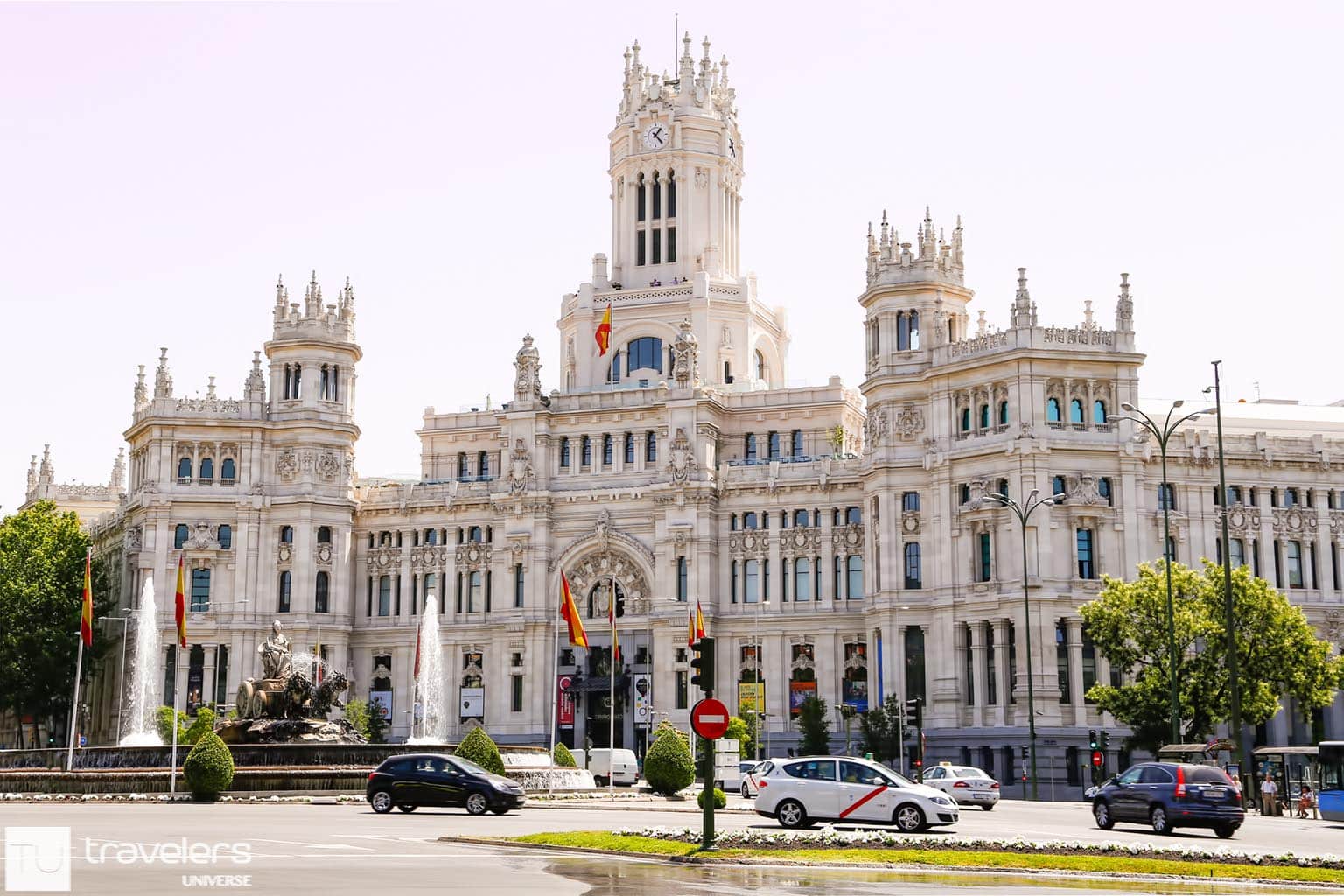
3 Days in Madrid: The Ultimate Madrid Itinerary (+ Map)
Plan your next trip to Madrid with this detailed city guide that covers what to eat, where to stay and the best attractions and things to do in Madrid in 3 days.
- Destinations
- Winery Directory
Southern Spain Itinerary: 10 Perfect Days in Andalusia
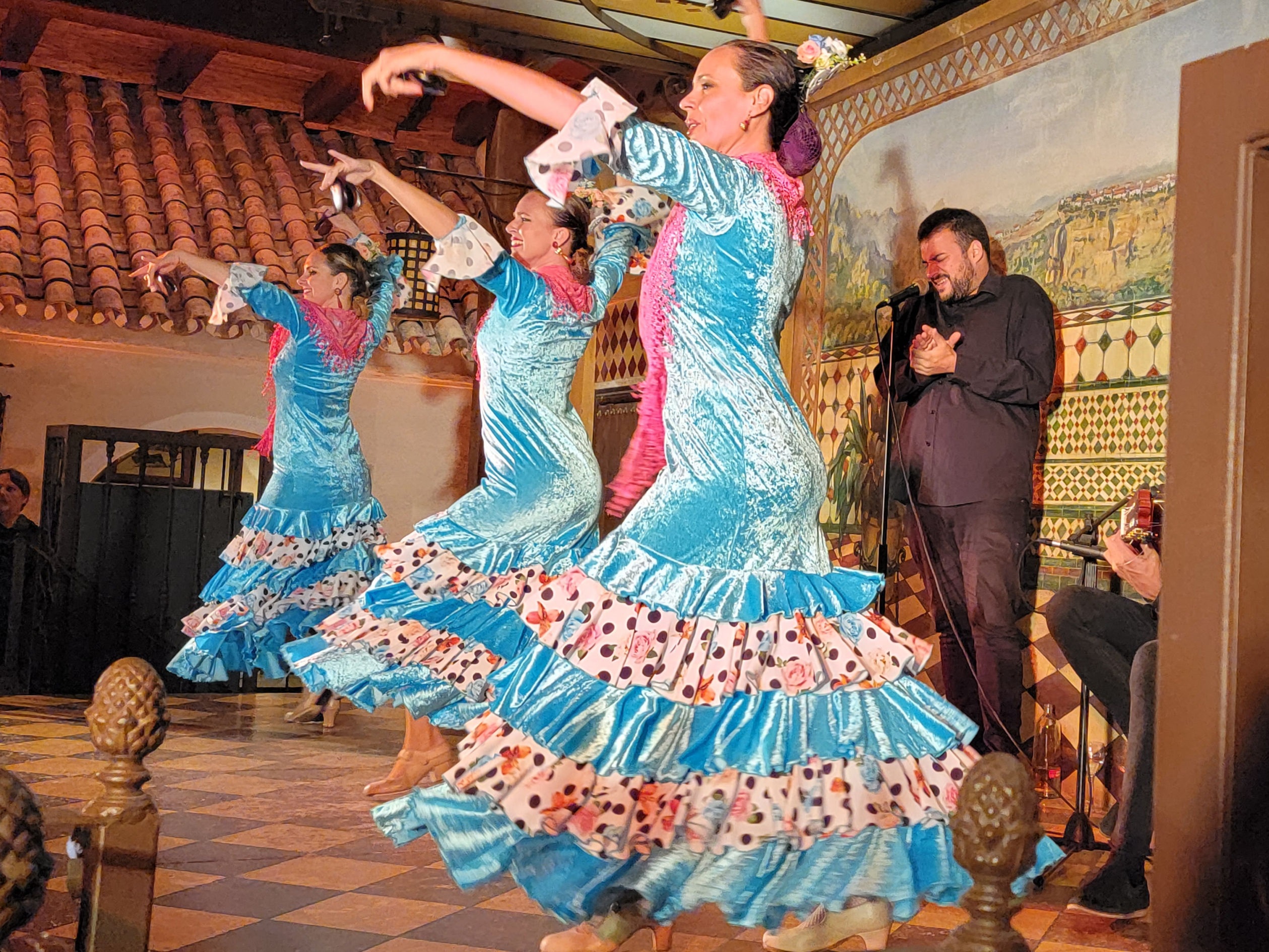
Exquisite architecture influenced by the blend of Islamic and medieval Christian design, Roman ruins on rolling landscapes, regional wine and food, traditions held fast like flamenco dance and people who share the joy of living are all reasons to visit Andalusia. (Pronounced ahn-dah-loo- thee -ah in Spain.) The region rests in southern Spain with long beach coastlines on the Atlantic and Mediterranean.
IN THIS GUIDE:
- Travel Tips
- Jerez de la Frontera
- …and more
How to Get to Andalusia
Three international airports serve Andalucia: Málaga (AGP) , Seville (SVQ) and Jerez de Frontera (XRY) . Watch for cheap flights from London Heathrow (LHR) to Málaga . High-speed trains also connect southern Spain to the Madrid (MAD) airport.
Things to Know Before You Go
Most shops and businesses close between 2 pm and 4 pm for siesta. Regarding weather and crowds, May and October are the best months to visit. Public transportation is excellent and affordable. In Andalusia, the word bodega can mean a winery, wine cellar and/or bar.
How To Get Around Southern Spain
Spain has more high-speed railway tracks than anywhere in Europe, making train travel convenient, comfortable and affordable. Spain’s highway system is also modern so check here for some of the best rental car rates in Spain offered through Kayak.
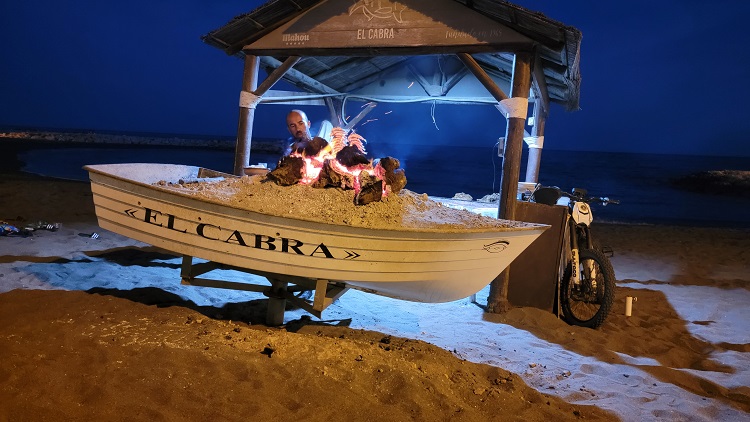
Day One and Two: Málaga
Where to stay.
Like any city of 592,000 , Málaga offers accommodations in every category, including country bed and breakfasts, beach resorts, hostels and high-end hotels. Affordable beds include TOC Hostel Málaga , whereas Hotel Castilla Guerrero is midrange, with Hotel Castillo De Santa Catalinas and Gran Hotel Miramar GL being top of the line.
Where to Experience Wine
The wines of the Málaga DO (Denomination of Origin) are primarily crafted with the white varieties Pedro Ximénez and Moscatel . The sweet, still wines are made from over-ripe or raisined grapes. Taste two wines with DO Málaga and DO Sierras de Málaga designations at Málaga Wine Museum , where you’ll ponder art-quality bottle labels and posters and come to know the geography and wine production of the region. At El Templo De Vino , a trendy wine cellar and tasting room, you’ll swirl, sniff and sip the wines from small producers, the house’s specialty.
Where to Eat
In the shadow of Alcanzar, Bodega El Pimpi has been attracting foodies with its focus on local culture and gastronomy since 1971. Soulful flamenco guitar chords waft from the patio while you savor local delicacies such as Malagueña salad with potato, orange and baked cod or chipirones a la Malagueña , Málaga-style baby squid.
In the evenings, amble along Málaga’s beaches, and you’ll bump into chiringuito eateries. Make sure to try this full-on Málaga beach food experience that began when fishermen broiled freshly-caught sardines on skewers over open fires. Today you’ll get the fresh catch prepared in the same way. Ask for espetos . For tapas, you can’t go wrong at Bar Pepe y Pepa or El Tapeo de Cervantes .
Additional Things to Do
Stroll up the cobblestone stairs and through intimate passageways that connect secret gardens and water features built in the early 11 th century as Caliphate royal courts. The Alcazaba y Castillo de Gibralfaro , sprawling up and over the hill in the center of Málaga, is a palace and defensive fortification integrated into today’s city. The medieval Málaga Cathedral and the artsy Museo Carmen Thyssen Málaga are a ten-minute stroll away. Although it’s difficult to see all that the port town of Málaga has to offer in just two days, you could take a side trip to Granada, home of the Alhambra .
If you’re still looking for more things to do when visiting Málaga , be sure to check out our guide to some of the most authentic experiences to have in and around the city.
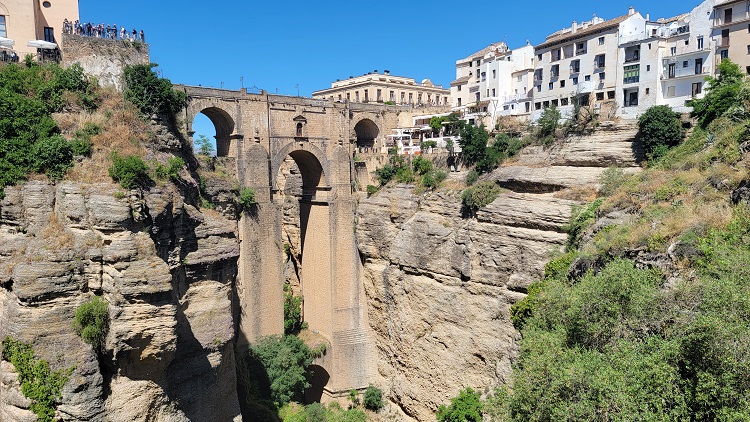
Day Three: Ronda
Because nature preserves surround Ronda, the journey alone is worth a stopover in the medieval town balanced at the edge of mountain ravines. Traditional Andalusian white houses seem to cling over the abyss, which is bridged by one of Spain’s most photographed architectural features: Puente Nuevo , the ‘new bridge.’ However, the stone edifice is hardly new, with construction completed in 1793.
Stay at Parador de Ronda for its spectacular location beside the town’s emblematic Puente Nuevo. Mountain-view or city-view, each room has its own balcony. The ritzy hotel is part of the Paradores system inaugurated by the Spanish government in 1928 to preserve national heritage by repurposing prominent historic buildings. Bonus: restaurants in every Parador offer regional gastronomy.
Why not buy your wine for the night at Centro Integral del Vino de Ronda , a wine museum? Ronda’s wine-making history dates back over 2000 years, when Romans cultivated vines and produced wine here.
Today vintner Joaquin Fernández wants you to enjoy wine just as any true Andalusian does. So besides exceptional wines, he’s created Bodega Joaquín Fernández in the countryside, where enthusiasts can sit back and enjoy views and traditional foods. “I don’t let anything unnatural touch my wine. Even the corks are made from the best quality cork you can get,” says Fernández of his ecologically produced Finca Los Frutales wines.
Walk a few blocks past the restaurants that line “El Tajo,” the cliff near Puente Nuevo frequented by the tourist crowd. Better experiences and moderate prices await at mom-and-pops like Sensur Gastrobar , Restaurante Tropicana or Entre Vinos .
Author Ernest Hemingway recommended that if you saw only one bullfight, you should see it in Spain’s oldest existing bullring Plaza de Toros in Ronda. Unfortunately, however, bullfights happen only once per year in September. You can, nonetheless, tour the architectural marvel most days. No need to know Spanish to understand the expressive flamenco performers at Ronda Flamenca .
RELATED: Ronda Spain in Pictures: Top Things to Do
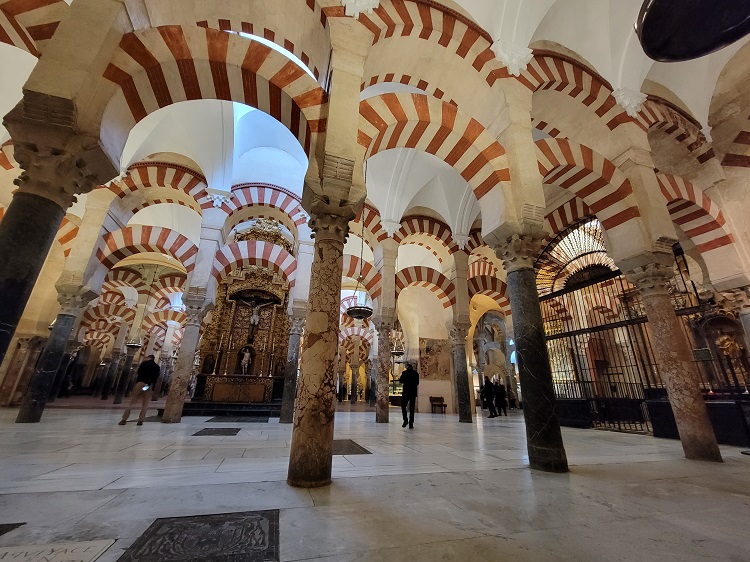
Day Four and Five: Córdoba
You’ll want to stay in Córdoba’s charming Jewish Quarter, which is in the heart of the Middle Ages capital. La Llave de la Judería Hotel Boutique and Las Casas de la Judería are four short blocks away from the impressive Mezquita, a UNESCO World Heritage Site.
Discover the wines from the region of Montilla-Moriles on a wine tasting tour or go it alone to Bodegas Lagar Blanco , an hour out of the city. In town, Bar Los Cuatro Gatos exudes a neighborhood vibe, and if you’re willing to greet others with a “Buenas tardes” or “Como te va la vida?” you’re sure to meet friendly locals.
Try salmorejo , the city’s most famous dish, at El Rincón de Carmen . The thick, cold tomato-based soup can also be found at La Salmoreteca , a booth inside Mercado Victoria , the lively gastro market. Cafe – Bar La Cavea does a terrific job with another regional favorite, Berenjenas fritas con miel de caña (fried aubergines with cane honey).
Prepare to be bedazzled by the stunning amalgam of Roman, Islamic and early Christian architecture at the Mezquita, the Mosque-Cathedral of Córdoba. Arabs who ruled Spain from 711-1492 built their Mosque and orange gardens over a Visigothic Christian church. The Mosque was converted to a Cathedral in 1236 after the Christian forces of Castile regained control of Córdoba. And if your senses aren’t yet overloaded, take in the Cordoba Royal Stables , where Andalusian horses and their riders seem to float above the ground. Don’t pass by the Museo Arqueológico de Córdoba . Pilgrims of the Camino de Santiago will want to pay homage to the saint at Iglesia de Santiago .

Day Six and Seven: Seville
Seville is a walking town, so you’ll appreciate centrally-located digs like the affordable New Samay Hostel , the mid-priced Hotel Doña María , or the luxurious EME Catedral Hotel in a 16th-century Andalusian building. From any of these, you’ll saunter shady, orange-tree-lined boulevards filled with scents of jasmine and orange.
With over three thousand Seville tapas and wine bars, knowing where to jump in can be paralyzing. Make a start at Vineria San Telmo , known for its extensive wine selection—try the regional orange wine for dessert. Or review the tasting events calendar at Flor de Sal . Later, savor Andalucian sherry wine paired with acorn-fed Iberian ham during an evening Seville Tapas and Flamenco Tour led by an expert.
Sample solomillo al whisky , pork sirloin in whiskey sauce at Casa Pepe Hillo . Food-focused travelers will want to try another Sevillian specialty, espinacas con garbanzos , spinach, with chickpeas. For that, reserve a table at El Rinconcillo , celebrated for its traditional cuisine. The unassuming La Flor de mi Viña is said to have some of the city’s best cola de toro , sometimes called rabo de torro or bull’s tail stew.
Pay your respects to Christopher Columbus, who lays in a Renaissance-style tomb inside the massive Cathedral of Seville. The Cathedral, the world’s largest Gothic building, is noteworthy for its Giralda or belltower, a converted minaret of Seville’s Mezquita Mayor that once stood there. Trot up the tower via ramps engineered for the horses that carried muezzins to the top to proclaim the Islamic call to prayer.
Feel Seville’s blend of cultures in the Cathedral’s peaceful Patio de los Naranjos , also preserved from the Mosque. Illustrative of the weave of Islamic and Christian symbolism, the Gothic Door of Mercy, which connects the Cathedral to the patio, retains the horseshoe-shaped arch so prevalent in Mudéjar architecture.
Across the street is the Alcázar, constructed as a palace for Moslem governors in the 10 th century. The intricate tile work, gold décor and regal gardens make this one of the most beautiful places in Andalucia . UNESCO grouped together the monuments Alcázar and the Cathedral, plus the Archivo de Indias—archives for the 16 th -century documentation of New World discoveries—as one World Heritage Site.
Day Eight and Nine: Jerez de la Frontera
Splurge to stay in splendor at the chic and luxurious Hotel Casa Palacio María Luisa , a darling palace from the early 19 th century. Get breakfast and underground parking at Hotel Jerez Centro , an excellent mid-range choice, while Hotel El Coloso offers tidy, budget accommodations.
Tour and taste brandy and sherry at Bodegas Fundador , established in 1730, long before Ernest Hemingway mentioned their brandy in “ The Sun Also Rises .” They also blend and bottle Harveys Bristol Cream that you can order in their pleasant, full-service restaurant. You’ll enjoy the small museum and the musty aroma of wooden kegs and fermenting sherry in the cavernous La Mezquita wine cellar, named for its tiered arches similar to those in Córdoba.
Get out into the vineyards at Bodega Huerta de Albalá , only 38 minutes from Jerez. Closer to town is Bodegas Luis Pérez . Reservations are necessary but easy to make at both.
At Michelin-recommended La Carboná , traditionally-based contemporary cuisine stimulates the eye as well as the palate. In the hip, modern space—a revitalized bodega—Chef Javier Muñoz Soto creates exquisite dishes using the region’s iconic ingredient: sherry. By contrast, Restaurant T22 transports diners back to early 19th Century Jerez at the splendidly-appointed Casa Palacio María Luisa .

Even if you’re not horse crazy, a visit to Yeguada La Cartuja Hierro del Bocado , where Andalusian horses roam much as they did in the 15 th century, is a must-do. You’ll encounter stunning stallions, mares, foals and museum-quality carriages at this picturesque free-range breeding farm, now operated by the government’s heritage preservation division. After all that, an exposition that includes Spanish horse dressage, horse-drawn wagons, enganche racers and unbridled herds with flowing manes and tails is all part of the admission. This insiders’ look into Spain’s horse heritage is worth planning your whole trip around the Saturday-only openings. Online reservations are a must.
During weekdays, head over to The Royal Andalusian School of Equestrian Art for its stables and well-executed museum. Check their events schedule for the live equestrian ballet show “How the Andalusian Horses Dance.” If you fancy a trip to a historic port city, Cádiz is only 30 minutes away.
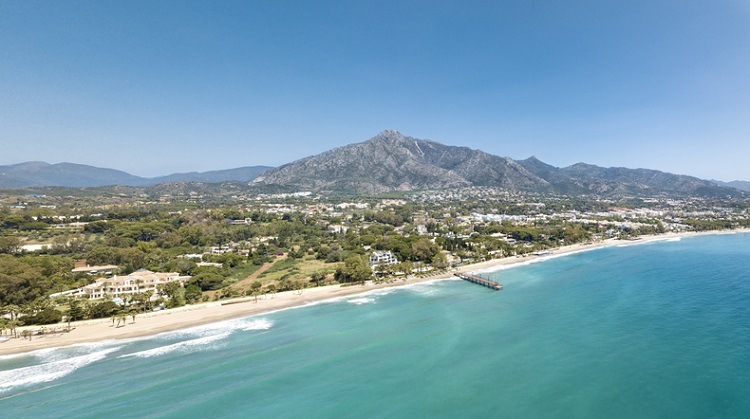
Day Ten: Back to Málaga and Costa del Sol Beaches
If you are driving, head south on the A-383 to Torreguadiaro. From there, take the leisurely A-7 through Mediterranean coastal towns. Stop in Marbella’s charming Old Town for lunch. If your flight out the next day is in the afternoon, Marbella —an hour from the Málaga airport—is an excellent choice for your last bittersweet night in Andalusia.
If you’re taking the train back to Málaga, reserve a room on the beach to enjoy your last night on the stunning Costa del Sol. For a real treat, the Parador de Málaga Golf Club , with its restaurant offering regional gastronomy, is on the beachfront while being a mere 1.8 miles from the Málaga airport. Get airport shuttle service (additional charge) at the beachside Occidental Torremolinos Playa , a splashy, mid-priced option. Or book the affordable Hotel Mediterraneo Carihuela , on the beach with an 18-minute walk to the C-1 bus line to the airport.
If you’re driving, book the Original Marbella Tapas Adventure , where you’ll taste wine at three bodegas in Old Town. Or, while in Torremolinos, accompany your wine with fresh fish edibles at La Bodega . And, of course, you can always stock up on duty-free wine at the Málaga airport .
Besides beach combing and watching intoxicating sunsets during your Costa del Sol beach overnight, you can look for one of the 100 watchtowers strung out along the coast. As a rule of thumb, Arabs built the oldest towers with rectangular bases. Round-based turrets were made after the Reconquista as lookouts for pirate ships. Six towers are located around Marbella .
Featured image courtesy Stacey Wittig.
You are reading “Southern Spain Itinerary: 10 Perfect Days in Andalusia” Back To Top
things to do in Andalusia, Southern Spain travel guide, 10 days in southern Spain: top travel destinations in Spain
If you enjoyed this guide, make sure you register to become a Winetraveler for free! You’ll get access to all of our content and interact with other Winetravelers and for travel inspiration around the world. Be sure to follow along with us on Instagram as we continue to feature more exciting destinations.
Get Articles Like These Directly in Your Inbox!
Subscribe to Winetraveler and receive notifications when new travel guides and itineraries are published. It's free!
Email Address
Sign Me Up!
Login to view more Articles
Leave a comment, ask a question or share a review cancel reply, comments ( 2 ).
I love this area of Spain and you have a list of great places to see!!!
Thanks, Kevin! It was fun to put together an itinerary of one of my favorite parts of Spain. Can’t wait to go back for more!
You Might Also Like
Underwater wineries: dive in (literally) for your wine, 17 best catalonia wineries for wine tasting in 2024, list of recommended wines to try each month (and why), here’s how to eat and drink like a european during the holidays, 15 best luxury wine hotels & vineyard resorts around the world, visit these 15 charming food cities in spain to sample spanish cuisine, canary islands spain: travel guide, best islands & travel tips, wineries nearby, marqués de riscal, bodegas lópez de heredia, celler devinssi, bodegas vivanco, cheers to free membership.
Explore new paths. Travel expertise from locals and wine industry experts.
Get free access to all the goods:
- Exclusive articles
- In-depth itineraries
7 day Southern Spain Itinerary – Everything You Must See in Andalusia!
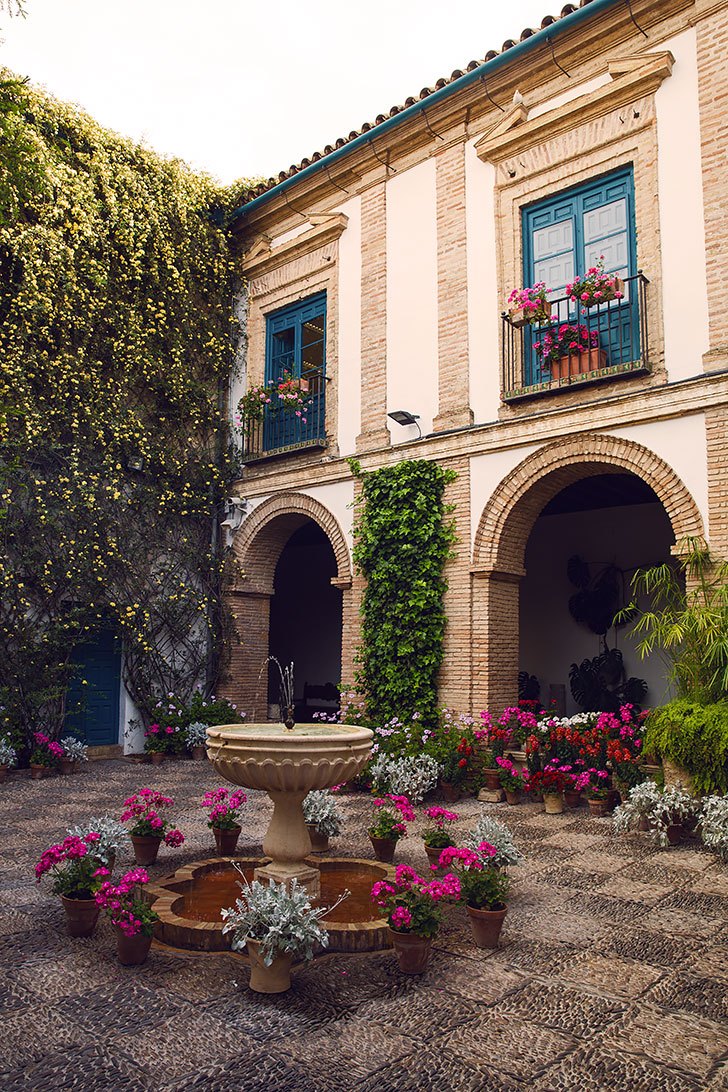
Southern Spain Itinerary
Cities : cordoba, seville, granada, length : 7 days, 6 nights.
Gypsies, flamenco, horses, bulls – Andalusia is the Spain of story and song. For 781 years the region was a Moorish empire named for Al-Andalus (Arabic for “land of the west”) and where the history and character of the Iberian Peninsula is most visibly and aromatically apparent.
On my 2 week trip visiting Spain, the southern cities in Andalusia were my favorite. I spent the days wandering the narrow, white washed alleys, relaxing siesta style from the hot Spanish sun, and emerging once again at night to taste my way through as many tapas bars as humanly possible.
Read on for our 1 week Andalusia itinerary!
Or save this article to read later by pinning it ⇟

ADVERTISEMENT
Spanish Cities

A must-see destination, featuring one of the world’s greatest Moorish buildings, the Mezquita, at its heart.

Seville is the heart of Andalusia, combining gorgeous buildings with a vibrant flamenco and tapas scene.

Overlooked by the seductive Alhambra, the historic city of Granada is one of Spain’s most compelling attractions.
The 5 Best Things to Do in Southern Spain
- Appreciating the exquisite architecture of Granada’s Alhambra and Cordoba’s Mezquita
- Watch the vibrant dancing of the flamenco
- Admiring the Golden Age of Spanish art at Seville’s Museo de Bellas Artes
- Trying a little bit of everything on an evening tapas crawl
- Enjoying the simple beauty of a bygone era by exploring the gleaming pueblos blancos (white villages)
The Best Southern Spain Itinerary
6-8 days (adjustable)
Before You Go:
I found Rick Steve’s Spain guidebook invaluable for his in-depth coverage of several museums and sights
Buy your train tickets in advance! Spain’s rail system operates on a flexible pricing scale where the farther out you purchase, the more you save. Check ticket fares for your dates here .
Granada’s main attraction, the Alhambra , limits the amount of daily visitors so tickets are impossible to buy upon arrival. Instead book far out in advance (ideally 60 days before your trip) to get the best shot of booking the ideal time slot. Tour tickets allow you to skip the line and are convenient as well.

Day 1: Arrive to Cordoba
Morning : Depart Madrid bright and early from Atocha rail station on the high speed AVE train southwards to Cordoba .
The ride takes approximately 2 hours and there’s ample luggage rack storage at the ends of each car. Make sure to book your train tickets before you arrive in Spain.
Upon arrival into Cordoba, check into your hotel and freshen up.
Afternoon : Do a walking tour of the Jewish Quarter and stop for lunch at Plaza Juda Levi, a lively square in a maze of narrow streets.
Afterwards, head to the Palacio de Viana, a museum noted for its grand mansion and 12 beautiful outdoor patio gardens. Cordoba’s main draw is the charm and beauty of it’s flower filled public courtyards.
Evening : Grab dinner and go for an evening stroll on the Roman Bridge. People watch and make sure to snap a photo of the Mezquita lit up at night!
Where to Stay in Cordoba:
Eurostars Palace Hotel – this hotel has a gorgeous inner courtyard and gives travelers a true feel for Cordoba's patios , which are usually hidden to outsiders except during the festival. We recommend at least 1 day in Cordoba, but 2 days if you'd like to take things more leisurely.
Check rates: Hotels.com , Booking.com
Read reviews: TripAdvisor

Day 2: Cordoba Sightseeing
Morning : Get an early start and walk to Cordoba’s Mezquita Cathedral by 8:30 – 9:00 am. Built between the 8th- 10th century, Cordoba’s mosque is one of the earliest and most beautiful examples of Spanish Islamic architecture. If you arrive early, you might get to hear the organ warming up!
Afternoon : After thoroughly exploring the Mezquita (did you see the contrast between the Islamic and Christian motifs inside?) walk 5 minutes over to the Alcazar de los Reyes Cristianos.
This fortified “palace” is where Queen Isabella and King Ferdinand launched their Catholic campaign against the Muslim rulers of Andalusia. The site is more military fortress than castle but it offers great views of the city.
Take the time to explore the gardens, which are beautifully landscaped.
Evening : Hop on the high speed train to head onward to Seville!
The appeal of Seville, Andalucía’s sunny city, lies in its extravagant Moorish architecture and its exuberant street life. There is always plenty going on in Seville’s picturesque cobbled streets, from religious processions to fiery flamenco.
Check into you hotel, grab dinner and relax.
Where to Stay in Seville
Seville has a great food scene, with classic tapas bars and more upscale fine dining. Take 2 nights in Seville to fully enjoy both the sights and the local cuisine.
Hotel Casa 1800 Sevilla is a boutique hotel with plenty of comfort: wifi, slippers, in-room safe and more! Definitely my top pick for convenience and comfort as it overlooks the Giralda Tower and is very centrally located.

Day 3: Seville
Morning : Head early to the Real Alcazar de Seville to avoid the crowds. This Muedejar palace was built by Pedro I on the site of Seville’s former Moorish alcazar and the grand architecture and rooms are an interesting study.
Don’t miss the gardens! You might recognize them as the site for the Water Gardens of Dorne in Game of Thrones.
Afterwards, head across the square to explore Seville’s cathedral . While the dimly lit interior can be disappointing, look for the tombs on the side of the chapel, the courtyard of orange trees on the church’s northern side and the lizard’s gate in the corner.
Make time to climb the Giralda, or belltower. It’s 40 flights up but ascends via a smooth ramp, so there aren’t stairs to climb! I really enjoyed peaking out the windows for views of the city below every 10 or so floors.
Afternoon : Head to Barrio Santa Cruz, the old Jewish Quarter for a feast of tapas. One of my favorite spots was Bodega Santa Cruz Las Columnas, an authentic spot frequented by locals, where the bartenders keep track of your order on the counter with chalk.
The medieval Jewish quarter, Barrio de Santa Cruz, is a lovely, whitewashed tangle of alleys. On some streets, bars alternate with antique and souvenir shops but most of the quarter is quiet and residential.
Pause on Plaza Alianza to enjoy the antique shops and outdoor cafes or head back to your hotel for an afternoon siesta.
Evening : Well rested, head to Casa de Pilatos to see the gardens of a 16th century palace. With its fine patio and superb azulejo decorations, the palace is a beautiful blend of Spanish Mudejar and Renaissance architecture and has extensive grounds and vibrant peacocks.

Day 4: Sightseeing in Seville
Morning : Have a traditional Spanish breakfast of cafe con leche (coffee with milk) and a chocolate croissant or two.
Then head to a new addition to Seville’s skyline to Las Setas, a modern art structure and canopy. If you’d like an impressive view over the city, head up the Metropol Parasol.
Afternoon : A can’t miss sight in Seville is Plaza Espana, a grandiose half-moon of buildings built for the 1929 World’s Fair. Each brightly colored azulejo represents a different province of Spain, while the four bridges symbolize the medieval kingdoms of the Iberian Peninsula.
In summer you can rent small boats to row along the arc shape canal. Just next door is Parque de Maria Luisa, a beautiful blend of formal design and wild vegetation.
Or, just book an epic Highlights of Seville tour for convenience!
Evening : Seville is one of the best cities in Spain for authentic, innovative and best of all, affordable tapas. Head to Barrio de San Lorenzo for the best selection of tapas grazing.
If you do not mind sitting at the counter, and you do not mind arriving at opening time (which ranges from 7:30pm to 9pm) you will be almost assured of space at the counter, and might score a table without having reserved in advance.
Have more time in town? Book a gourmet wine and tapas tour and see a flamenco show !
Overnight: Hotel Casa 1800 Sevilla
Did I mention they serve a delicious afternoon tea with sandwiches and pastries? Mhm

Day 5: Depart for Granada
Morning : Wake up early to head to the last and most impressive city on the Andalusia tour: Granada! A convenient option is to take the Alsa bus, about a 3 hour comfortable ride. Upon arrival, check into the hotel, drop off your bags and freshen up.
Afternoon : The highlight of any trip to Granada is a visit to the Alhambra. It is virtually impossible to see the palace without advance reservations.
For more information about times, buying tickets and the best way to tackle the 3 sights of the Alhambra you can check out my Alhambra post.
Evening : Get a sense of Granada’s history by visiting the Corral del Carbon, a caravanserai where merchants on the Silk Road rested their camels and spent the night. Here you’ll find a square with a water fountain and 14th century Moorish brickwork.
From the caravanserai, exit to the main street Calle Reyes Catolicos and walk straight to the Alcaiceria, a recreation of the ancient Moorish silk market with shops selling spices, silver and silk. While you’re in the area, stop by the Cathedral and Royal Chapel.
Where to Stay in Granada
Granada is a much larger city than Cordoba or Seville. Ideally, take 3 days to explore it all! Visiting the Alhambra alone easily takes a full day.
Hotel Anacapri Granada – affordable, clean and walking distance from the Alhambra. The Anacapri Granada is located in the heart of Old Town and also conveniently near the local bus stop, should you wish to explore Granada's farther sights.
Check rates : Hotels.com , Booking.com

Day 6: Exploring Granada’s Alhambra
Morning : Rise bright and early to tour the Alhambra ! The Alhambra is a massive complex with 2 entrances: the main entrance and the Gate of Justice. To get to the Alhambra, you can either take the many public buses from Plaza Nueva or walk.
If you have a morning slot booked and tickets in hand (recommended), the Puerta de la Justica is the closer entrance. Walk 15 min uphill (it’s a bit of a climb) from Plaza Nueva to enter at the gate and see the Nasrid Palaces before the crowds rush in!
Afterwards, wander through the very impressive and very extensive Generalife gardens and then circle back to wander the Renaissance Palacio de Carlos V (palace of carlos v), the Museo de Bellas Artes upstairs and also check out the ruins of the old fort.
Afternoon : Granada’s teahouses, the majority of which are clustered in “Little Morocco” around Calle Caldereria Nueva, are peaceful, atmospheric places to take a break after that exhaustive tour of the Alhambra.
Settle down with a fresh mint tea and a puff of shisha. Prefer the spa?
Another relaxing option is the Hammam Arab baths . Baths played an important role in Muslim life and you can relive the experience at this modern day version. The Hammam is built above the original site and you can relax in multiple bathing pools of different temperatures or get a massage and exfoliation scrub down.
Evening : Mirador de San Nicolas is the spot to be if you want to catch the Alhambra at night. We visited at sunset for a packed but breathtaking view and then ate at a local restaurant in the Albayzin .
Rick Steves cautioned against wandering the district at night in his Spain guidebook , but I personally didn’t feel unsafe. Just know that even though one street may be quiet and deserted, you can walk through a tunnel and then emerge onto a bustling busy street with restaurants. Don’t be afraid to explore!
Overnight Hotel: Anacapri Granada

Day 7: The Albayzin
Morning : Walk to Plaza Nueva, a large public square with fountains, restaurants and cafes where the local hippie community hangs out. From here, you can people watch and grab breakfast at a sidewalk cafe or tapas bar.
After a jolt of cafe con leche, catch one of the local shuttle buses that serves the Albayzin, or Moorish Quarter. The buses stop every couple minutes along the route up towards the Albayzin.
If you’re down to stretch your legs, I recommend walking the first 15 minutes or so to feel the spirit and vibrancy of Granada .
Afternoon : Head north from Plaza Nueva and walk along Paseo de los Tristes, a long road named “walk of the sad ones” as it was originally the route of funeral processions to the cemetery at the edge of town.
Along the walk, you’ll see the broken remains of the once grand 11th century bridge over the river that leads to the Alhambra. From here, the road arcs up to the Alhambra – hop on the local shuttle bus now to save your legs the brutal climb!
Or if you’ve worked up an appetite, you can backtrack slightly to Calle de Gloria to buy cookies and monastic wine from the Convento de San Bernardo.
Evening : Grab one last bite of tapas and pack up to depart Granada for the next stop on your tour. I recommend flying to Madrid or Barcelona and starting my Essential Spain itinerary .
Transportation in South Spain
Our itinerary went Madrid – Cordoba – Seville – Granada – Barcelona as this was the easiest logistical route.
You can easily do the reverse, but I wouldn’t recommend for example, Barcelona to Madrid then south as you’d be stuck south and have to backtrack to one of the major cities anyway, wasting time. Flights from the Andalusia cities typically have a stopover in Madrid or Barcelona before heading international.
Getting Around by Train
The Southern cities are connected to Madrid via the high speed AVE rail line .
From Madrid’s Atocha station, the trip takes approx. 2 hours to Cordoba. Add an extra 75 minutes if heading straight on to Seville. We found the train to be very convenient in Spain. We used it for individual day trips and also to get from city to city.
Train Class
Spain’s train system operates on a tiered pricing schedule where the earlier you buy, the more you save. There are two types of ticket fares available: turista (2nd class) and preferente (1st class) and seats are assigned.
I found the turista tickets to be just fine, with the seats quite comfortable and roomy. Train time tables are released roughly 60 days in advance, but don’t be alarmed if the tables aren’t out – the site is known for being delayed.
If you’re taking the high speed train, buy your tickets well in advance of your trip as they get increasingly more expensive and certain routes and times can sell out, especially in peak season.
How to Buy Tickets for Spain’s AVE Train
Spain’s national train system is run by Renfe, and you can find the latest schedules and times tables on their Spanish site. But, fair warning – that site is incredibly difficult to navigate for non-locals. It doesn’t quite translate things fully to English and has incredible difficulty accepting American bank and credit cards.
We tried and it wouldn’t accept our payment.
Instead, we booked our tickets on Omio . It’s much more user friendly to navigate, shows you the price in USD and accepts international credit cards. Best of all, you pay pretty much the same rate the locals do with a nominal booking fee.
We recommend planning out your route, finalizing your itinerary, and then booking all the train tickets on Omio in one checkout. That way, you only pay the booking fee once!
Super affordable and stress free.
Buses in Spain
Buses in Spain are quite comfortable and I found them most convenient for day trips. On the Andalusia route, I would recommend the bus only on the Seville – Granada route as the fare is often on sale and the ride is doable at 3 hours.
The local bus company Alsa departs Seville’s Plaza de Armas towards Granada. Similar to the train system, bus fares in Spain will vary depending on time of year and how close to your dates that you book.
If you book in advance , you can find deal fares for as low as 5 euros per person! I booked about two weeks prior and still got a steal at 10 euro per person. Regular fare is anywhere from 20 to 30 euro per person.
Renting a Car in Spain?
In Cordoba and Seville, I got around purely on foot. The towns are small and all the main sites are within walking distance if you stay in the old quarters.
Granada is much larger, it’s more of a hustle and bustle city and I used the local bus on occasion – there is a tourist bus that runs in a loop to tackle all the farther sights. We didn’t rent a car and found it perfectly fine!
But, if you want to explore the countryside and see some of the famous white towns around Andalusia, you will need a car.
And that’s it! Our one week Southern Spain itinerary.
This is a pretty condensed itinerary (roughly 2 days per city) and goes well within a larger trip to Spain if you’re also spending another week in Madrid and Barcelona.
If you have more time, I have expanded guides for Cordoba , Seville and Granada covering restaurant recommendations, convenient and affordable hotel options along with a more complete sights list.
Visiting Spain – Travel Checklist
To make the most of our time, we booked open jar flights, flying from NY to Madrid and departing from Lisbon. Check flight deals for your dates here .
For getting around within Spain, we recommend the local train system. Both fast and slow options are available, so Spain train travel is easy and effective! The only catch? It's difficult for non Spanish users to book. Instead, book your tickets on Omio , which is much more convenient for English speakers and accepts international credit card holders. Check train schedules for Spain here .
We mixed up our accommodation throughout the trip, alternating between Airbnb and hotels. You can browse last minute Spain hotel deals here .
Lastly, be sure to visit Spain with travel insurance . Whether you get injured and need to be hospitalized, your phone gets stolen, or a flight delay leaves you with nothing but the clothes on your back, travel insurance will help when you need it most. Get a quote for your trip here .
You Might Also Enjoy:
Spain Vacation Planning Articles
Spain and Portugal: A Perfect Itinerary to Explore Both Countries!
Headed to Andalusia? Check out this 7 day Southern Spain travel guide
How We Spent 3 Incredible Days in Granada
Insider Tips for Visiting the Alhambra Palace
The Best Things to Do in Seville
A Spain Food Guide: Important Tapas + Food Names in Spanish!
Spain's Hidden Gem: The Quaint Town of Cordoba
Don't Miss Cordoba's Patio Festival ! Here's Why
Follow me @Sher She Goes on
Youtube | Tiktok | Instagram
You may also enjoy:
Ghirardelli square, the most beautiful places in northern italy (…, the best things to do in trondheim – …, say aloha to the best travel insurance …, 66 comments.
I just love your posts on Spain! Andalucia is one of my favorite regions in the world. Thanks for sharing and happy travels :)
you’re tempting me more and more to visit spain! i’m trying to remain disciplined until my best friends and nieces go back to visit so i can tag along and then discover the places i wanna check out… especially granada!
I love your website and the layout! So clean :) I absolutely love Spain and seeing the Alhambra was one of my trips highlights as well!
I loved going through the spanish cities through your blog. I am not acquainted with these Spanish cities, I enjoyed them a lot. You have got some great photos here. I am amazed by the greenery and the beauty of the boutique hotel.
My sister went to Andalucia a few years ago with her family and ever since then, I have wanted to go as well. Your pictures are absolutely stunning and I would love to see it with my own eyes even more now!
- Pingback: 5 Can't Miss Sights in Cordoba, Spain
Oh my how lovely and charming Andalucia is! I’ve never heard of this place before so thanks for sharing. You have some beautiful photos as well!
Dancing the flamenco sounds like so much fun. I’m a horrible dancer but I love trying.
We are headed for Granada and Seville in November can’t wait. You articles on these cities have been a timely read lately on what to expect in this region of Spain
I haven’t been to Andalusia but I’ve absolutely heard great things about it! Reading about your post now, I can see even more as to why. :D
Andalucia is one of my favorite places (second to Lisbon and way higher than any other destinations on Earth). Hence, I am glad that you liked it and put together an itinerary for those who would want to visit it. With limited time in mind, this is a lovely plan (keeping in mind that there are tons of other worthy places to visit there). I would add a word of caution, though: during summer all three cities get scorching (36C-40C with bright skies). I agree that walking is the best way to explore any new place, but those unaccustomed to extreme heat should be very careful.
Ah totally agree about the heat Elena! I definitely advocate doing as the locals and taking a big siesta from 2-6pm to avoid the sun. I went in May and it was already a scorcher!
I absolutely love your posts on Spain and Andalucia! I’m actually leaving for Spain later today and this guide and the one on Alhambra have been so helpful! I’ve read dozens of guides so far and bought the Rick Steves guidebook, but your blog still trumps them all! :)
We have tickets for the Alhambra for the afternoon session with a 2:30 pm entrance time for the Nasrid Palaces. Is the weather really THAT hot/unbearable? We live in NY so I wouldn’t say we are used to extreme heat.. What do you think? Thanks again!
Hey Rush! Thanks so much for the kind words. I doubt I am more helpful than Rick Steves but your comment made me smile ha.
I went to South Spain in May and the weather was unpredictable. Half the week was 90 degrees and then half the week rained.
I will say that in general the cities are much quieter in the morning (7-12pm), by 1pm everyone is out and about so you’d probably be more uncomfortable with the combined crowds and heat. The Nasrid Palace is enclosed and pretty cooling with all the stone, the gardens might get pretty hot as they are extensive and completely unshaded.
vs. NYC: The weather in NYC these past few days has been brutal all day, super muggy into the evening! My experience with Spain was that it would start off relatively cool in the morning and then get boiling hot by 11am but there wasn’t really sticky humidity. Layers are great to pack! Have a great trip!
- Pingback: Spending the Perfect 3 Days in Granada, Spain
- Pingback: The Best Hidden Attraction in Spain: The Cordoba Patio Festival
- Pingback: Top 10 Things to Do in Almeria City, Spain - Migrating Miss
- Pingback: READ THIS Before You Buy Alhambra Palace Tickets on Ticketmaster » Sher She Goes
- Pingback: Spending the Perfect 3 Days in Granada, Spain » Sher She Goes
- Pingback: 5 Unforgettable Things to Do in Cordoba, Spain » Sher She Goes
Thank you for sharing all these wonderful Spain intineraries!! They’ve been very helpful. Im planning a trip in August (scorching hot I know), and I wanted to get your opinion on the route. Im flying into Madrid and then planning on taking the train to Barcelona, then fly out to Granada from there…and then of course Cordoba and Seville. I was able to find 2 nonstop flight out of Seville to Lisbon. What do you think? Thanks for taking the time to read this! :)
Sounds great, especially as you were able to find a flight from Seville! Thats pretty rare :) youll be doubling back slightly from granada > cordoba > seville but what youre planning makes sense given the flights
Just the itinerary I was looking for! I’m planning a trip in Sept and I was curious if you stayed in a hotel in Madrid before taking the train to Cordoba. Btw, this is the BEST travel itinerary for southern Spain and I’m tempted to just follow along based on your postings. The pictures are really great. I’m also glad that you listed suggestions on where to eat etc. This is so helpful.
Hi Felicia, thank you so much for the kind words!! I’ve been pretty blown away by the response to my Spain posts and i really appreciate you taking the time to comment :)
Yup! I spent about 2.5 wks in Spain/Portugal and saw Madrid before heading south (i have the general itinerary i took for my trip in a different post, which you can find if u click the “Spain” category)
For Madrid, I spent 3 days/nights and also did some nearby day trips. Im glad I saw it but ended up loving Barcelona and Andalusia much much more. Thought the sites and food elsewhere was more impressive, etc.
Let me know if you have any other q’s!
- Pingback: Spain’s Best Hidden Attraction: The Cordoba Patio Festival » Sher She Goes
Hi, how did you get to your hotel in Madrid from the airport? I’m told that taking a taxi is costly. Also, are the train stations within walking distance from your recommended hotels (esp in the Andalusia region)? Is a bus ride needed from hotel to train stations? –Felicia
Hey Felicia, we took the train to Atocha station then connected to the metro. For Andalucia, we had to take a cab in Granada because its a huge city but otherwise the train stations connect to the town centers easily. I generally dont take the bus in foreign cities bc its hard to figure out when to get off, and prefer to take the subway/metro if possible. Yes the hotels I recommended are centrally located near public transportation:) Hope that helps!
A great tool btw is to use Google Maps. I plug in all my locations before I go so i can get an idea of how to get from place to place. You can also download offline versions of their city maps on your phone as well (download the phone app) and that way you can locate yourself anytime!
- Pingback: Backpacking Spain: Your Essential Budget Guide | The Travelling Tom
Quick question…We arrive in Cordoba at 11am and plannin to depart the next day for Granada…Do you suggest we take the 11am bus to Granada or stay a bit longer in Cordoba and take the 2pm. Any assistance is greatly appreciated. Thank you!
Hi! Up to you – the difference btwn 11-2 is not really enough time to see all that much so you might prefer to just get to granada.
If you like small towns youll enjoy cordoba. You can either just walk around or visit the patios museum!
- Pingback: Here's Where to Find the Best Tapas in Seville
- Pingback: See the Best of Seville in 2 Days | Itinerary
Hi Sher, we are planning to go to the 3 cities in mid March. Appreciate your help with my following questions. 1) How do you book Alsa bus from Seville to Granada in advance? Please provide link. 2) Please suggest a more affordable yet central hotel in Seville besides Hotel Casa 1800. 3) To take the AVE from Seville to Cordoba, what is the name of the high-speed station in Seville – there seem to be 3 stations in Seville. Many thanks!
Hi June – you can google Alsa bus and book on the spanish website. If you click on the Hotel Casa 1800 link, it directs you to booking.com and tripadvisor. either of those 2 websites are great to find more Seville hotels that fir in your budget :)
Finally to answer your last question, it depends on the train you take. Go to rail europe (I linked it in the post), choose the train which works best for your schedule and it will say which Seville station that route goes to.
Hi Sher, thanks for your reply…we have finally booked our hotels in seville, cordoba and granada, just waiting for the train schedules to be released. Great blog you have here :) and the tips are invaluable.
- Pingback: The Best Spain and Portugal Itinerary to Take Now!
Hi Sher. Love all your travel pixs! I am planning a trip to South of Spain end of April till 1st wk of May. I will be staying in Marbella most of the time How and what is the best way to get to Granada from Marbella. Bus or Rail?. I could get buses schedule that travel from Malaga to Granada but none from Marbella to Granada. Pls advise as I am travelling alone. Any tips or help you could furnished are most appreciative. Thank you.
Thanks Lina! I haven’t been to Marbella or Malaga so I’m not sure. Perhaps try searching rail options on Rail Europe ?
- Pingback: The 9 Best Things You Must Do in Granada, Spain!
Hi! I just love your post on Andalusia. If I skip Seville so that I have an extra night each in Cordoba and Granada. What are your thoughts? I have 7 days and am planning to go in December.
Sure – sounds like fun!
Hi Sher, thanks for the tips. We are going to Spain in June for honeymoon and this looks like a good itinerary to start. Covered most of the region’s highlights while not feeling rushed. Might DIY my tour then than book with a trip which, despite covering more areas, feels just too tight. Have you tried Hammam? Is it worth it?
Yes! Went to a Hammam and loved it – the one we tried is linked in the post.
Hi Sher, I really enjoyed the iteneary you offered, we are family of four ( kids 20,16 :) ) landing in Malaga ( very late at night) and departing from Barcelona. ( early in the morning) We have 15 nights to see South of Spain and Barcelona. What adjustments to the iteneary you posted would you recommend, where should we start? I rented the car for now, but it can always be canceled Thank you! Elena
Hi Elena – Glad you liked my itinerary! I included some day trip options in my Spain + Portugal itinerary for those who have longer time. You can certainly modify things how your family would like. Or a friend of mine is a travel agent that helps families plan personalized trips, let me know if you want her contact info!
Came upon your awesome blog when planning my trip to Andalusia + Morocco for next month. You’ve definitely helped me with the timing of activities & places and on where to eat. Just wanna say thank you for sharing! I’m also interested in exploring the Pueblos Blancos- if you have any information, please let me know which ones are best (there are so many)! Happy travels :)
Hi Fiona – so glad my site was helpful! I haven’t seen many of the Pueblos Blancos but I hope you have a great time.
This has been fun to read but there is something I’m confused about. You make it sound like Granada is much bigger than Sevilla but the population of Granada is about 100,000 and Sevilla is 700,000. Does Granada feel bigger?
Hi Susan – Oh hm, it was just how it felt! Thanks for pointing out that’s its actually the opposite by population!
Most of the historical sights are concentrated in a small, walkable area of Old Seville so it’s very compact (and you mostly see other tourists). Seville has a really nice ambiance, most sights are just steps from one another.
In Granada, the city is quite hilly and has a big student population, so it felt more like a “normal” city. The famous sights are much more spread out and we often took the bus so we felt like Granada was “bigger”
I am dyyyying to go to Andalusia, thank you for the itinerary! You’ve hit a lot of great points here, did you get a chance to check out the olive groves of Southern Spain?? My buddy went last fall and the olive oil is an incredible part of that region. Can’t wait to eat my face off!
I haven’t, but they sound incredible! Let me know how your trip goes!
Hi, We are planning our trip to Andalusia, I really like this itinerary!!It looks amazing. I was wondering what you do with your luggage on the days you are travelling at night?(2nd day in Cordoba) I assume you check out of your hotel in the am and then what? Thanks for the info.:)
Hi Robin! Most hotels are happy to hold your luggage for you :)
Hi! I was just wondering where that picture of that abandoned house is taken? Great article!
Hi Catherine – glad you found the article helpful! Hm, I’m not sure which picture you’re referring to. Do you mean the photo right above “day 7: the albayzin”? If so, it’s on the Paseo de los Tristes.
Thank you for sharing your travels! We are heading to Spain this summer and hope to follow a similar itinerary so your information is invaluable. At this point we were thinking of flying into Barcelona and out of Madrid but I like your itinerary of Madrid – Cordoba – Seville – Granada – Barcelona (although we may also add a stop in Mallorca). My question for you… Is there transportation between Granada and Barcelona without going through Madrid? When I’ve looked at the train schedules it appears you’d have to go from Granada to Madrid to Barcelona. Any advice you have would be great!
Hi Amy – glad you found my site and so happy it’s been helpful! You can fly from Granada to Barcelona! It’s a super short flight and I think we took the local Spanish low cost carrier Vueling, since they had a lot of availability. You can check flight availability for your dates here .
There was an overnight train from Granada to Barcelona, but they’ve been doing construction so it’s not always offered. Plus it’s a pretty long ride by train. Hope that helps!
is it doable to do both barcelona and andalucia region– we are flying into barcelona from NYC reaching thurs and leaving monday AM and were hoping to get away from typical urban life..is it worth to go straight from barcelona to andulucia fri-sun?
Hm.. I think it would be pretty exhausting. Have you been to Barcelona before? If not, you could stay in the city to explore and then do day trips to places nearby! Check out my Spain & Portugal itinerary , I have more info there :)
Hi there, what a fabulous itenerary You got here. I it’ll just perfect for our plan to visit Andalucia this September. Only one little difference, our trip will start and end from Barcelona. Will it be doable? And which will You suggest, train or plane to get to andalucia from Barcelona?
Hi Dimas, Yes you can definitely start and end in Barcelona! I covered transportation options in the post :)
I love this itinerary. It should be enough to see the main sights, but each of these cities could also be visited for a week. There is so much to see and everything.
I loved Sevilla and it is part of the reason I moved to Andalucia!
Thanks for this great post!
Hi, Can I have your suggestion pls? I bought flight arrive and depart from Barcelona. My route plan as follow: Barcelona – Lisbon – Seville – Cordoba – Granada – Barcelona. Do you think it makes sense or do you have better suggestion? Thank you.
What a great itinerary you offer here; Spain is the best travel destination; many thanks for sharing it.
Great Itinerary, thanks for the information..
Leave a Reply Cancel reply

Where to go in Europe for a week-long holiday? Our 15 best travel ideas
A re you looking for a destination for your week-long holiday in Europe? Discover our 15 best travel ideas across the Old World. From the Swiss mountains to the Andalusian coastline, from ancient Athens to baroque Vienna, there's something for everyone. Short stays, but unforgettable ones!
Where to go for a week-long stay in Europe? Our 15 destinations for your next holiday
From zurich to bern, the natural treasures of the bernese oberland.
To discover Switzerland's natural and cultural treasures, the best option is an itinerary through the Bernese Oberland, between Zurich and Bern. Along this 200 km route in German-speaking Switzerland, you can discover picturesque lakeside towns and villages (Lucerne, Interlaken, Thun), breathtakingly beautiful natural reserves and parks (the Entlebuch biosphere, Lauterbrunnen Valley, Gantrisch Nature Park) and two of the country's most beautiful cities, the ever-dynamic Zurich on the banks of the Limmat river, and radiant Bern, whose historic centre is a UNESCO World Heritage Site. Outstanding!
From Granada to Seville, a sunny road trip in Andalusia
Between the sea and mountains, arid expanses and salt marshes, Andalusia , in southern Spain, is a land of contrasts fit for every taste. Going through the White Town of Andalusia, you'll discover a series of picturesque little towns, completely whitewashed and built on the mountainsides - Ronda is the most remarkable of these, perched high on the cliffs of the Tagus. Inland, the centuries-old cities of Granada , Cordoba and Seville are home to some of Spain's finest Hispano-Moorish and Gothic monuments, such as the Alhambra, Cordoba's mosque-cathedral and the Real Alcázar . Finally, along the coast, there are more than a hundred fine sand beaches lining the Costa del Sol, especially between the seaside towns of Málaga and Marbella.
From Glasgow to the Isle of Skye, a train ride along the legendary West Highland Line
This one of the most legendary railway lines in the world. Running from Glasgow to Mallaig, to the gates of the Isle of Skye, the West Highland Line takes you on a panoramic journey through the rolling green countryside of central Scotland aboard a steam train from bygone days. On the programme: expect rivers, peat bogs and mountains, picturesque villages (Crianlarich, Bridge of Orchy) and an endless series of ruined castles and medieval fortresses. And of course who could forget the iconic Glenfinnan viaduct, an iconic bridge upon which the Hogwarts Express passes in the Harry Potter saga. Once at the end of the line, all you have to do is take a ferry to the Isle of Skye, the main island of the Inner Hebrides , and discover its grandiose landscapes, between sea and mountains.
Prague and Bohemia, the historic treasures of the Czech Republic
With its old town overshadowing the new town, its grand old cafes, its historic residences overlooking beautiful paved squares and the imposing silhouette of the Prague Castle , the capital of the Czech Republic is a very attractive city, and one to which you should devote at least three days. In the surrounding area, the medieval town of Český Krumlov, Karlštejn Castle and the historic centre of Kutná Hora, a UNESCO World Heritage Site, are all historic relics of Bohemia you can explore in three to four days.
Athens and the islands of the Saronic Gulf, between ancient beauty and seaside pleasures
Greece has more than 200 inhabited islands, some of which are quite far away from the mainland. So you might at a loss when choosing which islands to visit in Greece and most of all, which islands to discover as the same time as a trip to Athens , the country's ancient capital. For a short one-week stay, your best bet is to explore the islands of the Saronic Gulf, easily reached from the port of Piraeus. This plan allows you to devote three days to Athens and its ancient remains and four days to the various islands of the Aegean Sea. Hiking and cycling in Hydra, swimming on the beaches and relaxing in the port of Spetses, discovering the temple of Aphaia and tasting pistachios in Aegina... There's so much to do, even during the low season!
Vienna and Bratislava, the royal capitals of Central Europe
The former has long been the capital of the Habsburg Empire, while the latter was the capital of the Kingdom of Hungary. Sat just 70km apart on the banks of the Danube, Vienna in Austria and Bratislava in Slovakia can be grouped as a must-see destination in Central Europe. In both cities, you'll find splendid buildings in Baroque, Gothic and Art Nouveau styles, ravishing castles and a particularly delectable culinary scene. Still, each of these two cities has its own special character and deserves a few days' exploration (at least four days for Vienna, two for Bratislava). You’ll only need a short boat trip to go from one to the other, making for a pleasant cruise along the Danube!
From the Italian lakes to the Dolomites, explore the natural wonders of Northern Italy
Italy is a land of delightful historic cities, a heritage dating back thousands of years, an immensely rich cultural heritage and unforgettable natural sites. To enjoy one of the country's most beautiful regions, no need for you to gallivant away from the big cities: just 80 km from Milan, around the seven great lakes of northern Italy (including the emblematic Lake Como) you're guaranteed to experience a change of scenery. From there, the roads lead to the Dolomites , a mountain massif of crystal-clear lakes, winding roads, coniferous forests and glacial peaks and ridges stretching into infinity. Allow two or three days to explore the great lakes and at least four for of the Dolomites.
Amsterdam, Bremen and Hamburg, a seaside getaway in the old Hanseatic League cities
You can complete this route in 7 days, by car or train: between Amsterdam in the Netherlands and Hamburg in Germany, you can enjoy the fresh air of the North Sea and the warm atmosphere of its coastal towns. In Amsterdam, you can stroll along canals lined with narrow houses and lively cafes, discover fascinating art museums and enjoy a truly relaxed way of life. In Bremen, the Hanseatic architecture of the old centre will amaze you, to say nothing of the unusual Roland statue and the majesty of St Peter's Cathedral. Finally, in Hamburg, you can admire both modern and neo-Renaissance architecture, and stroll through the picture-worthy Speicherstadt district, where the brick warehouses lining the canal reflect in the placid waters of the Elbe.
Florence and Tuscany, the wonders of the Italian Renaissance
Elegant Medici villas and their Italian-style gardens, the picturesque villages of the Chianti valley, the sumptuous palaces, churches and bell towers of Florence's Duomo district, museums housing masterpieces by great Italian masters (Botticelli, Raphael, Leonardo da Vinci, Michelangelo)... From Siena to San Gimigniano , Florence and the surrounding region of Tuscany are the main artistic and cultural heart of the European Renaissance, and an ideal destination for lovers of history, fine arts and finer stonework. Plan for a long three-day weekend for Florence and four days to explore the rest of Tuscany.
From Riga to Tallinn, exceptional city trips on the Baltic coast
Located at the mouth of the Daugava river, Riga, the capital of Latvia, is a city of great architectural wealth: a UNESCO World Heritage Site , the historic city centre boasts over 300 Art Nouveau-style buildings and a medieval town of lively squares with pretty, colourful houses. Four hours away along the coast, Tallinn, the capital of Estonia, features a picturesque medieval town and a majestic upper town, with a castle, opulent mansions and a cathedral facing the Baltic Sea. Allow three days to discover Riga, two days to explore Tallinn and two days to explore the surrounding area.
From Trieste to Pula, discover the treasures of Croatian Istria from your bicycle
Finally, let us embark on a cycling adventure from Trieste, in Italy, to Pula, in Croatia, on the roads of Istria! Located west of Croatia, this beautiful peninsula bears all the hallmarks of southern Europe: paradise beaches, a Mediterranean climate, exceptional gastronomy , colourful medieval towns with a rich heritage, picturesque villages all found within a small area... There are plenty of bicycle paths and most of the land is flat. A true paradise for cyclists... and any others!
- A one-week trip to Warsaw , the Polish capital, almost entirely rebuilt after World War Two, and Krakow, one of the country's oldest cities. Two very different but equally delightful sides of Poland.
- A road trip from Nice to La Spezia, between France and Italy, to discover the sunny wonders of the French Riviera and the Ligurian coast: Nice, Menton, Èze, Genoa, Portofino, Cinque Terre...
- A charming getaway in Catalonia: from Barcelona to Girona, from the mountainous hinterland to the seaside towns of the Costa Brava , from the Sant Cugat monastery to the Cap de Creus national park, you could follow endless possibilities.


IMAGES
VIDEO
COMMENTS
Spain's modern, extensive, efficient railway system makes travelling by train in Andalucia a delight. Thanks to excellent infrastructure, comfortable trains and reliable service, more and more travellers are choosing this relaxing, ecologically-friendly form of transport in order to get the best out of their time in Andalucia.
This southern Spain 2-week itinerary will take you through the best cities and towns in Andalucía. Even better, you can get to all the places via train if you don't want to rent a car! Plaza de España in Seville. Madrid and Barcelona may be the best known cities in Spain, but my heart belongs in Andalucía! After the Muslims invaded Spain ...
Using the train in Spain can be quicker and cheaper than flying. For example, a flight from Madrid to Barcelona takes 1¼ hours compared with 2½ hours by high-speed rail. But once you factor in security checks, out-of-city airport transfers, and runway taxi times, the overall journey length by plane becomes longer.
Renfe runs Spain's superb high-speed AVEs and other mainline trains, as well as local and suburban trains nationwide. In addition to Renfe there are several useful regional train operators. Euskotren ( www.euskotren.eus) runs narrow-gauge local trains from Hendaye & Irun on the French border to San Sebastian & Bilbao.
Plan your Southern Spain itinerary with the best places to visit in Southern Spain and the best things to do in Souther Spain including a South Spain road trip! ... Omio searches all the train and bus providers in Spain to give you the most availability! ... I've been a travel addict since 2010 visiting 70+ countries & all 7 continents!
Seville-Málaga: 2 h by train. 1. Stop: Málaga. The easiest accessible city in Andalusia is Málaga, especially when you come from the United States. It's the gateway to the South and has an international airport, making it a convenient starting point for your Southern Spain itinerary.
High-speed and long-distance trains in Spain require a reservation when using a Eurail pass — the reservation will cost €10-€15/seat. Tip: Always look to see the price of a normal ticket costs because on some routes a normal ticket will cost less than the Eurail reservation fee.
On day 12, take the train or drive to Córdoba, the final destination on your two-week Southern Spain itinerary. Many travelers accord only one day to Córdoba, or visit Cordoba on a day trip from Seville , but we spent two wonderful days here touring its famous monuments, sampling the gastronomic offerings and wandering the historic center, a ...
A great way to get around southern Spain is by utilizing their train service. The Red Nacianal de los Ferrocarilles Españoles or RENFE is the Spanish national railway and it is fabulous. Spanish trains are fast, comfortable, and reasonably inexpensive. My favorite is the AVE train- it travels up to 220 miles per hour or 300 kilometers per hour.
No trains run here, but it's a scenic one-to-two-hour bus trip from Cádiz to the pretty Costa de la Luz hubs of Vejer, Conil and Tarifa - and the powdery white sands, wonderful gastronomy and kitesurfing vibe are the irresistible reward. Spain expert Isabella Noble recommends two itineraries for taking in beaches, cities and out-of-the-way ...
Day 1 - Seville. The capital of Andalucía, no itinerary would be complete without a stop in the dynamic and historic city of Seville. One of the most beautiful cities in Spain, Seville has a ton to offer tourists and it is one of the best cities to get to know the unique culture and history of Andalucía. Seville is the fourth-largest city ...
Malaga is the central hub of Costa del Sol and the home to one of the busiest airports - Malaga Costa del Sol airport. Well connected with an extensive train network, long-distance trains to the rest of Spain and frequent bus service, the options for exploring Malaga are countless. Malaga to Mijas (Pueblo, Costa & La Cala Mijas) Malaga to Ronda.
Madrid to Bilbao Train journey takes five hours. The bus journey time is about 45 minutes shorter. Bilbao to Burgos The bus trip takes about two hours and the train takes about 45 minutes longer. Bilbao to Haro: There are hourly buses and the journey takes an hour. The train takes almost twice that time.
Renfe, Spain's national train company, has just launched new routes between France and Spain. Whether you're planning a trip from Lyon to Barcelona or Marseille to Madrid, you can travel in style on a high-speed AVE train. Tickets start from €29 when travelling from Lyon or Marseille to Spain.
The Renfe Spain Pass. 8. Avlo: Renfe's high speed low cost trains. 9. OUIGO trains: SNCF's high speed low cost company. 10. iryo: Spain's low cost high-speed rail operator. 11. 7 packing tips to comply with your train baggage allowance. Spain trains are a great way to travel throughout the country. Here's a list of all the railway ...
Day 1: Sevilla. Day 2: Sevilla. Day 3: Cordoba. Day 4: Granada. Day 5: Granada. Day 6: Malaga. Day 7: Malaga. You could also do this itinerary the other way around, starting in Malaga and ending in Sevilla, or simply returning where you started from.
Spain has the second-largest high-speed rail network in the world, with over 3,200km (2000 miles) of high-speed railway lines. Our Spain Rail Map will show you where you can travel by train in Spain and across the border into France. Renfe is the primary operator of trains in Spain. It runs the impressive AVE service, which connects Spain's ...
Train travel in Spain is an environmentally friendly, cost-effective, and scenic means of getting around this huge country. ... Madrid's train station is located in its namesake Atocha neighborhood, just off the southern end of El Retiro Park and the botanical garden. It connects to two metro stations: Estación Del Arte and Estación Atocha ...
This map is intended to be used for travel planning and to get an idea of the extent of Spain's rail network. It shows the major Spanish cities and rail lines. The lines in blue show high-speed train routes. The red lines are only suitable for slower trains. Spain is also well served by bus service. The bus is often cheap and slow, the train ...
Day 3 - To Seville. This morning, we depart Madrid by high-speed train for a journey south into Andalucía, to the fascinating city of Seville. This old port city is set on the Guadalquivir River and played a key role in establishing and continuing trade with South America. Today, it remains one of Spain's most active river ports.
Spain in 2 weeks — Day 4 & 5: Valencia. Reina Sofia opera house, part of the City of Arts and Sciences complex, Valencia. If you leave Barcelona early, you can be in Valencia by mid-morning. You'll either arrive at the old North Station (Estacion del Norte) or the modern Joaquin Sorolla station.
Spain has more high-speed railway tracks than anywhere in Europe, making train travel convenient, comfortable and affordable. ... Southern Spain travel guide, 10 days in southern Spain: top travel destinations in Spain. If you enjoyed this guide, make sure you register to become a Winetraveler for free! You'll get access to all of our content ...
Train travel in Spain - who runs Spanish trains, where to go and how to buy tickets. ... Altaria trains connect Madrid to cities in southern Spain, including Algeciras and Cádiz and Granada. Euromed trains run along the "Mediterranean Corridor" at 220km/h (136 mph), connecting Barcelona, Valencia and Alicante. ...
Southern Spain Itinerary Cities: Cordoba, Seville, Granada Length: 7 days, 6 nights. Gypsies, flamenco, horses, bulls - Andalusia is the Spain of story and song. For 781 years the region was a Moorish empire named for Al-Andalus (Arabic for "land of the west") and where the history and character of the Iberian Peninsula is most visibly and aromatically apparent.
Ways to Eco Travel SOUTHERN SPAIN: Train Travel Across the Costa del Sol and Andalusia: Spain's extensive rail network with Renfe, allows for flexible travel across different regions. You can...
From Granada to Seville, a sunny road trip in Andalusia. Between the sea and mountains, arid expanses and salt marshes, Andalusia, in southern Spain, is a land of contrasts fit for every taste ...